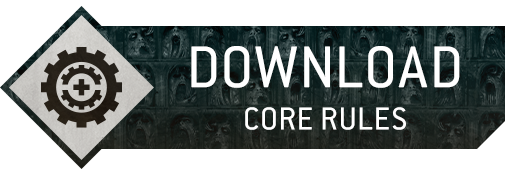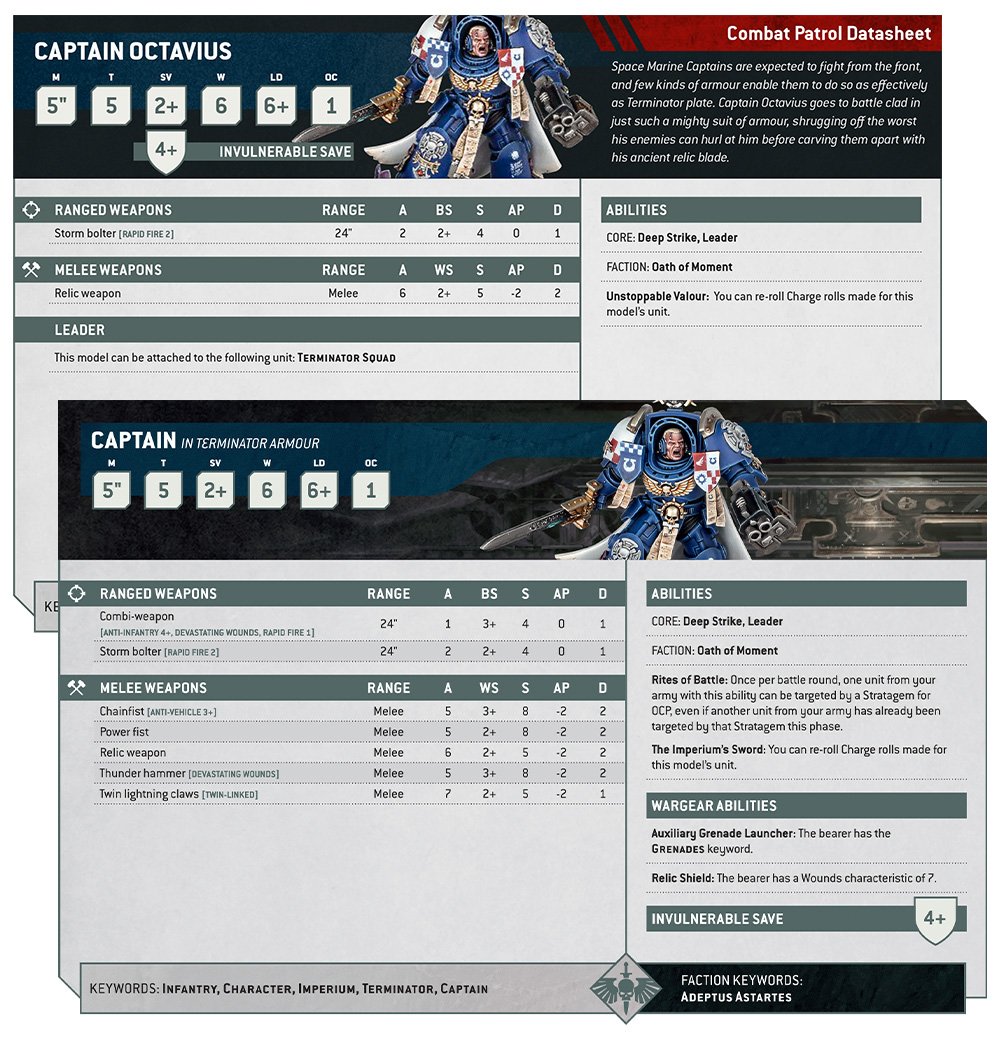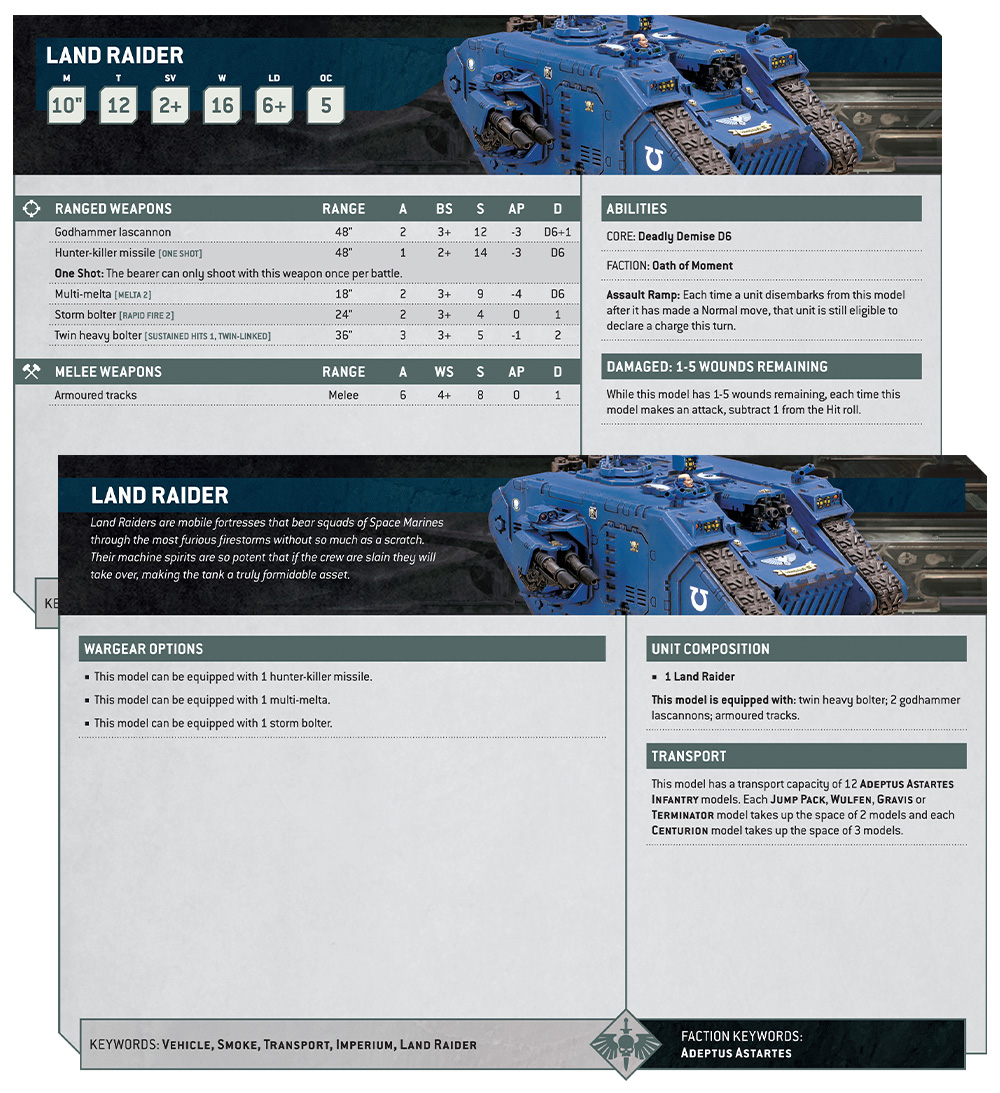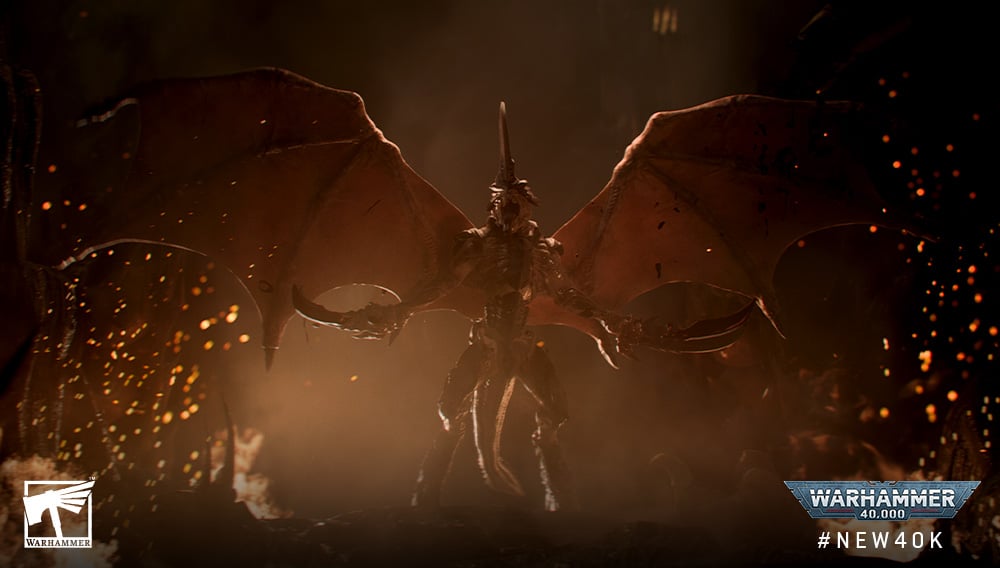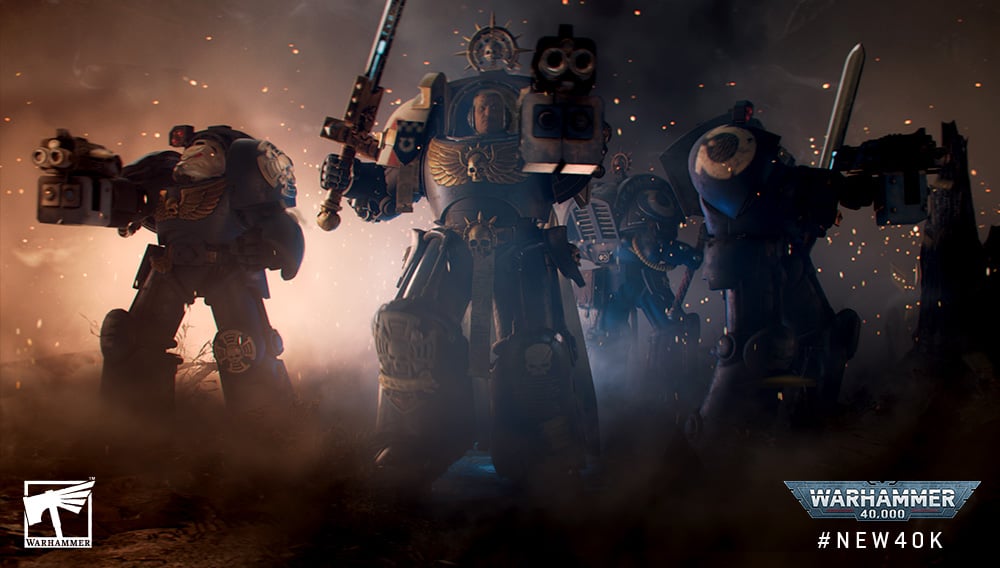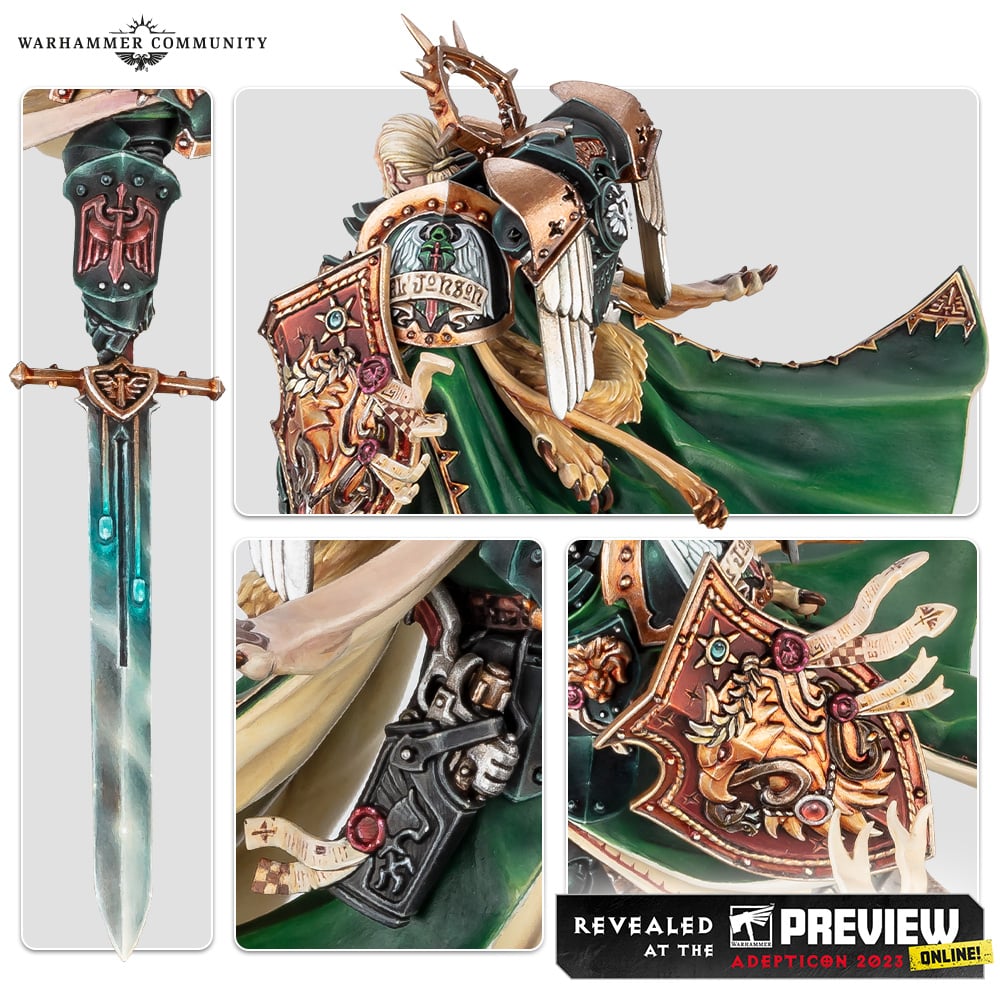Warhammer 40k 10th Edition Leak and Rumor Compilation
Time for another leak and rumor compilation, this time we have Warhammer 40k 10th edition including, rumors, leaks, previews. As with the other compilations the A running compilation of rumors, leaks, sneak peaks for Warhammer 40,000 10 edition. With new rules, point adjustments, stratagems and units. Compilation will feature both Games Workshop community info and any Internet leaks and rumors as they come!
Check back everyday as new leaks and rumors for Warhammer 40k new 10th edition will be added, without notification.
Pre-orders: June 4th 2023 Release Date: June 24th 2023
- 10th Edition Starter Set: $250
- 10th edition Indexes: $30 each
Road Map for Warhammer Community Release schedule…
– 2nd of June: core rules and quickstart guide
– 5th of June: Leviathan datasheets
– 8th of June: Tyranid datasheets
– 9th of June: SM datasheets
– 12th of June: non-codex SM datasheets
– 13th of June: Chaos SM datasheets
– 14th of June: Imperium datasheets
– 15th of June: Xenos datasheets
– 16th of June: GT packs and points list
– 20th of June: Datasheets for Combat Patrol
– 23rd of June: Boarding Patrol and Crusade material
Datasheets & Rules
- Points
- Tyranid Datasheets & Rules
- Space Marine Datasheets & Rules
- Blood Angels Datasheets & Rules
- Dark Angels Datasheets & Rules
- Space Wolves Datasheets & Rules
- Black Templars Datasheets & Rules
- Deathwatch Datasheets & Rules
- Chaos Space Marine Datasheets & Rules
- Chaos Daemons Datasheets & Rules
- Death Guard Datasheets & Rules
- Thousand Sons Datasheets & Rules
- World Eaters Datasheets & Rules
- Chaos Knights Datasheets & Rules
- Grey Knights Datasheets & Rules
- Astra Militarum Datasheets & Rules
- Adepta Sororitas Datasheets & Rules
- Adeptus Custodes Datasheets & Rules
- Adeptus Mechanicus Datasheets & Rules
- Imperial Knights Datasheets & Rules
- Imperial Agents Datasheets & Rules
- T’au Empire Datasheets & Rules
- Aeldari Datasheets & Rules
- Drukhari Datasheets & Rules
- Necrons Datasheets & Rules
- Genestealers Cults Datasheets & Rules
- Orks Datasheets & Rules
- Leagues of Votann Datasheets & Rules
Unit Samples
Missions Break Down
A lot of videos released today with a lot of content about how the game is going to play in 10th edition, and I don’t know about y’all, but I found it pretty overwhelming and confusing.
The solution? A pared down simplistic explanation of each card. Some of these explanations may be missing some minor rules minutiae so use at your own risk. Also if you notice any egregious mistakes please let me know, both for my sake an others.
In this post when I say ‘Action’ it means:
Unit that is eligible to shoot. Cant shoot or charge til end of turn. Completes end of turn unless otherwise specified.
I will also post a short summary for each section saying what I like or dislike about it. Feel free to argue with me about that all you want 🙂
You choose one option at random from the 5 available deployments.
Corner deployment with 9″ away from centre. (Corners)
10″ in along long board edge. (Dawn of War)
18″ in along short board edge. (Hammer and Anvil)
Line from mid way point of short board edge to opposite corner. (Sweeping Engagement)
Line from mid way point of long board edge to opposite corner. (Crucible of battle)
All of these have exactly 5 objectives. There is always an objective in the centre, and one in each DZ. the other 2 objectives are spread along the centre line at varying separations. If you want exact measurements, you’ll have to look at the cards.
This seems like a fair spread of deployments. I will miss some of the harder to measure ones from 9th edition, but I definitely won’t miss measuring them. I hope GTs use the ‘extra objectives’ mission rule pretty often to spice these 5 basic deployments up a bit.
You choose one option at random from the 12 available mission cards
Does nothing.
advance rolls of 6 deal the unit a mortal.
sticky objectives.
extra tactical mission if playing tactical, one tactical mission if playing fixed.
No infiltrating on objectives. No scouting onto objectives. No redeploying onto objectives. No deep striking onto objectives.
Any reserves attempting to come in on turn 2 only come in on a 3+.
Player placed objectives. Set up alternating. 6″ from board edge, 9″ from other objectives.
Draw 2 mission rules. If you draw the ‘no mission rule’, discard it, and draw 2 more. Use all of these mission rules.
If control own DZ objective at start of command, gain a cp on a 4+
Draw 3 discard 1 for tactical missions.
CP reroll and new orders cost 2 cp instead of 1.
Centre objective splits into two objectives that move 6″ towards two opposite corners. If corners are in no mans land, objectives must move towards them.
I love the vast majority of these. None of them are TOO punishing for any particular strategy, unlike some of the negative special mission rules from 9th edition. The only one that seems egregious is player placed objectives, which seems AWFUL with only 5 objectives. I think I’d recommend only using this one in combination with the extra 6th objective mission rule. And even then, it probably just encourages incredibly safe stalemates. Also not a huge fan of the ‘no special rules’ card. Its boring there should always be something fun going on!
You choose one option at random from the 9 available primary cards. 2nd player scores end of game instead of command phase in turn 5 unless otherwise specified. You can score a max of 50 points on primaries.
5 Per objective held end of command. (15 Max)
5 per objective held end of command (max 10). Action to burn objectives in no mans land/enemy DZ. Burn action only completes start of next command phase if you still hold. Score 5 end of game if a no mans is burned, score 10 end of game if enemy DZ is burned.
4 for hold one. 4 for hold more. 4 for kill one. 4 for kill more.
3 per objective held end of command. If its in no mans land and held with a character, it becomes empowered. Stays empowered as long as they keep a character within range of it. Score 3 per empowered objective end of command. 15 max.
Remove all no mans land objectives but centre objective. You spawn no mans land objectives with an action. One per turn. Must be 9″ away from another objective, cant be within 6″ of an objective. Hold these spawned objectives end of command for 5 vp (15 max)
5 Per objective held end of command. (10 Max). round 5 2nd player scores in command instead of end of round. End of round, both players score 5 for each objective they hold (15 max).
One no mans objective is the alpha. one is omega. Randomly determined. Round 4 alpha is removed. Round 5 all but omega are removed. Round 2 and 3 score 5 for each objective held in no mans land end of command. Round 4 score 8. Round 5 1st player scores 15 if they hold omega end of command, 2nd scores 15 if they hold omega end of round.
No mans land objectives can be moved end of (any) turn up to 6″ (in any direction) by player who controls them. Cant end on top of models, other markers, or impassable terrain. End of each turn, both players score 2/7/15 for markers wholly within 12/6/inside of opponents DZ (no max).
No centre objective. Score 2 end of command phase for your DZ objective. 5 end of phase for no mans land. 6 end of command phase for enemy DZ objective.
There’s a couple of these that really concern me. Hold, hold more, kill, kill more feels like a primary mission that can spiral out of control fast. And random objectives disappearing throughout the game AND increasing scores for the remaining objectives feels like it will lead to some very random losses you have no control over. There’s a few other really wild ones in there, but they are a bit too complex to get a read on without putting models down on the table.
Pre game you can choose Fixed or Tactical secondaries. If you pick fixed, you pick two of the options below. You can score a max of 20 points on each of these secondaries.
BEL – Fixed or Tactical – 2 vp for one unit in enemy DZ, 4 vp for 2. Bonus point for Tactical.
Assassinate – Fixed or tactical. – 4 VP for each character kill. bonus points and 5 point max if tactical. Resurrections won’t save you.
Bring it down – Fixed or Tactical – 2 VP for each monster of vehicle kill. +1 if 10+ wounds. +1 if 15+. +1 if 20+. +1 if tactical. 8 max score for tactical.
Engage – Fixed or tactical. 2 vp for 3 quarters. 4 vp for 4 quarters. 3″ away from other quarters. Battleshocked units cant score. +1 vp if tactical. If impossible to score, then can be discarded when drawn.
Shock Tactics – Fixed or Tactical – take an opp objective, or take a new objective if opponent held no objectives. 4 vp. Cannot score turn 1. redraw if drawn turn 1. +1 if tactical
Deploy Homers – Fixed or Tactical – Action. 6″ of centre or within opp DZ. Score 2 if at centre, or 4 in opp DZ. +1 if tactical.
Cleanse – Fixed or Tactical – Action on objectives in no mans land. Must control end of turn. Score 2 if done on one. Score 4 if done on 2. +1 if tactical
I think these are the first big miss of the Leviathan Mission Pack. They just don’t seem very well balanced. Bring it down HEAVILY punishes lists with lots of small to medium vehicles. And it an assassinate are blanks enough of the time it means you only reliably have 4 options. Then, Engage, Deploy, and BEL all massively reward mobile fast armies. And Shock Tactics can be a very unfun secondary to try and score against an opponent who knows how to counteract it. It seems like slower armies are simply going to be largely unable to play fixed secondaries, and faster armies are going to be able to opt in or out whenever they deem it necessary without much trouble.
Edit: I missed cleanse somehow in my first summary. That secondary does help slower armies out a lot, as brawling over central objectives is something they should be able to manage.
If you pick tactical, at the start of each turn you draw 2 secondaries from the full deck. At the end of a turn where you score points for one of these secondaries, discard it. At end of turn, you may discard one to gain a CP.
Investigate Signals – Tactical – action wholly within 9″ of corner. Score 2vp per corner.
No prisoners – tactical – 2vp per kill, 5 vp max.
extend battle lines – tactical – hold one obj in own dz and one in no mans land, score 5. If you only have one unit left, hold on in no mans for 2 vp.
Defend stronghold – Tactical – end of opp turn or end of game, if you hold own dz obj, score 3. Cant score turn 1, redraw if drawn turn 1.
Overwhelming force – tactical – 3vp per kill on objective, 5 vp max
Secure no mans land – tactical – 2 ob in no mans land, 5 vp. 1 ob in no mans land, 2 vp.
Area Denial – tactical – one unit wholly within 6″ of centre, no enemy wholly within 6″ of centre, 5 vp. Or, no enemy within 3″ of centre, score 3vp.
A tempting target – tactical – opp picks a no mans land objective. If you hold it end of turn, score 5.
Capture enemy outpost – tactical – control objective in enemy dz, 8 vp
I like these better than the fixed set. There’s a bit more reliable variety here. Its still pretty random, which is unfortunate, and still favours faster armies over slow ones, but the New Orders stratagem and the extra CP you gain if you don’t succeed at one are nice little mitigations to how hard some of these can be. Also, saving a high scoring one could lead to some big points scores, and the fact they all score more on average than the fixed ones means you have a bit of an edge over an opponent playing it safe with fixed secondaries.
Start of round 4. Shuffle the 3 actual gambits. Discard 1 at random. Then choose between those two and ‘proceed as planned’. If you choose a gambit, no more primary score, instead, GAMBATTTE.
Orbital Strike Coordinates – end of your 5th turn, unit wholly within 9″ of a corner not in own dz. roll 2d6. +1 for each quarter you are within 9″ of (cant be battleshocked or engagemnet). 12 = 30 vp.
Delaying Tactics – 4+ for each enemy unit engaged end of your turn 5. If you roll half of them 4+s (or 4 if there are less than 8) 30 vp. +1 if they battle shocked. -1 if you battleshocked.
Emergency Evac – 4+ for each unit wholly within 6″ of centre of battlefield. If you roll a number of 4+ = half your remaining units (or 4 if you have less than 8 remaining units), score 30. -1 to roll if battleshocked. If a transport has troops inside it, a 4+ on the transport counts for both.
CORE RULES DOWNLOADABLE PDF LEAK
Leaked Core Rules
Links to Warhammer Fest Demo descriptions
I just played 10th Edition at Warhammer Fest – here are all the new rules I noticed
by u/Evostein in Warhammer40k
My pics from the 10th edition demo at Warhammer Fest
by u/VoicesOfNihil in Warhammer40k
Take the following Dataslate cards with a grain of salt as issues and grammatical errors abound.
Below is a real life conversation between what seems like a Beta Tester and friend about the new Warhammer 40k 10th ed Rules. Some of what is talked about has been confirmed, but some seems like an early version of the rules as the GW has proven certain things to be false, so keep that in mind when reading!
Interviewer: Can I see some pictures of the new terrain or the Lion?
Interviewee: Sorry, I can’t do that. But the terrain can be demolished now, so I need a collapsed version.
Interviewer: That sounds interesting. What else is new in the game?
Interviewee: Everything is different, but still unmistakably Warhammer 40k. There’s no IGO-UGO or double turns. Many familiar concepts are present, but with a different, very streamlined, and very visual spin. Everything revolves around the unit profile. Almost nothing remains untouched. Old codexes have been scrapped, and armies start with fresh rules in the Warhost booklet.
Interviewer: Wow. When will the new rulebook be released?
Interviewee: I don’t know yet. We have a digital version, but I can’t say anything about how or if it will be sold.
Interviewer: What about the roll mechanic?
Interviewee: Almost everything works on D6 rolls without rerolls and modifiers, but rolls can critically succeed or fail. There are rules for rerolls and +-1 modifiers, but they are used sparingly. I have only seen the Warhost rules and the Space Marines + Blood Angels and Tyranids rules. There is a completely new mechanic to modify dice that is used everywhere. A player can have an advantage on a roll, making a roll of 6 critical. If you have another advantage, 5 and 6 are critical. If you have a disadvantage on the roll, a 6 is a glancing score.
Interviewer: Sounds like D&D. That sounds interesting. So, does 1 count as a critical failure, blowing your own head off?
Interviewee: The names are very D&D-esque, but there are no rerolls. A roll of 1 is simply a failure. Yes, sure. When rolling the dice, if you roll a 1, it’s just a regular miss. Glancing scores are better than a miss because they can be converted into a success. Advantages and disadvantages are subtracted from each other, so it can’t be both glancing and critical at the same time. What crits and glancings do can vary by the circumstances, but a critical roll counts at least as an additional success. A glancing roll is a miss, but you can combine it with another glancing score to make a single success.
Interviewer: That sounds interesting. Additional effects can be triggered by criticals, but is it easy to get criticals?
Interviewee: Generally, it is easier to disadvantage a roll than to advantage it. Imagine you roll 6 hit rolls on 3+, you have advantage 1 and disadvantage 3, so the overall disadvantage is two. You roll a 1, 2, 3, 4, 5, 6 -> 1, 2 miss, 3, 4 hit, 5 glancing hit, you put it aside. 6 is another glancing hit. You use the 5 to make it a hit. So 3 hits. If you hadn’t rolled the 5 before, the 6 would be another miss.
Interviewer: So, I can use tracer gun to save failures and use them to hit with the main turret?
Interviewee: That works only for attacks with the same weapon profile.
Interviewer: How does hitting and wounding work without modifiers?
Interviewee: Attack sequence resolves much faster. Batch rolling is mandatory, and the sequence consists of only two rolls: hit and save (and possibly a third invulnerable (ward/FnP) save). The hit roll needed is given in the weapon profile. You don’t have to work out the modified roll. It’s (almost) always the value straight from the profile. However, you have to see if the roll is disadvantaged before rolling. This is where the complication starts. Weapons have a different profile. There is no AP anymore, they have hit and penetration traits, a complete new concept.
Interviewer: Wow.
Interviewee: You have a fixed hit score and roll as many dice as you have attacks. The score is disadvantaged for every evade trait the opponent has. It is in his profile. You can negate these traits by hit traits in the weapon profile. Unnegated evade traits give you a disadvantage on the roll. The worst thing that can happen is that all rolls count as glancing, so you need two glancings to score a single hit. A crit makes two successes.
Interviewer: Oh, so you have to batch roll and do a lot of calculating.
Interviewee: After you have the number of hits, you work out how much damage these hits make. This is done before the saves. The opponent uses his fixed save score for every point of damage. You can disadvantage the save roll in the same way as the hit roll, only that it benefits the attacker in this case. You can disadvantage the save roll with the penetration traits of the weapon. The opponent can negate these traits with his armor traits.
Interviewer: So if I only glance, do I get a lighter damage table?
Interviewee: Again, you need two glancing saves to negate one point of damage. But a critical save saves two points of damage at once.
Interviewer: Ok, never mind.
Interviewee: The resulting damage is distributed to the unit. Damage spills over, but especially most melee infantry weapons have a special rule that caps the damage at the target wound characteristic
Interviewer: MW are still there and are the only source to circumvent the save completely. The best you can do with the normal attack sequence is to make the armor half as effective. Symbols are used for the traits, and symbols make it clear which rule trait counters which. But they also have names, and you need them very much because you will communicate with your opponent about this a lot. Half of the attack sequence is talking about your abilities now. The rolling is way faster.
Interviewee: So, I have to compare the symbols every time I shoot. Sounds like a lot of bookkeeping. Will take me ages to keep this straight. Or can I simply count the number of traits? If I have more hit traits, the rolls get easier, right? You still there?
Interviewer: No. For every evade trait that is not countered by a hit trait, the roll gets disadvantaged by one. These symbols have names in the rulebook, but the profiles only have the symbols. Traits can have tiers and need a corresponding number of tiers to be countered. It takes some time to remember all the common weapon profiles.
Interviewee: Okay, this sounds less wild. Probably still have to learn a lot of new profiles. But once that’s done, I am good to go.
Interviewer: No, even harder. Weapon profiles are not uniform. The bolter of a company captain has more traits besides the better hit value than a henchman bolter.
Interviewee: How many traits are there? Do I have to learn for save too?
Interviewer: I have to look, but 4-5 each I think and two generic ones. Saves work similarly. Defender rolls. The attacker can use traits to disadvantage the roll, and the defender uses traits to negate this. No more AP.
Interviewee: So rolls only get worse, right? But how can I crit?
Interviewer: There are a couple of rules that grant outright advantages and disadvantages besides this trait system. The trait system only ever disadvantages the roll. To get critical hits, you need a source to give an outright advantage.
Interviewee: You said that invincibles are a third save. Do I roll saves before invincibles?
Interviewer: Yes, invulnerable saves are like feel no pain in addition to the save. They confer the shielded trait, though. This is the only counter to plasma weapons, but the save is only 6+ or 5+. Only Primarchs have a 4+. The shadow field is the only 3+, but it is shit now.
Interviewee: Can you tell me when the Lion is released? Is he in this index, so released before the edition? If the damage is fixed, how do blast weapons work?
Interviewer: Yes, before blast is: crit hit: full damage, normal hit: damage capped at the number of target models, glancing hit: single damage. And blast can destroy terrain.
Interviewee: Still twice damage?
Interviewer: Yes, in addition to normal crit rules, so twice the full damage. Blast crits are scary and can literally flatten ruins.
Interviewee: I start to get it. Crit failure = half damage, crit = double damage. Sounds like a +0.5 modifier. That’s nice. But also very complicated and bad.
Interviewer: Bad, but not that bad. You are not used to it, but you get the hang of it after one or two games. The greatest problem is to connect the symbols with the names.
Interviewee: Yeah, and all interact.
Interviewer: Just symbol vs negating symbol, both are visually connected. Would be easier to understand with an image of No, I don’t know anything about them, just marines, blood angels, and generic tyranids. But eldar have rules in the warhosts with all the other armies that are waiting for a codex.
Interviewer: And how many hours does this take? We want only one version where the top is damaged and one separate with nothing more than concrete rubble.
Interviewee: We can do this as last time. I will make one piece, and if you don’t like it, I will sell it once I get going. If you like it, I can tell you how long it took. But this time, I will do some of the payment upfront by sharing things I am contractually prohibited from talking about.
Interviewer: I think I can do the damage in 5 hours and the rubble in 10.
Interviewee: Sure. So that’s 240€ for all.
Interviewer: Yes. But the rights are still mine.
Interviewer: What’s with the fluff?
Interviewee: The Imperium is split in two. The main Imperium wants to give up nihilus and consolidate what it has. The Crusade wants to defend and reconquer as much as they can and are more pragmatic about xenos alliances to achieve this. They effectively split from the Imperium. That’s where the Sanguinor and Guilliman and basically all the ‘good guys’ align.
Interviewer: And the eldar?
Interviewee: Sorry, wasn’t told anything about them. Didn’t ask either. Slowly dying out, probably. The Tau have expanded massively, and the tyranids are on the rise and in the spotlight.
Interviewer: Did you mean the Sanguinor or Dante?
Interviewee: The Sanguinor gets empowered during the campaign.
Interviewer: Arks of Omen?
Interviewee: The starter campaign probably. But this is only what I heard. The Sanguinor is a beast now, so that fits.
Interviewer: So you can’t use the Roboute in an Imperium force?
Interviewee: No, it is only background. There is no rule in our material that suggests that. The Indomitus Crusade is its own thing now. Still tied to the Imperium, but at odds with the lords. I asked Brian. We can afford 200 Euros. Rulewise faction composition hasn’t changed.
Interviewer: When is the edition set? Is there a time jump?
Interviewee: Don’t know, probably not.
Interviewer: What about Farsight? Is the origin of his blade revealed?
Interviewee: 1. He will steal experimental tech from the Tau core world and uses it to expand to several locations in the galaxy. His rebels are instead on frontier duty instead of Shadowsun. 2. I don’t know.
Interviewer: Do we get Dark Mechanicum?
Interviewee: No dedicated army list for them in the warhosts booklet, but Vashtorr will succeed and ascend and claim the fifth arrow of the chaos star, alas a minor one.
Interviewer: So the Arks of Omen is a Chaos win?
Interviewee: Don’t know the details. Haven’t seen the books. But I hear that at the start of the new edition, the Imperium is forced to abandon the nihilus part. And rivalry over the last three spikes of the star are a theme for Chaos.
Interviewer: Is this from Arks of Omen?
Interviewee: I think so, but don’t know. This is from people I talk to who know such stuff. Can ask
Morale
Every unit has a morale phase special rule. First comes a threshold when it is triggered: x models lost in a single turn. Then, what happens when the morale roll fails. There are some recurring rules: indomitable (nothing happens except things that are triggered on a failed morale check), shaken (can’t get advantages), attrition, broken (unit destroyed) or something bespoke like ATSKNF.
Interviewer: And what does it do?
Interviewee: Disadvantage on hit.
Interviewer: So the same as shaken?
Interviewee: No, it is way better than shaken.
Interviewer: So, multiple units have this shaken rule?
Interviewee: Yes, shaken is a special rules keyword, but the actual rules text is printed in every profile too. Exceptions are only very general special rules. But you can find these on the army roster, which is now generated by the app and has all the common rules that are only abbreviated on the battle profiles.
Interviewer: So USR are back?
Interviewee: No, that’s not a USR. But lots of special rules are prefaced with a keyword in bold, for example: FLAMER: the number of shots capped at the target unit size. Every flamer type weapon has this. But some weapons have the same worded special rule but not the flamer keyword, d-scythes, for example.
Interviewer: In addition to hitting every time?
Interviewee: Flamers don’t hit automatically, but have hit 1+. This comes close, so the whole rule text is still in the profile. But recurring rules have the same name, probably to make it easier for veterans to see what a special rule does.
Interviewer: This means the battlescribe roster gets even longer than before?
Interviewee: Only a summary of the units is given on the army roster. The details are on the battle profiles.
Interviewer: These battle profiles are like the AoS unit cards? You have one for every datasheet?
Interviewee: If you have three intercessor squads, you have three battle profiles.
Interviewer: Why do I have to have different cards for the same unit?
Interviewer: So, stratagems, etc. It’s not just the loadout and psychic powers that differ from unit to unit. You can give units mission imperatives (secondary missions), stratagems, sometimes upgrades and relics.
Interviewee: I am sure that all my pathfinders are exactly the same. Wait, are stratagems and missions loadout?
Interviewer: Of course, you still have units, especially if you play a hard-boiled list with lots of spam, that are identical twins, but units can only get a certain amount of buffs, and you can keep track of this on the battle profile. So even in this case, there is a (flimsy) reason for different battle profile cards next to the table. But personally, we keep track of buffs next to the unit. It is easier this way.
Interviewee: So no more Fire and Fade at will?
Interviewer: Stratagems are mainly unit upgrades now, but there are generic stratagems available to more units.
Interviewee: So the stratagem crunch is real.
Interviewer: No. There are even more stratagems to pick from than before if you play crusade, which you will do even in pick-up games, but you have to buy them for individual units before the game. And only these units can use them. On a plus side, many stratagems cost no CP.
Interviewee: They’re just regular powers then.
Interviewer: You can only use a stratagem once. The buff limit and the stratagems really reward a diverse army. Deathstars are still possible, but buff stacking is a thing of the past.
Interviewee: And the non-unit stratagems?
Interviewer: The generic ones are mostly taken from the last edition, but with vastly different rules. Overwatch lets you retard part of your activation into the enemy turn. There is no re-roll stratagem anymore. You pay for the option to have a stratagem available with pregame points and a second time with command points during the game when you want to use it.
Interviewee: How many points do we get?
Interviewer: You only get 2-4 command points per round.
Interviewee: That’s not that different than now.
Interviewer: There is a third kind of stratagem: every army has a single one that is available for free for most units. Signature stuff like Fire and Fade, Transhuman, etc.
Interviewee: So I have to remember the standard + 1 opponent stratagem and all they have written down.
Interviewer: Indeed. During the game, there are no gotcha moments. Your opponent can look at your battle profiles and see exactly which superpowers your units have.
Interviewee: Cool.
Interviewer: Some of the faction-wide stratagems work only with certain units. So only these units get the stratagem on their battle profile. Working out which one gets it and which one does not is worked out before the game, aka automatically by the app. During the game, you look simply into the battle profile. If the rule is there, you can use it (the actual rule is written in full on the army roster).
Interviewer: Let’s talk about secondary missions. Hope that works as good as Battlescribe. Ups, and mission?
Interviewee: Mission imperatives are what secondaries were before. The primary objective structure stays more or less the same, but there are no secondaries anymore. Instead, units can get quests, mission imperatives. Be wholly inside the enemy deployment zone in your command phase, etc. You can give these missions to your units. These missions cost RP
Interviewer: “Crushy will love this. Units have a varying number of enhancement slots per phase. They cannot benefit from more buffs than they have slots. Some slots are filled during army creation, so the battle profile lists only the available ones. Pregame buffs cannot be overwritten.”
Interviewee: “That sounds like a lot of work to configure a unit and write it all down.”
Interviewer: “Army composition is more complicated than before. There are many more options, but once it is condensed into the battle profiles, it is easier than before. You can play a game in 90 minutes even with large armies without problem.”
Interviewer: “That’s great, but hard to believe with all the new systems going on. Sounds like you absolutely need digital helpers.”
Interviewee: “There is a blank datasheet in the rules for copying, or you can use the app for this. That’s what we were told to do. The app is not finished, but it’s already way more polished than the 9th edition app. No one will do this by hand. This is more work than creating a D&D character. With the app, it’s only one click, and you have your army roster and battle profiles. And besides the rules, this is everything you need to play your army. No need for your codex. And no need to know your opponent’s army. Just look at his battle profiles.”
Interviewer: “OK, putting it that way, it sounds cool. So the official battle roster is like the Battlescribe roster now?”
Interviewee: “Yes, pretty much. It includes commonly used army rules that are too common to reprint the text on every battle profile, i.e., battle focus, and are only referenced by name. But most of the army roster is just a cheat sheet for other general rules: names of the armor traits, how many dice for initiative, which unit size raze which obstacle, what does cover and how many damage can it take, etc.”
Interviewer: “Army roster + cheat sheet…wait, initiative is back?”
Interviewee: “I am sure you are delighted to hear that battle focus is very powerful. It lets a number of units overwatch without skipping their activation.”
Interviewer: “Wow. Wow. Overwatch like in the old Necromunda rules? New battle focus. Do we get a codex?”
Interviewee: “No, from the warhosts lists. The warhosts booklet is not minimum effort work. Lots of rules are reworked. The Tyranid and Space Marine rules are clear precursors of the codex rules, but with way fewer options. Initiative is a new stat, mainly used in the combat phase.”
Interviewer: “Sounds very different, but cool.”
Interviewer: “Have we Ynnari rules and other subfactions in the booklat?”
Interviewee: “Subfaction rules…delete everything you know about it from your memory. It is not a useful question to ask for subfactions. This concept does not exist anymore. Units have faction keywords, and the detachment rules define which units you can include. But there is no ‘Ultramarines is called a subfaction,’ ‘Space Marine is called a faction,’ etc. All these keywords are just faction keywords. Some units have more, some have only three.”
Interviewer: “So Realspace Raids except that you replace the subfaction placeholder with the one of the detachment?”
Interviewee: “What was formerly known as subfaction keywords still exists, but there are no longer placeholder keywords.”
Interviewer: “I don’t understand.”
Interviewee: “You pick a detachment that is eligible for the mission pack. In matched play, you still use only one faction. Nihilus encounter is what matched play was before. Matched play is now the header for all mission packs, except Grand Tournament. Crusade is Crusade and open is called Baptism of War, but we still call it ‘open’ because we don’t play it to be honest. These are the three mission packs that are included in the rulebook.
[Interviewer]: But this will break the monofactions in Drukhari.
[Respondent]: Some armies have multiple detachments, some don’t.
[Interviewer]: What, for example, besides Drukhari?
[Respondent]: Space Marines have Crusade fleet, Chapter Battlegroup and Host of Angels and Veteran Strikeforce in the publications I know.
[Interviewer]: Wow. Crusade fleet and Chapter battlegroup are both in Codex Space Marines and Warhosts. Crusade fleet can take Imperium units and all Astartes units, so you can mix different chapter special units and characters. Chapter battlegroup can only take marine units with the Chapter keyword and you can choose a single Chapter: keyword, Chapter: Space Wolves, Chapter: Black Templars, etc. so you can include everything generic and special characters/units from one chapter.
[Interviewer]: And the monofaction detachment has more buffs because less variety.
[Respondent]: Chapter battlegroup confers better rules, yes.
[Interviewer]: So you choose a chapter detachment and get the chapter traits. And every detachment has its own chapter stratagems?
[Respondent]: No, you don’t choose a chapter per se. There are generic doctrines like in the imperial guard codex. You can play a Blood Angels support company list if you want.
[Interviewer]: Oh, big change. Stratagems, relics, secondary missions have keywords, too. The detachment tells you which ones you can use. In the Blood Angels supplement are relics and traits that you can also use in a generic chapter.
[Interviewer]: And all these rules are free at the start of the edition?
[Respondent]: I still don’t know. But when was the last time GW has given you something for free?
Interviewer: What are the other marine detachments?
Interviewee: Host of Baal is in the supplement. It is for an army with all Blood Angels successor chapters combined. For a Blood Angels army, you will still use the Chapter Battlegroup detachment from the Space Marine codex. But the supplements give many more relics, stratagems, and other options for the detachment.
Interviewer: But how can this work if there is no Blood Angels detachment in Codex Blood Angels? Is there a reason for this weird structure?
Interviewee: Simply because the detachment allows you to use relics, etc. with the Chapter: keyword you have chosen for the detachment. But there are no Chapter: Blood Angels options in the Space Marines Codex, just smurf and smurf fanboys. So it is a pretty hollow detachment for the Angels unless you have the supplement.
Interviewer: But in this detachment, I cannot use generic stratagems and the other specific stuff?
Interviewee: No. In the Chapter Battlegroup, you can choose units and options with the Chapter or one of the ‘Chapter:’ keywords, in this case Chapter: Blood Angels. But there are no Chapter: Blood Angels units or enhancements in the codex. Very rudimentary versions of the named characters and units are in the Warhost booklet, but the options and the fleshed-out version are in the Blood Angels supplement.
Interviewer: Does Codex Blood Angels have all the generic firstborn and Primaris units?
Interviewee: Supplements have only the additional units and stratagems and other enhancements. Also some generic ones. No reprints.
Interviewer: But the generic things are only for Blood Angels, like the mini-Thunderhawk?
Interviewee: No. It does not matter in which publication the stratagem or psychic power is released. If it has the Chapter or Chapter: Blood Angels keyword, you can use it in your detachment. In both the Codex Tyranids and Codex Space Marines, there are options for other armies that are themed around the codex they are in. There is an Ork warlord trait called Snagrid’s Luck in the Marine codex that lets you wreck a terrain feature, which is a reference to the fate of the Crimson Hands.
Interviewer: That’s messed up. So a Smurf player has to buy all the supplements for all the other chapters too?
Interviewee: Are there plenty of Eldar options, so their codex is probably far away? No, it is pretty randomly distributed. Don’t think you can deduce which codex comes first.
Interviewer: So if the generic detachment has all the Blood Angels stuff anyway, what do the ones in the Blood Angel codex do?
Interviewee: Host of Baal has a slightly different force organization chart. Most detachments have a similar structure to Arks of Omen. But this has additional fast attack slots for jump troops from the start. Veteran Strike Force is released in Codex Blood Angels but can be used for every chapter. It is similar to a Chapter Battlegroup, but firstborn units only.
Interviewer: And these are tournament legal or like the old formations optional?
Interviewee: Grand Tournament has its own detachments, coming with its seasonal packs.
Interviewer: Oh. Can you talk about the Blood Angels chapter traits?
Interviewee: Blood Angels have no additional chapter rules.
Interviewer: OK, I understand. Because Marines have Guard doctrines. So about GT rules. Can you soup?
Interviewee: In Grand Tournament, you can pick only from a single faction. Most detachments have no option for allies, but some have where it makes sense: Crusade Fleet, Real Space.
[Interviewer]: So, Open, Narrative, and Matched Play are gone, but the concepts still exist, just with different names. And GT is now something else. Sounds stupid.
[Interviewee]: Yeah, weird. But there are only Matched Play and Grand Tournament. But Matched Play has different mission packs. Crusade and Open are now Matched Play packs, so they’re pretty much alive. It’s just a rebranding. In the rulebook, there are Baptism of War, Nihilus Encounter, and Crusade mission packs.
[Interviewer]: And Nihilus is like the old GT packs and gets replaced every 6 months?
[Interviewee]: Hmm, I haven’t thought about this. Maybe Nihilus is seasonal and will be replaced in the future with another mission pack. It might be true, but I don’t know.
[Interviewer]: Ok, but for pick-up games, this Nihilus is the base?
[Interviewee]: Again, Crusade is the real deal now, vastly expanded with different mission types. Nihilus is only a stripped-down version of it without the buildup shenanigans. Open Play is even more stripped down. There are no Power Levels anymore.
[Interviewer]: Ok. Sounds strange. But I can see them using Matched Play to convince players that this is also a balanced game, so that not everyone is flocking to GT. If Crusade is the new Narrative but is compatible with Nihilus/Old Matched, how does this work with points and Power Levels?
[Interviewee]: Everything uses points now. But most squad options cost no points, so it’s easier than before. Relics cost points now, though.
[Interviewer]: Wow. Power Level gone is great.
[Interviewee]: There are two additional resource systems that are used in some Matched Play packs: Requisition Points, which are pre-game command points now, and Command Points, which are generated each turn. Requisition Points are used in both Nihilus and Crusade as pre-game currency instead of pre-game command points, but most of the cool stuff is locked to Crusade. Also, stuff you would deem integral to the army flavor now.
[Interviewer]: You said Open is still a thing?
[Interviewee]: In Open Play, you ignore the loadout restrictions that are hidden behind an RP tax. Other options like secondary missions are not used. In Nihilus Encounter, you have not enough RP to unlock the best gear for all units if you use heavily customizable units. But you can use points to buy more RPs. As before, Crusade has additional ways to accumulate and spend RPs.
[Interviewer]: So, all units use plasma and lascannons now?
[Interviewee]: No, some of the better options have to be unlocked with Requisition Points.
[Interviewer]: You mean I buy a unit for x points but can only buy the cheap stuff like grenade launchers. And if I want the good tech, I have to spend an RP?
[Interviewee]: Yes, per unit. Spend an RP to unlock the option for a Power Fist, Lascannon, and Plasma Gun.
Grand Tournament
Grand Tournament Pack: completely detached format, way more rigid. no roster datasheet, only pre customized battle profiles: so no squad size, army wide rulevariation, etc. some units have stratagems, warlord traits, relics, psychic powers and secondary objectives attached, some don’t. Some units have several grand tournament profiles for different points with different options. we were told that there will be a rotation, not every non-codex or old unit gets a profile every season, but some do. Only customization is weapon loadout, which is freely chosen before eachgame. predefined terrain for each mission, drawing from a terrain set, each player is expected to bring two season sets, four sets make a table. so expect to spend on terrain what you save in miniature purchases… over and over again
[scaramouche] uh, big change. so gw is making different army lists for GT?
Grand tournament does not have roster datasheets. it is just the battle profiles
[scaramouche] So list building is more like a card game.
instead of a model pictures, there is a schematic with base size, height and width of the model
[scaramouche] but you can still unlock options with requisition?
no, it has nothing to do with matched play. None of the options are valid in GT. there is some overlap, but nothing is cross referenced. it is as if someone has picked and customized the units for you and you can only choose which units you want to field.
[scaramouche] wow. maybe this is the first time, GW can balance this game. and we ordinary types can keep all our toys and are no longer forced to accept bare knuckles tourney play as the default
you can pick the weapons of the tactical squad right before the game. it is a sideboard of a kind you don’t have to unlock the options. there are no rp. it either has the option or it is omitted
[scaramouche] so tourney guy has to bring all the weapon options for his tac squad to beprepared. or be be really good with magnets. sound like a lot of costs in addition to the other materials like codixis
you don’t need a codex. all the army rules are in the booklet. there are not that many.
[scaramouche] why is GW doing this? they are splitting the player base in half [scaramouche] how different are the units from normal 40k
mostly copy and paste from the codex
[scaramouche] but this can lead to some very cross reference problems when the systems diverge over time
no, you really don’t need the codex. in fact, the codex would be of no help, because GT is not mentioned there. the GT profiles are not included
[scaramouche] but you still have to buy the codex to get access to the rules?
you buy the GT pack and get the rules for all armies
[scaramouche] how much does this cost?
i don’t know
[scaramouche] have to keep track of two systems is a waste
army construction is pretty easy. even easier than open. don’t know why this isn’t used as an introductory game
[scaramouche] yea, but twice the work
App
The transition from roster generation (vastly complicated) to gameplay (easy bookkeeping, you just need your battle profiles) is essential for the new system. I like this. you don’t have to bring anything else to a game than the battle profiles and the core rules if you are still learning and you are good to go.
[scaramouche] ok, sounds not bad if you put it this way
it is similar to a roleplaying tabletop game. character generation takes ages, but the rules at the table are not that complicated once you are done
[scaramouche] except you are playing DSA 😀 then it is complicated on every level
don’t know this game
[scaramouche] it is a German roleplaying simulation. great world, but terrible rules. lots of bookkeeping. don’t want to have this in 40k, or any game
most of this is done in the new app
[scaramouche] is the app locked behind Warhammer plus?
don’t know how this works. we don’t get this kind of information and for us this is free obviously. but we use the app for testing since it is important. had to buy a used galaxy, since we don’t get an ios version
[scaramouche] so, 40k isn’t playable without the app
you can do it all by hand if you want. there are blank battle profile sheets, but who wants that?
[scaramouche] I know someone who does his army lists with excel[scaramouche] any other app upgrades?
i really don’t know what is added. we use a stable version for several months now. it’s just an army generator, battle profile viewer and rules encyclopaedia. nothing different from the old app, but way better in every respect. the core rules are better searchable and proper cross referenced, but still not exactly on wahapedia level, the battle profile viewer is the greatest improvement. completely eliminates shifting through your codex
[scaramouche] ok, so they main advantage is, that it keeps track of both army creation and in game references
army roster and battle profiles are generated automatically.
the roster builder is improved, too, but just quality of life improvements and a better layout
[scaramouche] is this also fro crusade
the app works now with all mission packs
[scaramouche] and have you pay extra for the mission packs?
everything was unlocked for us. don’t know how this works after release
[scaramouche] ok. can I ask a little bit about the game now. we talked so much about the logistics, but let’s start with terrain, since you want useful kits
Terrain
terrain is different now. first it can be destroyed. And it can be upgraded. And the actual rules are super tight, no more keyword soup
[scaramouche] that much was clear
every terrain piece is only defined by its footprint and whether it is light, hard or fortified and whether it is area, landmark or obstacle. you also need to discuss what happens when it is destroyed. usually you remove the feature or replace it, but the GT terrain kits work in a way that you can remove a part and the footprint and rubble remains. you can also replace the terrain with craters or homemade rubble. but you have to decide before the game, which rules the replacement terrain used and where it is placed.
[scaramouche] good for third party terrain makers[scaramouche] what are landmarks?
it is beneficiary that both pieces have the same footprint. this is the point of this whole show
[scaramouche] yea, makes it easier. but real customizable terrain, maybe with sockets and magnets will be hard to make. can you give me pictures of your gaming table with official terrain?
no, we didn’t get one. but there are pictures. we play with our own terrain and cardboard footprints. that’s why we want your help
[scaramouche] ok, when there are not so many rules, you have more freedom when you create something. easier on the gaming table too
yeah, there is nothing more to talk about before the game. most of this is pretty straight forward. light, hard, fortified is a no brainer. the only roadblock is to determine what happens with destroyed terrain. you have build two battlefields atonce.landmarks is all terrain where you can’t place (or can only place few) miniatures on top.
[scaramouche] is this like 4th edition with very abstract rules?
line of sight stays more or less the same. but the concepts are more clearly put.
[scaramouche] shame, missed opportunity
except that it is worded on a unit basis. able to draw a line from any part of the unit toevery part of the target unit -> it is not obscured. if you cannot draw a line from anypart to any part in the target unit -> hidden. so it is hard to hide a unit. it heavily favorsthe attacker, but cover is much stronger, offers both bonuses to hit evasion and save.but enemy units within 6” ignore cover and there are not benefits for meleewhatsoever
[scaramouche] is the tourney wall abuse still possible?
yes, you can still use terrain in this way. this was not fixed. but it is harder to pull off since you no longer can walk through walls
[scaramouche] ouch
you only get cover if you are 1) wholly inside area terrain (not necessary to beobscured), 2) within 3” of an obstacle, landmark or area terrain and obscured. unitsdirectly behind terrain that can hide at least one model from cornering enemies arepretty safe. it is very uneconomical to shoot at them. but it is hard to hide a unitcompletely
[scaramouche] and ruins are still obscuring
there is no rule like that. windows are windows
[scaramouche] oh. back to laser pointers and fiddly yard sticks
all distances are measured flat, a unit can move up up to its allowance in addition toits horizontal movement, and infinitely down.
[scaramouche] wow. but this allows for some pretty wild movements
a marine can move 6”, climb over a 1” barrier and then climb on a 5” ruin and jumpdown 10” on the other end, all in one move. but he can’t climb on a 7” ruin
[scaramouche] but then you measure vertical. you said it is only flat measuring
this is correct. was worded wrongly. you measure both vertically and horizontally anduse the larger value, no diagonal ranges
[scaramouche] sounds easy
models must fit all the way where they move.only models with the fleet keyword (infantry-like units up to marines, but notterminators) can ignore this. so infantry effectively ignores most obstacles excepthigh walls and certain other models, while even minor obstacles are impassable for other units, since they cannot fit on top of the obstacle and in the air and thus cannotmove across. but they can go right through these barriers and destroy them in theprocess
[scaramouche] but than tanks can never go up
wrong. vehicles can use slopes to reach higher ground
[scaramouche] ok, yes. but they cannot climb if i understood coirrect
[scaramouche] but thn tanks can still not move over barricades
every player can bring one obstacle and one large terrain. this can be a free one andor one bought for points. in every mission there are specified areas where they can beplaced, usually 6” from your deployment zone for the large one and at the edge of your deployment zone for the obstacle
[scaramouche] you have to bring your own terrain?
in addition to the normal terrain. some missions show vaguely where terrain shouldbe placed, others are completely open. there is no special terrain required outside GT
[scaramouche] so i can bring a webway gate. but what about necron players who have noown terrain
you are encouraged to build them as you see fit within the size limitations. there iseven an example for a building that hides a knight. this building can be upgraded andsome armies rely on this in the first turn
[scaramouche] are the boards symmetrical?
not symmetrical, GT is symmetrical
[scaramouche] and in GT, only the official buildings are allowed?
yes, in principle. but you can only choose between buildings that have a GT profile.and then you have to use the actual kits. but you have to bring half a full terrain kitanyway, so playing turneys will be expensive anywaydestroying is a thing. depending on the size of the unit you can go through obstaclesand they are removed.
[scaramouche] the ork in me, loves this
light obstacles are destroyed by everything beginning by marines (solid), hardobstacles are removed by anything as large as a tank (this includes terminators),fortified obstacles need a super-heavy. areas and landmarks are harder to destroy,you need a tank to destroy light areas and a super-heavy to destroy hard areas andfortified areas cannot be destroyed
[scaramouche] wow
you can shoot at cover with blast weapons and weapons with the demolish specialrule. must score a number of wounds in a single turn to make it damaged. damagedterrain counts as light. if light terrain or damaged terrain gets shot, it is destroyed
[scaramouche] maximum carnage
[scaramouche] what do we do with old terrain
there is a plastic token set. it has crushed walls markers for this purpose.
[scaramouche] oh, is this for GT or normal play?
i don’t know if they are part of the GT set or a separate release. I bet the latter,because it is also used in matched playyou can damage terrain and than destroy it by smaller units than normally necessaryby moving through it
[scaramouche] what are smaller units? base size < 32mm[scaramouche] and the new terrain has all this build in
the terrain kits have removable sections to make it damaged and destroyed. at leastthe reinforced buildings
[scaramouche] and whats avaialbe for you
there are two sets. similar baroque meets favelas meets imperial tech style butdifferent buildings. one is from the starter set, one from the GT pack. both havedetachable elements
[scaramouche] did they give you a terrain info sheat?
you can see the starter terrain in the picture section. there is a nice group shot of thestarter box contents. and we know the GT terrain layout
[scaramouche] can you show me?
no
[scaramouche] that would be helpful for my work[scaramouche] at least the terrain[scaramouche] so you have a full blown core rule book?
There are the things we should have, this is rules only. And there are the things weget from Oliver and his wife. These are the pictures and release info stuff. But we arenot supposed to know this. And I can’t share these because it might bring them introuble. The only pictures we have officially are icons from the app and terrain layoutschemes.
[scaramouche] Is Susan ok again?
[scaramouche] Can you share those? Would really love to see what’s in the box.
The secondary infection really got her, but she is better now. The kids are back, too.
[scaramouche] Corona sucks. But good to hear.
Yeah, I had it twice. And Anastasia once. But only mild.
[scaramouche] Blessed by Papa Nurgle
Won’t share the pictures, but I can describe the terrain a little bit more. Just stick tothe old files and modify them.
[scaramouche] ok, i get it. but if i create this from scratch, i will come never close to theofficial. this wouldnt be a legal table
you have to discuss before the game what terrain you use for destroyed terrain. if youhave old inflexible terrain you can simply remove it when it is destroyed or say thedestroyed terrain has the same rules as the intact. the former is what you are doingwith obstacles anyway. but you can also use craters for destroyed areas.
[scaramouche] this is like a nesting doll. you damage the damaged terrain and get evenmore damaged terrain
destroyed terrain cannot be damaged again, but can still be used for cover and as amovement blocker. it uses the same rules except that it cannot be destroyed againsize is a keyword in every datasheet or profile. it is not very granular light for most infantry, solid for marines, gravis and lighter vehicles, heavy for tanksand terminators, super-heavy and titanic
[scaramouche] ok
the size is also important when you want to move through models. you can movethrough light and solid models of your own faction. and heavys can move throughlight enemies, but cannot stop on top
[scaramouche] nice
this is important because you activate your units one after another. otherwise thegame would end in a traffic jam
[scaramouche] wow. 40k has finally arrived in the 2000s rulewise. no more 30 minutesstanding idle
no, still IGOUGO
Activation
[scaramouche] meh
the game structure is different, battle rounds and turns stay as they are, but within aturn units are activated one at a time and go through all the phases before the nextunit is activated. but it is still all your units in your turn before the other player getshis turn for all his units
[scaramouche] the flexibiliti is nice
certain units can be activated at the same time, mostly a character and a designatedunit
[scaramouche] like in the AoS season?
the order in which the phases are played can be determined by the player. he canmove, shoot and then use command abilities or shoot, charge, fight, or fight, move,shoot
[scaramouche] thats abig one
Timing is very important. you want to activate your buff pieces first
[scaramouche] will be a steep learning curve i geuss
units can skip phases and this is important and a deliberate choice. weapons with theheavy special rule for example get disadvantaged unless they skip the movementphase, so no movement before or after. it is also important for interventions, doingstuff in the enemy turn, which trigger on unskipped phases
[scaramouche] sounds like a nice way to solve lots of theold ambiguities[scaramouche] so Leman Russs are back to being stationary bunkers
fight phase cannot be skipped if enemy units are in 1” at the end of activation
[scaramouche] why is this relevant?
no, a lascannon on a leman russ is no longer heavy. weapon profiles can vary fromunit to unit. the hit score is also part of the weapon now and obviously changes bywho wields it
[scaramouche] cool
Interventions
heroic interventions are now used for more than characters. so i guess, they are notthat heroic anymore and called simply interventions. they interrupt the activation andthe enemy can play one or more phases of his ownthey are used to fight back and for overwatch. some stratagems allow this for other stuff
[scaramouche] I am glad, that they nerfed overwatch. Not keen of a return
overwatch is different from before. a unit can use a 0 CP stratagem and skip all itsphases, but than can intervene after enemy movement or shooting phase with ownshooting phase
[scaramouche] so the same as before, but differently worded
no, you can’t use it to defend against charges anymore. overwtach triggers at the endof movement or shooting. charges are done in the movement phase. unless theenemy is stupid enough to shoot before moving, which would allow you to shootbefore his movement
[scaramouche] Wow. 2nd edition is back. that is fanatstic. but sucks for melee troops
yeah, lots of changes.
[scaramouche] and heroic interventions are for units now
every unit within 6” of a unit that has fought can intervene now
[scaramouche] mom, my kid is awake
sure
[scaramouche] re[scaramouche] ok, so why do you need a heroic intervention to fight back
first we have to talk about the fight phase.
[scaramouche] ok
Initiative
oh, and there is an initiative stat in the profile again. It is like the other stats a dicescore.
[scaramouche] everything is a dice value now
no, movement and wounds are not dice scores. but morale, initiative, save and hit inthe weapon profiles are
[scaramouche] ok, so a stat only for something that worked ok without. seems clunky
initiative is used for fight back in fight phase, roll offs, sometimes to avoid mortalwounds
[scaramouche] ok, like that. eldar should do good
some weapons roll against initiative instead the save value
[scaramouche] nice
Fight phase
ok, back to the fight phase: melee weapons have lots of attacks, but normally youonly fight in your own turn.
[scaramouche] oh, wow
melee weapons have reach, which indicates how many friendly models can bebetween them and the frontline in order to attack. most units have reach 1 and itworks as before: you can attack if you are near a model in contact. but some weaponshave a larger reach, so can attack if there are multiple models between them and themodel in contact. and short range stuff like digital weapons need you to be directly incontact, that means within 1”
[scaramouche] so wych weapons work only in direct contact. that sucks
combat knives and daggers have reach 1, work as before
[scaramouche] good
weapon types are gone. though, some remain as a special rule, heavy and pistol for example
[scaramouche] but why is this so complicated?
you charge in the movement phase, so you can charge, fight and if the enemy isdestroyed, shoot. or you can shoot first, move, then fight. if you have already foes in1” because the enemy charged you last turn, you can fight and then retreat, or if theenemy is destroyed, move as normal. this is usually where the fight back happens
[scaramouche] wow. really cool
however, everytime after a unit has finished its fight phase, you can try to intervenewith one of your units. both units roll off with their initiative value
[scaramouche] ah, now it makes sense
both roll 6 dice and use their initiative score. then they count their success. this rollcan be advantaged with special rules as normal. If the intervening unit wins, it gets amove phase for a pile in move and a fight phase. after this the activation continues
[scaramouche] cool. but why is the pile in in the moevment phase
a pile in move is a 6” to bring models into contact. one model has to end in 1” and therest has to move closer to the enemy. if this is not possible, the move cannot beperformed.
[scaramouche] don’t understand
units do not pile in as an extra movement. they can voluntary make a pile in move intheir own movement phase if they are already bound in combat but want move upwith additional models. but this is instead of other moves and then their movementphase is used up
[scaramouche] so the enemy charges, you can fight back if you have a high initiative and atthe start of your turn, your unit can make a pile in move and fight again
yes, the intervening unit moves up and fights. and then in its own turn, it can fightagain
[scaramouche] my eldar love this
slow units fight only in their own turn, but can do at the beginning of the turn, so theymay fight free
[scaramouche] so many possibilities
units with a high initiative have a chance to fight back and then fight again at the startof their turn. this is very deadly
[scaramouche] yeah, figured that out. was does strike last do?
there are no strike first and last effects anymore
[scaramouche] bummer. so can you consolidate after the figh?
there are no consolidation moves and pile in moves are as explained somethingdifferent, and are part of the move phase and not the fight phase, except in anintervention, but this is technical also a move phase and then a fight phase nestledinto the enemy turn
[scaramouche] why cant you simply move in your fight phase?
no, some actions are only possible in the appropriate phase. so a phase opens up,with all the ramifications
[scaramouche] so this is for game purposes, to have proper triggers. But what if you canintervene in a already intervened phase. This is inception level stuff.
good question. have to ask my group. maybe a loophole. maybe it is fine
[scaramouche] I have to delete my prior knowledge
you have to really plan your turn because you have so many options in which order you do things
[scaramouche] yeah. that sounds great
attacking a line of drukhari is scary as hell now
[scaramouche] yeah!
timing is everything
[scaramouche] ok, get it
Movement
all units can go through everything that is smaller than a tyranid warrior. tanks caneven go. through lighter stuff of the enemy
[scaramouche] yes, you told this already
my finger are bleeding and my head spins. can’t remember everything I have alreadytold you
there are only 5 movement types. and there are almost no movements outside themovement phase and fight interventions. so you touch your dudes only once per turn
[scaramouche] sorry. I wanted to say that I am awake and pay attention.[scaramouche] twice, when you have to remove it
😀 yes, but I am too good to let my models die
[scaramouche] With your play time, this should be ecxpected
common movement types are: move, run, charge, pile in, retreat
[scaramouche] oh, charge in the movement phase now
charges are movement +2D6”, must end in 1” of enemy, if this is not possible, canmake a normal move (but not a run move) in another direction
[scaramouche] so i can go in the opposite direction. hmm
pile-in can be done when enemy is in contact or as a fight back intervention when youare within 6” of an enemy. 6” move that has to end nearer to the enemy and if nomodels ends in 1” of an enemy, it is canceled
[scaramouche] ok, this probably speed up the game. i like this
retreat is a normal move that ends outside 6”. has to skip shooting and psychicphase, so this means not before and not after runs and move are the same as before
[scaramouche] sounds very streamlined
you are very free on the battlefield. there are no general movement reductions and thevertical movement is effectively free
[scaramouche] cool
units on higher levels are very effective because other units take several turns toreach them, but they can reach the other units very quickly.
[scaramouche] take the high ground!
yes, anakin knows
[scaramouche] so this edition will be an infantry fest, when they are safe on higher levels
Command points
you can give some units like invictors a stratagem to traverse terrain like light infantry
[scaramouche] sounds very situational. but the image of a dread climbing a ruin like kingkong is funny
do not remember if this one costs command points. there are lots of stratagems thatare free. you are still limited by requisition points and because you can only use thesame stratagem once per turn
[scaramouche] per turn or battle round?
i have to check. i think it is turn, because of defensive stuff is useful in both turns
[scaramouche] I still don’t see, why they have to hide unit abilities behind stratagems
it allows you to have a really awesome unit that behaves as cool as in the fluff, butyou cannot spam it as easily
[scaramouche] ok, makes sense. how many cps do you get?
the number of command points depends on the mission pack: in crusade it is 2 per battle round, +1 for going second and +1 for fulfilled secondary
[scaramouche] what do the standard stratagems do?
overwatch is free, but is not done before charging anymore. you place a unit intooverwatch. there are special rules to put additional units into overwatch
[scaramouche] yeah, I know.
Cut them down lets you intervene with a fight phase, before a unit retreats, so you canfight immediately. but there are no pile-in moves in the fight phase, so if the fightalready broke up with only one model in contact, it does you no good
[scaramouche] sounds very stromg
retreats are easier now because you can move through light and solid models, forgotthat one during this moveInsane bravery lets you ignore disadvantages on a morale check
[scaramouche] oh, a nerf. great
Counter attack lets an unit in 6” of any unit fight back, not just the one the opponenthas activated. you do not have to roll for initiative.
[scaramouche] ok, so i can strike before the enemy
still triggers on an enemy fight phase
[scaramouche] ok, but then it does nothing except avoiding the I roll
no. it is very important, because you can do lots of stuff with the right timing. if your enemy fights at the start of the turn, you can take another unit far away and go intocombat. bonus points if the unit you have attacked has been activated already: bam,you are now immune to shooting. you have to be really careful in which order you dothings
[scaramouche] should be called preemptive strike than
yeah, there is not much counter in counter attack. preemptive attack would be a better namethat are the only hold-overs. re-rolls are gone for good
[scaramouche] oh, big
there is one new new generic stratagem:All-out attack gives you an advantage on the hit roll
[scaramouche] they took this right from AoS
stratagems are cheaper cost 0-2 points and you cannot use the same stratagem twice.no phase limitation
[scaramouche] still some stratagems to remember. but not as worse as before
you can use them with all units. they are listed on the battle profile. but only as akeyword. the full text ist on the army roster
[scaramouche] keyword?
Keywords
rules and models have keywords
[scaramouche] ah, yes. you spoke about this before
special rules have a keyword too, that can be referenced. but only one and the fullrules text is included unless it is a very common army rule
[scaramouche] so, the best of both worlds, the current system and the old usrs
some keywords are used for army composition
[scaramouche] ??
all the signifier keywords, that have no in game purpose, are at the bottom of thebattle profile. this includes the faction keywords, which are separate on the roster datasheet, but are lumped together with the other keywords on the battle profile. theydo nothing rulewise, except for checking if an ability affects the unit. all other keywords that have game purpose are listed above in the phase it is used. directlybelow the stats is a box for general rules, mostly defensive stats, but also the sizecategory of the unit.
[scaramouche] oh, neat layout choice.
fly or fleet go to the movement phase boxother keywords too
[scaramouche] ok, cool. and the size for moving around probably too? are these all relevantkeywords?
rulewise: size, type i.e. infantry, vehicle/mortal/demon/no keyword, flying, fleet,unmovable from the top of my head
[scaramouche] can you talk about which units have which size?
sizes are light for guardsman, aeldari, orks, etc, solid for power armour and lightvehicles like raiders and buggies, heavy for tanks, super-heavy for knights and titanicfor forgeworld models
[scaramouche] which category is the tantalus in?
i don’t know. we do not have forgeworld rules for anything, except some units haveGT profiles, but most don’t. and we haven’t seen a single crusade forgeworlddatasheet
[scaramouche] oh, so[scaramouche] oh, but forgeworld is still legal in matched play
yes
[scaramouche] can you tell me, which units are GT legal?
no, it is late
[scaramouche] yes. see you tomorrow
cu tomorrow. then we can talk about the terrain
Profile
[scaramouche] good morning
Good morning, how are you?
[scaramouche] My daughter was awake all night, so not much sleep. But I had time todigested yesterdays marathon.
Is she ok?
[scaramouche] Yes, she drank a truckload of water and then was awake to go to the bath. And then she was tired and everything was bad.
I feel with you. I am glad that the kids are old enough.
[scaramouche] It is not that bad usually. This was an outlier. 10 is a beautiful age. Shepainted her first miniatures last month.
My kids were never interested. So you gave them some of your Aeldari?
[scaramouche] No, Sylvaneth. She wants to protect the forest.
By impaling the invaders with roots and branches?
[scaramouche]:D Must have forgotten to mention this to her. Don’t tell her mother.
I don’t have that much time today. Should talk about the timeframe before I leave.
[scaramouche] We will do this. Can you describe the profile?
The general layout is from top to bottom:Stats and picturethan boxes for each phase and on top a generic boxthan a single bracket for keywordsthe boxes for the phases are very busy: they have special rules, weapon profiles andenhancement slots and keywordsStats: Movement, Evade (traits), Save (including Invulnerable) (value + traits),Wounds, Initiative, Morale
[scaramouche] ok, and weapons?
Weapon profile: Range, Attacks, Hit (roll + traits), Penetration (traits), Damage, blankfor special rulesMelee weapons have also a range, but not in inch, but ‘ranks’, 0 = you have to be incontact with the enemy, 1, you are in proximity to a model that is in contact, 2, you arein proximity with a model that is in proximity with one in contact, and so forth.
[scaramouche] You mean reach.
yes, reach. but this was my word for it
[scaramouche] so this range/reach distinction tells you if it is a melee or shooting weapon
no, you simply see if a weapon is listed under fight phase or shooting phase
[scaramouche] oh, neat. yes. you mentioned that everything is sorted by phase
there are other quality of life improvements. i talked about that each unit has a specialrule in the morale phase section now. the frame of the morale stat references this, themorale score of units with the indomitable morale rule have chains as a border for example
[scaramouche] nifty
there is now a layout solution that shows which weapons are can be used together and which are either/or. there is no general rule for this
[scaramouche] ok
just lines that are connecting weapons that can be used together. if there are morethan one grouping, you have to decide which you use. bolt pistol and bolter are twoseperate groups. but all the weapons on a predator are a single group. there are somenestled instances
[scaramouche] cant picture this. but is is essentially the rule in graphic format?
it is difficult to describe, but very easy to grasp if you see it
[scaramouche] ok. why is the morale stat at the top and not under morale phase?
probably because morale is used for other stuff, too
[scaramouche] Morale is your shorthand for leadership, isn’t it?
no, it is called morale now, not leadership
[scaramouche] AoS thieves at work again
morale value is a number, i.e. 3+ for Space Marines
[scaramouche] yes, I know.
stats can go from 1+ to 6+. and if a unit has a 1+ score, it automatically passes the rollif you have no disadvantage. you still roll an advantaged 1+ to fish for crits
Traits
[scaramouche] ok. you mentioned the shooting traits yesterday. I understand the system. Butcan you give me some examples. This would clear this up
yes, we can talk about that
[scaramouche] What are the hit traits?
for hit, the traits are:rapid fire counters dodge, tracker counters speed, true grit counters jinx, seeker counters obscured, pulse counters flicker
[scaramouche] cool
jinx is used by harlequins and drukhari vehiclesflicker is used by necron phase units and primaris with shunt modules
[scaramouche] and the armour traits?[scaramouche] whaaaaaat? shunt modules?
yes. shunt primaris are thing. but don’t want to talk about new models. can do,though, if i get the mods for free
[scaramouche] haha, no. I want to see pictures for this. Ok. sorry. don’t want to let you down,but this is a lot of work and cant do this for free. no offence
none taken. it’s ok
[scaramouche] how are they called?
ruptaris 😛
[scaramouche] lol
no, just kidding. simply Rupture squad
[scaramouche] this doesnt make it better. maybe a little. Primaris Warp spiders before warpEldar warp spiders. someone at the HQ has cruel sense of humour
yes, armor traits: armored counters penetrating, shielded vs fusion, aegis countersinfused, artificer counters killshot
[scaramouche] ok
power weapons are penetrating, most weapons are penetrating in fact. melta andplasma are fusion, infused are for thousand sons and force weapons, killshot is usedby snipers and primaris lieutenants 😀
[scaramouche] omg, than we will see another dozen of them
there are two wildcard traits: veteran instincts for hit and hardened for save. theynegate any of the traits. transhuman gives hardened and baneblades are stacked withit
[scaramouche] ok, it gets even more complicated. I really can’t imagine how this works onthe table. can you give me the most convluted example you can think of and walk me thru
do I have to do this?
[scaramouche] yes, please
Example
ok, here is the most complicated example I can think of:bio plasma (no hit mods/infused,fusion(3)) on a upgraded carnifex (veteran instincts)in synaptic range (advantage on hit) = advantage, veteran instincts(1) // infused (1),fusion (3)vs terminator with iron halo (no evade traits/hardened, armored, shielded) in 2/2 cover (2 obscured, 2 armored). = obscured(2) / armored (3), shielded (1), hardened (1)so for hit one obscure is countered by instincts: so 1 disadvantage and 1 advantage,so just the normal hit roll of 4+. he is lucky and hitsbio plasma is a blast weapon, so damage is capped at unit size, but we assume thereare 3 terminators, so it does 3 damage = 3 saves takeninfused(1) is uncountered = 1 disadvantage, one fusion is countered by hardened, but2 remain, so 2 additional disadvantages, armored counters nothing because bioplasma has no penetration value, so 3 disadvantags in total.
[scaramouche] easy
the terminator unit has to make three save rolls on 2+, 2,3 = save, 4,5,6 = glancing.assume the unit rolls 2,4,6. it save two damage and only one terminator is wound
[scaramouche] haha, it will take ages to figure out the modifier
it is not that bad. this is an extreme case. usually it is just obscured and maybe a flatadvantage on the hit roll from cover and innate armored + cover vs penetrating. fusionweapons (plasma, melta, etc, some big lasweapons have a lower value) is usuallyhigh enough to outright trump everything else
[scaramouche] ok, i trust your word. you are probbaly right that you have to talk a lot more,but are faster overall. but this is a heavy change
that’s why i have talked about this yesterday. most impactful change. but way faster than before. less rolling and more talkingthere are lots of other rules I haven’t talked about, but we should talk about the terrainfiles first
[scaramouche] yes, sure
are you ok with 200 euros for the 8 files in a polished state?
[scaramouche] I said 240 euros
no, last word was 200 euros. I am sure. We gave you a lot of stuff and you can askquestions if you want
[scaramouche] I said 240 euros. it is right in the chat.
Ok, fine. I’ll talk to Brian.
[scaramouche] ok. we havnt talked about flyer and psychic yet. think they are completelydifferent, too
Aircraft
no. not that different. one huge difference though. if an enemy moves within 6”, theaircraft is simply removed from the table and placed anywhere at the table edge
[scaramouche] so if an enemy is near, I can choose to fly away
no, you have to do it. but the enemy can decide if this happens right before he movesor after his activation
[scaramouche] is there a reason why it can do this?
it zooms away
[scaramouche] funny. but other units cannt do it. so you can still charge it, beforeit moves of?
yes, you can charge it, but only with a single unit. than it is gone
[scaramouche] ok. so aircraft get better
you cannot block anything with them anymore
[scaramouche] right. because the player can force move before he moves. that’s cool andfluffy[scaramouche] but walkiries or thunderhawks are not ment to be easily moved. this is notfluffy
it is once again back to hover mode. they are not aircraft anymore
[scaramouche] oh. ok, psychic than
Psychic
psychic powers have keywords, too. so there is no longer a spell lore list. BloodAngels can just pick all powers with the Chapter or Chapter: Blood Angels keyword. itis the same system that all the other options use. this opens up the possibility toexpand the list of psychic powers outside the codex. this is already implemented inthe first three codices
[scaramouche] this is to be expected with the new way of doing things
psychic phase can be whenever you like. there is a psychic phase per activation
[scaramouche] so per unit. that changes a lot
units can still use different numbers of spells. but they have a casting score now, too.power shave no warp charge, but are disadvantaged or advantaged by differentamounts. you roll still two dice, with perils on snake eyes. if you have at least onesuccess, the power goes through.psykers now deny as a collective. they can deny an infinite amount of powers, but if their attempt exceeds the number of allowed denies, every attempt gives an additionaldisadvantage.
[scaramouche] but how does this work with mighty eldrad and a lowly warlock
you use the best psychic score, even if another psyker is the one in deny range
[scaramouche] ok
denying psykers needs more successes. so two crits make a psychic power undeniable
[scaramouche] i dont get the reason behind this change
probably because there are several psychic phases and keeping track how manydenies each individual psyker has used up would be a headache
[scaramouche] not more than other things. you could simply use tokens for this[scaramouche] are psi powers part of the sideboard?
psychic powers must be picked during army creation. in GT they are picked for you
[scaramouche] ok, same old mechanic
Tokens
yes, you could use tokens for such a system. but there are already more tokens thanin 9th. you need to keep track of overwatch, units can be shaken or disadvantagedfrom other effects. terrain can be damaged to light
[scaramouche] yes
and you still have all the othersthere is a plastic sprue for tokens that cover all these effects. there is debris for damaged terrainthere are a couple of token holders for cardboard tokens. of course it is a skull withthe token inserted into its forehead. but we do not have the cardboard tokens, so wedo not use them.
[scaramouche] sry, was afk. are there tokens for units you already moved with?
no, there is no token for activated units. you have to remember this
[scaramouche] how do the tokens look?
the wound tokens are dials with an arrow and a med kit and bandages sculpted on
[scaramouche] hope you can use it with eldar without lookin uot of place
no, luckily the set is not overtly imperial themed, but still the tech is still imperial innature. but no aquila, etc. would be great to get token sets for each of the armies.
Stuff
[scaramouche] can you talk about other miniatures. is this the only set you got?
this is too much into miniature territory. should talk first
[scaramouche] yes. has Brian answered?
Yes. he is fine with 240 Euros. Is this acceptable?
[scaramouche] yes. of course.
How long does this take you?
[scaramouche] a couple of weeks. work is crazy right now[scaramouche] max 2 months
That’s fine. Would be great to get this in May, so that we are finished printing andpainting by the end of June.
[scaramouche] ok. this is possible
Perfect. Thank you, Sven
[scaramouche] no problem
If you have questions about the project, or the rules, shoot me a message.
[scaramouche] i will do this. have a nice day. and thank you
We have to thank you. Bye
[scaramouche] Hi. I wanted to talk to you
Yes
[scaramouche] I am not comfortable with the deal.
Why? I already gave you lots of insight
[scaramouche] that is the problem. woudlnt it be unlawful if i accept forbidden info aspayment
No, why. we struck a deal. It is not different than before
[scaramouche] yes, it is. this time i got NDA protected stuff as payment
Not as payment. I was only telling you how to build the terrain. to give you someinsight
[scaramouche] yes, it is. this time i got NDA protected stuff as payment. I can do this for 280€, the old rate.
Thats a real asshole move. We have already agreed to 240 Euros.
[scaramouche] I am sorry. This was not planned this way.
Fine. You wanted to know about the starter box. I can tell you the details if the dealstays.
[scaramouche] Its is not about that. I think this was a bad idae. If we cancel the deal or goback to the normal rate, all this laek stuff has no infuence on me. It is just 2 guys talking.
That is all we were doing the whole time. So, the starter box is set on Baal and there isa campaign set in the wastes. It is Indomitus crusade, Blood Angels in this case vsupdated Tyranids. I can tell you about the contents.
[scaramouche] This doesn’t make it better. I dont want legal trouble.
Don’t make up problems.That’s stupid.
[scaramouche] I asked ttwo acquiantanses and one was not convinced and told me to backoff or I am in legal trouble.
You did what?Are you stupid?Who?
[scaramouche] I had to be sure. I told them not to spread the word. And I trust them.
Warhammer Community Sneak Peeks
To whet your appetite that little bit more, you can now download every single Leviathan datasheet right here. This means as soon as you get your box and get everything built, you can start playing straight away.
You can also download the Core Rules here, and watch our How to Play video, which covers all the basics before you start rolling dice.
Stay tuned over the coming weeks as we begin to reveal more datasheets for each of the factions, so you can get playing!
There’s also a quick start guide with all sorts of useful rules crammed onto just four pages.
Overview
Though their methods of warfare may differ, the Dark Angels, Space Wolves, Blood Angels, Black Templars, and the Deathwatch all draw from the same millennia-old training regimens. As such, they retain the Oath of Moment army rule – each Chapter is instead represented as a Detachment with its own rule, Enhancements, and Stratagems.
This means that any Space Marine army can choose to use these Detachments should they see fit, provided they abide by their restrictions – no matter how much you love Librarians, you won’t be taking Space Marine psykers in a Righteous Crusaders Detachment. The main one you’ll need to worry about is that you can’t mix in units with a different Chapter’s keywords, so no non-Space Wolves named characters or Deathwing Terminators in the Champions of Russ Detachment, for example
Dark Angels
The Dark Angels don’t focus on a particular style of combat, choosing instead excellence in all forms of war. Despite their mastery of plasma weapons, swordplay, and high-speed interdiction, it’s their unshakable Grim Resolve that they’re truly famed for – a dour and practical outlook to warfare.
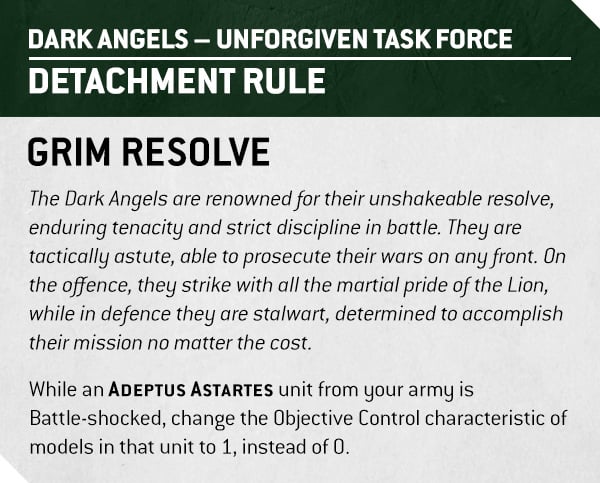
Buoyed by their ability to hold objectives to the very last man, the Deathwing can teleport right into the heart of the battle as an immovable barricade, safe in the knowledge that points will be scored no matter the cost.
The Deathwing Command Squad packs a laundry list of special abilities, including the only Apothecary you’ll find in Terminator armour. His Narthecium can bring back a whole Terminator every single turn – that’s up to four Wounds of value for shield-bearing veterans!
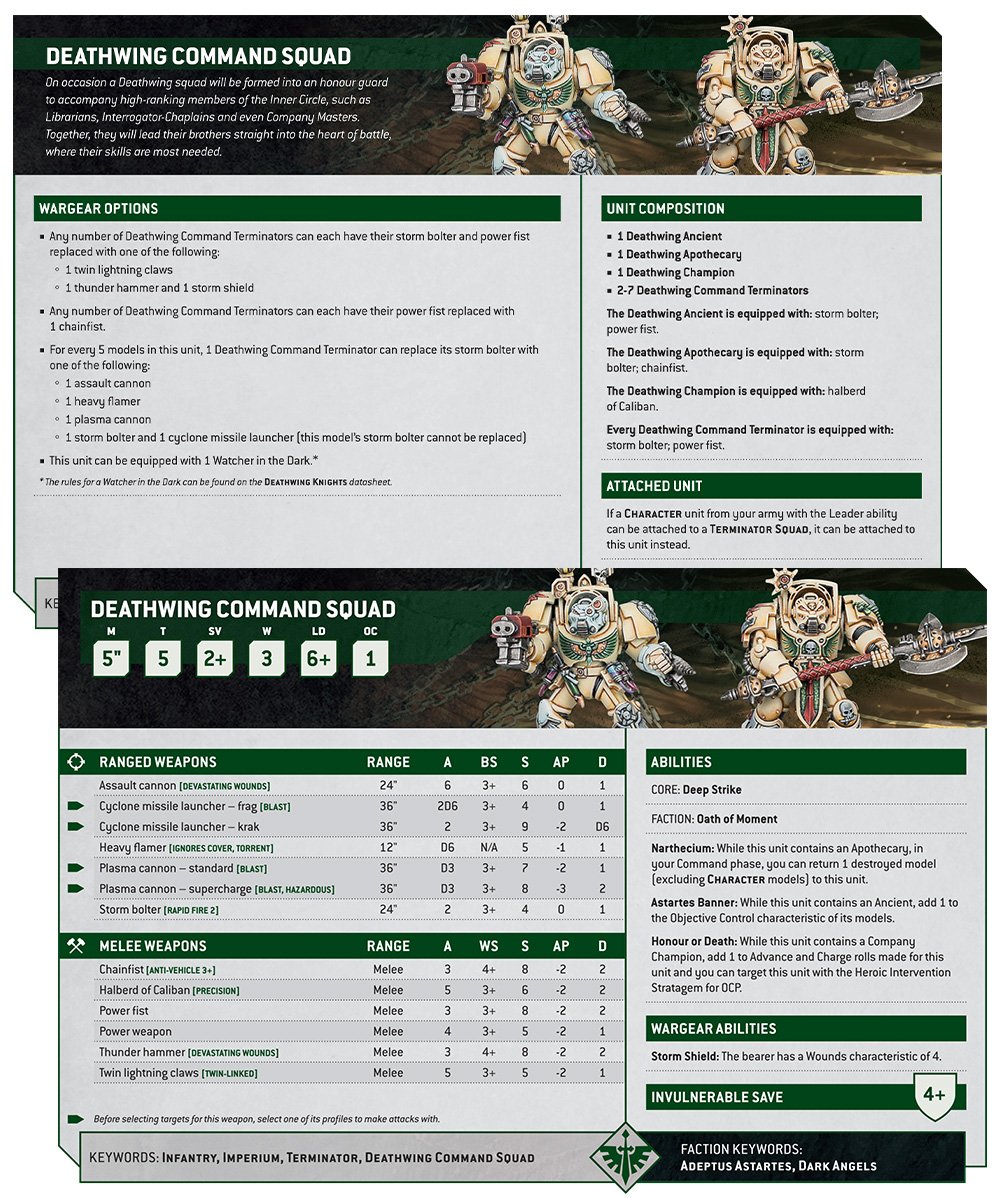
Finally, the Dark Angels have recently been joined by a leonine celebrity from days of yore. Yep, it’s Lion El’Jonson. If you missed out on the Lion and Retinue box, you won’t have long until the Lord of the First gets a solo release. We had hoped he would make his individual debut before the new edition came out. However, we also wanted to ensure enough had been made to fulfil demand for such an incredible model. We’re making more, and we will therefore be putting him up for sale as one of the first Warhammer 40,000 miniatures released after Leviathan drops.
To make up for it, here’s his datasheet. He’s a beast – and you can check out how he stacks up against his bluer brother here.

Space Wolves
The chalk to the Dark Angels’ cheese, the Space Wolves are ferocious front-line fighters who love nothing more than a good scrap, a loud chorus, and a big old tankard of Fenrisian mjød. Their Chapter maintains a proud history of storytelling, with Characters competing to fulfil Deeds Worthy of Saga in the midst of combat – the better to boast about when the battle is inevitably won.
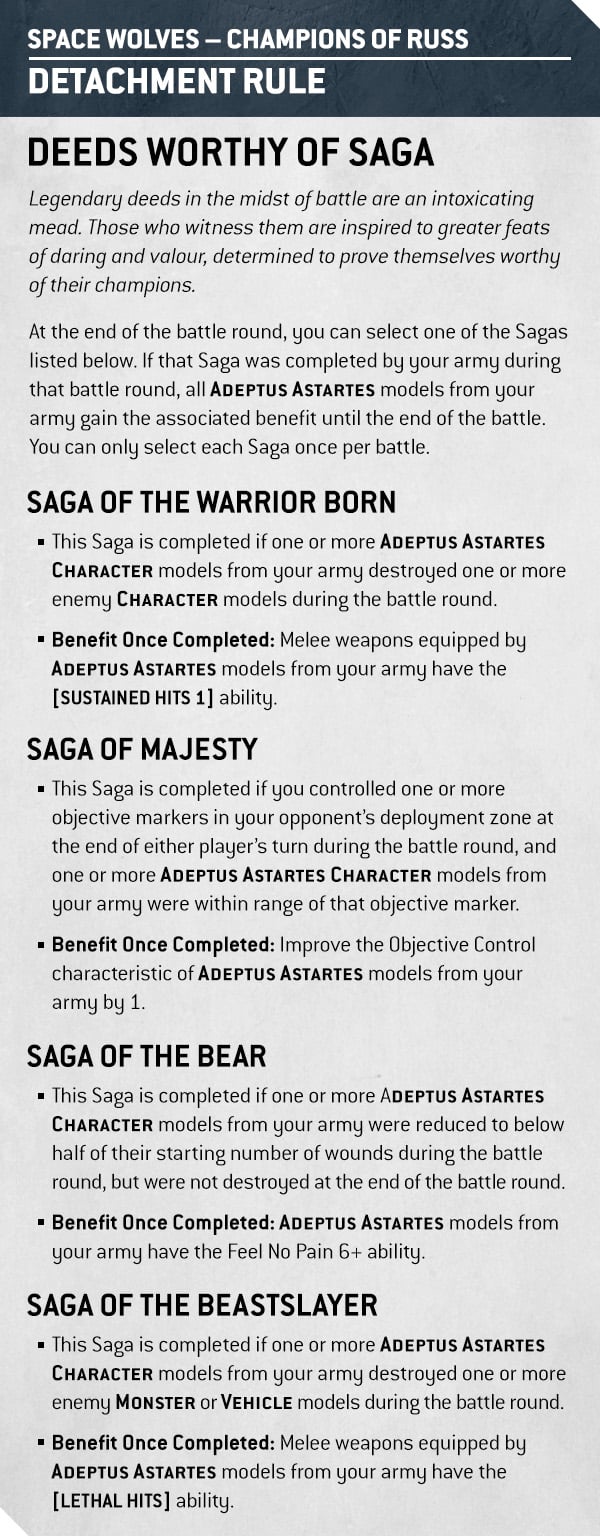
But beneath their boisterous behaviour and irrepressible wildness, the Space Wolves are as valiant as any other Space Marines, despite their disdain for the dictates of the Codex Astartes. Instead of Guilliman-approved battle formations, they form their warriors into specialist units like Wolf Guard and Blood Claws, even in the age of Cawl’s Primaris Space Marines.
One of the more recent developments are the Hounds of Morkai – expert hunters who daub their bodies in runic sigils and carry special equipment to hunt down psykers. They equip themselves in the style of Reivers, but with a unique vox-amplified howl that scrambles empyrean currents as they close in for the kill.

Blood Angels
The Blood Angels are perhaps the most beloved and respected Chapter in the galaxy, known for their glorious self-sacrifice and willingness to defend every one of the Imperium’s citizens. Yet despite this nobility, their gene-seed harbours a terrible flaw, and the Red Thirst urges them to acts of unbelievable violence in the heat of close combat.

When this compulsion for bloodshed fully clouds the mind of a Blood Angel and transforms into the infamous Black Rage, they’re inducted into the forlorn ranks of the Death Company. Here, they are shaped into a weapon of pure, mindless fury, that only a dedicated Chaplain can soothe enough to accomplish basic battlefield tasks.
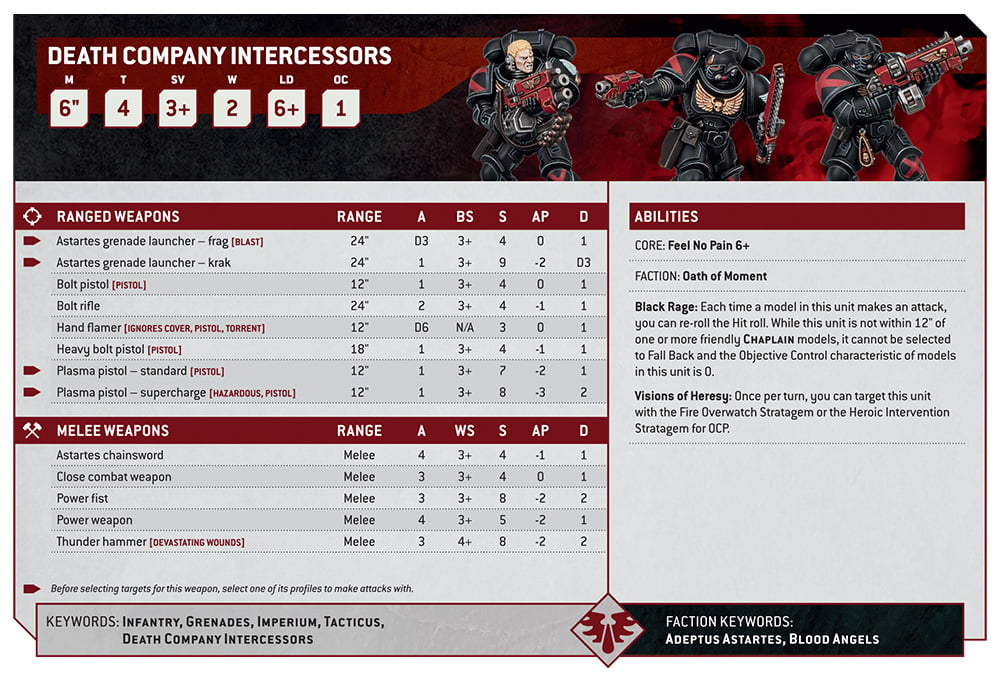
Many of their successors have risen to fame, like the bloodthirsty Flesh Tearers. Their Chapter Master, Gabriel Seth, is a great example of the way named successor Chapters work in the new edition – gaining all of the benefits of their parent Chapter’s Detachment but without the ability to mix Epic Heroes.
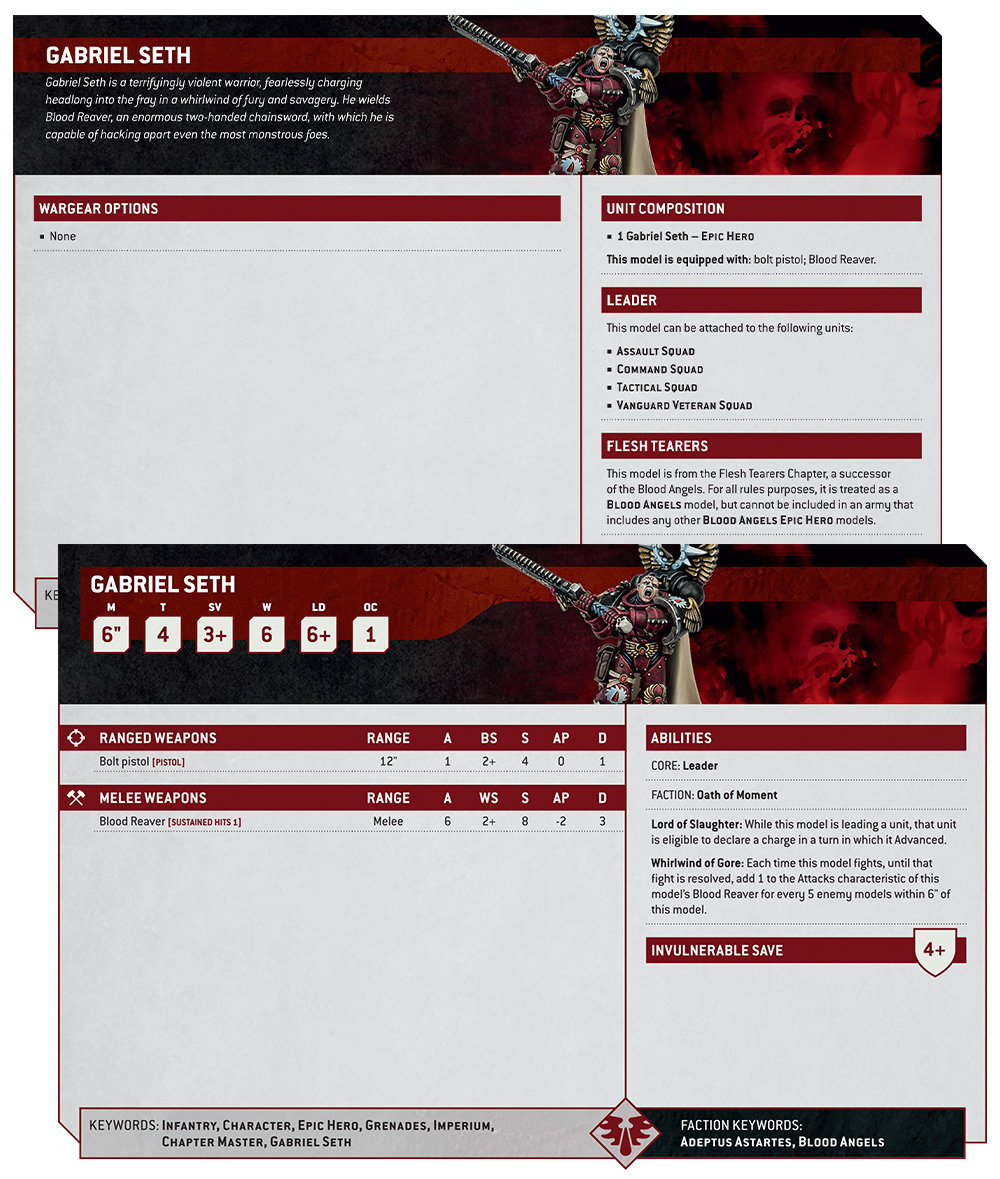
Did we mention he’s an absolute blender in close combat? Throw him at a huge mob of Ork Boyz and watch the heads fly.
Black Templars
Have you ever felt like the galaxy could do with a bit more faith and love for the God-Emperor? The Black Templars agree, and the Templar Vows they swear provide a choice of powerful abilities for every Adeptus Astartes unit in your army.

Their ability lets them choose at the start of the battle to fight on whatever terms best suit their game plan, but let’s not fool ourselves – whichever vow they swear, the end results will be dished out with a chainsword.
The Sword Brethren dominate up close, wielding a variety of weapons to cut down elites and chaff alike. Their Vow-sworn Bladesmen ability gives the Black Templars commander even more decisions to make, choosing between more attacks and more damage.
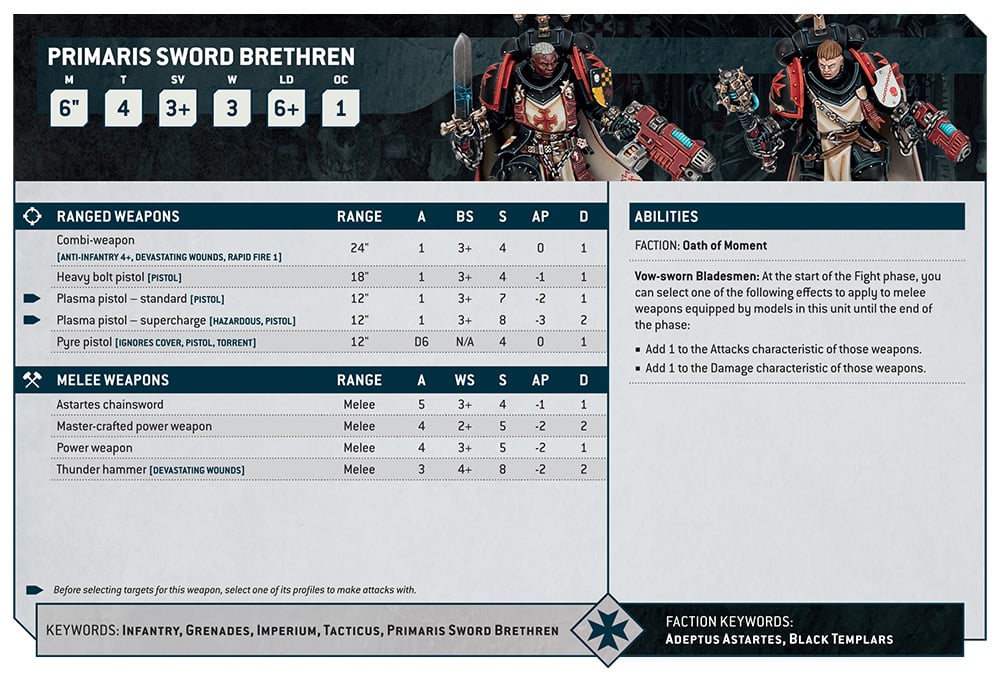
Deathwatch
The Deathwatch are not a Chapter per se, but rather an organisation that takes the best and brightest of the Space Marine Chapters for dedicated xenos hunting. The demands of their missions – which might find them chasing down Aeldari one day and rooting out a Genestealer Cult another – require flexibility above all, and all Deathwatch Veterans are trained to enact varying Mission Tactics at the perfect moment to succeed against impossible odds.

The heart of a Deathwatch force is its Kill Teams, which combine the skills and equipment of many different Space Marine units into a complex, adaptable team. Deathwatch Veterans are the apex of this philosophy, kitted out as necessary for long-range firepower or crushing melee combat, and with a particular knack for bringing Death to the Alien.
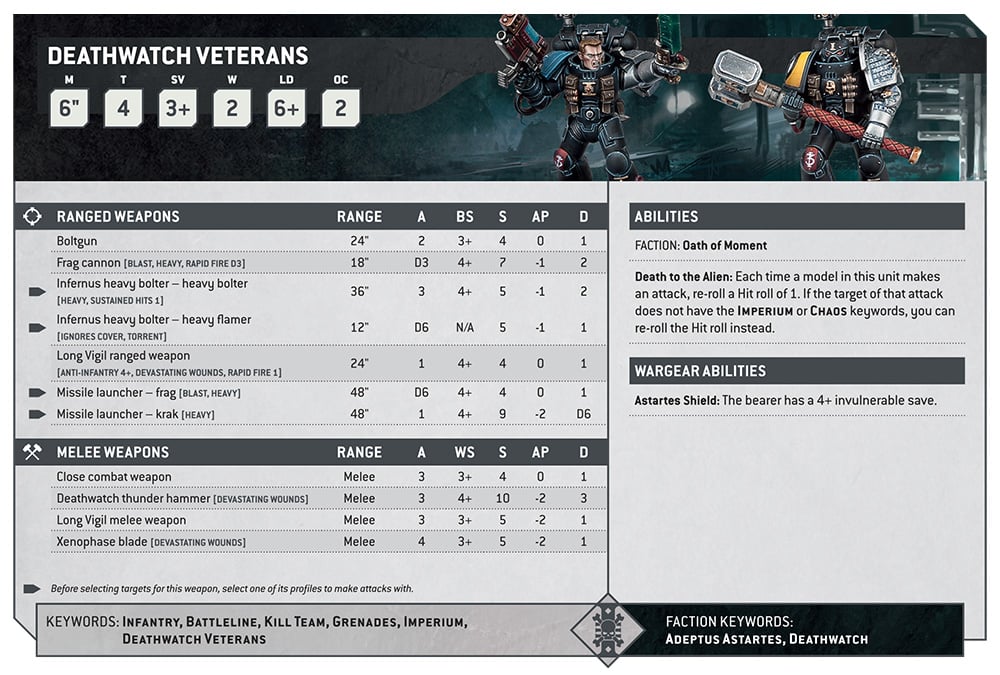
There’s only one more Faction Focus left in our series, and it’s a doozy – the Adeptus Titanicus wants a piece of the new edition, and they’ve brought their own datasheets along to show off how big their numbers go. Even if you don’t pack any of the insanely powerful god-engines in your army case, you won’t want to miss it, in case a Warhound darkens your deployment zone in the not-so-far future.
Overview
Today’s Faction Focus will be a little different, as Imperial Agents aren’t designed to operate as a faction in their own right – you’ll find no Detachment rules, Stratagems, or Enhancements in this Index. Instead, their units get to hang out with other Imperial armies, where their diverse skills can help mitigate a force’s potential weaknesses.
If you need a squad of Arbites infantry scuttling between the feet of your Imperial Knights, or deadly Assassins removing high-value targets ahead of your Cadian gunline, the Imperial Agents have you covered.
Faction Rules
How many units of Imperial Agents you can include in your IMPERIUM armies is determined by the battle size, and CHARACTER and RETINUE units have their own allowances – so you’ll never have to choose between Inquisitor Greyfax and her Henchmen. As Assigned Agents, they won’t benefit from the parent faction’s army rule or Detachment abilities, but their presence alone is a worthy trade.

Unit Spotlight
Since every unit is equipped differently, we’ll be looking squarely at the datasheets on offer today. First billing goes to the undisputed master of marksmanship, the Vindicare Assassin – the last word in long-distance problem removal. Their unparalleled accuracy makes them a nightmare for CHARACTERS who think they’re safe hiding amongst their bodyguards. And with the Lone Operative rule, they can stay safely away from enemy forces who’d need to get within 12” to even start shooting back.
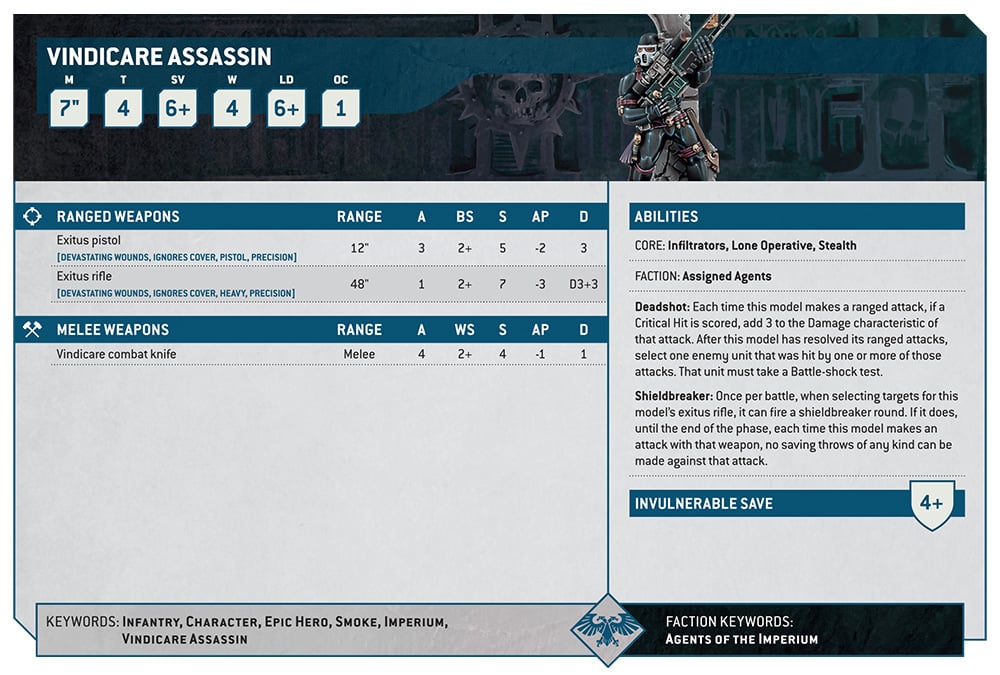
Inquisitors take more of a supporting role on the battlefield. They’re capable fighters, but they’re still only Human and don’t appreciate being placed in too much danger. The paramount ability of the standard Inquisitor – insofar as there is such a thing – is Power of the Rosette. This gives a high chance to refund one Command point spent on a Stratagem for their unit – and since they can join any IMPERIUM BATTLELINE INFANTRY unit, the possibilities for cut-price Stratagem activations are endless.
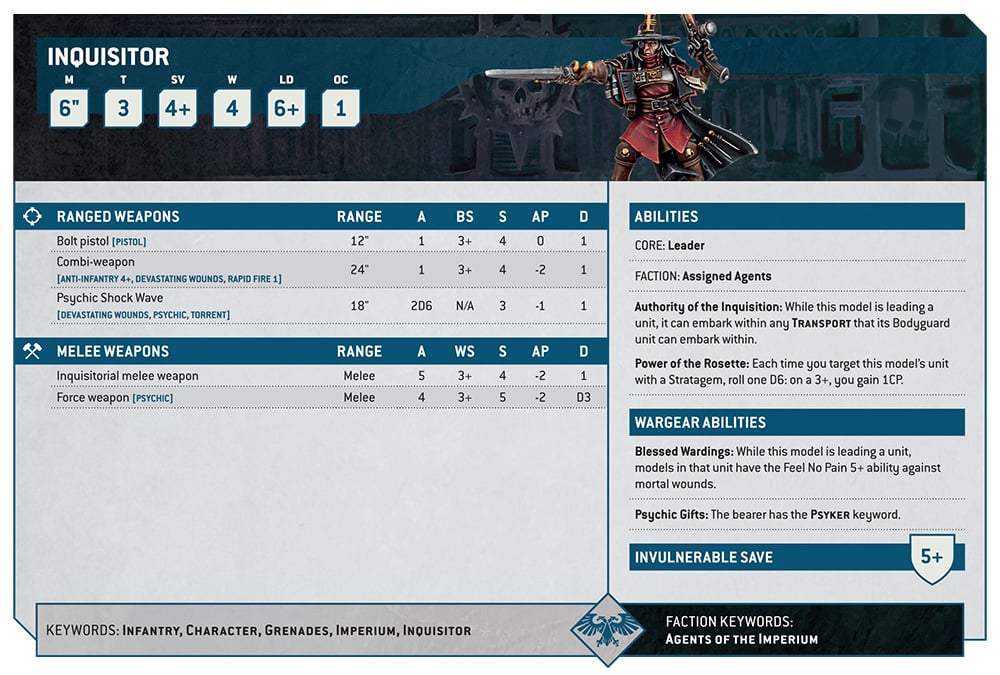
If your long-range forces need a bit of supplementary close-range firepower, give the dependable Imperial Navy Breachers a call. Their diverse armoury packs a respectable punch whether they’re shooting or fighting in close combat, and as a skilled Breaching Team they’re even better when attacking enemy units holding objectives – objectives they can easily claim as their own thanks to an Objective Control characteristic of 2.

You may even be lucky enough to be graced with the presence of one of the most renowned heroes of the Imperium, with Inquisitor Eisenhorn, Inquisitor Coteaz, Lord Inquisitor Draxus, and everyone’s favourite mech-riding fanatic Inquisitor Karamazov all returning. Inquisitor Greyfax has been at the forefront of the Inquisition’s most recent witch-hunting wars, and can deploy her Psyoculum to fashion even basic infantry into a potent anti-psyker force.
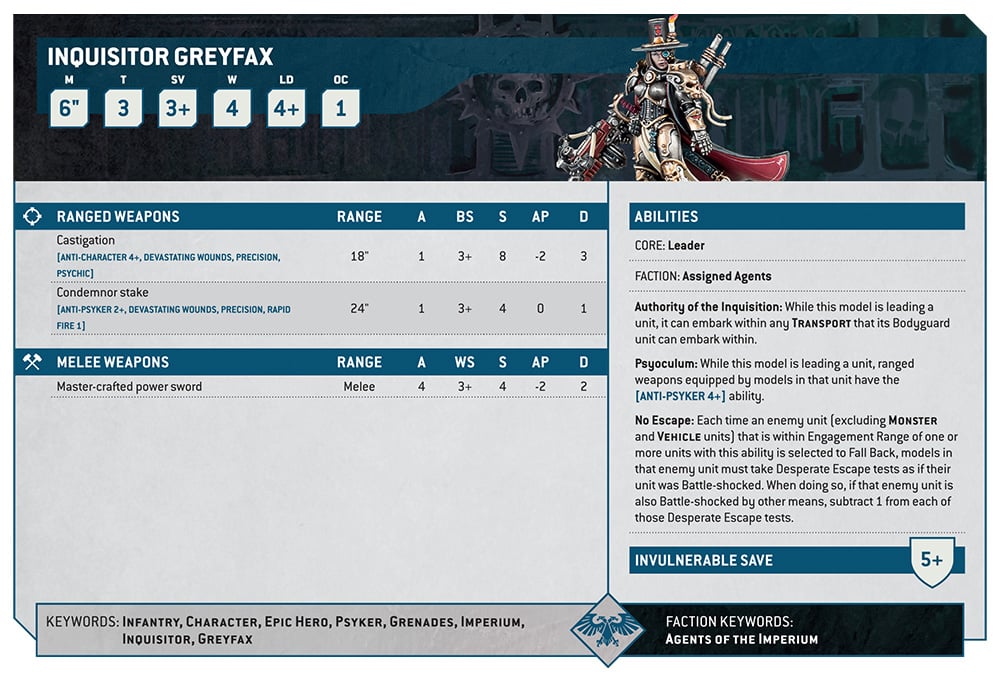
The Word from the Studio
“The Agents of the Imperium datasheets cover a diverse range of specialists; everything from Assassins and Inquisitors to Rogue Traders and the Adeptus Arbites,” explains Robin from the Warhammer Design Studio.
“While you could field an entire army of these eclectic warriors, they have been designed first and foremost as allies for an IMPERIUM army, and the rules presented here cover how to incorporate them into such armies. From Space Marines to Astra Militarum, you’ll find the abilities and skills offered by the Agents of the Imperium datasheets add new utilities and tricks to your force.”
Overview
The Genestealer Cults combine cunning,* fanaticism, and monstrous alien horror. Numberless hordes of Neophyte Hybrids burst from sewers, mine workings, and rusted conduits to overwhelm their enemies. Fast-moving Atalan Jackals and Achilles Ridgerunners outflank foes while Sanctus assassins take out key targets. Twisted Abominants and Aberrants smash through the toughest enemy defences as the Kelermorph starts blasting with its liberator autostubs.
The Genestealer Cults also have a number of extra tricks up their grubby sleeves for the new edition of Warhammer 40,000…
Faction Rules
Cult Ambush returns as the Genestealer Cults army rule, but with some major changes. Every Genestealer Cults INFANTRY unit now has the Deep Strike core ability, so most of your army can already show up where your enemy least expects it – instead, Cult Ambush allows you to martyr your squads for the rebellion, and then call in identical reinforcements inspired by their sacrifice!
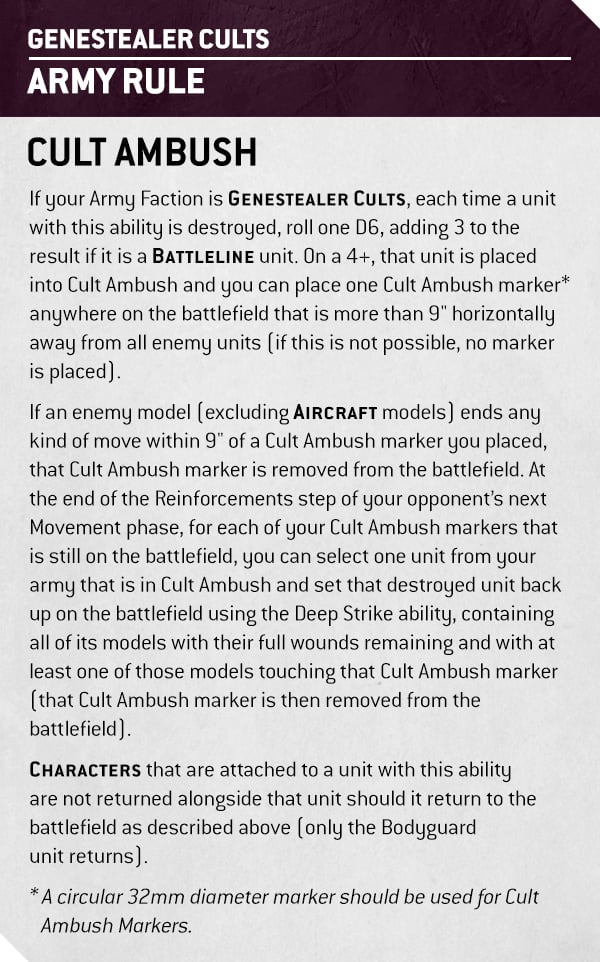
This is especially great for your BATTLELINE units – Neophyte Hybrids and Acolyte Hybrids. These both have OC2, so after they’ve been destroyed you can reliably bring them back to claim an objective marker deep in enemy territory… or just aim their guns and claws at a key enemy unit.
When your forces arrive as Reinforcements – whether by Deep Strike, Strategic Reserves, or through Cult Ambush – you also get to use the Ascension Day Detachment rule. They Came From Below!
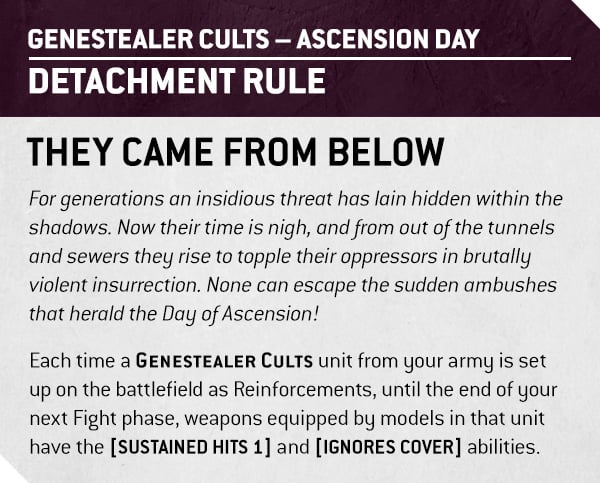
That Sustained Hits 1 ability applies to scavenged guns and mutant blades alike, helping you bring down anything standing in the way of the glorious revolution.
On top of that, you can still include Astra Militarum units in your army as Brood Brothers. This represents the Cult sending its tendrils into the ranks of the planet’s military forces, influencing those troops to recant their oaths to the God-Emperor and throw in their lot with the Patriarch.
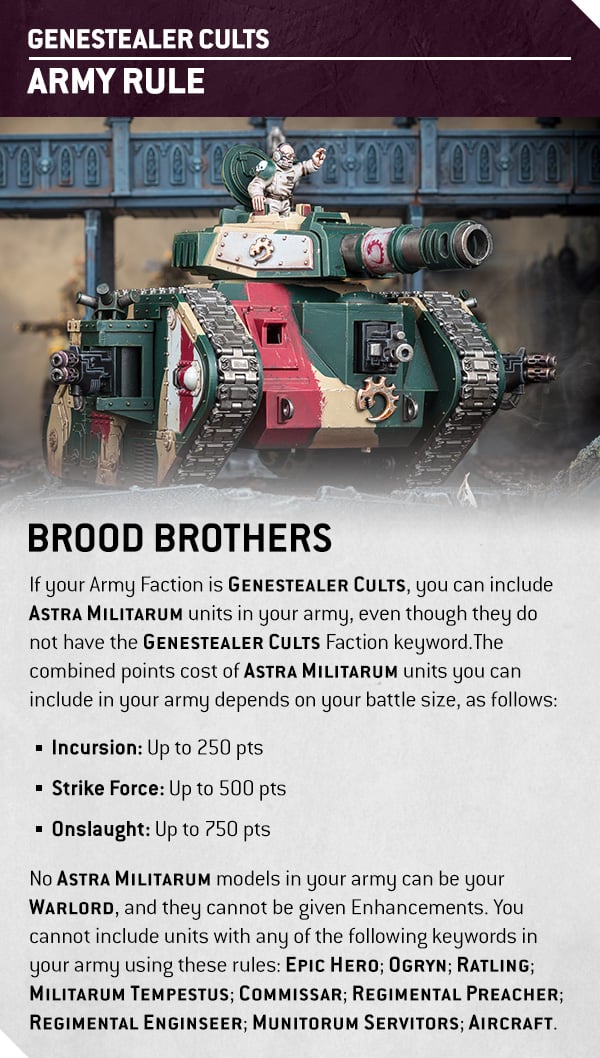
Alas, the no Epic Heroes condition means you can’t hypnotise or infect characters like Lord Solar Leontus, but you can still add extra tactical options to your army, such as Leman Russ tanks, Field Ordnance Batteries, or Deathstrikes.
Unit Spotlight
We’ve already seen that you can bring your Neophyte Hybrids back from the dead – now, let’s take a look at the datasheet of a unit that makes up the majority of most Genestealer Cults.

As though Cult Ambush recycling whole squads wasn’t bad enough, a Cult Icon can inspire replacements for destroyed models within each unit. If enemy tacticians think they can avoid triggering Cult Ambush by simply mauling and ignoring your troops, rather than destroying them, they’re sorely mistaken. Meanwhile, you can put the squad in a Goliath Truck to take advantage of its Firing Deck 12 ability.
If the Neophyte Hybrids are the core of the army then the Patriarch is its alpha predator. This alien vector for genetic infection is a demigod to its followers, and when the Day of Ascension arrives, they’re at the forefront of the fighting.

Attach this fearsome creature to a unit of Purestrain Genestealers to grant them the Devastating Wounds ability, making it even easier to slice your way through your enemies with those lethal claws.
Weapon Spotlight
The Genestealer Cults have a wide range of weaponry, from the mining tools employed by Acolyte Hybrids and the improvised weapons clutched by Aberrants to the deadly blades of the Locus. If you prefer something a little more underhand, there are the various bombs of the Reductus Saboteur – it turns out that with enough tinkering, almost anything can become an explosive device.

Use those demolition charges to take out a single high-Toughness target, and the remote explosives to bomb enemy hordes wherever they hide. Hopefully, you won’t blow off half of your face like the Reductus Saboteur.
That’s fine for the Shooting phase, but what if you prefer getting up close and personal? Well, how about a hammer? It is called WarHAMMER, after all.
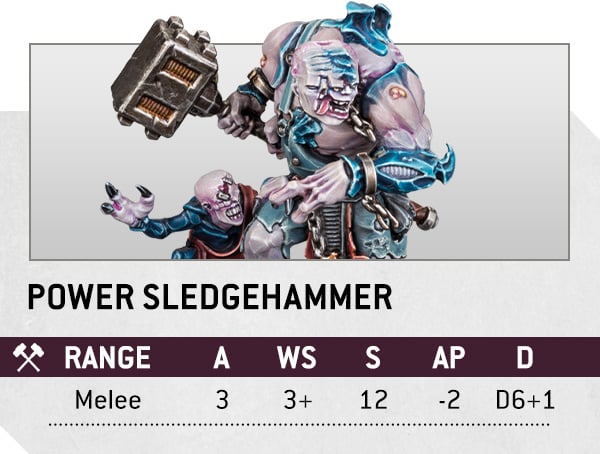
The old saying states that when you have a hammer, you see all problems as nails. Well, the Abominant doesn’t see problems or nails, just smashed bones and twisted metal after it’s hit them with its power sledgehammer.
Stratagem Spotlight
While the old Crossfire ability is no longer an army rule, there are still benefits to doubling up your units and catching unfortunate enemies in a Coordinated Trap.
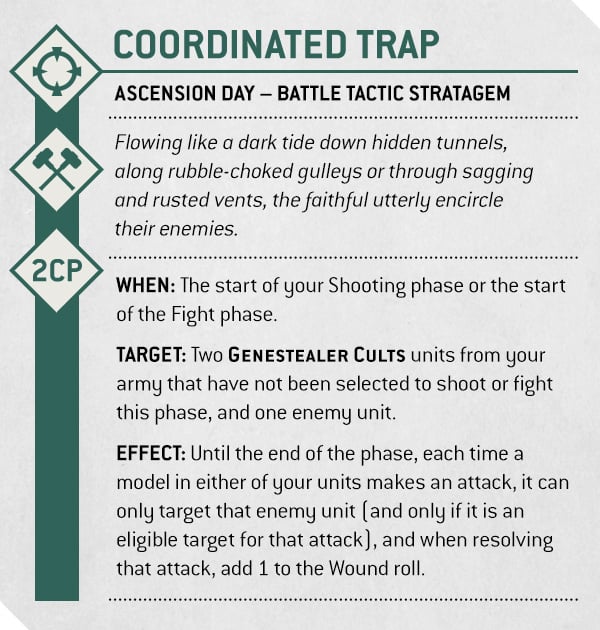
Use this on a couple of Neophyte Hybrid squads in the Shooting phase to gun down your foe in a hail of hybrid firearms,** heavy stubbers, and seismic cannons. Alternatively, use it on a pair of Hybrid Metamorph*** squads to tear through an enemy with a pincer movement of metamorph mutations.
As we’ve seen, your squads are already dangerous enough when they arrive on the battlefield – but these Tunnel Crawlers can be even more troublesome if they pop up right next to a target unit.
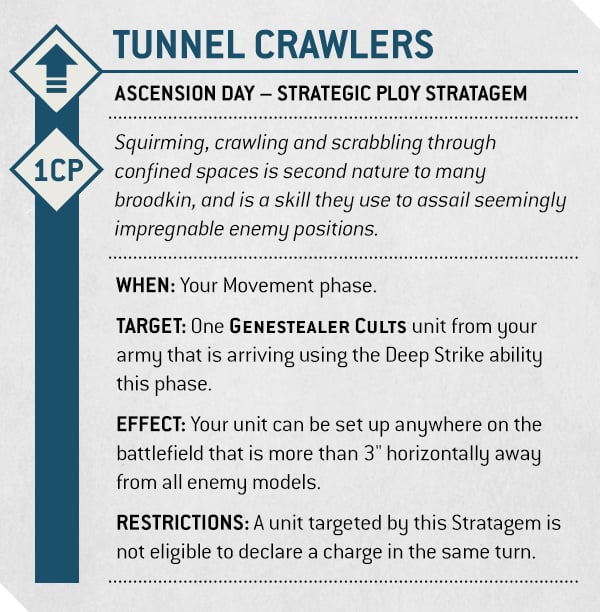
Whether you’re sneaking onto an objective your opponent thought they had guarded, getting up close for a point-blank salvo, or simply forcing the enemy to deal with an unexpected blockade, it’s a perfect Stratagem for giving your opponent a surprise they’ll never forget.
The Word from the Studio
The insidious Genestealer Cults have even infiltrated the Warhammer Studio! Here’s what they have to say about the changes.
“In redesigning the Cult Ambush rule, we wanted to emphasise the persistent, insidious threat posed by Genestealer Cultists,” explains James. “Even as their numbers are culled in one location, reinforcements are likely to reveal themselves elsewhere, giving the opponent the uneasy feeling that the Cult is never quite stamped out!
“The Leader ability also opens up many exciting possibilities for this faction, with some supporting Characters able to lend their own abilities to units already led by a Primus, Magus, or Acolyte Iconward. From the Fights First ability conferred by the Locus to the Lethal Hits weapon ability a Biophagus brings with them, there are many devious ways to punish the foes of the Cult.
Overview
Grey Knights are tasked with vanquishing all things born from the warp, armed with sanctified wargear and specialist training designed to take down creatures of the empyrean. They’re just as deadly when facing more material factions, however – disciplined psychic abilities, finely-honed blades, and barking storm bolters make Grey Knights a terror on the assault, and their signature teleport strikes will decapitate an Ork Waaagh! or a Hive Fleet incursion as easily as any Chaos cult.
Faction Rules
As far as the Imperial citizens lucky enough to see them* are concerned, the Grey Knights are a pure embodiment of the Emperor’s divine wrath – they appear from nowhere in a flash of light and fury, their shining silver armour blazing with a corona of psychic energy. The Sons of Titan employ teleportation with a skill few can match, deploying – and even re-deploying – in massed Teleport Assaults guided by their Prognosticars and protected from the hazards of the warp.

The ability to pick up a handful of units each round and put them back down wherever you like is a powerful tool, especially considering every INFANTRY unit in their roster** – plus the hulking Nemesis Dreadknight suits – also comes with the Deep Strike ability as standard.

Grey Knights always get to fight on ground of their own choosing, and any opponent will face an uphill struggle to pin them down or isolate objectives. Seizing control of the battlefield becomes even harder when faced with a Teleport Strike Force Detachment – faced with tricky terrain or blockading troops, these warriors can simply Teleport Shunt their way right through.
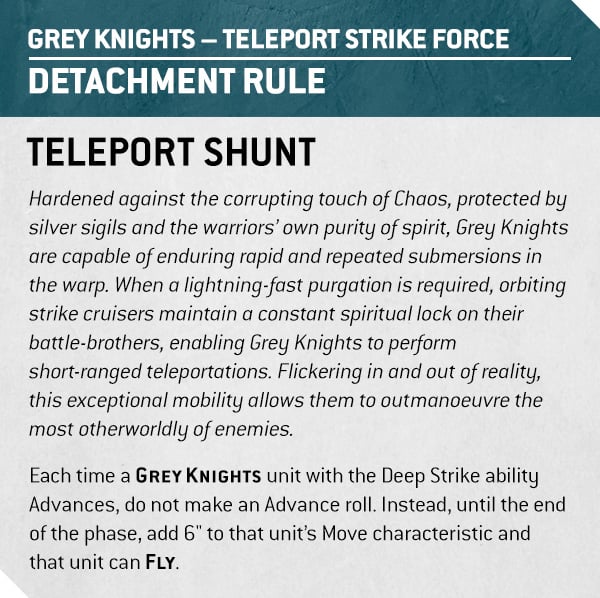
Unit Spotlight
Although they have plenty of vehicles to aid their assaults, Grey Knights are primarily an infantry force, with a variety of specialised squads. Purgation Squads, for instance, can use their Astral Aim to draw lines of fire through the eyes of their battle-brothers, shooting powerful firearms at targets they can’t even see.
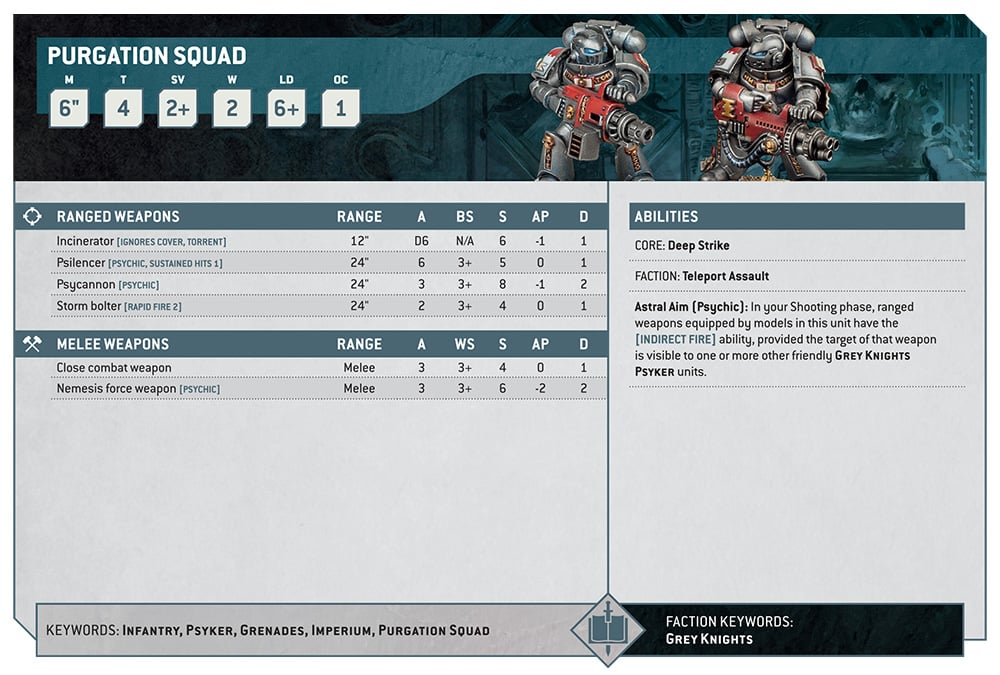
Coupled with the excellent mobility provided by their army rule, Purgation Squads can easily scoot behind cover before unleashing a fusillade from unexpected quarters.
When overt, in-your-face power is the order of the day, Grey Knights can instead strap into their unique Nemesis Dreadknights. These massive walking warsuits give individual warriors the ability to go toe-to-toe with Greater Daemons and prevail – especially for a Grand Master, who can unleash a Surge of Wrath to slaughter the biggest baddies.

Weapon Spotlight
Every member of the Grey Knights is a walking wellspring of psychic power, and each unit has a different psychic ability. Purifier Squads are all about incinerating their enemies up close with radiant soulfire, and their Purifying Flame psychic weapon adds a potent short-ranged blast to go along with their storm bolters and special weapons.
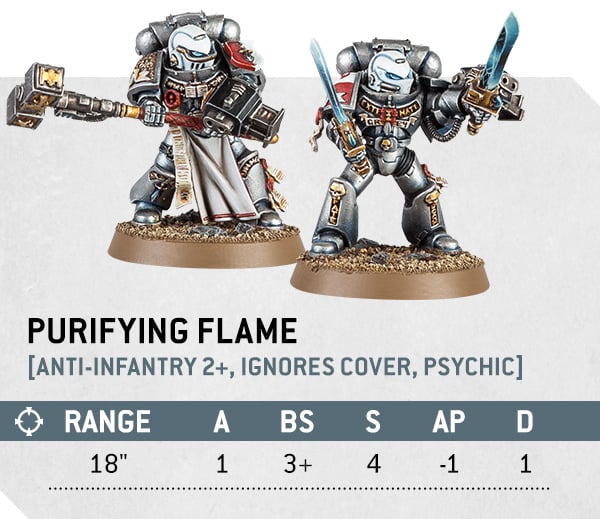
Stratagem Spotlight
Many of the Teleport Strike Force Stratagems take advantage of their coming-and-going by granting boons to units that just arrived by Deep Strike or Teleport Assault, enforcing their role as a series of precise hammer blows that land wherever the enemy doesn’t want them. Keeping your limited numbers safe during these dangerous manoeuvres is of paramount importance – fortunately, enemy marksmen have serious trouble aiming at squads Haloed in Soulfire.

When a charge hits home and those nemesis force weapons start chopping, extra motes of psychic power can be channelled directly into the blades themselves, wreathing swords and halberds in searing flame that slices through armour and potentially even invulnerable saves with each Radiant Strike.

The Word from the Studio
“The Grey Knights are an indomitable force of empyrically-charged Space Marines who make your regular Adeptus Astartes look friendly by comparison,” explains Scott from the Warhammer Design Studio. “They’re famed for appearing seemingly from nowhere, especially when the denizens of the warp are involved, and this has been reflected in their army rule and Detachment rule – giving them unparalleled mobility at all times during battle as they rapidly reposition to adapt to threats.
“Grey Knights have also become tougher and more elite, as befits their reputation and tactics, with many units gaining an improvement to their Save characteristic – often to 2+! Their psychic abilities also focus on their mastery of the warp to improve their prowess, rather than directly harming their foes. After all, none know better the perils of the warp…”
Overview
Thousand Sons are the army of choice for anyone who enjoys employing arcane artifice to unmake their enemies. The Traitor Legion’s sorcerous overlords perform terrifying rituals, calling on the labour of lesser wizards embedded within cohorts of relentless and resilient automata. These forces are most effective at mid-range, where they can unleash fusillades of enchanted firepower and magical bolts. Ancient war machines and foul Daemon Engines harry distant enemies with long-range support, while herds of screeching Tzaangor mutants occupy anyone who attempts to interrupt your studies in melee.
The Thousand Sons employ psychic powers with greater variety and flair than any other faction – and their rules reflect this puissance..
Faction Rules
The Thousand Sons wage war through their command of the arcane, conducting esoteric rituals that allow them to dominate the battlefield. This Cabal of Sorcerers pools their powers together each battle round, individual units generating Cabal points which you can spend to perform a variety of potent Rituals.

Psykers have become more specialised in the new edition of Warhammer 40,000, but the sons of Magnus – as ever – defy convention. Each Ritual is a powerful psychic ability channelled through one of your THOUSAND SONS PSYKERS, greatly expanding the arcane techniques available to even the maddest Tzaangor Shaman.
Will you become a Weaver of Fates to re-roll a vital saving throw? Or pluck intriguing Echoes from the Warp to employ a free Stratagem – even one you’ve already used this phase? Just crack open your spellbook and get to work.

The Cult of Magic Detachment offers even more tools to spice up your eldritch output, starting with its practice of Kindred Sorcery. This rule allows you to tinker with all of your Psychic weapons* each round – would you rather consume entire hordes in a Psychic Maelstrom of Sustained Hits 1, or inflict Devastating Wounds that will melt even Terminator armour with the Wrath of the Immaterium?
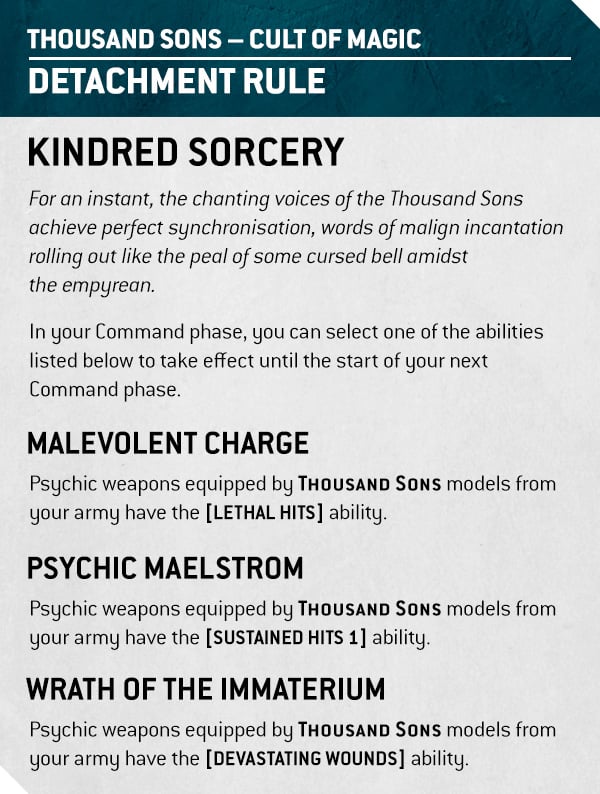
Unit Spotlight
Azhek Ahriman is well versed in working with cabals of like-minded wizards, though not always to great results – after all, the former Chief Librarian was responsible for the Rubric that turned the majority of his Legion into dusty automata. The master of the Prodigal Sons adds three Cabal points to your pool – a hefty contribution, second only to Magnus himself – and as the Arch-Sorcerer of Tzeentch he can also cast one Ritual for free.
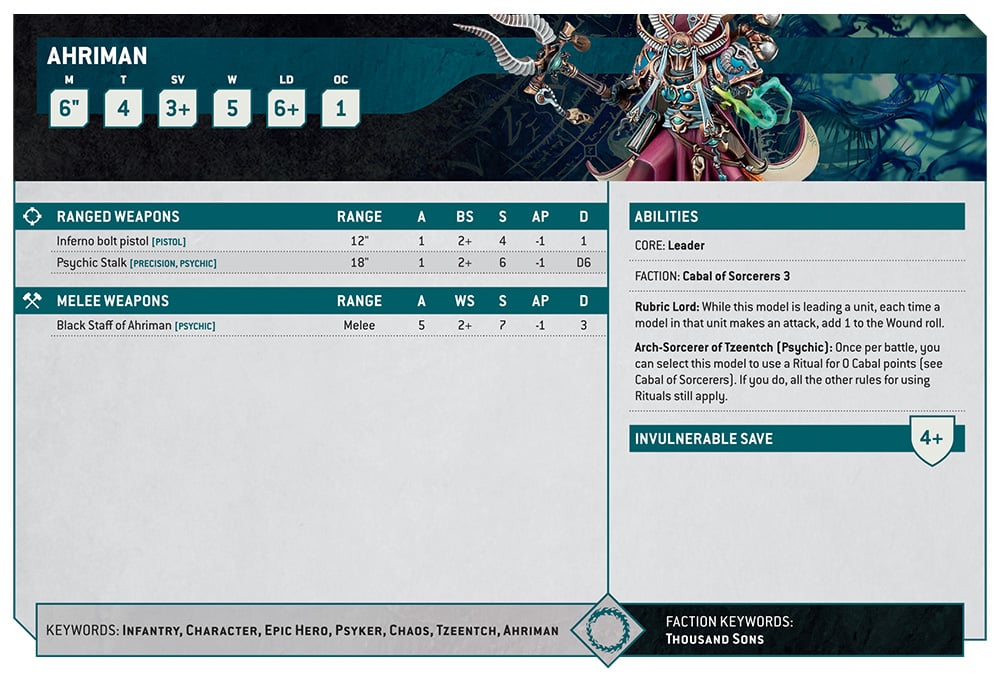
The Rubric of Ahriman augmented the psychic powers of those Sorcerers who survived, but turned the bulk of the Legion into soul-shackled suits of power armour. Battle stirs long-forgotten instincts in these Rubric Marines, awakening arcane automata into Bringers of Change who advance on ritual locations and enemy strongholds in implacable lockstep, unleashing withering salvos of firepower.
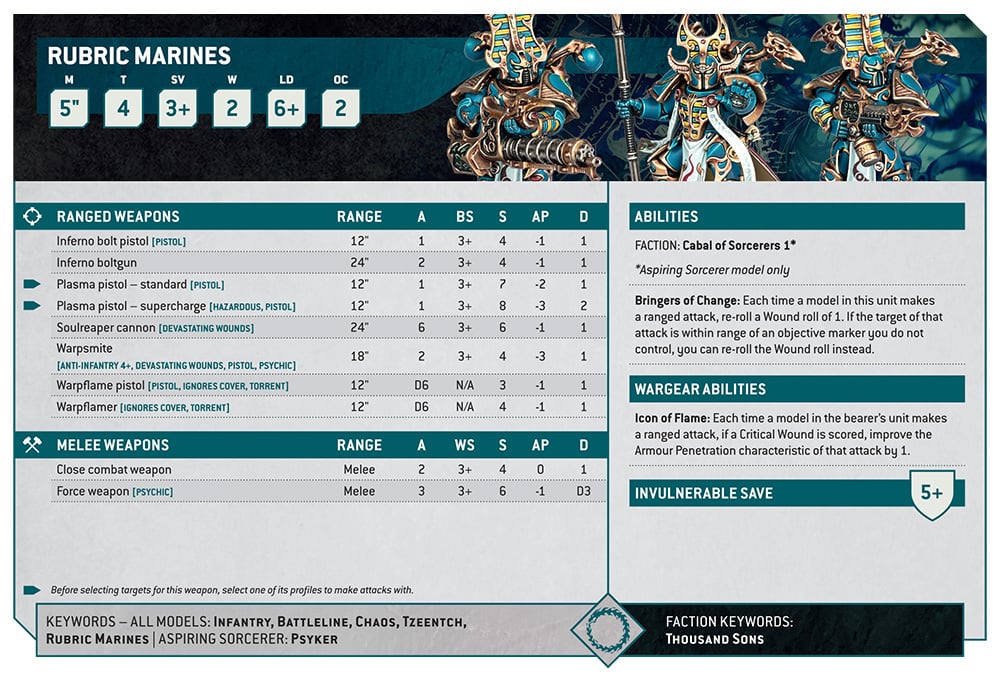
Each unit of Rubric Marines is led by a flesh-and-blood Aspiring Sorcerer who guides his ghostly brothers into battle. Each of these apprentice magicians adds to your total pool of Cabal points each round, acts as a locus to channel vital Rituals, and can perform a really neat magic trick where they make enemy INFANTRY disappear with a kaleidoscopic warpsmite.
Weapon Spotlight
The inferno boltguns and warpflamers of the Thousand Sons utilise sorcerous energy to melt flesh and armour like wax, but a Mutalith Vortex Beast can channel the pure essence of the immaterium through its warp vortex – mutating foes into misshapen forms incapable of posing a threat.
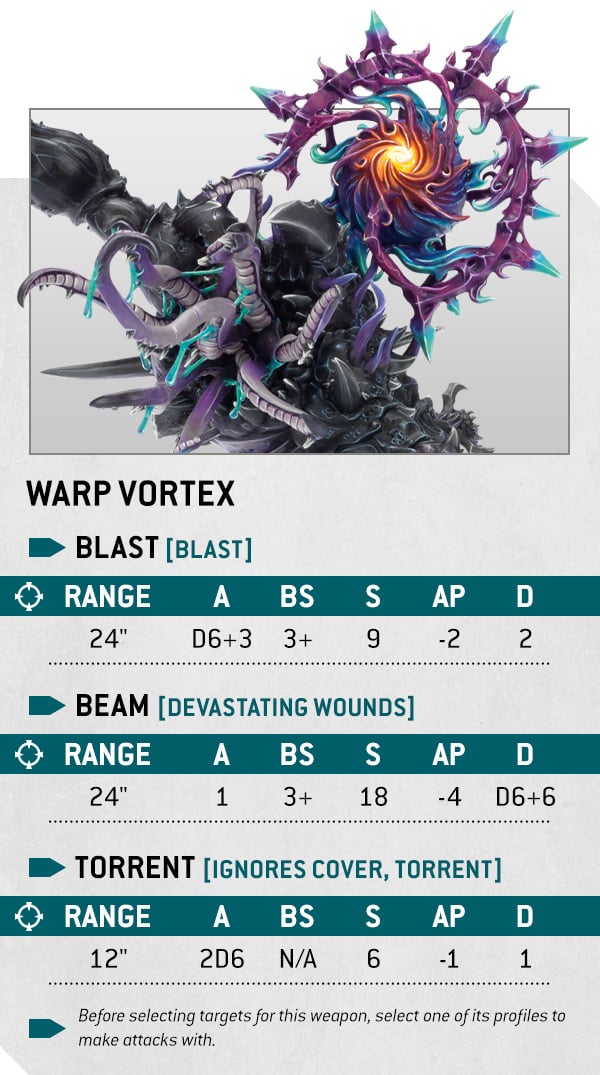
These grotesque creatures have such a profound weakening effect on the fabric of reality that nearby THOUSAND SONS PSYKERS can double the range of their Rituals, making them valuable for more than just their soul-melting presence and betentacled maw.

Stratagem Spotlight
Mastery of the empyrean doesn’t just cover empowering your own forces – the Thousand Sons also tamper with powers unleashed by their foes, displaying their Psychic Dominion by dampening even the most devastating psychic assaults.
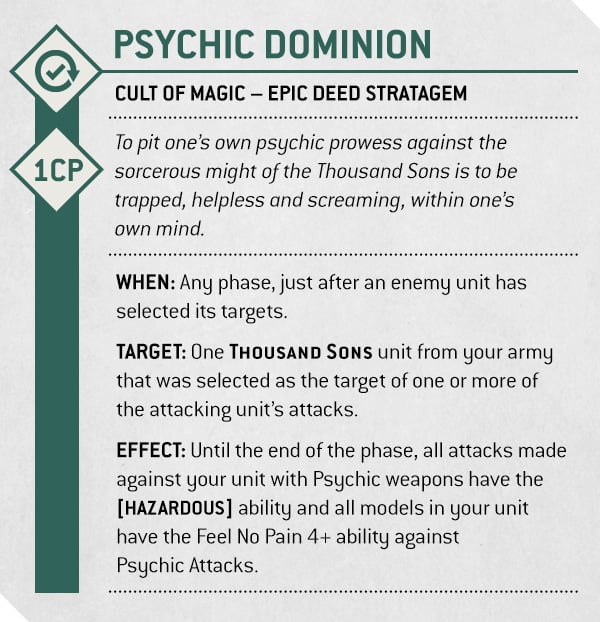
This Stratagem capitalises on the hubris of foes who think they can step up against the masters of sorcery. It grants all Psychic weapons that target the affected unit the Hazardous ability – meaning the offending psyker risks mortal wounds or even outright destruction – and adds insult to injury by blessing the models in the targeted unit with Feel No Pain 4+ against those Psychic Attacks.**
The Word from the Studio
“The Thousand Sons are the cursed and damned children of their Primarch Magnus, and (mostly) willing followers of Tzeentch,” Scott from the Warhammer Design Studio told us. “Ever making the best of a bad situation, the still-living sorcerers lean on their duplicitous warp powers to march their less fortunate brethren to battle as near automata, manipulating reality to suit their twisted desires.
“To really evoke the feeling of change and opportunism, the army rule Cabal of Sorcerers offers the Thousand Sons tools to deal additional damage, gain extra movement, utilise teleportation, and even get free additional uses of already-used Stratagems! Coupled with their Detachment rule mutating their tactics to best deal with their enemies, they’re just as flexible as you’d expect from the Changer of Ways’ favoured servants.
“Magnus is also getting a real eye in this edition, with one of the most potent single profiles in the game. He shows his love for his misbegotten sons with a choice of auras that allow him to boost their mobility and offensive prowess – or he can play more selfishly, reducing Damage of incoming attacks and sabotaging enemy ranged weapons. Thousand Sons are replete with tricks and twists that are bound to make your opponent’s head swim – just be sure to bring plenty of psykers.”
Overview
If there’s a fight brewing, the Orks are going to be there – and they’re still one of the most flexible armies around. Want to run a big old horde of Boyz and Gretchin? That’s a Waaagh! Want to zoom into a fight with a road fleet of Boomdakka Snazzwagons, Shokkjump Dragstas, and Megatrakk Scrapjets? That’s a Waaagh!! Want to stomp across the battlefield in massive war machines like Gorkanauts and Morkanauts? That’s a Waaagh!!!
Faction Rules
When you hear “Orks”, what’s the one word you think of? Green? Well, yeah. Brutal? Kunnin’? Too right. Best? Obviously, but that isn’t the point. We’re talkin about the warcry heard across worlds, bellowed from an endless tide of tusked mouths. All together now – Waaagh!

Being able to charge and Advance in the same turn makes it easier to get right into a fight – which is where most of your ladz belong. Extra Strength and more Attacks in melee mean you can krump even harder – and an invulnerable save keeps your army alive and kicking, no matter how hard your enemy swings back.
Experienced Warbosses already know how to Waaagh!, but there are two changes you don’t want to miss. For one, this ability boosts EVERY model in your army. No fiddling about with different keywords. For two, you kick off a Waaagh! at the start of a battle round, not in your Command phase – so if you’re going second, you’ll get to use that invulnerable save to shrug off enemy dakka before you start declaring charges in your turn.
Orks are at their best when they Get Stuck In, and the Waaagh! Tribe Detachment rule gives you Sustained Hits on your melee weapons, from choppas to squighog jaws. That means you’ll land an extra hit for every Hit roll of 6 – one hit plus one hit equals two hits, which is twice as choppy as one hit!

This is fun on a big mob that’ll roll lots of dice, like a squad of 20 Boyz or a Hunta Rig bristling with sawblades and Butcha Boyz. More dice means more 6s, which means more killy. That’s how you really get stuck in.
Unit Spotlight
Orks are loaded with great units, but if you’re looking for something big, brutal, and belligerent – and BATTLELINE, to boot – look no further than the Beast Snagga Boyz.
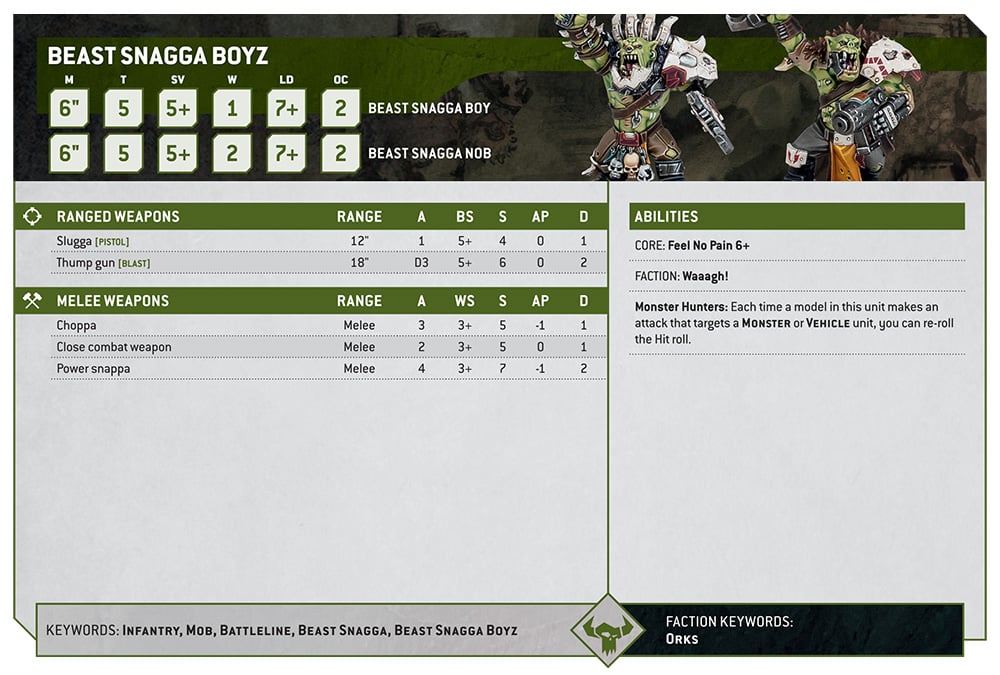
These trophy-hungry ladz are great for claiming anclaiming an objective or hurting your foes, and dead good at bringing down big targets – MONSTERS and VEHICLES better beware, even with how tough they’ve got lately.
Still, your Boyz are only as good as da Boss – any Boss knows that. And there’s no Boss as big as the biggest, baddest Boss of them all… Looking for a leader who’ll hack his way through anything dumb enough to get in the way? It’s Makari! Oh, and his big buddy, Ghazghkull Thraka.
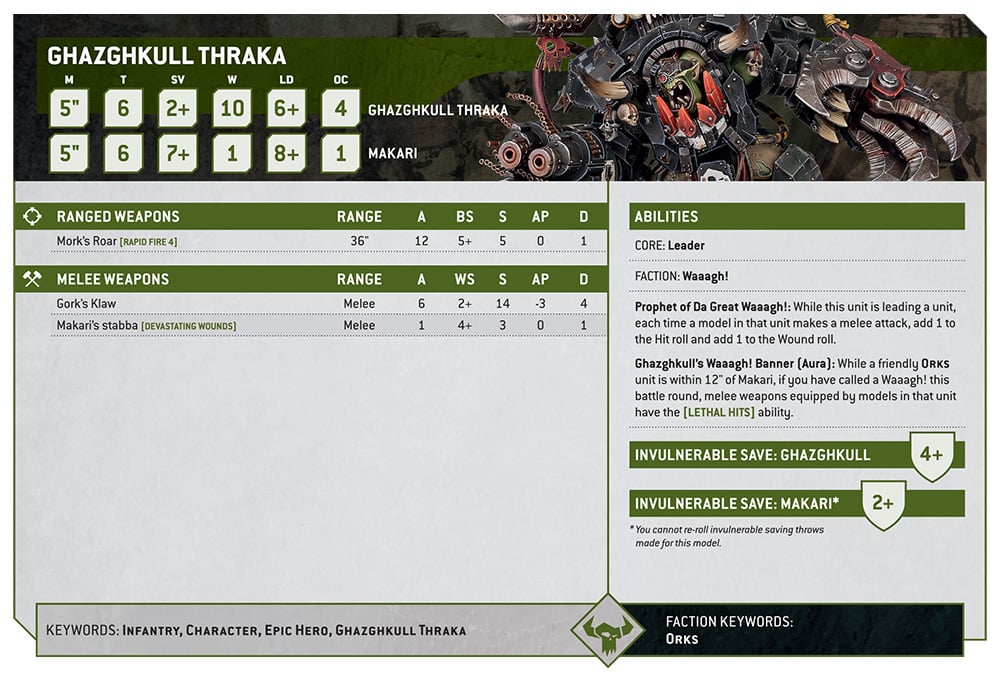
Big new Tyranid beastie? Brutalis Dreadnought? Something even bigger? Ghazghkull will tear them all to shreds with Gork’s Klaw – and as the Prophet of Da Great Waaagh!, his bodyguard of Meganobz gets even choppier. Er, klaw-ier?
Weapon Spotlight
Orks have plenty of teknical export-ease – which means it’s easy to export a bullet into someone’s noggin. The Meks cook up loads of different weapons, from shootas and sluggas to skorchas and snazzguns. The high point of Ork engineering has got to be the Stompa – a walking effigy of the Great Green Gods with enough guns to wipe out entire squads, like the hefty deffkannon.
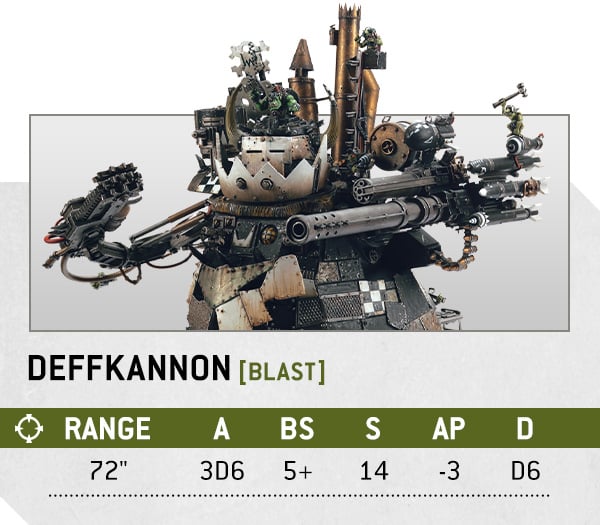
Like all Orks, this giant walker is even better at killing stuff up close and personal, with its advanced mega-choppa technology.** Those Imperial Knights will soon be nothing but chivalrous scrap.
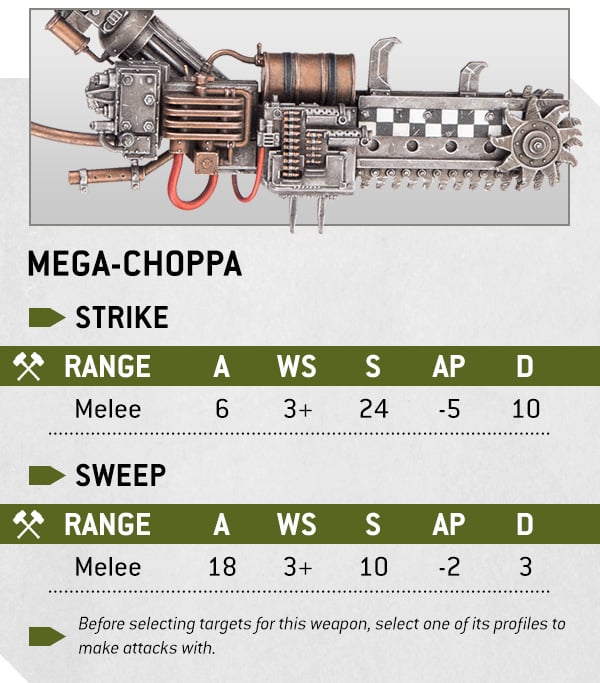
If you’re looking for something a little more low-tech, how about tossing a fungal ball of teeth and attitude at the enemy? The squig launchas on the Rukkatrukk Squigbuggy don’t have an explosive payload, but squigs are much worse.
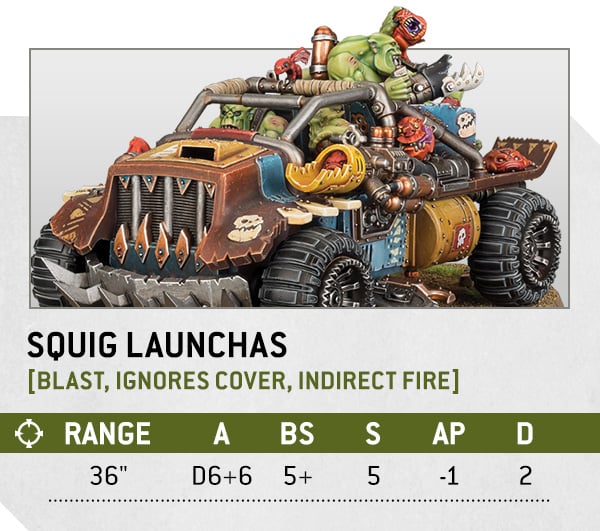
The Indirect Fire ability means even more flexibility to shoot at stuff as you skid around the battlefield – your enemies won’t know where those squigs are raining down from. And nor will the squigs, which is important in case they come back for revenge.
Stratagem Spotlight
Some say Orks don’t know much about tactics, but they’ve not heard of Mork, the Ork god who’s as cunning as he is brutal. Or that might be Gork? Anyway, there are bunch of Stratagems to reflect how Orks fight. We all know that Orks Is Never Beaten – even if they lose, they can always come back and have another go.
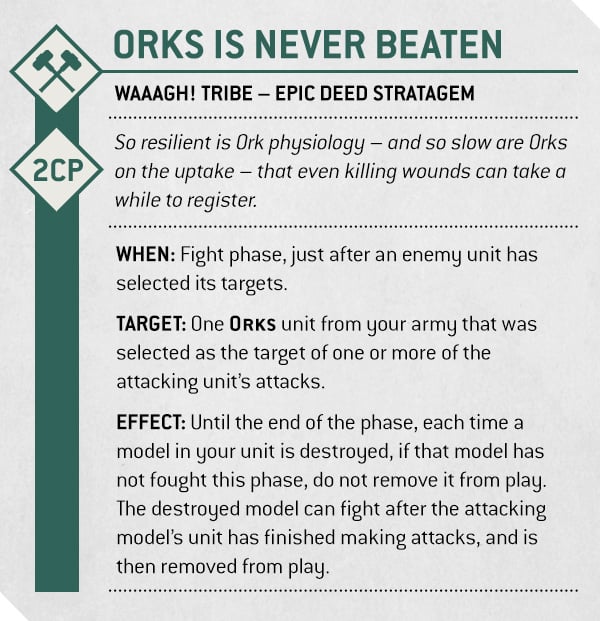
This is a great trick for valuable fighters like Killa Kans when they get jumped – now they can pinch back before going boom. If you want to make sure you’re the one getting the jump, ‘Ere We Go makes your infantry even faster.
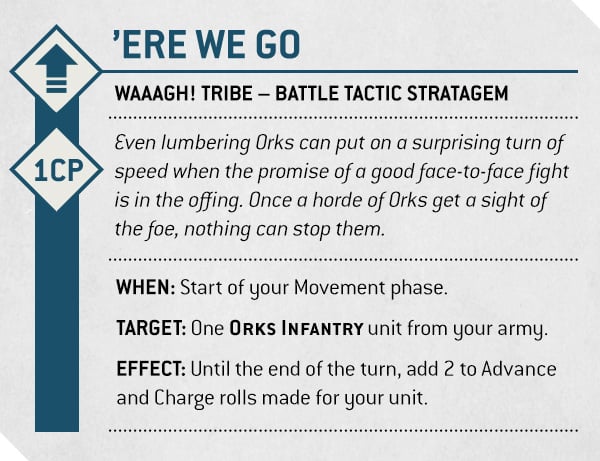
It’s even better than painting your armour red! It’ll help slower units like Ghazghkull get stuck in sooner, while improving the threat range of your speediest infantry like Stormboyz. Use it after you call a Waaagh! so you can add a bonus to your Advance AND Charge rolls in one turn. That’s two plus two, which is… lotz!
The Word From the Studio
“Orks are often viewed as a crude, blunt instrument of destruction, and although this remains true, they are still a faction requiring a kunnin’ mind to bring about that infamous brutality!” sez Scott from da Studio. “This is well represented in their army rule, which offers Ork players the chance to get stuck in, all proppa like, while also being a considerable defensive tool that players can use to keep their forces alive long enough to wreak havoc.
“Backed up by their Detachment rule, an army-wide Sustained Hits 1 in melee, you’ll rapidly find your Ork Boyz (who have -1 AP on their choppas!) will really bring the pain. Characters, some of which might not have been given a look in in the past – such as the reinvigorated Painboy – have really given Ork players plenty to think about when assembling their Green Tide! As for Da Great Green Prophet himself, Makari remains a lucky runt with his retinue guard, Ghazghkull, keeping him safe with an attack profile that’s sure to make Ork players Waaagh! with joy, especially when being backed up by a block of Meganobz!”
Overview
The Adeptus Custodes are to Space Marines what Space Marines are to mortal men – majestic, hand-crafted paragons of warfare built to serve as the last line of defence between the Emperor and those who would do him harm. Accordingly, even their most basic fighters are the equal of mighty heroes from other factions, and the arena of melee combat is where they truly shine brightest – with the dutiful Sisters of Silence providing specialist anti-psyker support.
Faction Rules
Every Custodian is a close combat expert, drilled in a hundred nuanced and subtle fighting styles – called Martial Ka’tahs – to face every possible opponent. Their rock-solid discipline makes shifting style mid-combat a breeze, moving from iron defence to all-out attack as the situation demands.

Buried under hordes of teeming alien chaff? The Dacatarai Stance will blend them up in moments. Charged by some optimistic but towering brutes? Adopt the Kaptaris Stance and parry their clumsy swings, then enter Rendax Stance in your turn to slice through their armoured hides. It really is that easy to become the undisputed master of the Fight phase.
Custodians deployed as part of a Shield Host exemplify the best qualities of the Ten Thousand – shining with a sliver of the Emperor’s own light, and blessed with a mote of his invulnerability. This Aegis of the Emperor protects them from the most grievous injuries imaginable, for the galaxy is full of unspeakable horrors that threaten even the Adeptus Custodes.
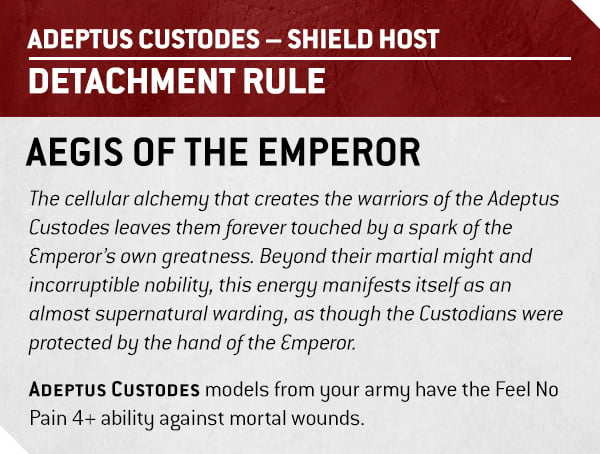
Unit Spotlight
When even the rank-and-file are nigh-immortal legends of battle, those that lead the Adeptus Custodes must be exceptional indeed – and Trajann Valoris does not disappoint. His Watcher’s Axe dices enemies big and small, and even packs a significant punch at range.
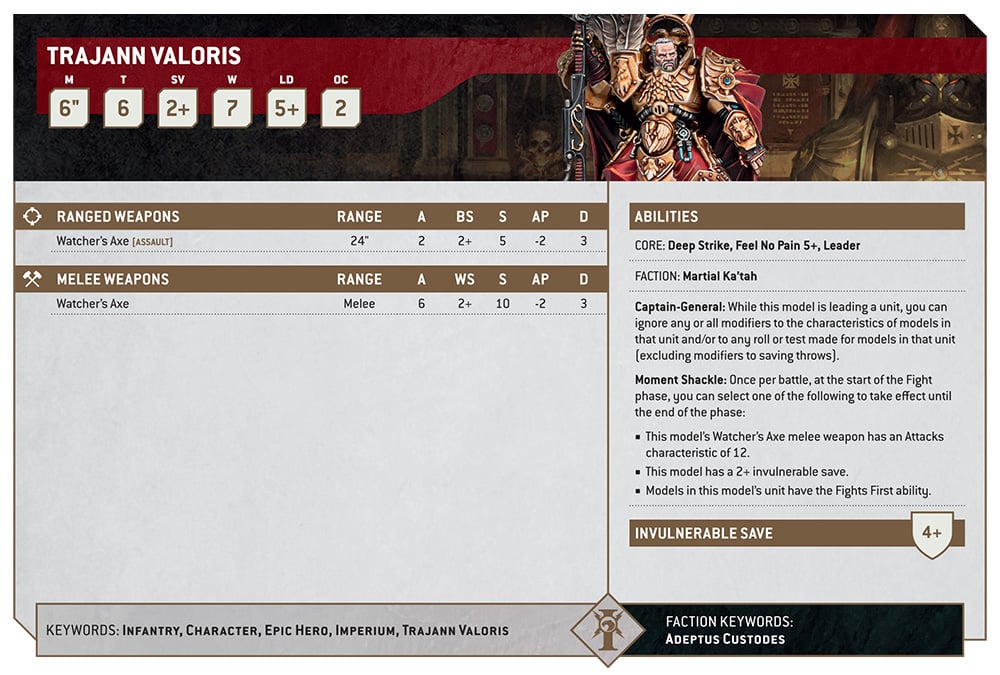
By far his most powerful tool is the Moment Shackle, a relic of the Dark Age of Technology that redirects the flow of time to his advantage. Though it can only be used once per battle, its effects are extremely powerful in both offence and defence, and can decisively swing a combat his way no matter how mighty his opponent.
Custodians are superhumanly durable even without a shirt on, and adding suits of Allarus Terminator armour makes them truly immovable. Despite the immense weight of their armour, the From Golden Light ability gives them surprising mobility in the midst of battle, and can hurl them across the field onto distant objectives at critical moments.

But of course, we can’t forget the other aspect of the Talons of the Emperor, the Sisters of Silence. Their excellence in the field of psyker-hunting – and their nature as psychic blanks – turns even the worst of blasphemous magicks and alien witchcraft aside.
Armed with consecrated boltguns, squads of Prosecutors can pick out enemy sorcerers from their minions with unerring accuracy, as the Precision ability allows them to target Leaders who’d normally be hidden within enemy squads.

Weapon Spotlight
All of the weapons carried by the Talons of the Emperor are masterworks, with powerful ranged weapons often built into the hafts of their swords and spears. Even amongst these relics, though, the Executioner Greatblades carried by Vigilators are doom incarnate for enemy psykers, and can rend through sorcerous wards as if they were nothing but air.

If you’re planning on hunting down a colossal Knight Abominant, or the new psychic monstrosities from Hive Fleet Leviathan, a cadre of Vigilators will cut them down to size.
Stratagem Spotlight
With all of their skill and experience, the loss of even one Custodian is a tragedy that few factions can comprehend. Luckily, the Emperor’s finest don’t go down easy, and even should they fall under the furious guns and blades of their foes, these golden heroes will simply rise again to continue the fight.
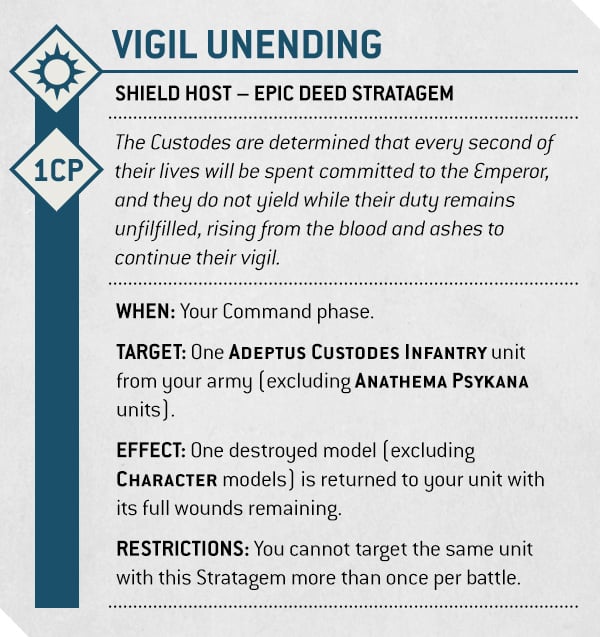
It can often take entire turns of shooting to bring down even a few of the Adeptus Custodes, so imagine the look on your opponent’s face when an Allarus Custodian simply comes back to life as if nothing ever happened.
The Word from the Studio
“Every one of the Ten Thousand is a literal hero, and our intent designing the Adeptus Custodes datasheets was to capture that feeling on the battlefield”, explains Robin from the Warhammer Design Studio. “Many Adeptus Custodes units have two abilities as a result – the second being a ‘Once per battle…’ ability that can be used to give the unit a heroic boost at a critical moment.
“This is needed, as the ultra-elite warriors of the Adeptus Custodes – even when supported by the Sisters of Silence – are likely to be vastly outnumbered by their foes. However, their Martial Ka’tah ability cements the Adeptus Custodes as one of the foremost melee armies in the new edition, as the army changes its fighting stance to defeat whatever foes they face.”
Overview
Chaos Knights are fear made manifest – walking engines of pure destruction that chill the souls of all who gaze upon them. Where their Imperial counterparts are all about courtly manners and noblesse oblige, the dread households prize nothing but sheer martial dominance, and have many ways to exploit the quaking terror that they inspire in lowly mortals.
Faction Rules
The sight of a lance of Chaos Knights striding through the fog of war elicits nothing but sheer, unbridled terror, and even the hardiest of heroes in the 41st Millennium will feel the aura of disquiet that flows from these mechanical monsters. These Harbingers of Dread spread disorder and sap the will, with the effect only getting stronger as time goes by.
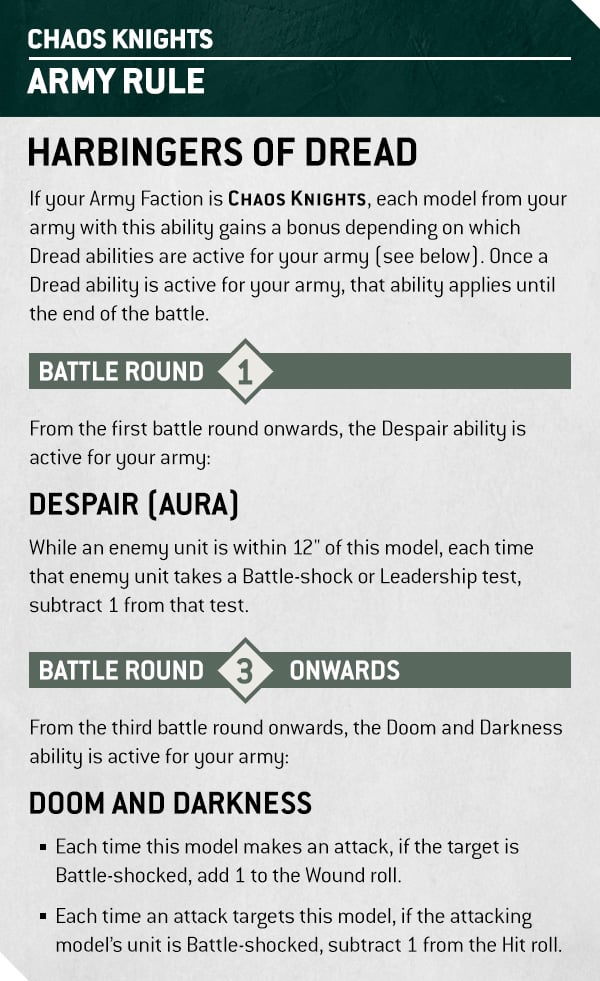
Many factions have special ways to cause Battle-shock, but Chaos Knights take further advantage with a bonus to wound Battle-shocked units, and can even avoid return fire from them.
When formed into a Traitoris Lance Detachment, they can also force Battle-shock tests on nearby units as soon as they’ve taken damage, turning a single fallen model into a cascade failure under the fists and chainswords of blasphemous war machines Forged in Terror.
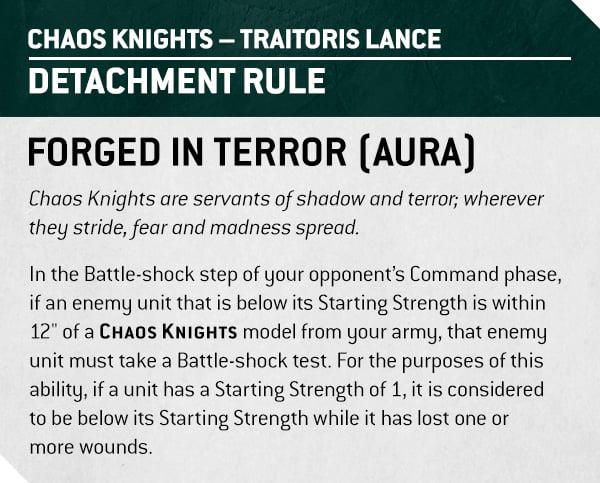
Unit Spotlight
Chaos Knights have always taken a freewheeling approach to their equipment selection, with the Knight Despoiler throwing off the shackles of rigid Imperial designations to equip whatever allows them to slaughter more chattel. The same is true in the new edition, and its Seething Hatred rule adds a touch of reliability to all weapon types.
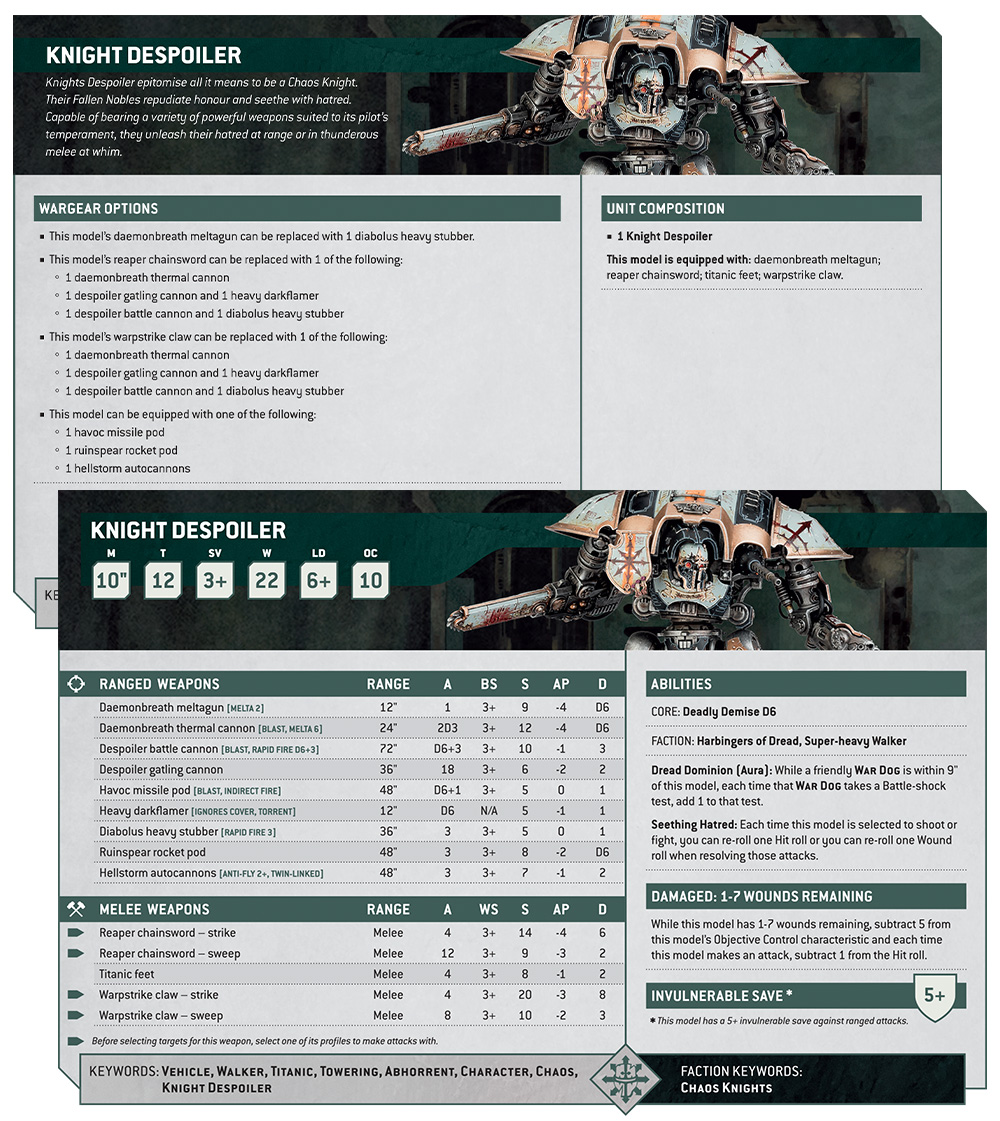
The presence of an Abhorrent-class Knight is enough to spur on the various War Dogs that cluster around them. These auras are more flexible than the targeted bonuses used by Imperial Knights – but the new Bondsman abilities benefit both the Armiger target and the Questoris Knight using them, while a Chaos Knight is unaffected by its own aura. This fundamentally changes the dynamic between lord and squire, as the larger Chaos Knights have little concern for the benefit a War Dog can give them, instead of working in careful concert.
Perhaps the most horrifying of all Knight suits piloted by Fallen Nobles is the Knight Abominant, a towering psychic monstrosity that projects a tempest of empyric terror. Its psychic Vortex Terrors can throw an enemy unit straight into Battle-shock at the start of the Shooting phase – making them vulnerable to Harbingers of Dread – and tears its prey apart both with psychic squalls and scorching volkite energy, then follows up with a barrage of close combat attacks.

Weapon Spotlight
Where Imperial Knight households show some measure of caution and only mount their strongest laser weaponry to the massive Dominus-class Knights, Chaos Knights show no such restraint. The raw vehicle-punching power of the desecrator laser destructor is enough to turn loyalists green with envy… should any of them survive a potent Strength 18 beam of death.
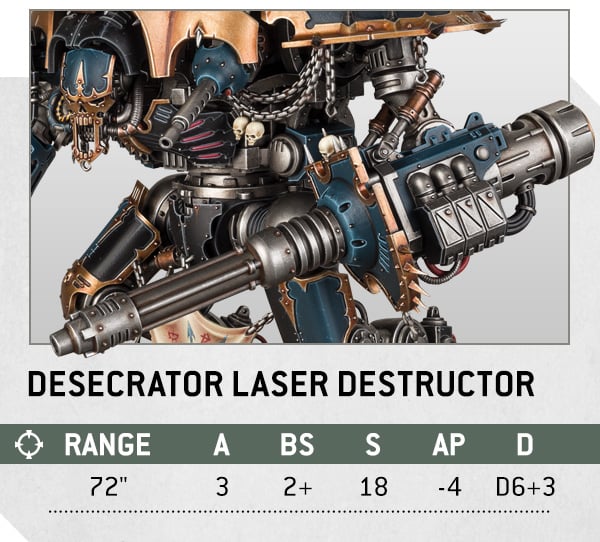
Like many Knights , the Desecrator can also pack a warpstrike claw to maximise its damage against newly toughened vehicles. Battle tanks might now be packing a Toughness characteristic of 10 or higher, but against a Strength 20 fist with 8 damage per hit, they’ll still fold like paper.
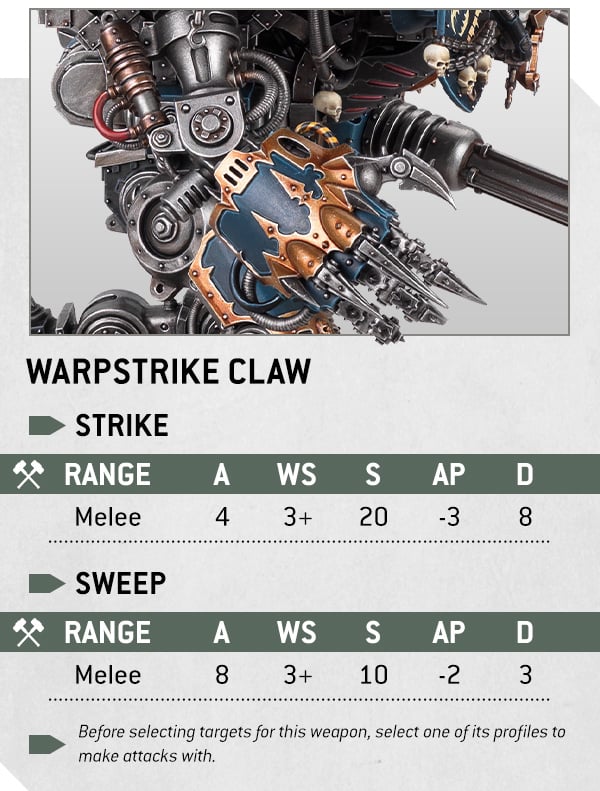
Stratagem Spotlight
War Dogs are afforded little respect in Traitoris Lances – by their bigger masters, anyway. To everyone else, they’re still piloting a stompy war machine from out of a nightmare. These scout-grade Knights nip around the heels of their larger compatriots and hunt for scraps amidst the carnage. Like their namesakes, these Dread Hounds roam the battlefield in packs and gang up on their enemies to drag down larger prey.

There’s no limit on the number or variety of War Dogs who can focus on a single target, allowing you to get tremendous efficiency out of a single Command point. Just make sure not to overestimate your foe, or you’ll be left with War Dogs standing over the wreckage with nothing to do that phase.
The Word from the Studio
“Chaos Knights are terrifying foes to face – where they tread, fear and panic spread, and this is how we wanted them to play in the latest edition,” explains Robin from the Warhammer Design Studio. “Their army rule and Detachment ability work together to cause widespread panic in their foes, and many of their Detachment’s Stratagems either grant the Chaos Knights bonuses when attacking Battle-shocked foes, or impose penalties on their foes when their nerve breaks.
“This is all before you consider the datasheets themselves, which – as you might expect – are all potently destructive. The vision here was a master and their pack of savage hounds – in this case the despotic, titanic Knights who lead their War Dogs to battle.”
Overview
Working together towards a common goal is more than just a good idea in T’au society – it’s the founding pillar of their entire philosophy. Accordingly, their new army rule incentivises cooperation between squads, building a cohesive firing line that blows enemy armies apart with guided fusillades of firepower, while patiently waiting for the opportune moment to surge forwards.
Faction Rules
Markerlights have been a signature tool of T’au Empire armies since their earliest days, allowing your units to support each other by tagging and tracing priority targets. This dynamic is back in the new edition, with a new twist – it’s now an army rule that allows almost any T’au Empire unit to pair up with an ally and guide their aim, all For the Greater Good.
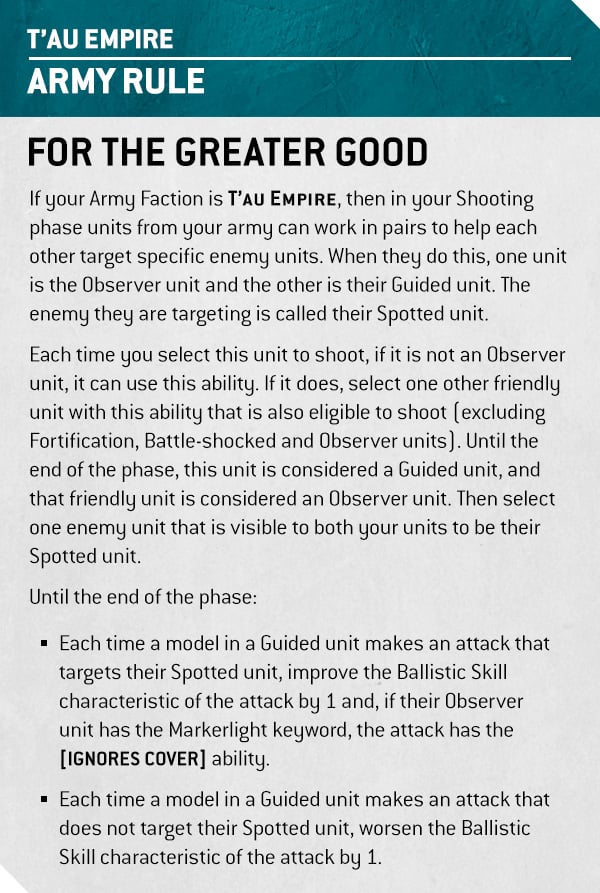
It’s an elegant system – you select an Observer unit to support a Guided unit in targeting a single enemy unit. The Guided unit gets +1 to their Ballistic Skill when shooting the target, while the Observer shoots as normal that phase. Even if the enemy knocks out your precious Markerlights, you can still keep highlighting targets for destruction – but you’ll want to bring a few along anyway, as Observers with Markerlights also help their comrades Ignore Cover when shooting.
For the first T’au Empire Detachment, we follow the way of the Patient Hunter – the favoured martial philosophy of Commander Shadowsun. Kauyon rewards cunning commanders who can keep their army safe for as long as possible, baiting the opponent into a compromising position before hammering them with a furious barrage in the latter half of the game.*
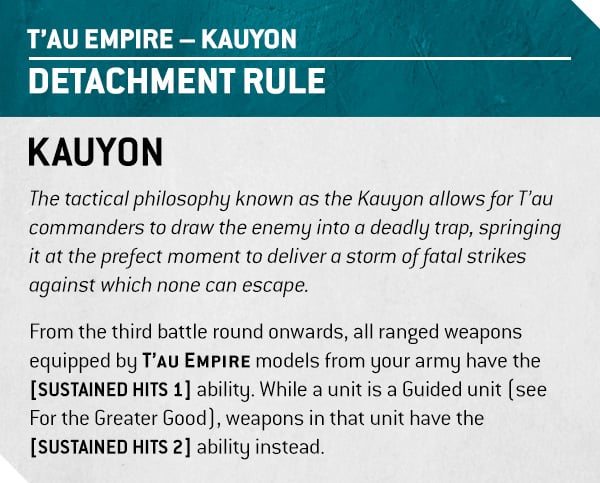
Unit Spotlight
Dedicated spotters have a new lease on life. Not only do Pathfinders all come with Markerlights to aid Guided units in blasting through cover, they can also act as an Observer twice per turn with their Target Uploaded ability.

Even a minimally-equipped squad of Pathfinders can dramatically increase the efficiency of your bigger guns with a bit of careful positioning – but if you like to pack yours with all of the fanciest toys, you’re also well-catered for.
Eagle-eyed Earth Caste engineers will notice that the special Grav-inhibitor Drones, Pulse Accelerator Drones, and Recon Drones are listed as wargear abilities, rather than models in their own right. That’s due to a new approach to Drones across the board – instead of individual models, all Drones are treated as equipment on a model’s datasheet, granting new weapons or abilities directly to their unit.
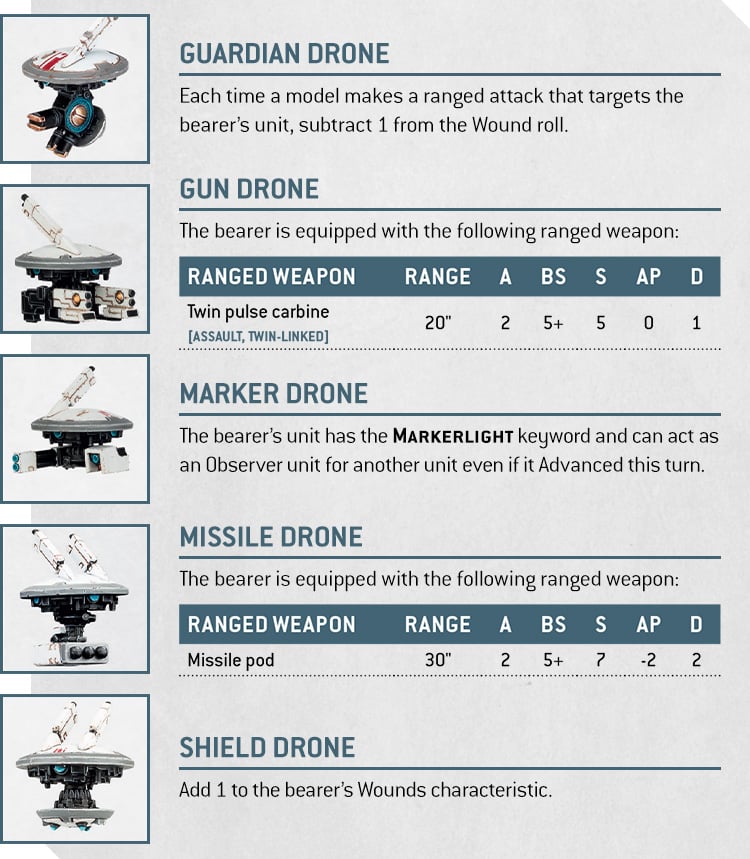
Gone are the days of trying to fit a swarm of Shield Drones behind limited cover, or stringing a line across the battlefield for some range-enhancing shenanigans. Now your Drone models are just helpful tokens, and the dutiful kor’vesa aid their masters without obstructing them.
Weapon Spotlight
We’ve talked about it already, but the Hammerhead’s railgun truly is the yardstick against which all other T’au weapons are measured. The overall lethality of the game has been brought down, but this is still a monstrous anti-tank weapon that puts the fear of the God-Emperor** into anything with tracks, tyres, or Tyrannic hooves.
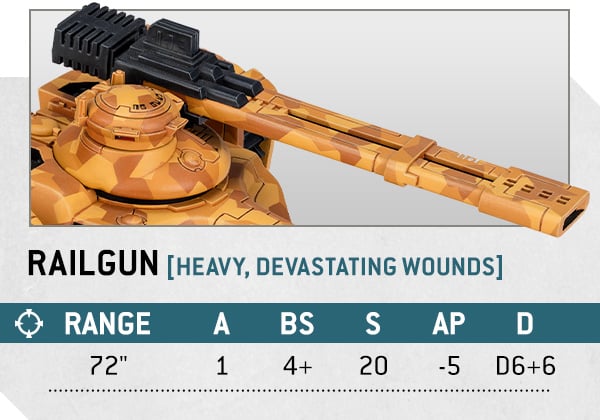
But if even that isn’t enough bang for your buck, the walking god of war that is the Stormsurge has put some extra pep in its pulse blast cannon to deal with tougher vehicles.
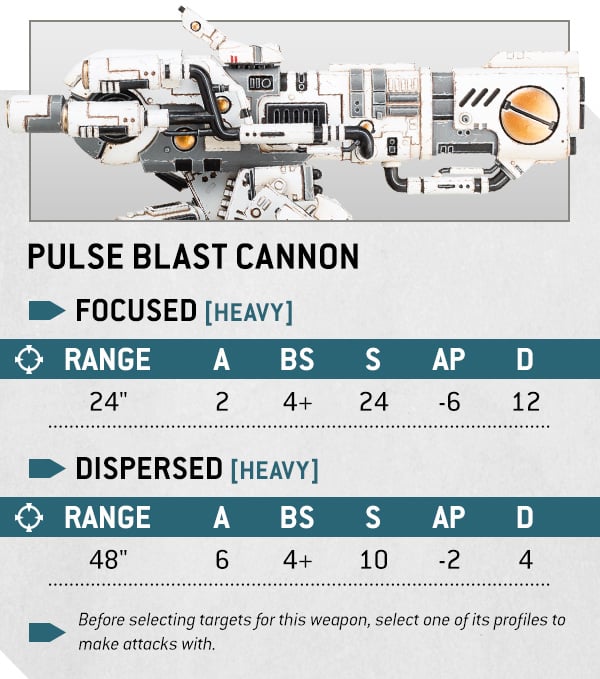
Stratagem Spotlight
Fluid movement is a hallmark of T’au military strategy, which prizes survival and initiative over holding useless ground. Infantry units are trained to retreat in the face of an overwhelming assault, and will frequently embark upon a waiting transport to escape the threat of an incoming charge.

As your average Fire Warrior is less than impressive in close combat, a hasty Combat Embarkation is an ideal way to keep them safe from harm while enemy blows bounce harmlessly off your Devilfish hulls. With this, a reckless foe can be forced to over-extend into a killing field, where they’ll be met with a wall of firepower in perfect Kauyon style.
The Word from the Studio
“The T’au believe in the Greater Good, supporting each other where warriors of less enlightened factions might compete for glory,” says David from the Warhammer Design Studio. “We reflected this in their army rule – For the Greater Good – which, when you select a unit to shoot, lets you choose another Observer unit to guide them, improving the Ballistic Skill of the attacking unit.
“This rule rewards you for setting up overlapping fields of fire, drawing your enemies into carefully prepared kill-boxes and launching perfectly timed attacks to obliterate your targets in a storm of solid shot, plasma, and many, many missiles.
“The Kauyon Detachment allows you to really lean into this aspect of T’au military doctrine, equipping you with ways to leave enemy units exposed and hit with devastating force later in the battle. Guided units become even stronger in this Detachment, gaining Sustained Hits 2 from the third battle round onwards!”
Overview
You know where you stand with the Imperial Knights – big, stompy walkers with world-shaking weapons and enough armour to cover a tank regiment. However, in contrast to their traitor cousins, Imperial Knights are all about working together, with Questoris Knights shepherding smaller Armigers to success through improved Bondsman abilities, while larger Dominus Knights grant them the protection of their wider ion shields.
The all-round increase in vehicle durability has paid dividends for Imperial Knights, who can sit on objectives all day with huge OC characteristics and fewer penalties once damaged.
Faction Rules
As well as their massive weapons, Imperial Knights are known for their unflagging duty and honour. All knights follow a stringent set of rules known as the Code Chivalric, which governs notions of fair play and bravery, even in the nightmare conflicts of the Era Indomitus.
An Oath chosen before battle is joined provides both a powerful, persistent ability and an associated Deed to complete. Success grants a sizeable bounty of all-important Command points to spend, as well as interacting with many other Imperial Knights rules and Stratagems.

The Noble Lance Detachment makes extra use of Honoured status by improving the Feel No Pain rule it imparts, rising to a fantastic 5+.
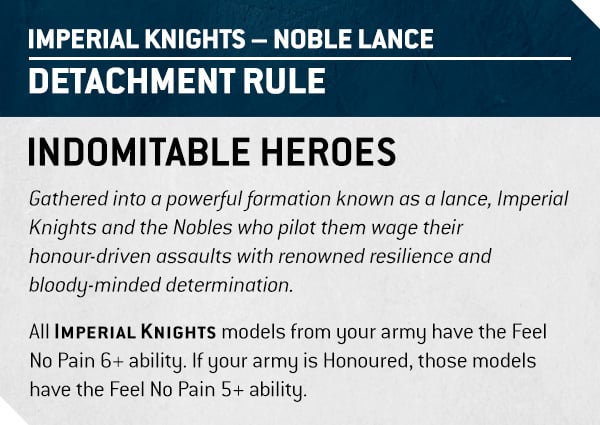
Unit Spotlight
Armigers are the closest thing Imperial Knights have to line troops, and a much-welcome upgrade to Toughness accompanies a generous Objective Control characteristic of 8, making sure they can hold ground just as well as other armies – at least, once a few foes have met their fate at the end of a reaper chain-cleaver.

The legend of the Chainbreaker continues as Canis Rex makes a sizeable fist-shaped impression in anything foolish enough to get in his way. Freedom’s Hand is a mighty everything-masher of the highest order, able to knock 45 damage into something big or delete entire squads of elite troops with a contemptuous wave.
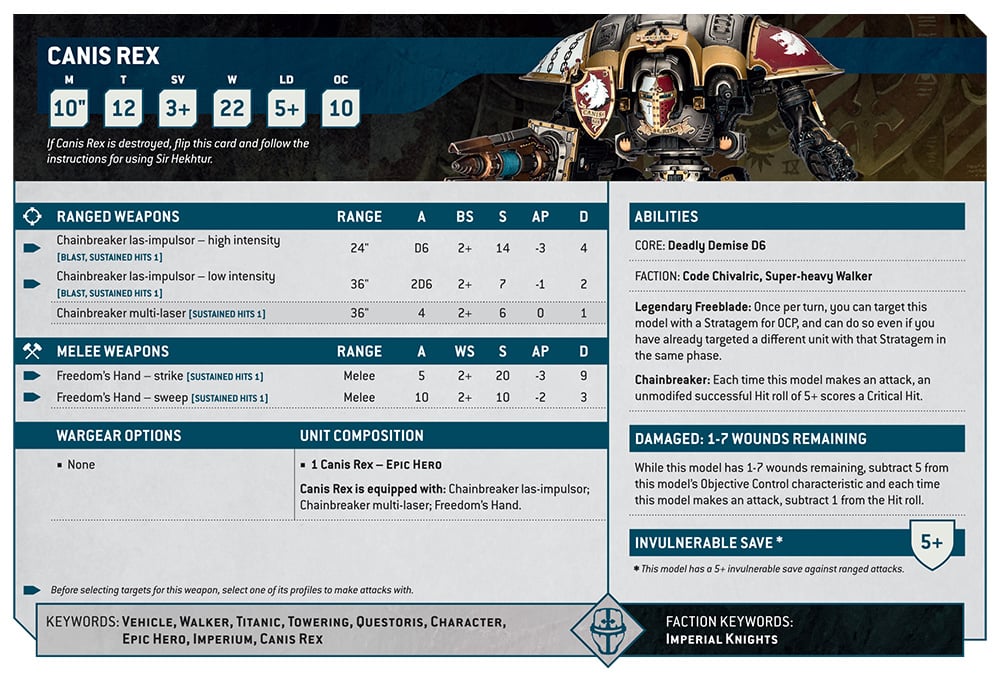
And in case you’re wondering, Sir Hekhtur can still jog around after his noble steed falls – his datasheet is on the back of the Canis Rex card.
Weapon Spotlight
In an army where even your Knights’ feet are the equal of other specialised close combat units, it can be hard to pick out a particularly eye-catching weapon. Or at least it was, before we saw what our old friend the thundercoil harpoon was up to these days.
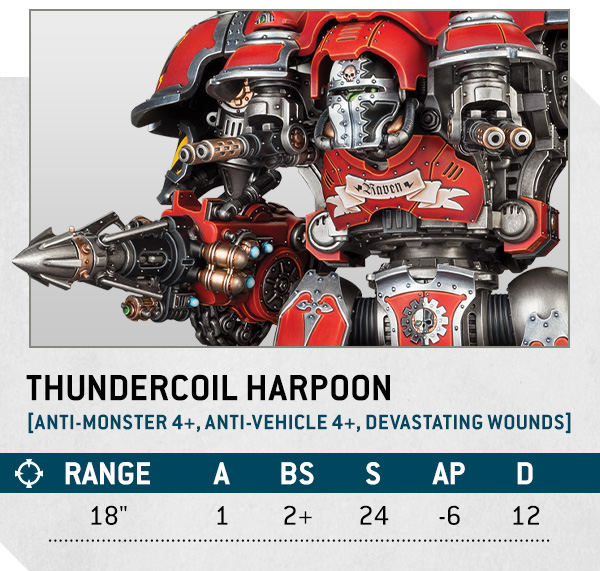
Anyone who’s piloted a Knight Valiant knows that this big spiky beast was absolutely glorious on the off-chance it got close enough to actually fire, and its track record of being a hyper-intimidating if impractical threat continues with imposing statistics. Look on my harpoon, ye Vehicles, and despair.**
On the more utilitarian end of the scale, the Knight Paladin’s rapid-fire battle cannon returns with – of all things – a fresh new Rapid Fire rule. It trades the wide variance of its old profile for a more consistent number of shots, with the new Blast rule still giving it some extra-spicy kick against larger hordes.
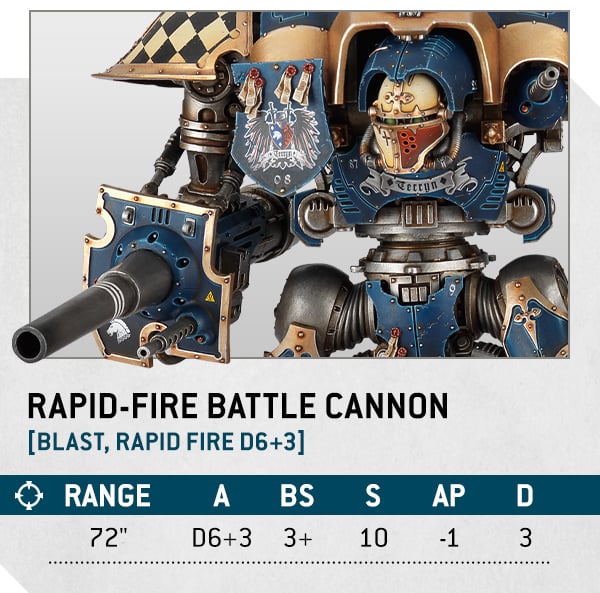
Stratagem Spotlight
The pursuit of glory can make a man do outrageous things, and pushing their iron steeds just a little bit further than is safe is par for the course for hard-pressed pilots. Knights live for the moment they can rise unbowed in their darkest hour, ready to Shoulder the Burden in pursuit of victory, and those already spurred by honourable deeds can even do so multiple times per battle.

This desire for glory is ever a gamble, however, as the need to claim noteworthy trophies can push a Knight beyond the bounds of reason. Should they succeed, their duel will be remembered for an age, but should they fail, dishonour will dog them until redemption can be won.
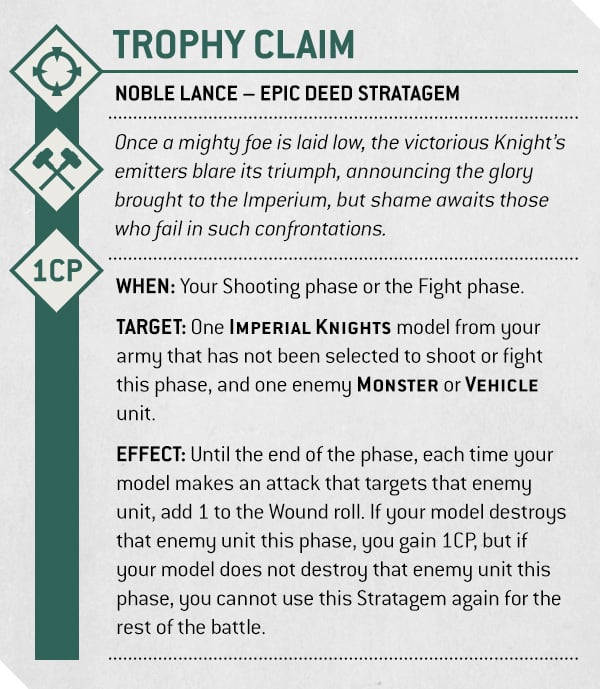
The Word from the Studio
“With the Code Chivalric army rule, we wanted to reinforce the narrative of Imperial Knights pledging themselves to honourable quests,” explains James from the Design Studio. “As well as endowing your war machines with powerful benefits throughout the battle, these Oaths also offer 3 Command points should they be accomplished. Command points are a much more precious commodity in this edition, so this is a substantial prize that could unlock all-important extra Stratagem plays at critical moments.
“On top of this, we were keen to ensure that the Imperial Knights function as a cohesive tactical force. Their hefty OC characteristics enable them to claim objectives even when outnumbered by lesser foes, and the Bondsman abilities offer a variety of interplays between your larger and smaller models, ranging from the Lethal Hits and Lance abilities dished out by the Knight Paladin to the re-rolls to Charge rolls and Hit rolls conferred by the Knight Gallant.”
Overview
Few armies are as durable as the Death Guard. This corrupted Legion has grown fat on Nurgle’s blessings, mutated and swollen flesh bursting out of armour, the pus-filled excess sloughing off when struck by the enemy. They march to battle with flies buzzing around them, never relenting as they shrug off devastating salvos that would kill mere mortals.
Alongside this acrid advance, bloated Daemon Engines rumble forward, belching gouts of explosive fire. The Death Guard’s approach is slow but inevitable, and their enemies fall choking under clouds of diseased smog.
Faction Rules
To battle a Death Guard army is to face a squall of supernatural contagions that contaminate everything they touch. These innumerable infections cause flesh and armour alike to suppurate and rot, softening up enemy defences ahead of the assault.
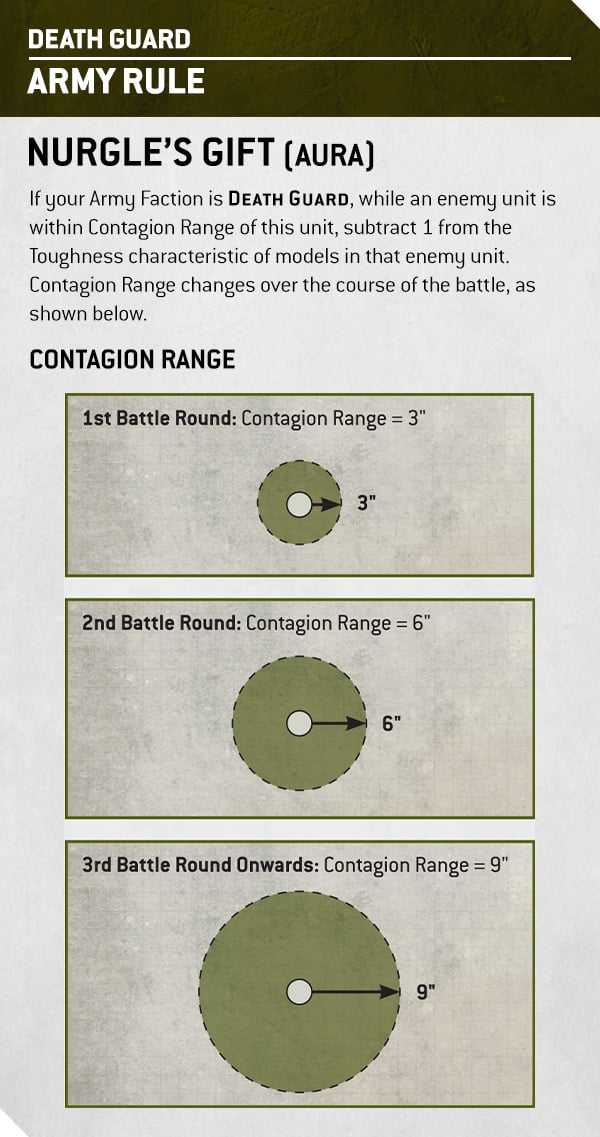
Nurgle’s Gift blesses every Death Guard unit with an aura that increases over the course of the battle. Enemy units in Contagion Range have their Toughness reduced by 1 as unnatural plagues overwhelm them – a blighted salve to the increased resilience found across the board in the new edition.
These contagions are so powerful that they even bend the landscape to Nurgle’s will, and as the Death Guard Spread the Sickness they cause Nurgle’s garden to encroach on realspace. Any objectives controlled by the Death Guard at the end of their Command phase remain in their control even if they move away, and also gain Nurgle’s Gift, meaning enemies who want to take it back will have to contend with the reality-warping pox weakening them.*

Unit Spotlight
Play Death Guard if you like big guys. The sons of Mortarion are absolute units, walking refrigerators packed with a slurry of rotting innards and mutation, held together by millennia-old ceramite, spit, and a prayer to Nurgle. With the corpse-worshippers making a song and dance about their renewed Terminators, the god of corpulence and fecundity wasn’t going to be outdone – Blightlord Terminators are now even heftier.

Toughness 6! 2+ Save! 4+ invulnerable save! What a bloated banquet of resilience – we need a lie down. These hulking brutes trade a little movement for an extra pip of Toughness, making them some of the toughest Infantry out there. Their Lethal Hits will make short work of tougher targets, while Blistering Fusillade grants re-rolls for Wound rolls of 1 against the closest target – a noxious pairing with the Toughness reduction inflicted by Nurgle’s Gift.
Another facet of Death Guard power manifests in their psychic prowess.** Malignant Plaguecasters reach out and blast the enemies of Nurgle with a Plague Wind made up of corrosive vomit and feculent gas, the resulting Pestilent Fallout causing enemies to falter as they hack up bile and blood.
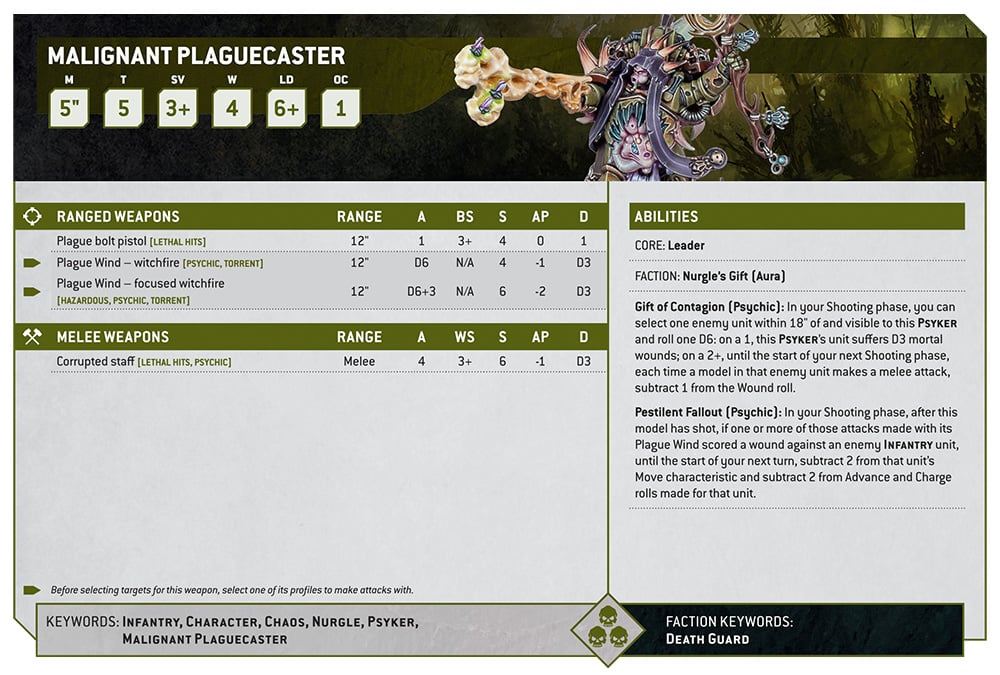
Weapon Spotlight
The Death Guard trudge into battle with grim purpose, usually flanked by Daemon Engines overripe with disease and corruption. Of these, the Plagueburst Crawlers are the most notable. Devised by Mortarion himself, these tanks are armed with a Plagueburst mortar, a long-ranged weapon expressly designed to obliterate infantry.

On top of its impressive range and attacks, these putrefying bombardments are followed by Spore-laced Shock Waves that cause enemy Infantry units to take Battle-shock tests.
Stratagem Spotlight
Defeat is all but inevitable… and the Plague Company have a few ways of speeding up the inevitable. They’ve got places to be and diseases to spread after all.

Of the many maladies Nurgle has concocted, the Sanguous Flux is one of the nastiest – units blessed by it gain Sustained Hits 1 on their melee attacks, and Sustained Hits 2 when within range of an Infected objective marker. Viciously efficient on the bubotic blades of Blightlord Terminators.
The Word from the Studio
“The Death Guard are a faction long renowned for their undying resolve to spread Nurgle’s gifts to any and all,” says Scott from the Warhammer Studio. “We’ve kept this ideal firmly in mind when designing the Death Guard, and their Army Rule, Nurgle’s Gift, reduces their opponent’s Toughness characteristic within an ever-growing range as the battle grinds on. This can often be the difference between life and death in an edition where we see some of the toughest enemies the 41st Millennium has to offer!
“Despite all of Nurgle’s grandeur, the one thing his devout followers lack is a sense of speed, but to make up for this the Plague Company Detachment rule will mean that Death Guard forces can move away from objectives safe in the knowledge that they will remain under their control unless their foes can reclaim them. Backed up with some of the toughest units in the game and the Lethal Hits weapon ability common to many of their units, these corrupted Space Marines can overcome even the hardiest of opponents.”
Overview
The Aeldari are a highly mobile army full of specialised units that can boost their already devastating powers by examining the skeins of destiny, discerning exactly where to place a surgical strike. They then nimbly retreat, their battle lines dodging reprisal like the tide retreating from the shore.
Faction Rules
With forces composed of elite Aspect Warriors, and Guardian Hosts pulled from the citizenry of their Craftworlds, Aeldari commanders scry the Strands of Fate to find the most advantageous threads of the future.

This army rule generates a pool of dice that can be substituted for your natural dice rolls each battle round. You can re-roll to fish for more fortuitous results, but each attempt to glean a better outcome reduces the pool.
The Aeldari Battle Host Detachment rule takes this mastery of fate further, letting you re-roll one Hit and Wound roll each time you shoot or fight – they’ve not suffered for millennia to fail on that vital coup-de-grâce.

This potent combination allows a canny Aeldari player to treat crucial dice rolls as mere suggestions, plucking victory from the jaws of defeat.
Unit Spotlight
When Farseers stand with their troops on the field, they can bring more acute powers to bear, enveloping whole units of the enemy in coruscating Eldritch Storms.

A Farseer’s ability to parse Branching Fates allows them to make your Fate dice go even further, changing the result of a roll to a 6, so you might want to hold onto those low rolls. Fortune allows them to bless a unit, worsening incoming Wound rolls by 1. Handy when your Guardian Defenders are sitting at Toughness 3.* And unlike their psychic peers from the other, lesser races, Aeldari do not suffer damage if their powers fail.

Even these militia are skilled warriors whose experience outstrips that of lesser races. Guardian Defender units fight with deadly shuriken catapults and heavy weapon platforms equipped with a choice of specialised armaments.
These Defenders of Fate rage against the darkness of the galaxy, generating new Fate dice for each objective they hold, providing a versatile backbone for an Aeldari army otherwise made up of far more specialised units.
Weapon Spotlight
Few weapons in the Aeldari’s eclectic arsenal are as iconic or as feared as the prism cannon. A sophisticated firing array focuses a laser through a crystal prism to amplify shots into thin beams of light that lance through tanks or saturated pulses of energy that annihilate infantry. Multiple Fire Prisms can combine Linked Fire to chain beams of light from one prism to another to ensure their prey cannot escape.**

Stratagem Spotlight
Opponents of the Aeldari find them mercurial and elusive, and plans are sure to fail as these unpredictable skirmishers feign retreats and mask their presence.
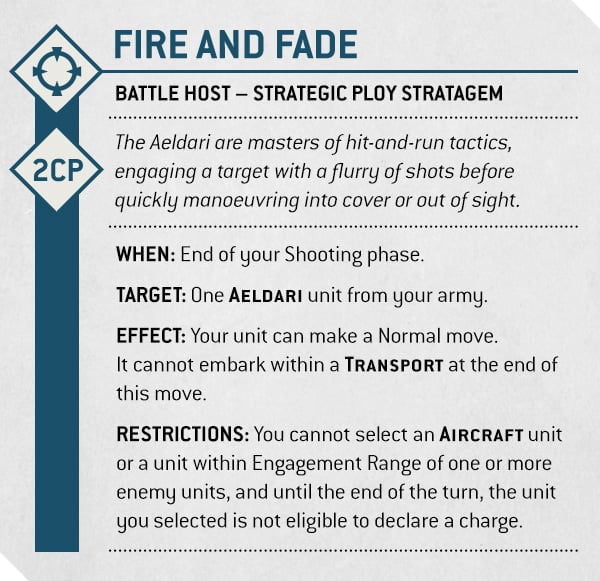
The Battle Host Detachment has mastered this deceptive style of warfare, using the well-honed Fire and Fade to unleash blistering barrages of firepower before ducking out of range.
The Word from the Studio
“The Aeldari army rule is inspired very much by their scrying of their future, and their attempts to alter the course of fate itself in order to secure victory and save their race from extinction,” says Robin from the Warhammer Design Studio.
“Rolling your Fate dice at the start of the game is reminiscent of casting the runes, and using them to manipulate the most critical moments of the battle to your advantage feels very, well, Aeldari.”
“Their Battle Host Detachment is filled with tricks – no one said they ever fought fairly. The datasheets are, as you might expect, fast, hard-hitting, and highly specialised. Every unit has a particular role to fulfil, and in the hands of a skilled player these different units can work together to take apart enemy armies, but their warriors are also rather fragile. Should the foe get to grips with the Aeldari, they do not last long…”
This bulbous biomorph is a Neurotyrant, an eldritch mass of tentacles and chitin that acts as a powerful Synapse node for the Hive Mind, the ineffable alien intelligence that commands the Tyranid swarm.
The vast, infallible judgement of the Hive Mind has seen fit to swell the mind of this creature to immense proportions, and all that grey matter makes it both a formidable psyker and a perfect node.*
Their unique cerebral structure acts as a focal point for the Shadow in the Warp, increasing the mental pressure exuded by the Hive Mind until it reaches an excruciating level, dominating their prey with Psychic Terror.
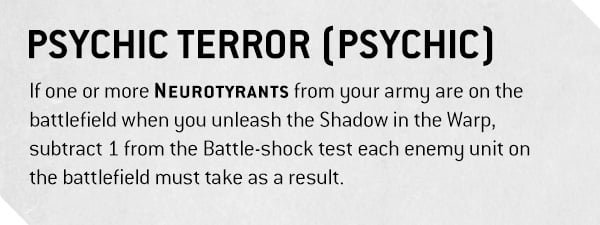
Neurotyrants act as mobile command centres, bristling with senses that observe the ebb and flow of the horde, and commanding the battle with greater efficacy.
Each Neurotyrant acts as a potent Synaptic Relay, enabling two units within 12” to act as if they are within Synapse Range until the start of your next Command phase, no matter where they end up. Your deadliest melee units can stretch their legs and hunt down troublesome enemies.**

There are a few more units from Leviathan to pick over before launch – stay tuned on Warhammer Community for more updates, and in the meantime, sign up for the new edition newsletter – there’s a Space Marine or Tyranid version, so you can choose your allegiance.
Overview
The Adeptus Mechanicus remains one of the premier shooting armies in Warhammer 40,000, with their distinctive technology giving them all sorts of tricks on the battlefield. In particular, the brilliant tactical skills of the Tech-Priests improve Battleline units in close proximity, working together as a cohesive whole – just like the great machines of Mars.
Faction Rules
Moving slowly from a carefully coordinated defence to an all-out attack is the strategy here, as cyborgs and automata are reprogrammed on the fly to respond to enemy tactics.
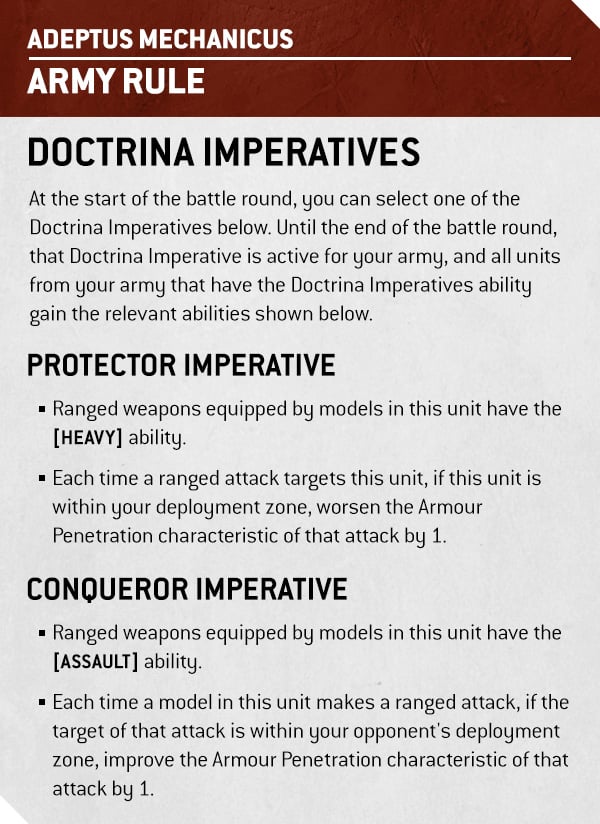
Doctrina Imperatives let you adapt to the enemy battle plan either by shoring up your defences early on, or going for a knockout blow against a foe playing too safe.
To further coax an entrenched opponent out of their comfort zone, Rad-Cohort Detachments turn their deadly radioactive weaponry against entire sectors of the battlefield. A heavy pre-battle Rad-bombardment is the perfect way to throw plans into disarray and deny backline objectives, as the fallout punishes anyone who thinks they’ll be safe holding the fort.

Unit Spotlight
Forge worlds are often saturated with radiation as a result of their industry, but instead of being seen as a deadly affliction, this invisible gift is turned into a powerful weapon against the enemies of the Omnissiah. The sheer presence of Skitarii Vanguard squads disrupts and debilitates those who get too close.
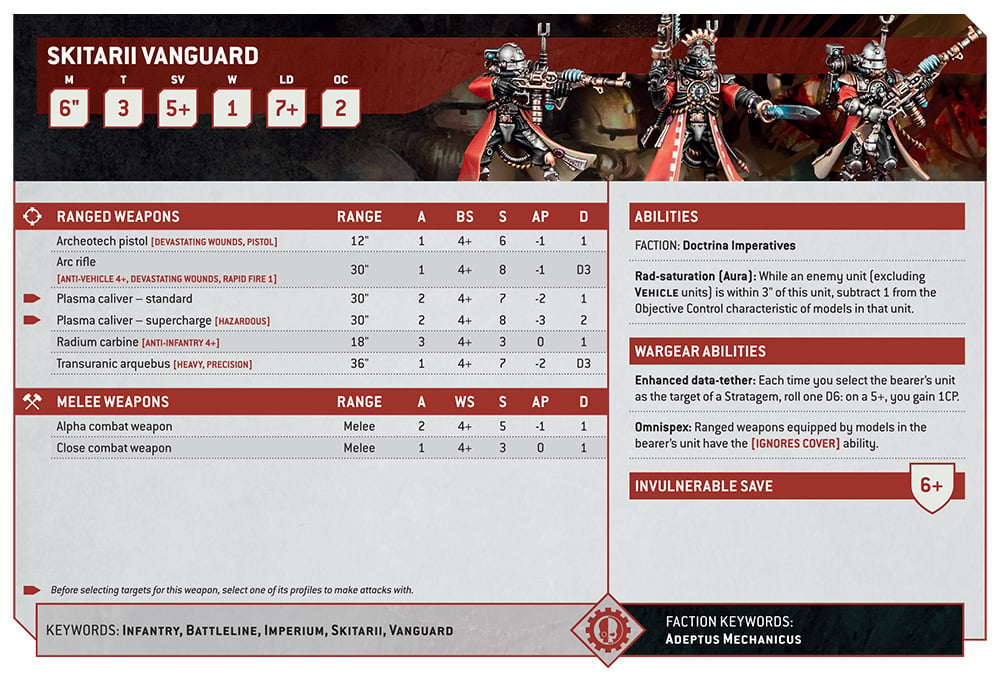
As Battleline squads, you can take twice as many Skitarii Vanguard and Rangers as other units in your army, but the benefits don’t stop there. Several other Adeptus Mechanicus units have abilities that improve when they’re near their Battleline comrades – such as Sicarian Ruststalkers, who double their bonus to movement and charge distances from Optimised Gait. This gives Adeptus Mechanicus infantry the feeling of a well-oiled machine.
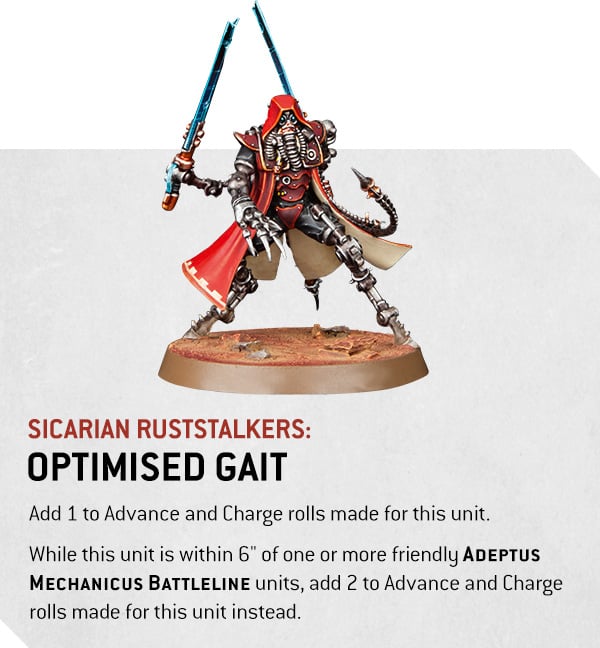
This synergy is the brainchild of the vaunted Tech-priests, and none have had quite as much impact in recent times as Belisarius Cawl. Putting aside his 10,000-year project to create the Primaris Space Marines, he’s a phenomenal battlefield commander, and can adapt to lead his phalanxes to victory.
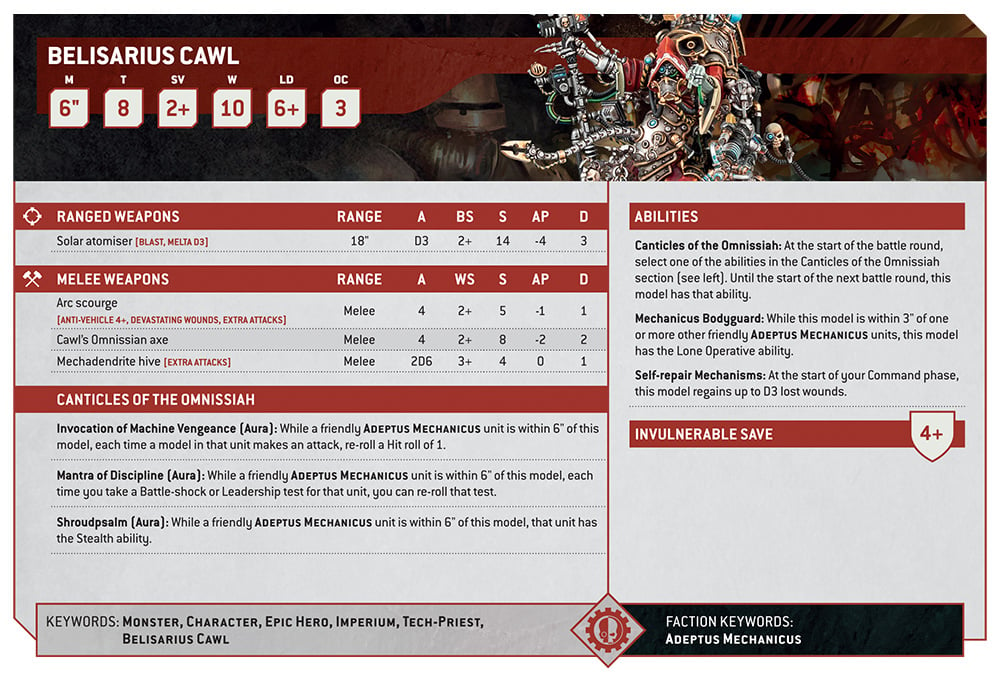
Weapon Spotlight
Many of the weapons carried into battle by the Omnissiah’s servants aren’t found anywhere else in the Imperium, as they make use of strange technologies guarded jealously by Mars. The impact these weapons can have is often mesmerising, as crackling death beams turn organics into slurry or burst them into constituent atoms with only the faint smell of ozone left behind.
One such weapon is the Eradication Beamer – a large directed energy weapon mounted on the Onager Dunecrawler. While its raw statistics are largely similar to its previous incarnation, the addition of Sustained Hits D3 piles on plenty of extra attacks when the blast hits its mark.

Stratagem Spotlight
Stratagems further reinforce these deadly technologies, amping up the power of weapons and bombarding vulnerable objectives. In particular, two Stratagems further enhance the Doctrina Imperatives army rule by granting powerful effects only usable in one mode or the other.
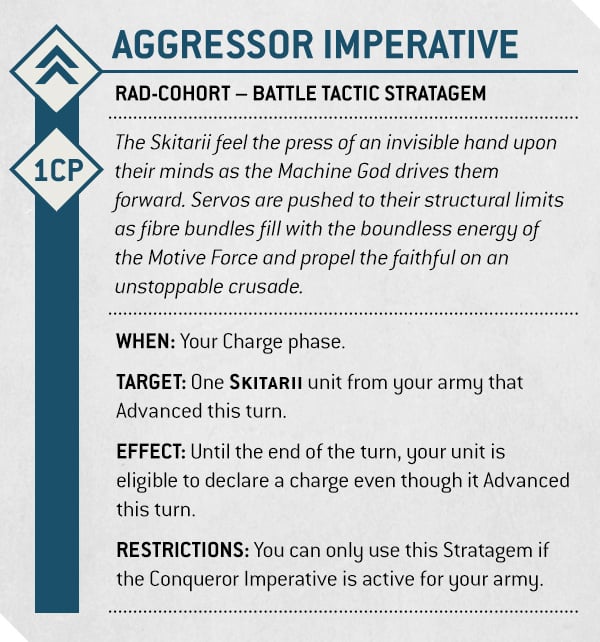
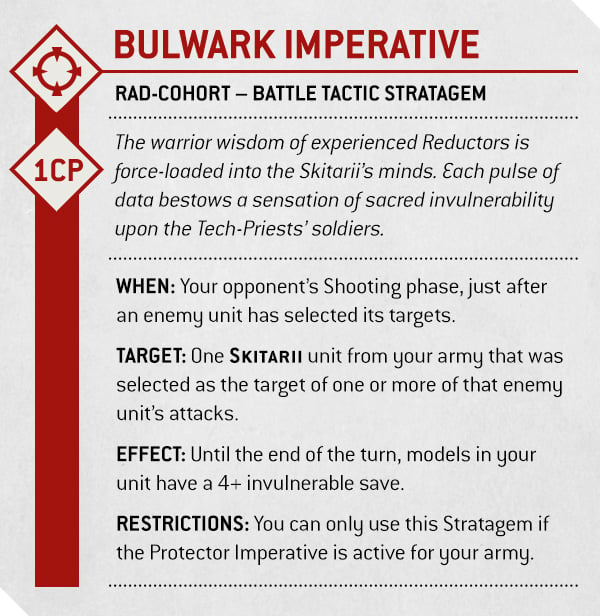
Aggressor Imperative goes all-in on a headlong assault into enemy lines, following up a barrage from your Assault weapons by charging full-speed into close combat. Likewise, Bulwark Imperative shores up a critical unit’s defences even further, turning Vanguard and Rangers into immovable objects even as they lay down fusillades of disciplined fire.
The Word from the Studio
“The Doctrina Imperatives army rule keeps the feeling of an army of cyborg warriors influenced by their Cult Mechanicus masters, but in a more simplified way than previous versions,” explains Stu from the Warhammer Design Studio. “Previous incarnations of the Adeptus Mechanicus have felt quite complex – somewhat fitting for their mad genius rulers – but less good for us mere mortals playing them on the tabletop!
“It still represents the Tech-Priest masters augmenting and adapting their warriors’ abilities, and units have been designed to work together to give a diverse, combined-arms feel to the forces of the Machine God. My particular favourites are the Kastelan Robots, as they’ve kept their slightly clunky robot ways which rely on nearby Datasmiths to reprogramme them mid-battle.”
Barbgaunts
The Hive Mind loves some living artillery, from the spore mine-firing Biovore to the mighty Exocrine. They’ve now got another beast to add to that list, the Barbgaunts and their bio-cannons – which are actually the brains of the outfit!

The Heavy ability makes them ideal for plonking down in sight of an objective to rain fire down on your enemies, while Blast makes you even more dangerous against larger units.* Any infantry that survives the initial attack will also find their advance disrupted.

Yep, those bio-cannons fire chitinous projectiles that slow your foes down.**
Neurogaunts
These little critters scuttle across the battlefield in massed swarms, each carrying a parasitic neurocyte upon their backs. Individually they may not seem up to much, but a big enough unit may be able to drag down a Space Marine or two.***
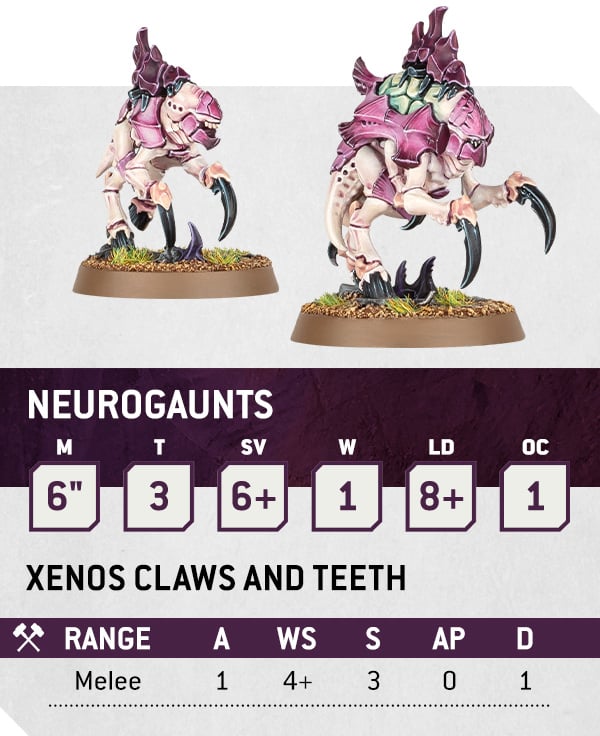
They may look like bayonet or shovel fodder, but they have a little trick up their spindly chitinous sleeves – they can increase the Synapse Range of your leader-beasts, such as the Hive Tyrant and Winged Tyranid Prime. It turns out those weird things on their backs are synaptic conduits.

Synapse is a crucial keyword in the new edition, as we explained in the recent Tyranid faction focus. It makes you much more likely to pass your Battle-shock tests, so your other bio-forms, such as the Haruspex and Termagants, can hold onto crucial objectives.****
Overview
If brutal close combat is the name of your game, the World Eaters are the only players worth looking at. Their bloodletting skills are off the charts, and now that everyone’s just a bit tougher all round, they have plenty of time to get stuck in.
That’s not to say that the sons of Angron are all brawn and no brain – Khorne’s chosen Legion are surprisingly adept at wresting control of objectives away from their opponents, and can lock down their territory even as their warriors surge off in search of more blood, skulls, and other things of this nature.
Faction Rules
Khorne, like all of the Chaos Gods, can be fickle – but the World Eaters enjoy his favour more often than most, and are infamous for their rugged ability to ride the tides of war. The fluctuating attention of the Legion’s patron is represented by the Blessings of Khorne army rule, which has you roll a pool of dice each battle round in order to channel the Blood God’s power.
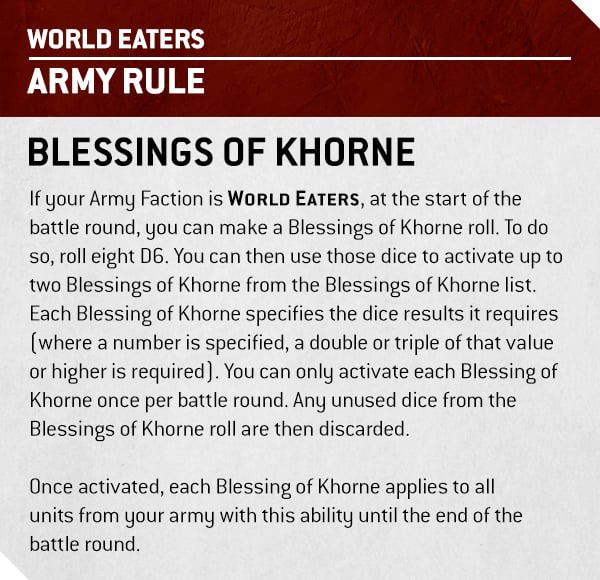
Of course it’s eight dice. So what exactly do you do with these rolls? If you guessed “spend them to upgrade your army with potent effects chosen from a list of six powerful abilities”, you’re right on the money. A furious warcry to accompany your choice is recommended, but not mandatory.
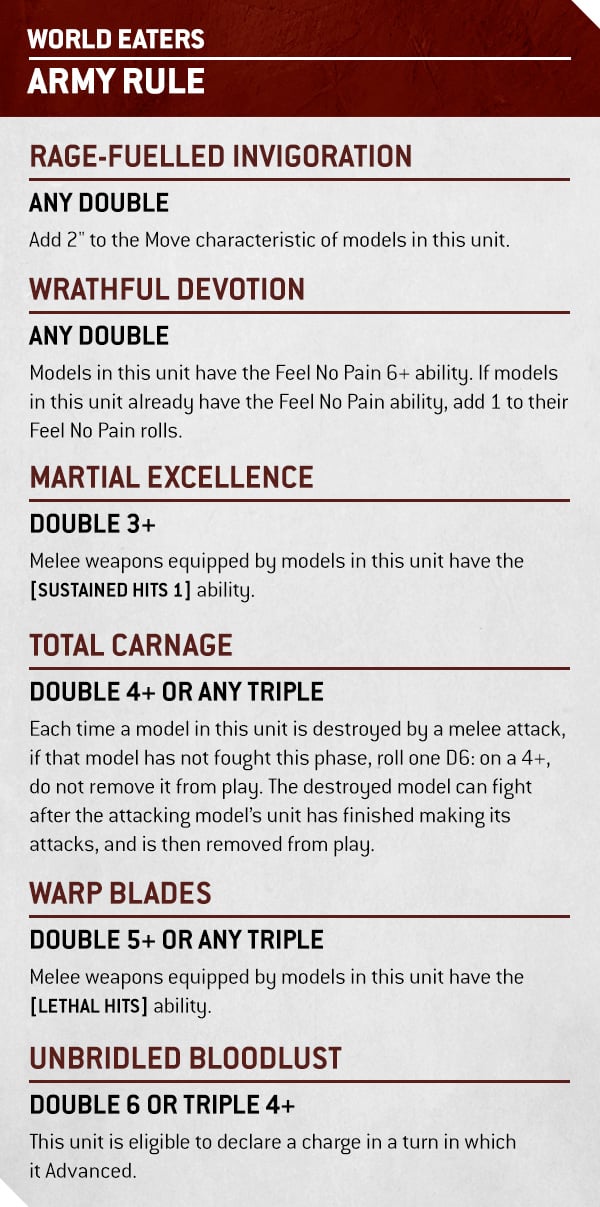
Each boon lasts only until the end of that battle round, but they affect all of the units in your army – daemonic allies not included, as they lack the ability. The range of options means you can pick up exactly what the Blood God ordered when there’s butchery to be done. You even get to pick two of them, so a particularly lucky roll can supercharge your turn with speed, durability, or raw power as needed.
Unit Spotlight
Khorne Berzerkers make up the mainstay of a World Eaters force, barrelling across the battlefield in a crimson tide with chainblades roaring a bloodthirsty orison to the Blood God’s might. They combine the armoured durability of a Space Marine with the strength and skill of true battle maniacs, and can whip up a startling Blood Surge of speed once an enemy attracts their ire.**
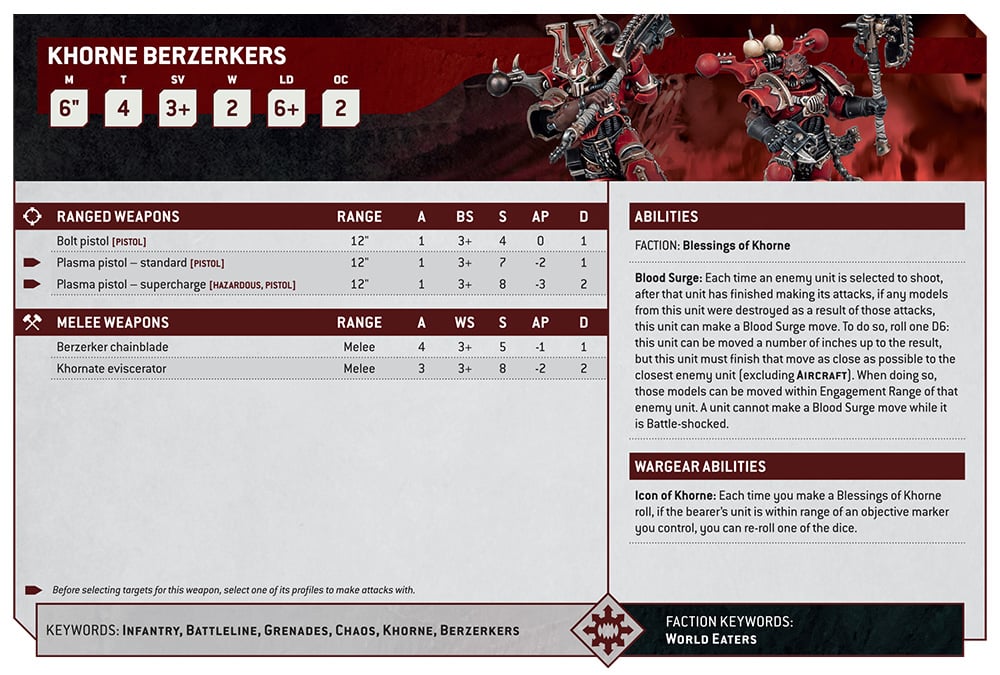
Their Objective Control characteristic of 2 and horrifying melee capabilities make Berzerkers well-suited to brawling over objectives – and once they’re in range, an Icon of Khorne will make your Blessings of Khorne rolls more reliable.
If you thought we could preview the World Eaters without showing off the Red Angel himself, though, you’d be so incredibly wrong. Angron has barely finished tearing the last edition to pieces, and he’s already back – just as you’d expect from an unbanishable daemon.

Each sweep of Samni’arius and Spinegrinder can bisect whole squads of Space Marines. Reborn in Blood returns as an ability that directly interacts with your Blessings of Khorne, so plant a few Icons of Khorne atop blood-soaked objectives to make it even more likely that a slain Daemon Primarch will come roaring back onto the field.
Canny Khornates will also notice that his Wrathful Presence now triggers in the Charge phase, allowing you to choose exactly the right Aura for the Fight phase to come. Crucially you can use these in the same turn that he Deep Strikes, immediately bolstering your nearby warriors upon his bloody manifestation.
Weapon Spotlight
Few weapons in the World Eaters armoury can be described as much more than ‘a big, sharp lump of metal’, but they don’t entirely neglect the sheer damage a good old-fashioned cannon can do. The mighty Lord of Skulls can mount several such weapons in its giant tracked body – and the daemongore cannon is getting a healthy Strength and Damage upgrade to deal with everything from tough-as-nails Terminators to super-heavy battle tanks.

Of course, even this daemon-powered artillery piece has a massive axe. These are World Eaters, after all.
Stratagem Spotlight
Being at the forefront of every bloody assault is a dangerous business, and despite their strength and resilience, the World Eaters often find themselves cut down under the furious guns of their foes. Luckily, Khorne doesn’t particularly care from whence each Blood Offering flows, and is entirely happy to corrupt a battlefield consecrated by the deaths of his own warriors.

As this Stratagem only costs a single Command point, you might want to keep a spare in your back pocket for those times your opponent levels their mightiest guns at a critical objective. Imagine the look on your opponent’s face when not even killing the last few Berzerkers sat on an objective can keep you from scoring.
The Word from the Studio
“The World Eaters are brutality made manifest – a blunt object of intense trauma that rides an overwhelming wave of hyperviolence and bloodshed,” says Rich from the Warhammer Design Studio. “When designing the rules for the World Eaters, it was clear that they shouldn’t have to rely on tricks, shenanigans, or any kind of overly complex interaction to get their point across. They are not subtle or cowardly – and neither are their rules.
“With high Strength, Attacks, and AP values across the board, every unit hits like a truck with no brakes going downhill. Their Army Rule – Blessings of Khorne – allows them to adapt on the move in order to provide just the right type of senseless violence at just the right time, and additionally perform signature moments such as the potential gore-fuelled resurrection of their unstoppable Daemon Primarch Angron.”
The Leagues of Votann are all about exacting revenge for transgressions against the Kin. Hitting them is almost as bad as hitting yourself, for they have many ways to make you regret harming their comrades. Even once you commit to a fight, their natural durability means you’ll need to spend far more firepower than you’d like making sure none of these ornery warriors remain.
Faction Rules
Kin make war in a careful, deliberate manner. Kâhls and their subordinate Theyns select targets according to a rapid battlefield analysis of their strength, calculating the value of their defeat against the cost of engagement – a process known as ‘casting the Eye of the Ancestors’. Once a suitable foe is chosen, the Leagues of Votann can unleash hell safe in the knowledge that their efforts are well spent.
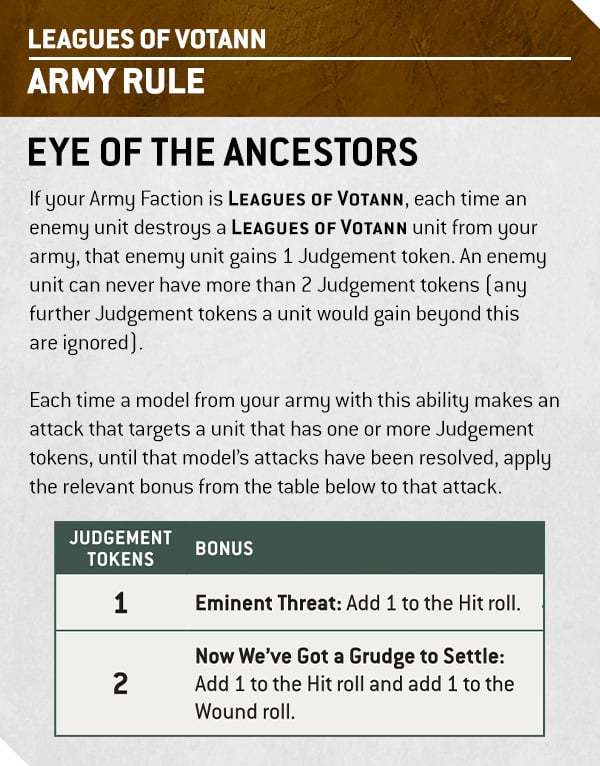
The accumulation of Judgement tokens spells doom for the units that collect them, as blistering autocannon fire and glowing plasma axes alike get more accurate and deadly against those who have wronged you.
The Oathband Detachment takes spite to new levels, allowing you to single out a particular foe for retribution. Their Ruthless Efficiency rewards singular focus with an immense tactical advantage – picking up three free Command points right at the beginning of a battle can shape entire games.

With the bonuses to Hit and Wound rolls from the Eye of the Ancestors, there’s little a marked target can do but cling to life in the hope that their certain demise won’t hasten that of their allies.
Unit Spotlight
Oathbands are built around a corps of dependable Hearthkyn Warriors – rough and ready fighters clad in thick, void-sealed armour to bolster their natural hardiness.
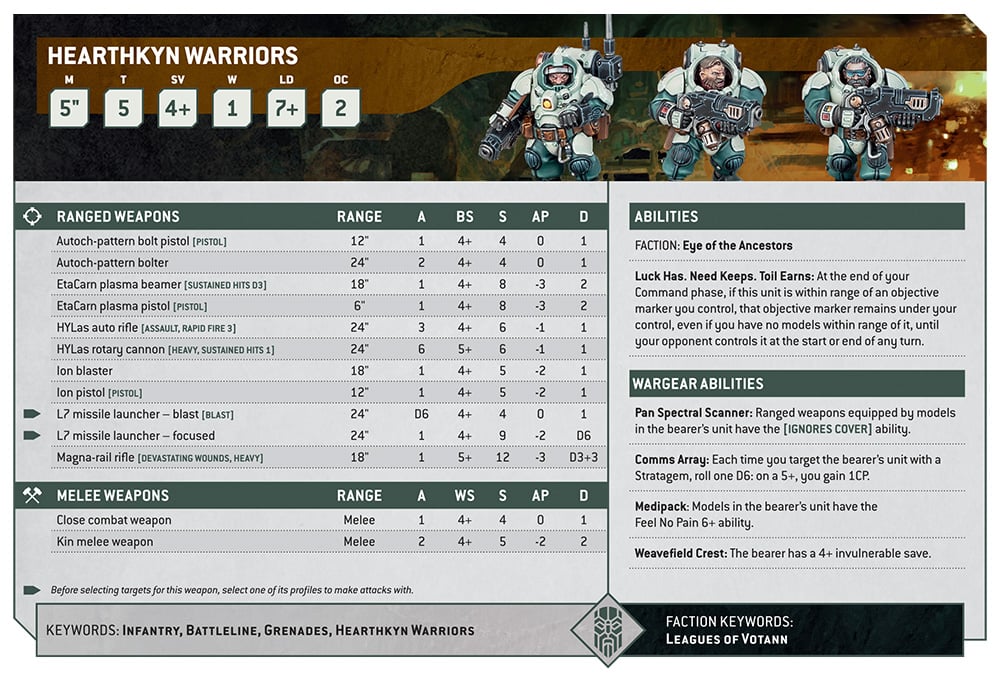
Hearthkyn Warriors boast loads of options, allowing tailored teams to tackle particularly irksome targets. Eagle-eyed Kâhls may notice the addition of the HYLas rotary cannon as a weapon option – straight from the parts-packed sprue of specialist equipment from Kill Team: Gallowfall.
If they want to ride in real style, however, there’s only one machine that fits the bill. The enormous Hekaton Land Fortress is a big, beautiful brick of a vehicle that ferries whole squads of Hearthkyn and Hearthguard into battle while shrugging off gunfire and dishing out beatings all at once.
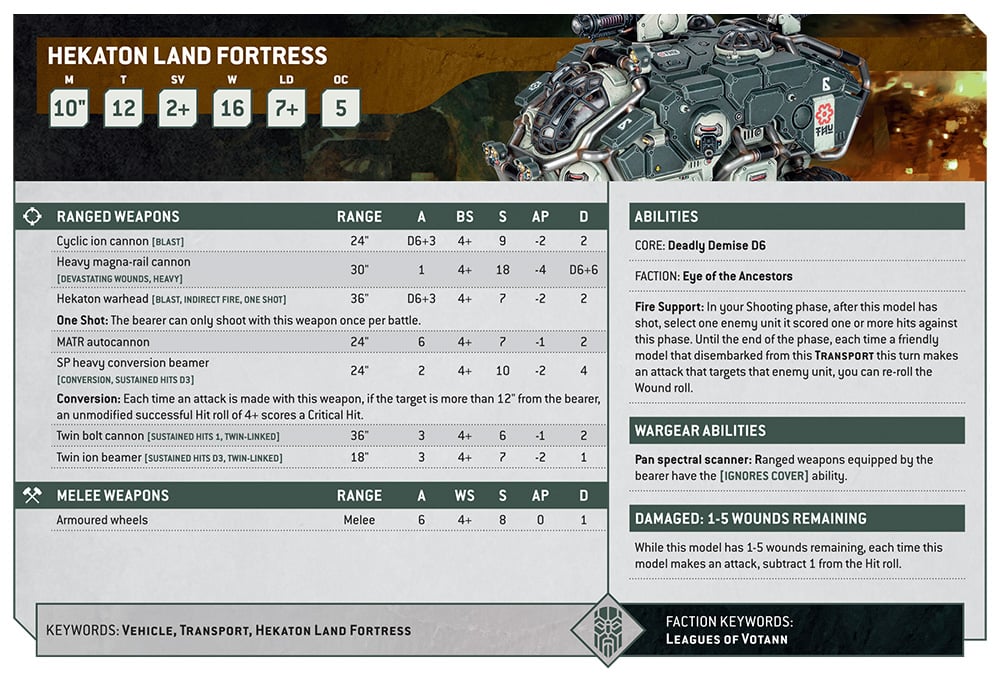
The Land Fortress is as tough as a Land Raider and packs a fearsome range of armaments. It’s right at home supporting the troops that bundle out of its hold, and can ruck it up with dedicated tanks from other factions thanks to the impressive power of the heavy magna-rail cannon.
Weapon Spotlight
Though they possess many advanced technologies, the Leagues of Votann prize reliability over raw power, and don’t carry anything with quite the excess of the Astra Militarum’s volcano cannon. What they do have, though, are their esoteric conversion beam weapons, whose new Conversion ability multiplies their hits several times over once the beam has enough distance to focus.
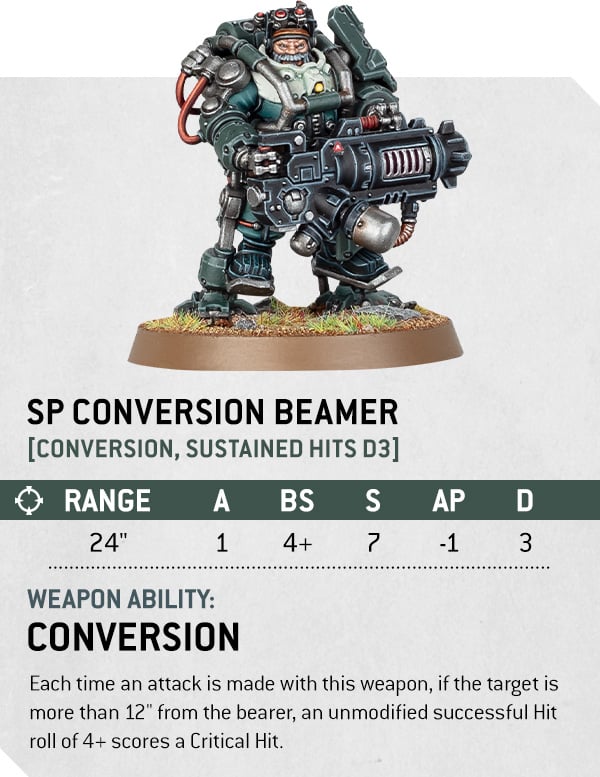
Stratagem Spotlight
Judgement tokens aren’t just for improving Hit and Wound rolls – they also interact with Oathband Stratagems to punish transgressors even further. Seeing someone shoot at your allies is bad enough, but when the offending enemy shoots at you… well, the Kin don’t take that very well at all, and a Reactive Reprisal is in order.
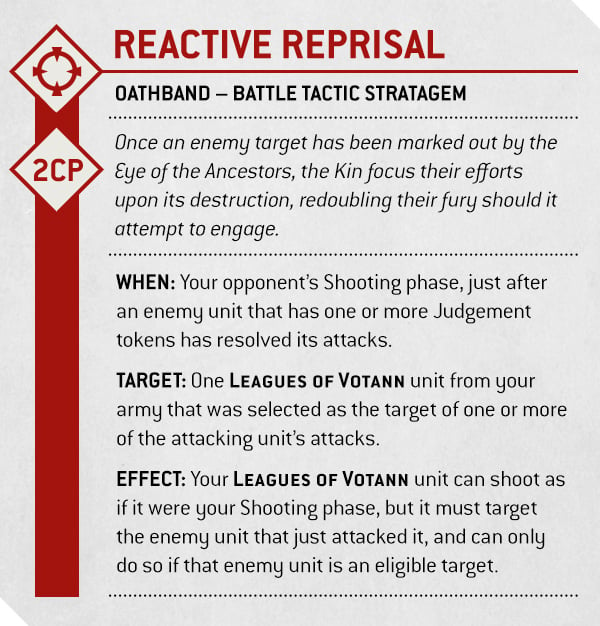
Getting extra turns of shooting is like gold dust to armies with such major firepower potential, and their impressive durability should leave plenty of models alive to send back their own personal thank-you.
The Word from the Studio
“The Leagues of Votann rules focus on armies of hardy warriors who defeat their foes through a combination of teamwork, target prioritisation and ruthless efficiency,” explains Robin from the Warhammer Design Studio. “The profiles on their datasheets have been overhauled, enabling us to better represent the resilience of their warriors and the superior craftsmanship of their weaponry.
“Their Eye of the Ancestors Army Rule has been simplified, but its essence remains the same – as your opponent’s units inflict casualties on your army they accrue Judgement tokens, and the more they have the more efficiently your forces can eliminate them in turn. In practice this means that even your rank and file warriors can pose a threat to your opponent’s elite forces.”
How do you fight the feeding frenzy of the encroaching Tyranids? With fire and faith! Thanks to their ironclad belief in the great and gracious God-Emperor, the devout warriors of the Adepta Sororitas perform literal miracles on the battlefield. The Battle Sisters are clad in the finest armour and bear the holy trinity of weapons – the bolter, the flamer, and the meltagun. As the God-Emperor guides their aim, their battle hymns reach a crescendo.
Leading an army of hardened zealots and crazed penitents, the Adepta Sororitas bring the God-Emperor’s light to the galaxy’s darkest corners. Using their faith as a shield, they drive back the alien, the traitor, the witch, and anything else that may stand in their way.*
Overview
The Orders Militant have many weapons for spreading faith throughout the galaxy, from the humble Battle Sisters squad to the mighty Paragon Warsuits. Unleash the young recruits of the Novitiates, the heavily-armoured sinners of the Mortifiers, or the tougher-than-ever-before Castigator.
Faction Rules
The benediction of the God-Emperor shines down upon those warriors that fight in His name. On the tabletop, His power is revealed in miraculous deeds of fortitude and divine strength, known as Acts of Faith. Each unit can perform one Act per phase – but first, your army will have to earn Miracle dice.
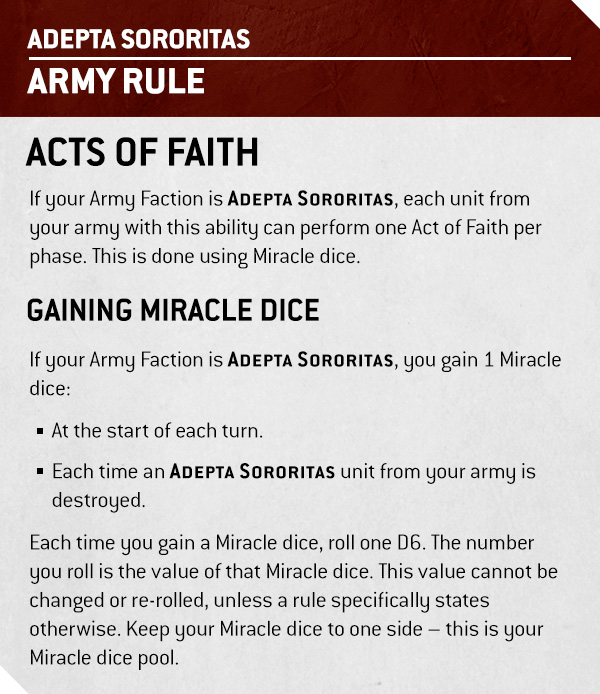
Once you’ve rolled your Miracle dice and built up a nice pool, it’s time to perform some Acts of Faith.
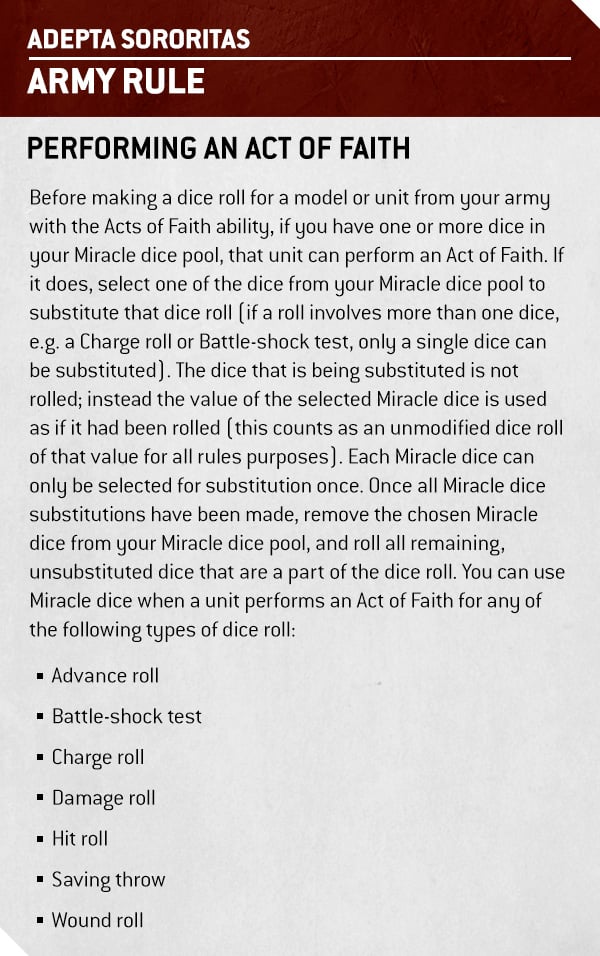
With the right Miracle dice in reserve, even the most unlikely roll can become a surefire thing. Is it really an Act of Faith if, by definition, you know exactly what the result will be? The Sororitas certainly think so, and they have very big guns, so that’s good enough for us.
All your warriors are happy to die for the Emperor – and if not, some psycho-stimulants and invasive conditioning will surely change their minds – but those of the Hallowed Martyrs Detachment are particularly overjoyed to join the Golden Throne. As each squad takes casualties, The Blood of Martyrs sends them into a fervent frenzy.

This works great for all of the units in your army, from infantry to tanks – but just imagine how hard Saint Celestine will hit once a foolish enemy takes out her two Geminae Superia.**
Unit Spotlight
It’s great having mighty leaders like Roboute Guilliman or Abaddon the Despoiler in your army, but these living relics are nothing compared to the blessed remains of a fallen Imperial Saint, carried into battle by the truly faithful. The Triumph of Saint Katherine brings a veritable museum exhibit of holy trinkets to bear upon the battlefield, each with their own effects.
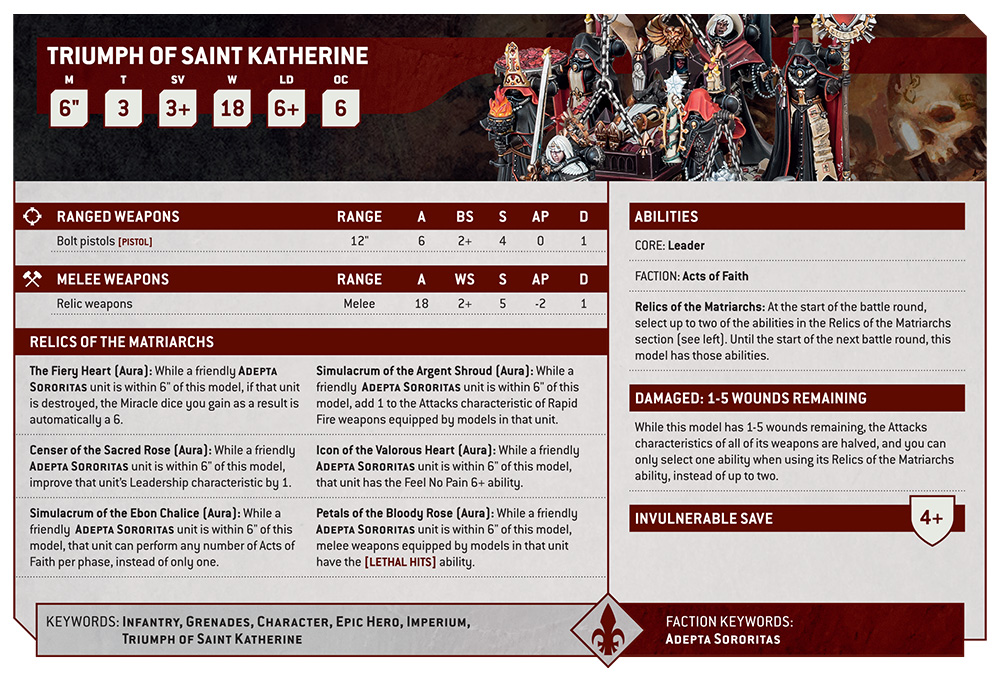
Choose Censer of the Sacred Rose to keep your Battle Sisters steady under the heaviest fire, and combine it with Icon of the Valorous Heart to help them stay alive… or The Fiery Heart to get a juicy 6 on your Miracle dice when they finally do die. Such is the path of martyrdom!
Speaking of Battle Sisters, they’re the BATTLELINE backbone of every Adepta Sororitas army, with abilities that help you make the most of Miracle dice and Acts of Faith.

Obviously you can park these Defenders of the Faith on an objective to gain a Miracle dice every round, but it gets better. Use an Act of Faith to help blast your foes off it and you’ll gain a Miracle dice from your creepy little Cherub, plus one for destroying an enemy unit with a Simulacrum Imperialis in tow.
By our reckoning, that’s three Miracle dice for the price of one. Divine efficiency in action!
Weapon Spotlight
The Adepta Sororitas are pretty well equipped with their favourite weapons*** but sometimes you need more than handheld firearms to spread the God-Emperor’s righteous word. What if you could bring deadly firepower and a church organ to battle… at the same time? Thanks to the Exorcist, you can rain down one of two different munitions, all while having a rousing sing-song in the name of the Golden Throne.
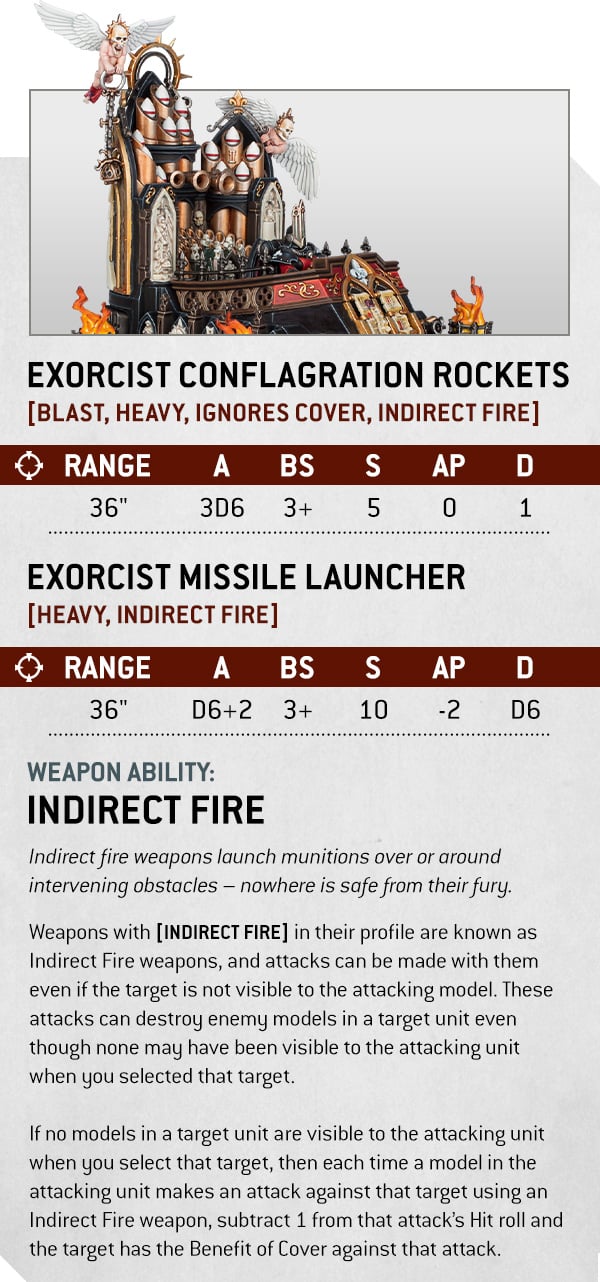
If you’re expecting swarms of alien creatures, Exorcist conflagration rockets will help thin out their numbers – or if you’re concerned by enemy armour, load up with the Exorcist missile launcher to punch through plating. Either way, your foes can’t hide from fiery judgement or off-tune karaoke – the Indirect Fire ability makes certain of that.
What if a bunch of enemy warriors try to get up close and personal with your giant keytar? Well, you can unleash the power of a High Lord of Terra with Morvenn Vahl and her lance of illumination.
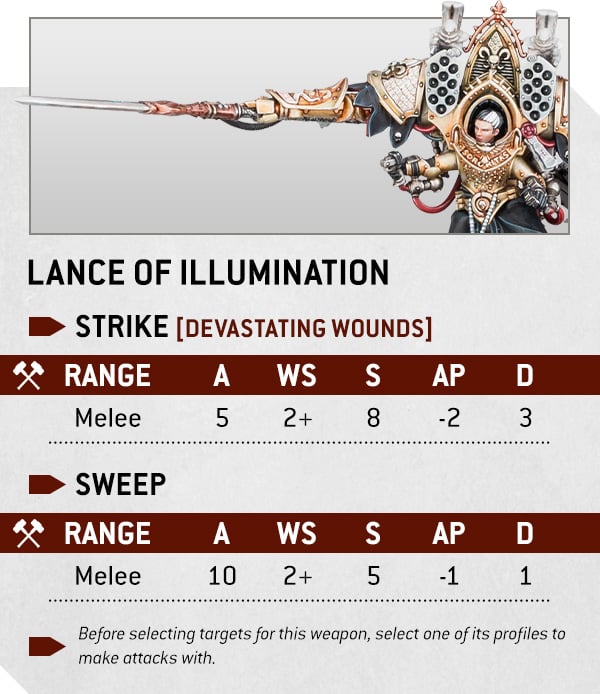
With profiles suited to taking on hordes and elites alike, it’s safe to say your foes will see the light. Very briefly. Before they die.
Stratagem Spotlight
The Adepta Sororitas are great at spreading their faith in close combat, courtesy of units such as Celestian Sacresants, but they truly excel at medium range, where they can unleash the full power of the bolter, flamer, and meltagun. The Hallowed Martyrs Detachment even offers a Stratagem that lets them fire in your opponent’s Shooting phase.
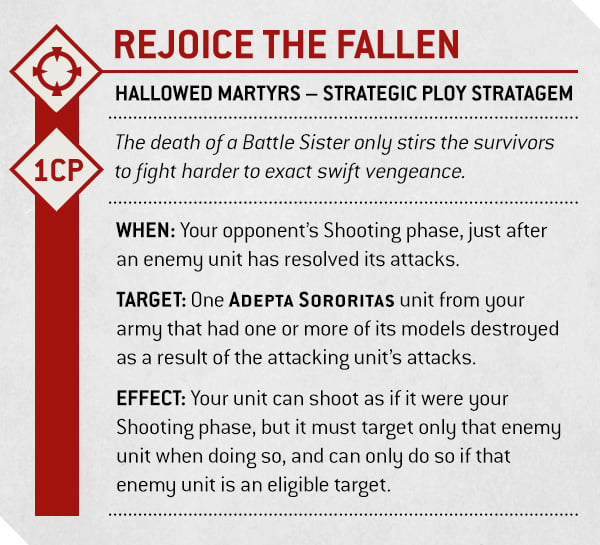
Rejoice the Fallen works great for standard Battle Sisters, but if you really want to punish your foe for their blasphemy, use it on a Retributor Squad to reply by unleashing a barrage of heavy weapons. Remember, every slain warrior brings you closer to benefiting from The Blood of Martyrs…
The Word from the Studio
“The Adepta Sororitas are holy warriors who use their wellspring of faith to perform miraculous feats on the battlefield,” explains Robin. “This is represented by Acts of Faith, a rule to manipulate dice rolls just when you need them the most, and snatch victory from the jaws of defeat.
“We wanted to capture the themes of self-sacrifice with the Hallowed Martyrs Detachment, and so as casualties rise their resolve strengthens, and the Battle Sisters become increasingly more powerful. With a plethora of heroes and supporting characters – some of whom can join units even if another character is already leading them – Adepta Sororitas players will have lots of combinations to consider when it comes to forging their army.”
Combat Patrol has been designed for a wide variety of players. It can be picked up by new and returning players, people who might struggle to find the time for a larger game, players who want to try a new faction without building a 1,000 point army, or people who simply want to master a new game format.
Instead of building an army from a selection of datasheets and points values, your games will feature balanced but varied forces based on the Combat Patrol boxes you can find in stores. You simply pick up the Combat Patrol box from your favourite faction, build your miniatures, and get ready to battle. It really is as simple as that!
The Leviathan launch box itself contains enough miniatures to assemble two full Combat Patrols – The Vardenghast Swarm, for Tyranids, and Strike Force Octavius for the Space Marines. These two armies are made up of some – but not all – of the models in the box.
The rulebook inside the Leviathan launch box (the Core Book will also be available separately) contains the organisational rules for Combat Patrol – and these will also be available to download for free here on Warhammer Community. There will be six missions designed exclusively for this game mode, which is played on a compact 44” x 30” board (that’s 2 Kill Team boards pushed together). And you can look forward to Combat Patrol sections in future Codexes!

So how does this game mode work? The Warhammer Studio have been hard at work tinkering with all the many disparate forces that are already available in order to create a fast, thrilling, and meaningfully balanced end product. This process involved lots of playtesting, with gamers of all experience levels competing with each other to test out this exciting new game mode. Rules for each of the Combat Patrols were revised based on the feedback from these games to ensure each force hit that sweet spot of thematic, accessible, and balanced.
The core principle is simple – each Combat Patrol has been given a full set of self-contained rules that define it on the table. This includes datasheets, but also secondary objectives, faction rules, Enhancements, and Stratagems, all flavoured to match that force’s narrative – and balanced against every other Combat Patrol.*
The majority of datasheets have been modified, both to adapt units that would be overpowered in this format, but also to slim down more complex units to one defining rule and ensure players can master the key abilities of their units before discovering their full potential in larger games.
To keep things balanced, the weapons options for the units have been fixed for all the Combat Patrol datasheets, so there’s no need to fret about your character and unit equipment prior to a game. You don’t need to worry about which guns to give your Chaos Space Marine Havocs, for example.
The core rules remain the same, – so nothing you learn in Combat Patrol will be redundant in Chapter Approved or Crusade games. Check out how the Captain in Terminator Armour from the index cards compares with the streamlined Captain Octavius from Combat Patrol.
- Combat Patrol uses simpler, one-side versions of the datasheet. You’ll also notice the red flash at the top of the Combat Patrol sheets – so you know you’re using the right one
Every faction’s army rules will remain largely the same – Tyranids retain Shadow in the Warp and Synapse, for example – but each Combat Patrol features Enhancements unique to this game mode to let you tweak your WARLORD and try out new strategies.
New to playing Tyranids and worried that your prized Tyranid Prime might be a little fragile? Psychostatic Veil gives the Terror of Vardenghast a 4+ invulnerable save, and makes it harder to target at range or hit in melee. After you’ve got some games under your belt, you can try turning it into a nimble buff piece with the Secretion Goad Enhancement, offering increased Armour Penetration to other units – perhaps your Termagant swarm. Glorious, venomous revenge!

The six Combat Patrol missions in the core book each have their own characteristic mission rules, deployment map, and primary objectives. You’ll find one change from the core rules here – unless they’re Battle-shocked, your BATTLELINE units can secure objective markers, allowing you to keep control of them even when your squads move on. This presents new applications for many BATTLELINE troops, and board control challenges for the elite Space Marines…
In addition to your mission’s shared primary objective, every Combat Patrol can also choose between a pair of secondary objectives that let you define how you play. Wrath of the Emperor has you send your juggernaut Captain right into the fray, spraying guts and ichor with storm bolter and power sword, scoring 2VP for each phase in which he kills any models.
However, you may find that certain armies are resistant to the hammer-blow assault of one very chunky boy. As you develop your tactical nous, you might instead prefer to employ Shock Tactics to wrench back battlefield control with your elite Adeptus Astartes, scoring 5VP every turn you knock your enemy off an objective and take it for yourself.

Even Stratagems are brought into consideration – each Combat Patrol has just three bespoke Stratagems, with one that’s designed to be reactive. These are also part of the balancing in Combat Patrol – the Vardenghast Swarm gets to top up its squishy Termagant swarms with Teeming Broods, bringing back destroyed models or even recycling a whole unit as Strategic Reserves. Maybe shooting them off the board isn’t such a good idea…
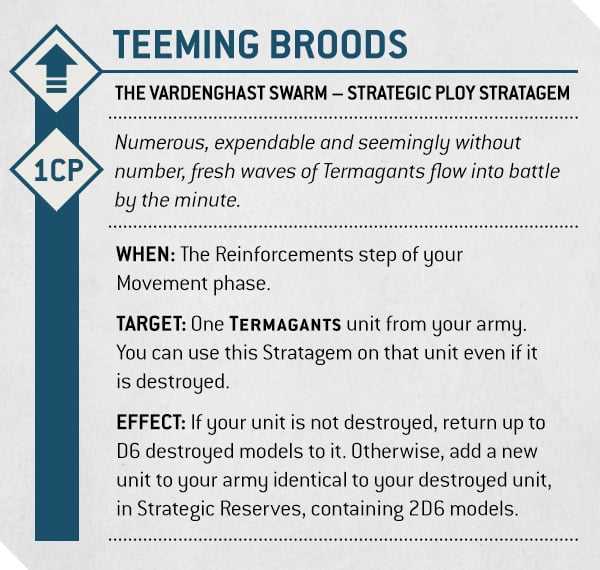
It won’t have escaped your attention that certain Combat Patrols contain big, tough MONSTERS and formidable VEHICLES, while others are somewhat lacking in the heavy weapons you’d normally use to take such targets down. Stratagems like Veteran Instincts will even the score, by granting your Terminators the ability to re-roll Wound rolls when swinging their power fists against giant-sized targets.

These rules, shaped by in-depth testing that saw old veterans and brand new Warhammer 40,000 players test their mettle against each other over many, many games, result in a mode of play that’s simple at first glance, yet full of depth.
With fewer units on the board and fewer abilities to consider, Combat Patrol is more about working out what to move and when, holding your prize haymaker back until just the right moment, and learning the intricacies of your force’s options.
Some would-be warlords borrow the powers of the warp for their own ends, but true greatness is reserved for those who belong wholly to the empyrean squall. The Chaos Daemons that inhabit the hellish realms of the immaterium are a force unlike any mortal army, rending the very fabric of reality as they assail the galaxy in a wanton carnival of corruption and slaughter.
Overview
Chaos Daemons are an aggressive faction who really come into their own in the maelstrom of close combat – though they’re by no means helpless at range. Every one of their units sports an invulnerable save – meaning they have little to fear from the enemy’s armour-busting weapons – and an army-wide Deep Strike means they can surge from warp portals to engage their prey before a shot has even been fired.
Faction Rules
The very presence of a daemonic legion is enough to tear reality at the seams, casting a dread pall across the battlefield. The Shadow of Chaos invigorates Chaos Daemons and enfeebles their foes, advancing ever further as these Neverborn nightmares capture more objectives and infuse the battlefield itself with otherworldly madness.
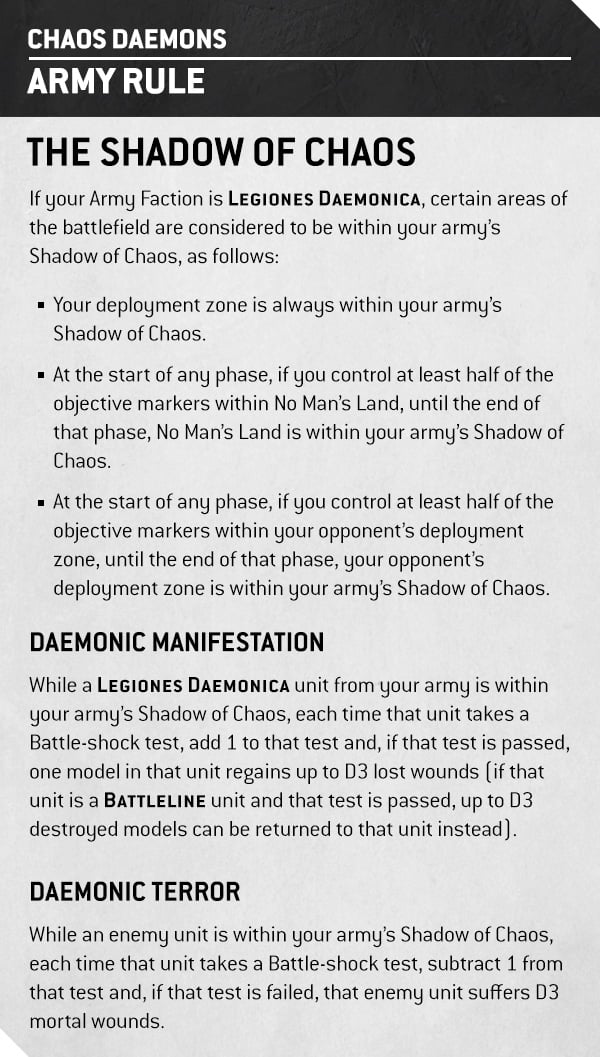
A canny Chaos Daemons player who leaps on key objectives can turn whole swathes of the battlefield into dangerous no-go zones for their opponent, whether that’s No Man’s Land – the space between deployment zones – or their own territory.
As if it weren’t bad enough for mortals to have their resolve sapped and their foes empowered, daemons who use the Daemonic Incursion Detachment can open their Warp Rifts even closer to the enemy than usual.

It’s common for daemons to be conjured forth by mortal followers of the Dark Gods, especially when a warband of Chaos Space Marines pledges allegiance to a particular patron. The Daemonic Pact rule allows a certain number of daemons to join CHAOS armies based on the size of the battle being fought – though they won’t bring The Shadow of Chaos with them, as your Army Faction isn’t CHAOS DAEMONS.
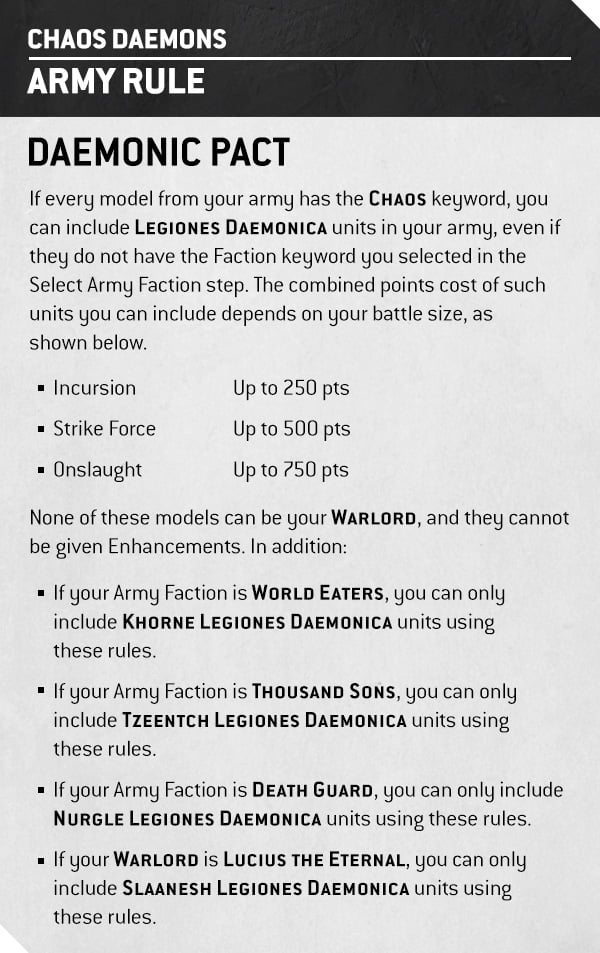
Unit Spotlight
Baying hordes of lesser warpspawn are commanded by Greater Daemons, giant monstrosities who ripple with the essence of a particular Ruinous Power. Each is a profane reflection of their progenitor’s proclivities – the Keeper of Secrets, for instance, wheels and whirls with Slaanesh’s grace, weaving through enemy attacks and striking with quicksilver speed.
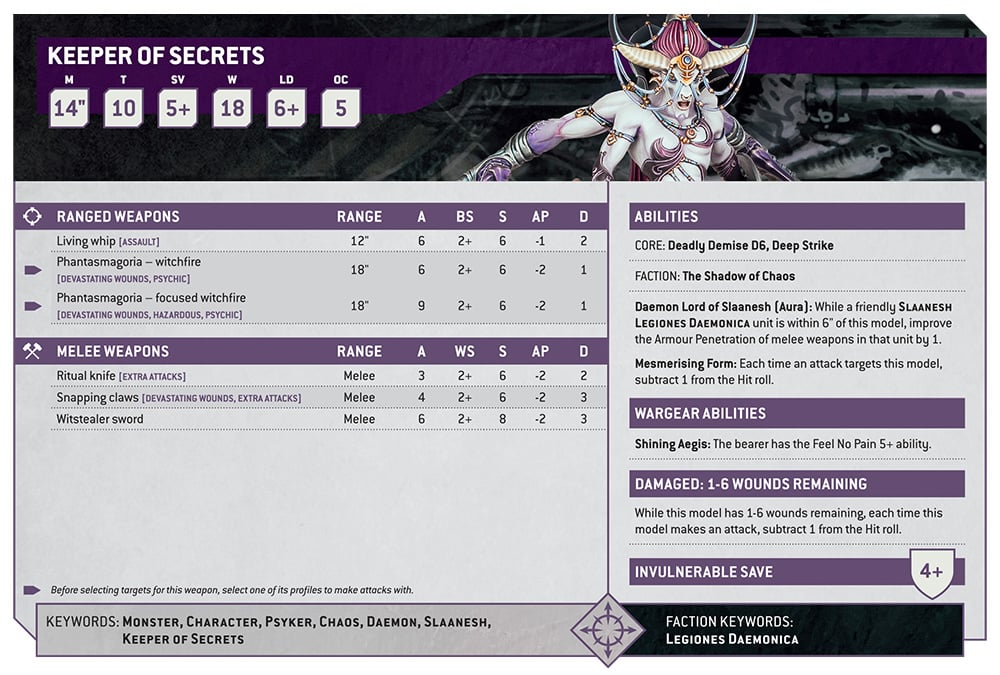
Daemons are creatures of primeval instinct, a bundle of mad impulses wrapped in a facsimile of matter – but those who once were mortal may retain an identity and ambitions of their own. Among these powerful figures, one name stands out above all others as a schemer and manipulator par excellence – Be’lakor, the Dark Master, first of the Daemon Princes.
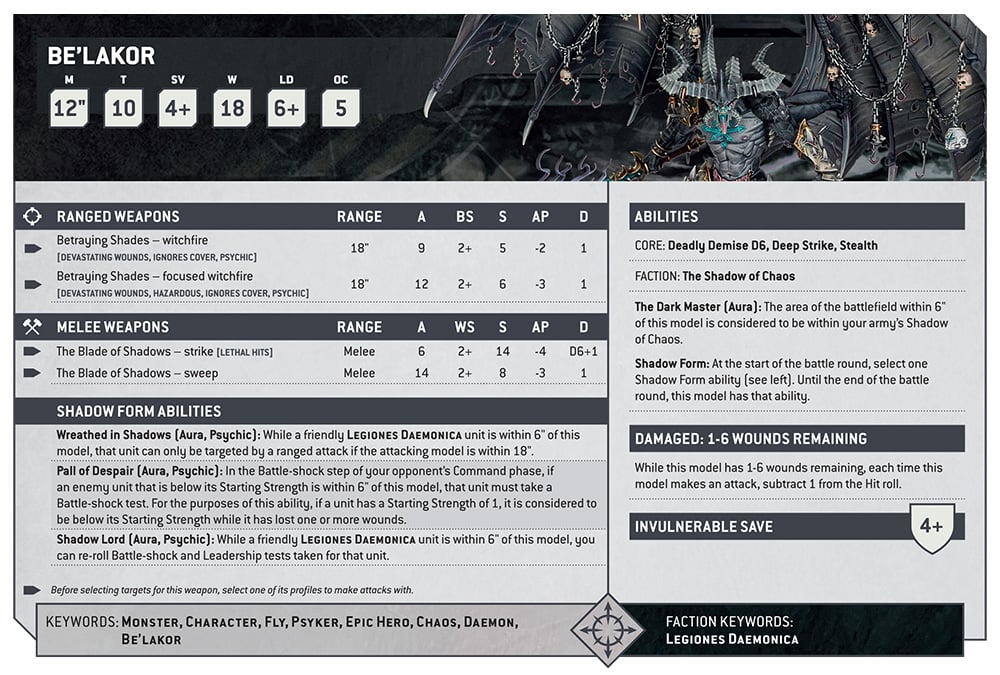
So great is Be’lakor’s power that he strides the battlefield wrapped in a cloak of shadow, corrupting all who come near and casting a thick shroud of darkness across those daemons that call him master. When he closes with his foe, the Blade of Shadows makes quick work of man and machine alike, sweeping entire squads aside or slicing tanks in half with ease.
Weapon Spotlight
Units normally have to pick just one of their melee weapons to fight with in a given turn, but many warriors go to war with powerful steeds, vicious pets, or weaponised cybernetics. The Extra Attacks weapon ability allows these to make, er, extra attacks – it’s particularly common among Chaos Daemons, who are absolutely festooned with tails, claws, Bileblades, and other prehensile nastiness.

Extra Attacks is by no means limited to Chaos Daemons – from cavalry to Carnifexes, the rule shows up on a wide variety of datasheets from other factions.
When a wielder of daemonic power does put their full strength behind their signature weapons, little in the mortal universe can stand before them. Skarbrand is notorious for the sheer number of heads he’s cleaved from unwilling donors, in no small part thanks to the destructive might of his creatively-named axes, Slaughter and Carnage.

Stratagem Spotlight
Several of the Stratagems granted by the Daemonic Incursion Detachment interact further with The Shadow of Chaos, surging in strength as realspace wears thin. An impatient daemon general can even create localised squalls of warp-gloom on objectives they control, ensuring the battlefield remains under their influence even as they hunt for further prey.
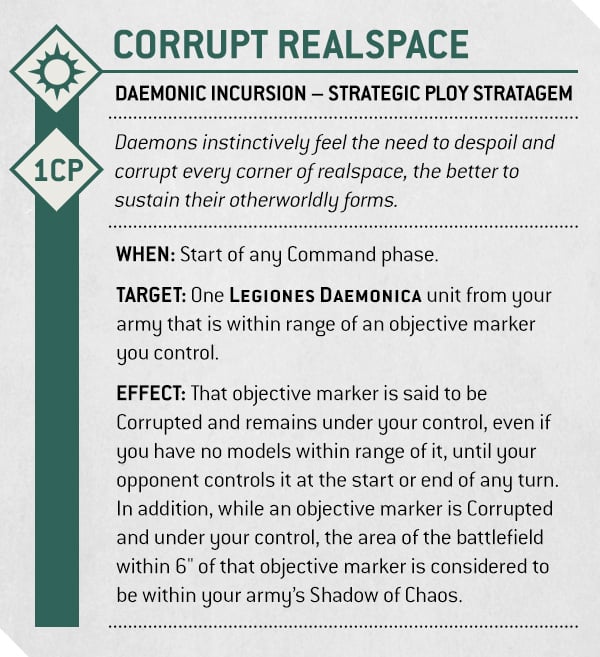
Corrupt Realspace is a powerful strategic tool for defending your turf, as it will weaken the morale of any enemy who gets within range of that objective – and a failed Battle-shock test will prevent them from retaking it at all. An objective is only captured when the total Objective Control of nearby models exceeds that of their opponent, so a unit with OC 0 will effectively ‘tie’ even when faced with a complete lack of challengers.
The Word from the Studio
Robin from the Warhammer Design Studio has given us the lowdown on the cackling denizens of the warp: “When one faces an army of Chaos Daemons they are facing the warp itself, for where they fight the boundaries between realspace and the immaterium are thin. That’s the intent behind their army rule – the idea being that as the Chaos Daemons fight they spread the warp itself over the battlefield – and while such a thing is beneficial to daemons, it’s a literal hellscape to mortals.
“Chaos Daemon armies are predominantly melee-focused, and with every unit being able to Deep Strike it’s no easy task for a foe to keep themselves safe. This is especially true thanks to the Daemonic Incursion Detachment rule – Warp Strike – which enables daemons to claw their way out of the immaterium to slaughter any who venture into your territory.”
This week we’ve been jumping into Faction Focus articles on Warhammer Community, showing you how your armies are going to play in the new edition of Warhammer 40,000.
But it’s all well and good finding out that heavy laser destroyers are now Strength 16, or that the Swarmlord is REALLY scary in combat. What every general needs to know is how best to deploy these terrifying assets to assure victory in the field, and make sure you’re not outmanoeuvred by a particularly cunning grot.
Last Friday we revealed the workings of the new Chapter Approved deck included in the Leviathan box set, which lets you generate your own games with cards for Deployment, Missions, Gambits, and more. This week we’re looking at some of the nuances of this awesome new system, the design decisions behind it, and how it makes Warhammer 40,000 a better game for all players.
Missions and Objectives
First up, the Missions. Missions in Warhammer 40,000’s 9th edition were the most successful and balanced ever. They were used worldwide by the tournament community and casual gamers alike, which meant that whenever you picked up a game of Warhammer 40,000, you knew what rules you were going to play with. Excellent news!
After a while, however, they could become a bit samey – and with fixed objectives for each game, it became possible to tailor your army to effectively score points before ever setting up a model. Not only that, each new Codex brought faction-specific secondary objectives that created a bias of haves and have-nots. A Dark Angels player could load up on hardy units, knowing they would sit on an objective all game and fulfil a secondary, in a way that an Ork player could not. This inevitably made it more challenging to balance.
The introduction of the Tempest of War cards helped shake up the types of missions being played, and added more variety. But it also created two types of game – leaving some people who preferred Tempest games, and others who preferred the more fixed “Grand Tournament” style.
In the new edition of Warhammer 40,000, we think we’ve struck the perfect balance, taking the best bits from both systems and giving people the chance to play the game the way they want to – even if their opponent prefers a different style for themselves.
Primary Missions
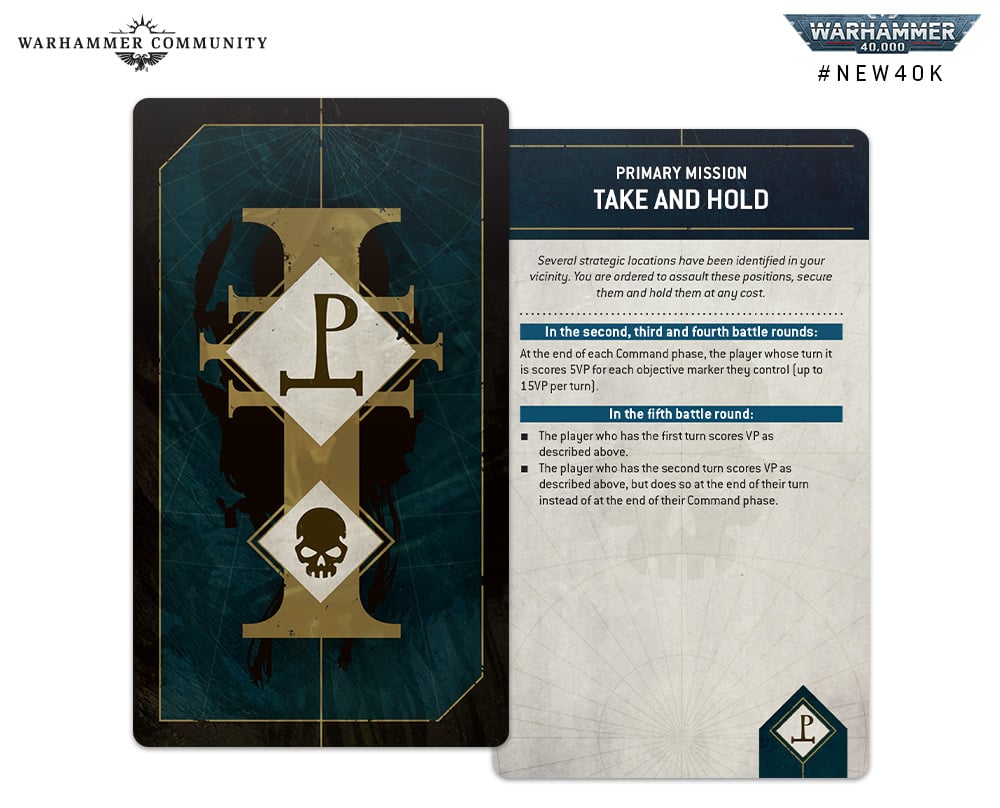
There are nine different Primary Missions in the deck. Some resemble tried and true objectives from the current edition of the game, while others are radically different. Coupled with five different Deployment maps and 12 different Mission Rules, this creates a wider variety of exciting game options right off the bat.
You can score up to 50 Victory points per game from your Primary Mission – more than any other single source of VP – making it the key to triumph no matter what other cards you draw.
Secondary Missions
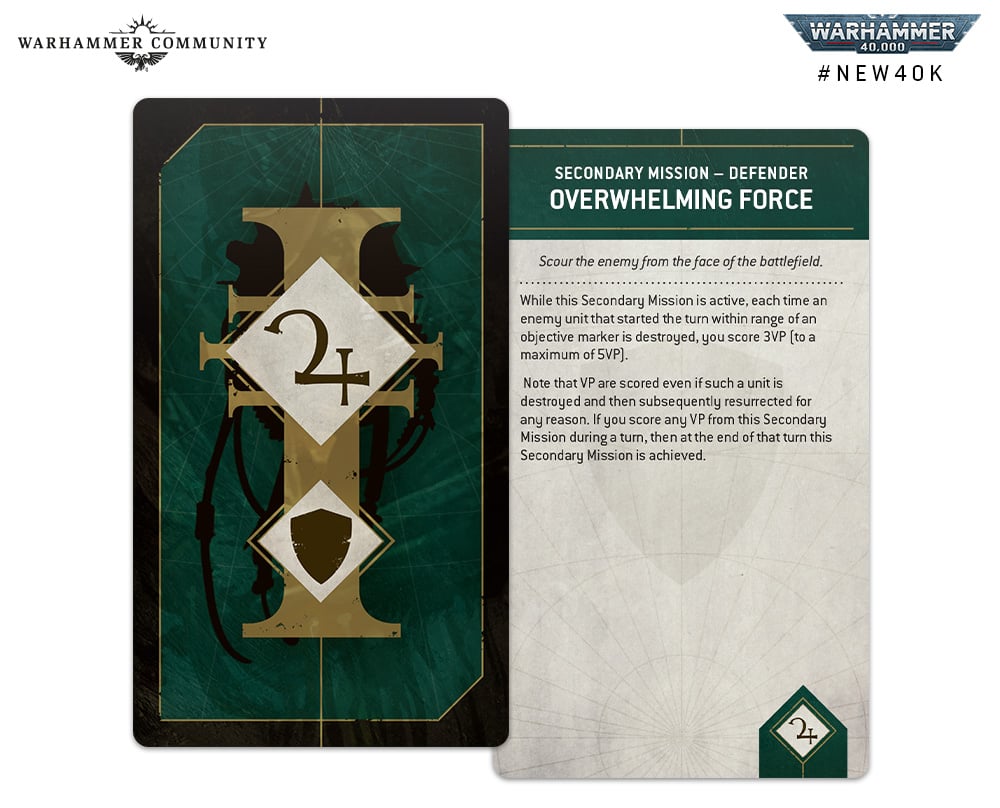
In every game, you and your opponent both have identical decks of 16 different Secondary Missions. All of these can be played as “Tactical” Missions – meaning you’ll use the whole deck and draw two Secondary Missions at random. These must be then replaced with new randomly-drawn cards as they’re completed throughout the battle.
Alternatively, seven of these Secondary Missions can also be played as “Fixed” Missions – meaning you’ll select two specific cards and stick with them the entire game. Fixed Missions are perfect for armies who prefer to pursue their own battleplan, while Tactical Missions are more random – and therefore riskier – but will reward flexible armies that can adapt to the tides of war.
Importantly, the decision to play with Tactical Missions or Fixed Missions is entirely up to you, and made after generating your Primary Mission, Deployment, and Mission Rule. Your opponent may choose the same, or the opposite, and you can change your approach from game to game. We’ve been very careful to scale the Victory points on offer to make both styles appealing – you may simply prefer one specific style over the other, or you can make your decision based on your opponent’s army, the way the Primary Mission interacts with your matchup, and your own tendencies as a planner or a gambler.
Regardless of whether they’re using Tactical Missions or Fixed Missions, players can score a maximum of 40 Victory points from Secondary Missions. Fixed Missions players can only score 20 Victory points from each of their two individual Secondary Missions, so they can’t afford to neglect either.
Meanwhile, players using Tactical Missions will discard each card the moment they achieve that Secondary Mission, and only replace discarded cards in their next Command phase – meaning you can’t cycle through your whole deck and hit 40VP in one extremely lucky turn. There are other ways to discard unfavourable Secondary Missions, but they’re limited and have their own cost – if you can, it’s better to play the hand you’re dealt…

You don’t have to spend a Command point to ditch a tricky Secondary Mission, however – at the end of each of your turns, you can discard one or more Secondary Missions and gain a Command point. You’ll be giving up on the chance to score that Secondary Mission, and won’t draw a replacement until your next Command phase, but you won’t be stuck with cards you can’t or don’t want to score.

Gambits
Gambits are another new addition to the game – at a glance, they may look like nothing more than a wild way to score a bunch of extra Victory points on the roll of a dice. Looks, however, can be deceiving…

Gambits have been designed with both competitive and casual play in mind to offer players a challenging do-or-die Hail Mary. At the end of the third battle round, players can totally abandon their Primary Mission, and instead select one of two randomly drawn Gambits.
In the current edition of the game, it isn’t uncommon for a game to be very close and hotly contested – but due to the nature of progressively scored Victory points, for one player to be mathematically out of reach only halfway through. This can be quite disheartening – whether you’re a competitive player facing a foregone result, or a casual player rolling out a futile struggle after days or weeks of getting hyped for your upcoming game. Gambits are designed to solve these problems – without creating a situation where a totally outplayed army gets lucky just by rolling a 12.
If you complete battle round 3 – a little over halfway through – and find that the game is very close but just out of reach on the Primary Mission, you can telegraph to your opponent that you’re going to abandon the Primary Mission and aim for a long shot. Of course, this will give them the opportunity to stop you from achieving your Gambit – and they’ll have two whole rounds to prevent the completion of your risky new gameplan.
Should you succeed in your Gambit, you’ll score 30 Victory points – but crucially, this reward is still limited by that standard cap of 50VP per game from the Primary Mission. If your opponent is running away with the game – and keeps running, since they can still score the Primary Mission perfectly well for the next two rounds – then a desperate Gambit won’t let you win all on its own. Even then, however, it can offer an exhilarating sidequest to pursue as a narratively fulfilling way to finish out a lost battle.
EXAMPLE: Stu and Mike are playing a game. At the end of battle round 3, Mike has scored 15 Victory points for the Primary mission, while Stu is dominating the objectives on the battlefield and has scored 30VP. Knowing that he is unlikely to push Stu off all of the objectives, Mike decides to go with a Gambit. This will give him a slim chance of hitting 45VP for his Primary – but Stu can still score away on objectives, and has two full rounds to thwart Mike’s gamble. If the game was closer, Mike might decide he’s better off pursuing the original mission as it is more reliable.
(WarCom would like to clarify that the in-game events in this example are for explanatory purposes only, and Stu has never been this far ahead of Mike in a real game…)
It’s worth noting that you can’t build your army to intentionally Gambit – if you wanted to, for some reason – since you randomly discard one of the three Gambits in the deck before making your choice. Build your army around achieving the Orbital Strike Coordinates Gambit, and you’ll be in trouble when you draw Emergency Evacuation and Delaying Tactics.
By the maths, the Gambit is a competitively balanced, tournament-intended, narratively suspenseful mechanic intended to keep very close games exciting to the end.
GT Packs
For tournament organisers, there will be a digital and routinely updated GT pack from Day 1 of the new edition. This will include suggested combinations of Deployments, Primary Missions, and Mission Rules for typical tournament play, using the Leviathan card decks to pre-generate these shared parts of the game so all players at the event are playing the same mission.
This pack will also include an organisers’ commentary, tuned to provide new event organisers with some good starter tips, without any overly prescriptive elements that might infringe on the well-established best practices of the amazing global community of TOs.
Overview
Necrons have long been an army of implacable, silent warriors, marching forwards in an unstoppable phalanx of flesh-stripping gauss fire. This is still true, but now many larger constructs – such as the Canoptek Doomstalker, Triarch Stalker, Canoptek Spyders, and Ghost Ark follow the trend of much-increased Toughness. Combined with the reduction in Armour Penetration, your army will feel like a truly indestructible force of living metal.
Faction Rules
Necron armies can field a wide variety of units, from humble Canoptek Scarabs to shards of fallen Star Gods. In between these two extremes, they have reliable foot soldiers such as Immortals, tunnelling ambushers like Ophydian Destroyers, and technology-bending Crypteks like the Psychomancers, Chronomancers, and Technomancers.
Reanimation Protocols are the one thing these mechanical marauders all have in common – an army rule that grants Necron models the ability to recover from even lethal damage.

This ability is an old friend to Necron players, but it’s now simpler and more reliable than ever. There’s nothing better for any self-respecting Overlord than the look on an opponent’s face when limbs re-attach, smashed skulls rejoin sundered torsos, and the Necrons stand back up, ready to fight again.
Even the most durable Necron chassis pales in comparison to the indomitable will of their nobility. The Awakened Dynasty Detachment rule is Command Protocols, which makes your units even more accurate when a Leader is around to impose their deathless dominion, and helps keep your units above half strength to avoid Battleshock tests..
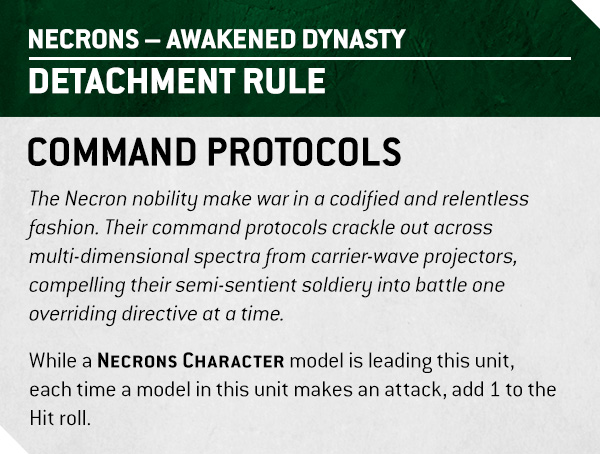
This is on top of any other abilities that your Leaders give their Bodyguards – you’ll want to make sure that you’ve got plenty of CHARACTERS hanging out with some metal minions to really make the most of this.
Unit Spotlight
Did you think the Space Marines had hit the jackpot with the Land Raider – a tank AND a transport? Well, anything Arkhan Land can do, the Necrons can do better – check out the new stats for the Monolith.
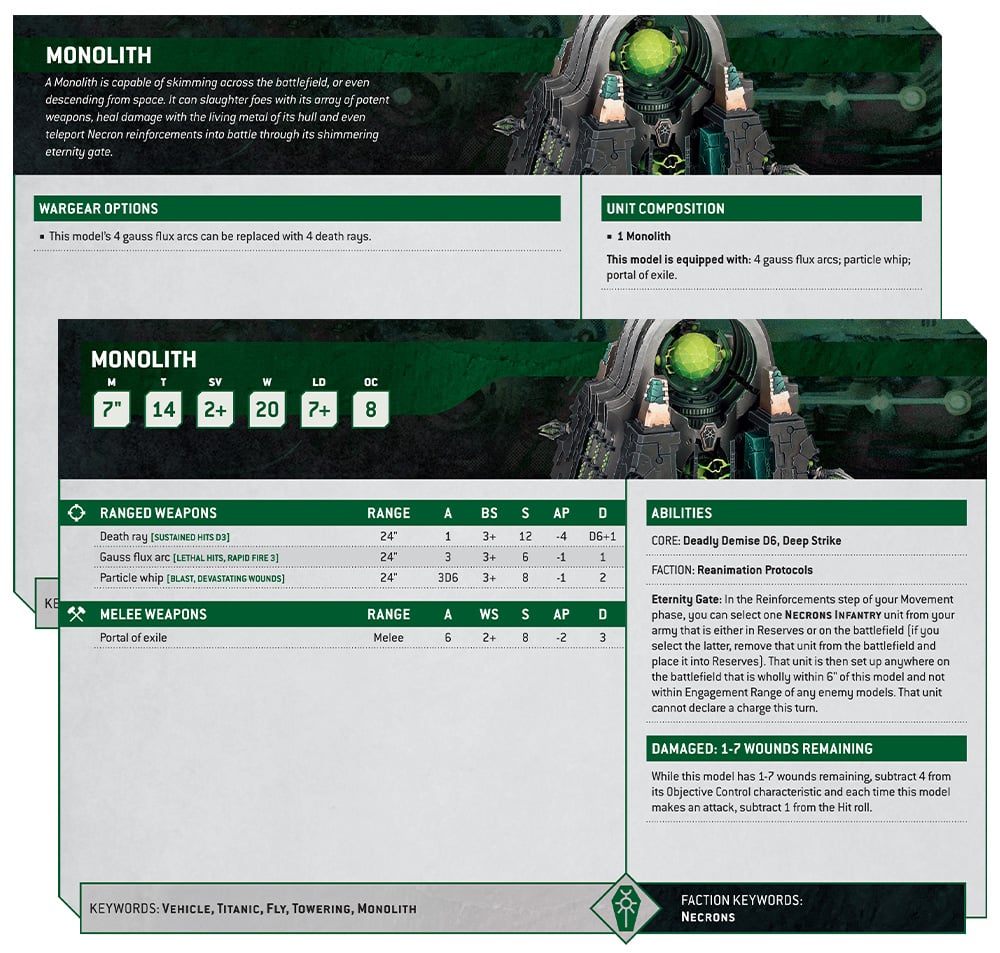
A spray of anti-matter from the particle whip will remove whole handfuls of Space Marines from the table, and an assemblage of gauss flux arcs can chew through a truly worrying amount of infantry – or you can swap them out for the appropriately-named death rays, which have the stats to kill pretty much anything.
With an Objective Control value of 8, the Monolith is great for sticking on a vital objective in the middle of the board, where you can use its Eternity Gate to call in your INFANTRY units from Strategic Reserves – or from right across the battlefield.
The best candidates for teleporting around in such a way are the humble Necron Warriors. They’re little more than mindless automatons, but what these robotic regiments lack in initiative, they more than make up for in utter relentlessness.

Their Number is Legion makes the most of Reanimation Protocols – they’ll just keep coming, forcing your opponent to wipe them out entirely or contend with them all game. And all that effort that’s going into your Necron Warriors isn’t going into the rest of your army.
Weapon Spotlight
The Necron Warriors will kill a lot of enemies with their gauss flayers and reapers through sheer weight of firepower. But if you really need to obliterate something absolutely right now, might we recommend the doomsday cannon?
This impossibly-advanced energy weapon delivers a mighty Strength 15 Blast that will tear through even the improved Toughness of most vehicles like so much paper. Plus, if your Doomsday Ark stays stationary, the doomsday cannon gains the Devastating Wounds ability, allowing it to toss out mortal wounds that bypass invulnerable saves and spread its Damage around. It really is doomsday for anything you point this at.
If you still need a little extra help with enemy vehicles, it’s time to call on the C’tan Shard of the Void Dragon. Its particle-splitting spear makes the lightest work of tanks and other fighting vehicles with Anti-Vehicle 2+, and its sweep profile will melt infantry too.
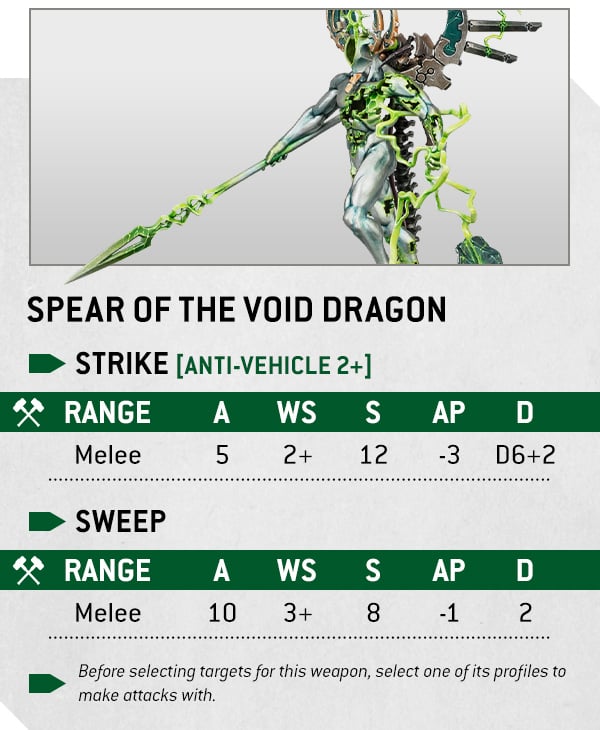
That’s just what you’d expect when you unleash a shard of a Star God on anyone foolish enough to stand in your way.
Stratagem Spotlight
As with the other forces in the new edition of Warhammer 40,000, the Necrons have six Detachment-specific Stratagems. The Protocol of the Hungry Void Stratagem is your go-to for slicing your way through the galaxy’s younger races.
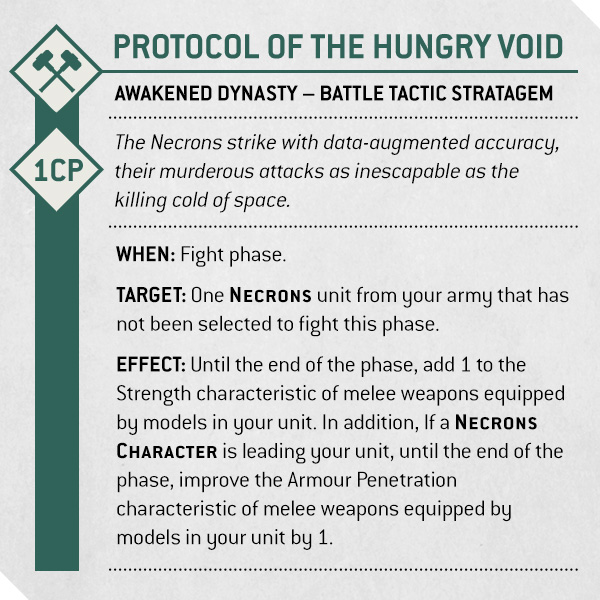
This is perfect for dedicated close-combat units such as Flayed Ones or Skorpekh Destroyers – especially if they’re led by a Skorpekh Lord. It just goes to show that while Necrons might have emotionless faces, they are more than capable of getting angry.
The Word from the Studio
“We wanted to capture the feeling that you are facing a slow, creeping, unending legion of deathless foes”, explains Robin from the Warhammer Studio. “Their Reanimation Protocols will, given enough time, regenerate every unit to full strength. We also wanted to instil the idea that the massed ranks are under the control of immortal leaders, by whose will and command their legions fight with such unnerving coordination and lethality. Command Protocols and CHARACTERS are therefore the main theme behind the Awakened Legions Detachment.
“We are excited to see what players make of the new datasheets for Necrons – their ancient and deadly technologies have been represented by a variety of special abilities.”
Overview
Chaos Space Marines have all of the skill and flexibility of their loyalist counterparts, supplemented by forbidden power borrowed from the warp. Sorcerous invocations and terrifying mutations are yours to command, backed by raging Daemon Engines and hordes of screaming cultists.
Such gifts rarely come without a cost, but the boons they grant are worth the risk. And, at the end of the day, these are still Space Marines – tough as nails, reliable in a fight, and guaranteed to out-muscle lesser creatures man-to-man.
Faction Rules
Heretic Astartes warbands come in many shapes and colours, but they are united by their willingness to make Dark Pacts for power. As their Army Rule, this gives all Chaos Space Marine commanders the opportunity to acquire potent core abilities… if they’re willing to gamble the lives of their troops.
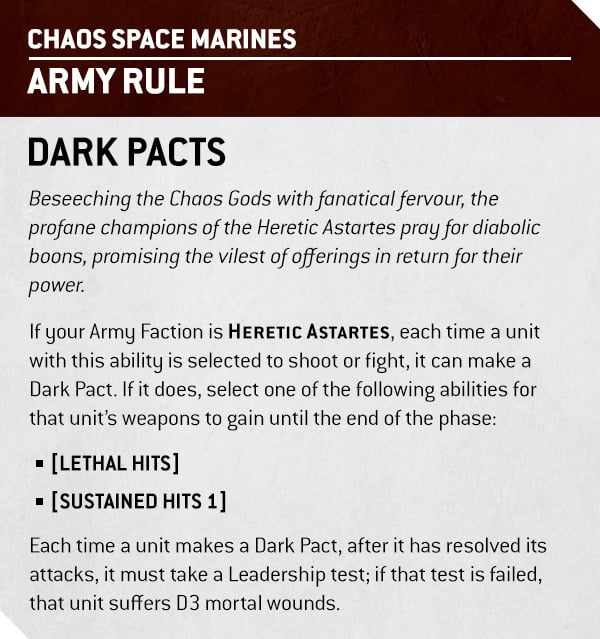
You can make Dark Pacts as many times as you like during a game, so the only limit is how many souls you want to offer up to the Chaos Gods in return. Even a Cultist Mob can gain great power through their patron’s blessing, turning their scavenged blades into something deadly and profane that can threaten any enemy unit.
Unit Spotlight
The core of any Chaos Space Marine invasion is made up of Legionaries. Whether they’re veterans of the Horus Heresy or more recent renegades, these traitors have long since abandoned notions of professionalism and tradition, and bring a very eclectic range of equipment to the field. Look at all these weapon options!

This squad can be kitted out to deal with almost any target, at almost any range – whether you want them to shred hordes at range with a reaper chaincannon, flamer, and boltguns, or tackle elites up close with roaring chainswords and a pair of heavy melee weapons. The right Dark Pact can make them even better at their chosen task, or help them to further diversify their death-dealing.
It takes a strong will indeed to knit fractious Legions and renegade warbands into a cohesive combat whole, and Abaddon the Despoiler is just about the only mortal who’s ever truly managed it. The Warmaster of the Imperium Nihilus is a general on par with the Imperial Primarchs, and he’s an absolute terror in the thick of combat as well.
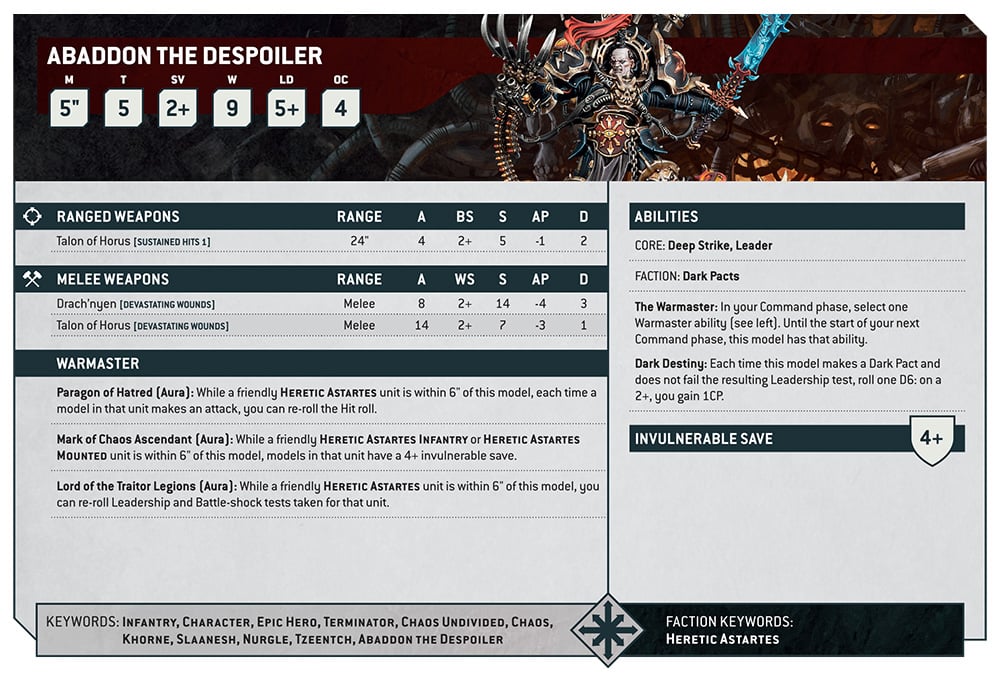
Abaddon is a rare character – he bestows powerful Aura abilities on nearby allies even while leading a unit, and can choose which of them to apply every turn. Appropriately for one who holds the Chaos Gods in open contempt, his Dark Destiny lets him generate a Command point every time he seals a Dark Pact and prevails in the resulting battle of wills – for the Ruinous Powers are just another tool in his grand ambition for the galaxy.
Weapon Spotlight
Chaos Space Marines are known for their desire to let the galaxy burn, and wield profane weapons warped over millennia or crafted in infernal forges for just that purpose. The notorious baleflamer has been the bane of heavy infantry since Heldrakes first darkened the skies, and it returns more reliable than ever, with more shots and the new ability to ignore cover.
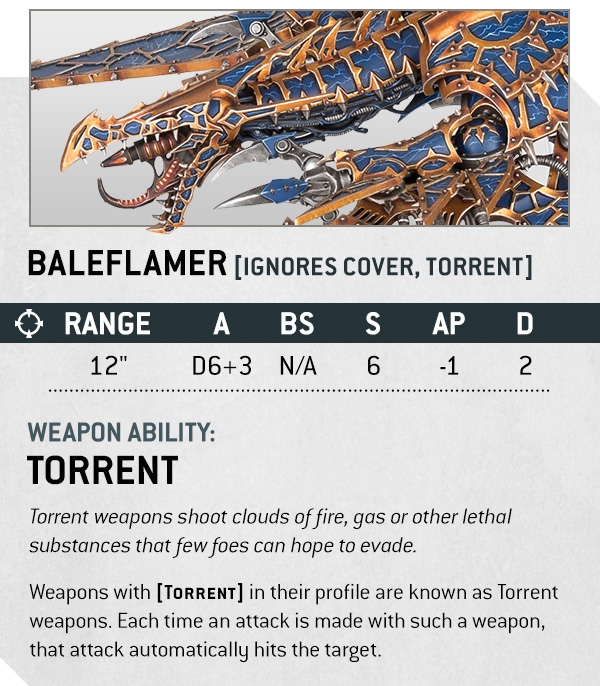
Likewise, the fleshmetal guns that sprout from Obliterators receive profile tweaks and a scattering of new weapon abilities to help each profile stand out even more for its specific job – whether that’s melting vehicles at close range or shredding hordes aplenty.

Stratagem Spotlight
Five of the six Stratagems available to the Slaves to Darkness Detachment gain extra effects when targeting a unit blessed by one of the gods – or those devoted to CHAOS UNDIVIDED. All squads can take refuge behind unnerving warp-omens with Dark Obscuration, for instance, but Nurgle blesses his faithful children with especially thick clouds of foetid fog, obscuring their purposeful advance.

How does one pledge themselves to a specific god and gain their boons, exactly? That’s also part of the Detachment rule for the Slaves to Darkness Detachment, which makes it easier than ever before – but you’ll need to wait to see the sinister details…The Word from the Studio
“Chaos Space Marines are hungry for power and destruction, and that’s what inspired their Army Rule – Dark Pacts,” explains Robin from the Warhammer Design Studio. “With them, the Chaos Space Marines are granted a boon of power, but such power comes at a price… The Slaves to Darkness Detachment further explores this relationship between the Heretic Astartes and the Chaos Gods, granting your forces different powers depending on their patron deity.”
“The datasheets for Chaos Space Marines are less cooperative or synergistic than their Imperial counterparts – rather, they are more about the selfish use of power to destroy their foes.”
Overview
The Tyranids are ravening monsters who devour worlds in a chitinous tide – and as you might imagine, they test the mettle of even hardened veterans. Accordingly, they have several ways to apply Battle-shock tests to cowering foes and take advantage of the results – including their powerful Shadow in the Warp ability.
They also benefit more than ever from working together as a single, all-consuming mass, guided by the Synapse network that emanates from the Hive Mind’s node beasts.
Faction Rules
We’ve already seen what the Hyper-adaptations from the Invasion Fleet Detachment can do, but that’s only one facet of the swarm. All Tyranids, no matter which Detachment you pick, benefit from the two unique army rules we just mentioned – Synapse and Shadow in the Warp.
The former will be familiar to veteran Tyranid players – smaller bioforms who stay close to their betters get to roll an extra dice when making Battle-shock tests. This ability compensates for the low Leadership characteristics common to lesser Tyranids – beyond Synapse Range, they’re a mindless rabble driven by predatory instincts. Within Synapse Range, they’re a swarm of singular and unrelenting purpose…

SYNAPSE creatures now also act as nodes to call the Shadow in the Warp down onto the battlefield, forcing an immediate Battle-shock test on every unit in the opponent’s army. You can trigger this ability once per game, in either player’s Command phase, and it can utterly annihilate your foe’s battle plan as key units lose control of objectives and access to Stratagems.
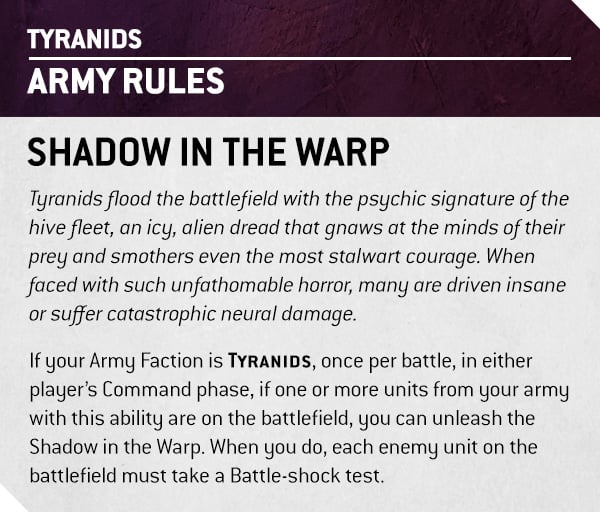
Taken together, these abilities allow you to control the morale game and ensure your units snag objectives. A failed Battle-shock test imparts some pretty serious penalties, and it’ll only take a few opposing units bottling it to swing the game in your favour.
Unit Spotlight
Genestealers have helped shape the galaxy of Warhammer 40,000 from the early days of Space Hulk, lurking in the nightmares of Terminators ever since. They’re now twice as hard to put down, with one extra Wound each, while the Scouts 8? core ability gives them a free move of 8? after deployment. They’re perfect for scuttling over to a key objective, where their rending claws get full Wound re-rolls thanks to the Vanguard Predator ability.
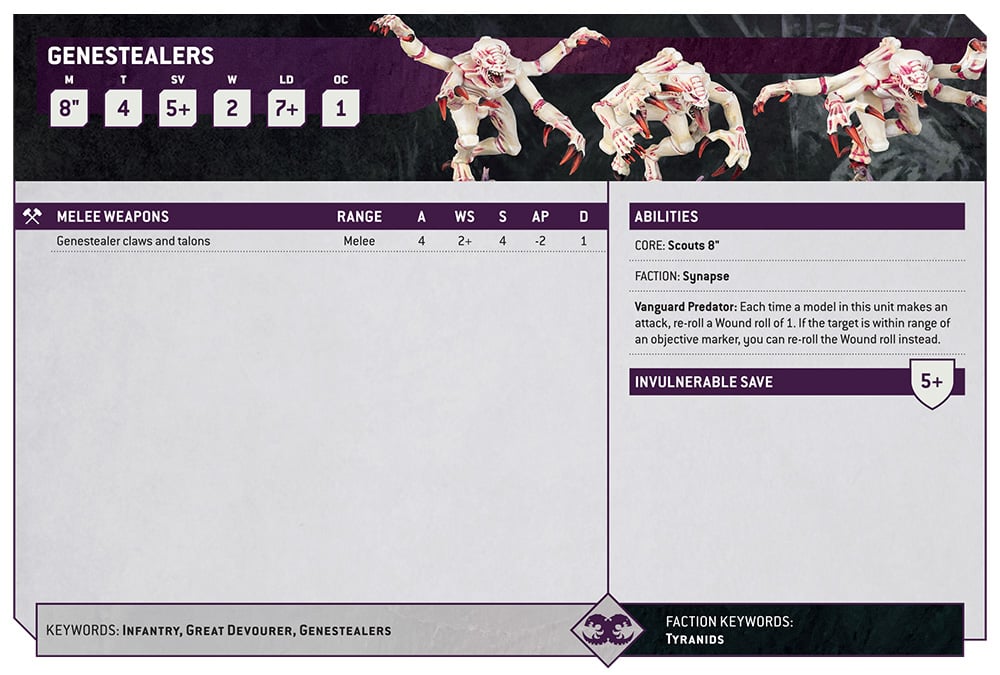
Tyranid swarms are capable of shockingly cunning strategic manoeuvres, and none exemplify this better than the Swarmlord. This apex bioform is a military genius on par with the galaxy’s best generals, spawned only when the Hive Mind needs to overwhelm particularly tough targets.

The Swarmlord cements your mastery over the Command phase with two key abilities. Hive Commander effectively doubles the Command points you generate in your own turn, allowing you to employ more juicy Stratagems. Malign Presence, on the other hand, is a nasty way to shut out your opponent’s most reliable Stratagems, allowing you to increase the CP cost of one specific Stratagem for the rest of the battle.
Weapon Spotlight
Though they have a reputation as close combat monsters, Tyranids pack some serious ranged firepower. The rupture cannon is a massive two-stage bioweapon mounted on the lumbering Tyrannofex that launches acid-filled ticks and chemically unstable seeds the size of cars – because of course it does.

The rupture cannon’s revolting payload gets even stronger in the new edition, to keep up with the tougher vehicles it’ll encounter, and it can put out some seriously eye-watering damage numbers. Better yet, the new Heavy weapon ability makes it more accurate, provided your Tyrannofex can stay put and plant its feet. Er, claws.
Stratagem Spotlight
A swarm of Tyranids at full tilt is an endless tide of chittering creatures, replacing fallen bodies almost as soon as they hit the ground. These units are marked by the ENDLESS MULTITUDE keyword, which ties into the new-look Endless Swarm Stratagem.
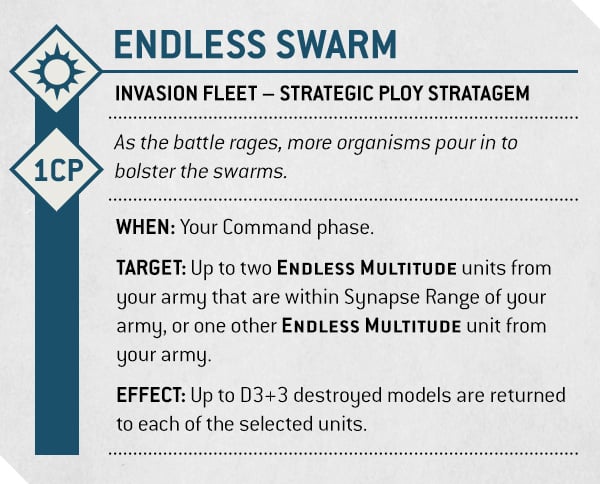
Termagants, Hormagaunts, Gargoyles, and the new Neurogaunts featured in the Leviathan boxed set all have this keyword. For just a single Command point, you can bring back up to six fallen critters – or take advantage of your Synapse network to target two units at once, and resurrect up to 12 models in each of your turns! That’s a lot of wasted firepower for your opponent.
The Word from the Studio
“We were keen to bring the unnatural, alien horror of the Tyranids to the fore in this edition, emphasising that they are utterly terrifying foes to fight,” explains Robin from the Warhammer Studio.
“This leads to the Shadow in the Warp causing battlefield-wide panic and disruption, while creatures in Synapse Range remain single-minded and utterly lethal, especially in the confines of close combat. Meanwhile, the famed bio-adaptability of the Tyranids is captured in their Detachment rules, allowing them to adapt at the start of battle to be best suited to overcome their prey.”
Overview
Space Marines have always been the toughest warriors around, and they once again live up to the legend on the tabletop. Many units – such as Terminators, Centurions, and those wearing Mk X Gravis armour – now have higher Toughness, while the game-wide reduction in Armour Penetration makes power armour feel as tough as it should be.
And while re-rolls to hit and wound are much rarer now, Space Marines have more access to reflect their elite status – chiefly through the Oath of Moment faction ability. Your warriors may be few, but they’re terrifyingly efficient Angels of Death.
Faction Rules
Space Marines are organised into self-contained Chapters, which must be highly self-sufficient in the field. The standard doctrine of the Codex Astartes emphasises flexibility – as exemplified by the Gladius Task Force Detachment. This battle-tested formation is available to every Space Marine Chapter, whether they’re slavish adherents of the Codex Astartes or slightly more eccentric.*
The Detachment rule for the Gladius Task Force is Combat Doctrines, which gives players the choice of three powerful disciplines to focus on at the start of their Command phase. These can really turn the tide at a critical moment.

Each of these Combat Doctrines only works once per battle, so choose wisely – combined with the Oath of Moment that all Space Marine armies get, you can rally and unleash a hellacious strike on dangerous foes at the critical moment. Sudden decapitating strikes are a Space Marine speciality, and they’re now so good at it that your opponent won’t even have time to ask how your Terminators got so far up in his grill.
Unit Spotlight
What can be said about the Land Raider? This venerable transport is to regular tanks what a Space Marine is to regular humans – a huge, impregnable demigod of a machine that protects its passengers just as well as it fights back, ferrying heavy weapons and heavier troops into battle.
The Assault Ramp is back, dropping cargos of Terminators, Aggressors, or whatever else you choose right into the thick of things, ready to charge.
- What’s this? The BACK of a datacard? It’s where you’ll find things like unit composition, wargear options and transport capacity.
Few units in the Space Marine roster are as big and powerful as a Land Raider, but the Primarch of the Ultramarines certainly fits in that category. Roboute Guilliman is as tough as a tank and twice as deadly, even before we factor in his superhuman spreadsheet skills.
The Lord Commander of the Imperium is a strategic genius par excellence, switching up his abilities every turn to make sure he’s always supporting his men as best as he can. Another great way to support the troops is by turning your enemies to paste, a fate Guilliman is only too happy to mete out with the Hand of Dominion and Emperor’s Sword.

Weapon Spotlight
The Adeptus Astartes are well known for their ability to face any foe that the 41st Millennium can throw at them. From their twisted brothers and armoured and alien battlesuits to hordes of muscled fungal hooligans, there’s a Codex-approved weapons solution for just about any foe imaginable.
When tides of ravenous Tyranids swarm over the horizon, Redemptor Dreadnoughts spin up the heavy onslaught cannon. These spit out an eyewatering 12 shots at Strength 6, a storm of bullets that will perforate low-Toughness targets in their droves – and can even rend through heavy armour via the Devastating Wounds ability, causing it to deal mortal wounds on Critical Wound rolls.
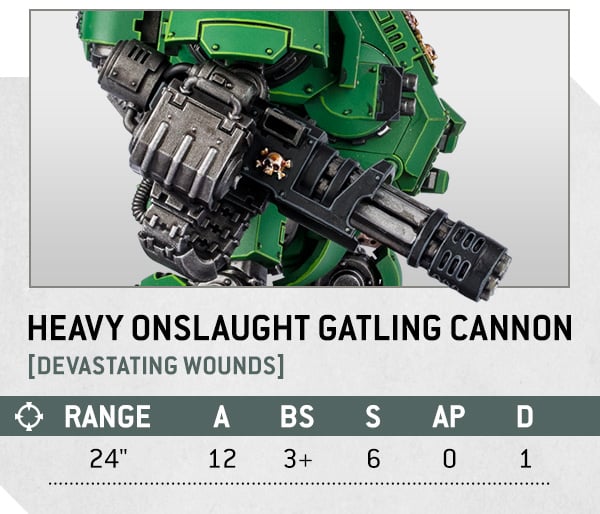
With vehicle Toughness going way up in the new edition, certain anti-tank weapons have become more specialised against improved armour, while others have seen a boost in strength. In the latter category is the heavy laser destroyer atop the Repulsor Executioner – a perfect expression of the Space Marines’ martial might. Or for extra fun, point one at a Termagant and watch them disappear like magic.
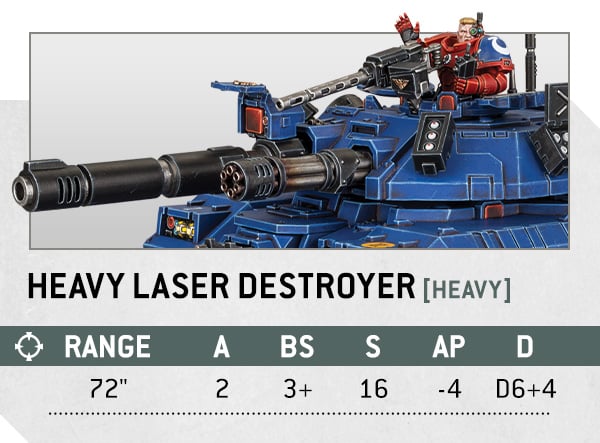
Stratagem Spotlight
There’s now a smaller, more focused slate of unique Stratagems for each faction. The Gladius Task Force provides six crucial options** which distil the essence of the Adeptus Astartes, like the old favourite Only In Death Does Duty End.

If fighting back through mortal injuries were an Olympic sport, the Space Marines would take gold every time. This Stratagem lets them do just that, soaking up whatever the fiercest foes can throw at them before making their killer truly regret their hubris.
The Word from the Studio
“Space Marine armies are elite and able to adapt to defeat any foe,” explains Robin from the Warhammer Design Studio. “It was this adaptability that led to the Oath of Moment ability, combining a targeted tactical choice with a devastating punch. This blend of tactics and power is further backed up by the Gladius Task Force Detachment, which grants the Adeptus Astartes unparalleled flexibility on the battlefield.
“With such a broad range of units, characters and vehicles – all of which bring a different role or utility to the Angels of Death – we are excited to see what kinds of armies Space Marine players bring to the new edition.”
You only get one book in Leviathan – but as the name suggests, it’s a monster of biblical proportions. This luxury 392-page hardback magnum opus has a black ribbon bookmark and a full-art cover with spot gloss effects – and it won’t be available anywhere else in this configuration.
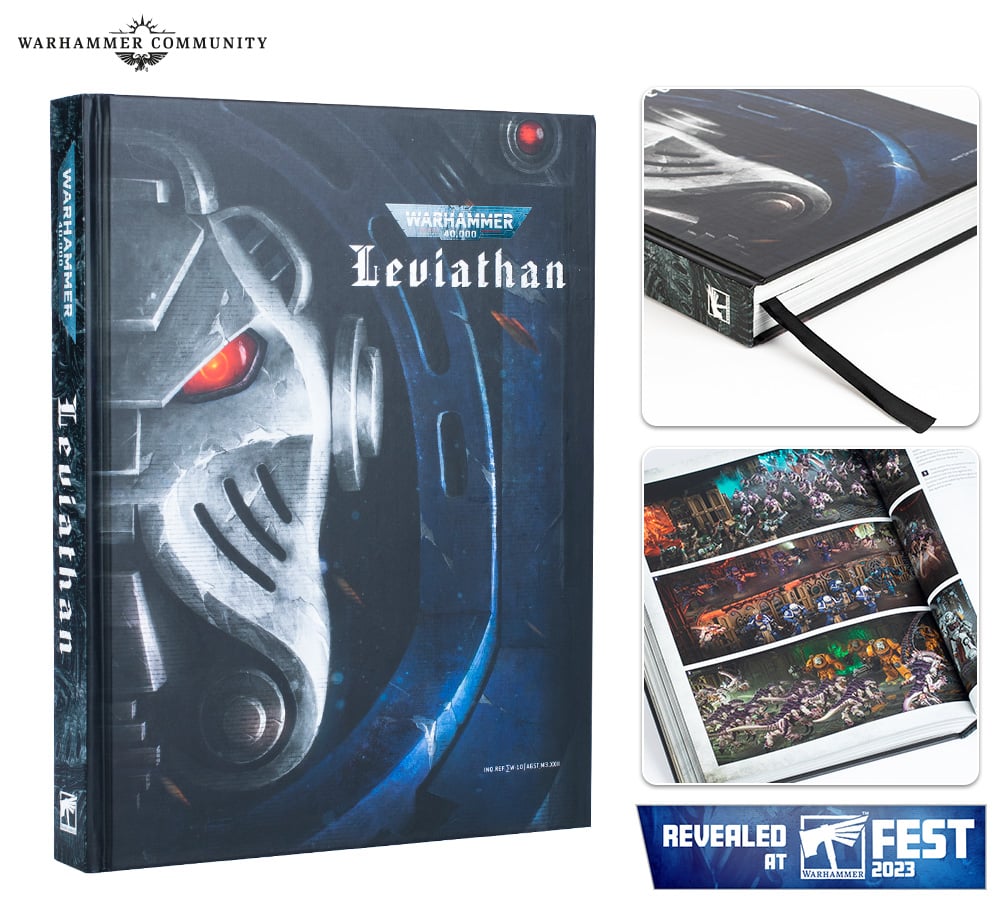
The book is divided into several major sections: the Warhammer Hobby, Dark Imperium background, the Forces of the 41st Millennium, the Core Rules, Combat Patrol rules, and Crusade Rules for the Tyrannic War.

The Warhammer Hobby section comes first, explaining the fun of collecting, building, painting, and playing with your miniatures. Dark Imperium and The Forces of the 41st Millennium each offer a deep dive on the state of play in the galaxy, examining its history, its major players, and key locations.
The Core Rules, meanwhile, are a 60-page section which explain everything you need to know to throw down on the tabletop, with revised and simplified rules which make for fast-paced and thrilling battles in the grim darkness of the far future.
Cleverly, the Core Rules section has its own separate page numbers – this guarantees that no matter which edition of the rules you look at, whether they’re in this volume or other editions yet to be released, you’ll be able to cross-check rules on the same page number.

Combat Patrol is a new, simplified way to play Warhammer 40,000. It balances the Combat Patrol boxes available for each faction into their own game mode, granting certain units extra abilities and removing some from others.
It’s the fastest, simplest way to get your forces onto the tabletop – all you need are these rules, and one Combat Patrol per player. As it happens, a portion of the Tyranids and the Space Marines you’ll find in Leviathan can be used to form a full Combat Patrol for each faction!
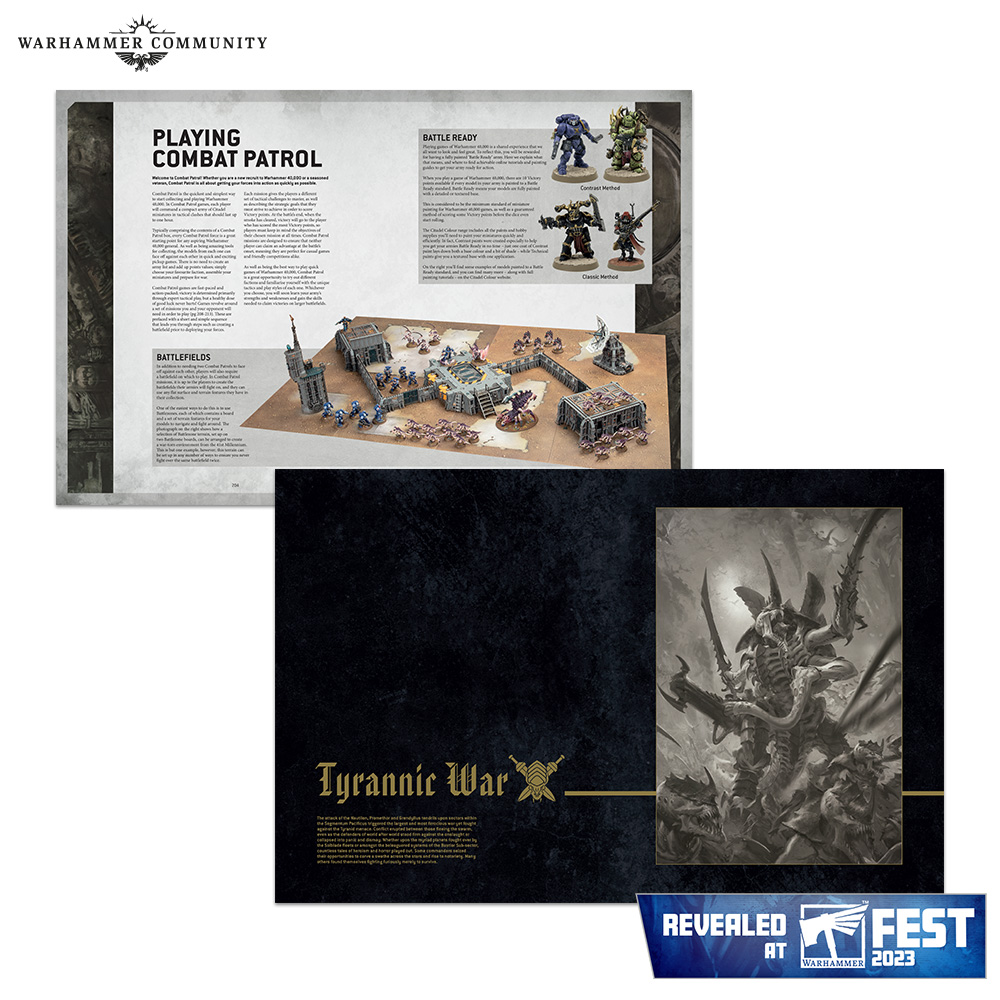
Then there are the Crusade Rules. These will be released as a separate supplement book later this year, but for now this book is the place to find them. It’s a comprehensive guide to campaigning in the Fourth Tyrannic War – including the story of the conflict, rules for building and developing your own Crusade army, and a full swathe of narrative missions and upgrades specific to the Tyrannic War.
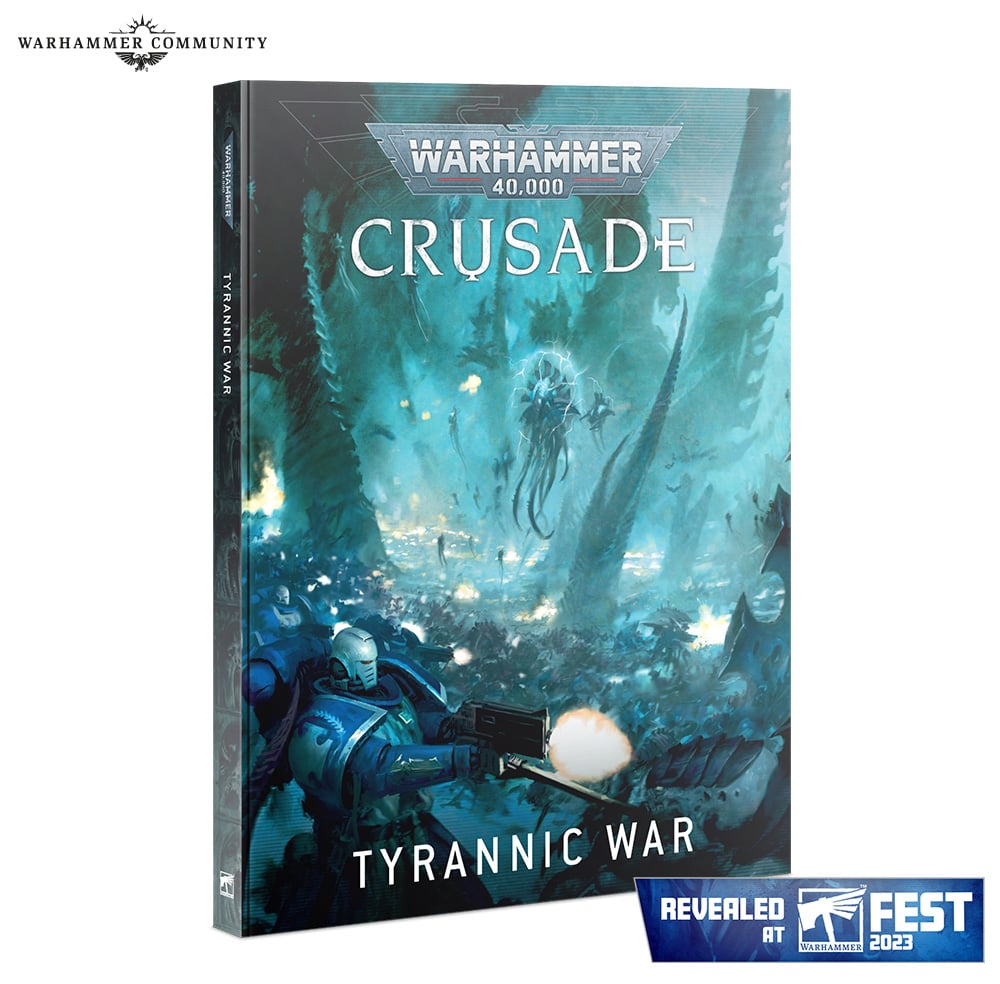
While it’s especially suited to playing through with your Space Marines and Tyranids, the Tyrannic War Crusade rules are entirely usable by every faction. There’s no better way to play Warhammer 40,000 than gaming through an exciting narrative campaign to decide the fate of a sector!
Chapter Approved: Leviathan Mission Deck
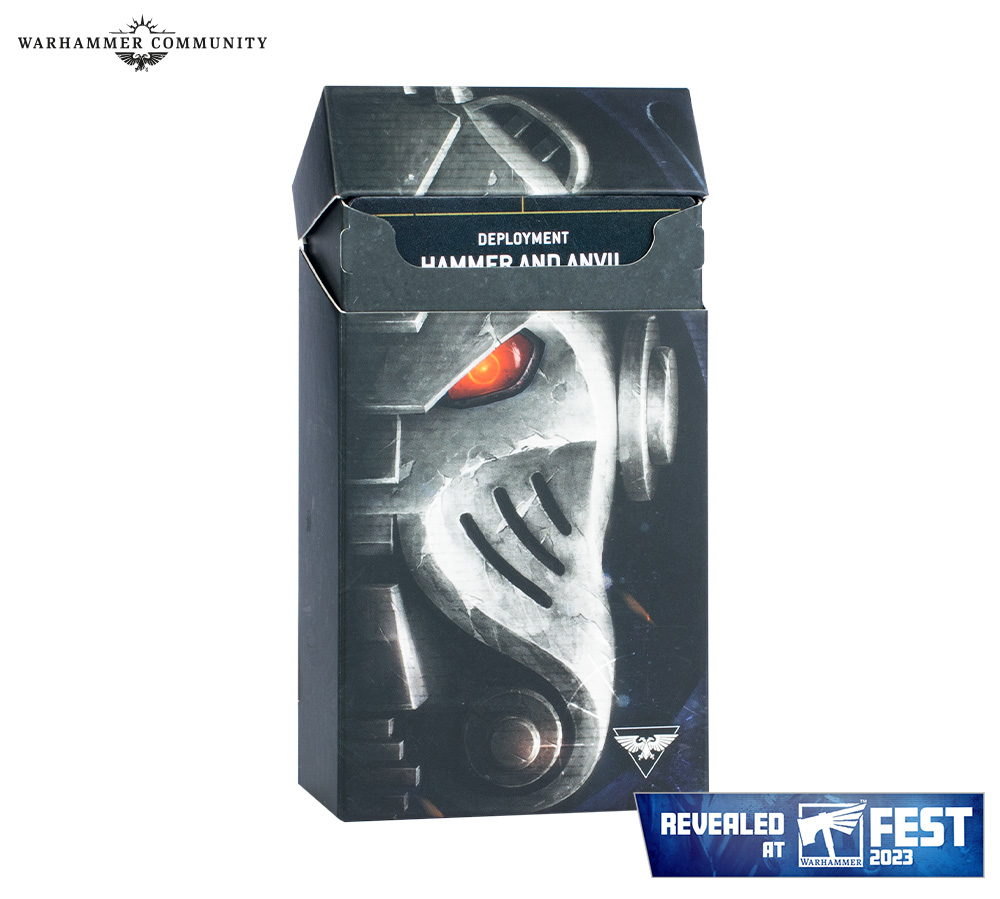
Then there are the mission cards. Building on the success of the Chapter Approved Grand Tournament Mission Packs and taking inspiration from the Tempest of War cards released last year, this deck represents the way to quickly and cleverly build exciting, unexpected, and well-balanced missions for your games.
We explained how the cards work yesterday – read more about them here.

There are 66 cards in the deck, breaking down as follows: five Deployment cards, nine Primary Mission cards, 12 Mission Rules cards, 16 Attacker Secondary Mission cards, 16 Defender Secondary Mission cards, four Attacker Gambit cards, and four Defender Gambit cards.

On top of that, you get six 40mm Objective Markers as sturdy card tokens, and a 10-page rules insert for using your deck. Add that to all those lovely models and you’re in for a shedload of fun!
As you’d expect for a new edition, missions have changed in Warhammer 40,000. In fact, there’s just one in the Core Rules – entitled Only War, this is a perfectly balanced pitched battle in which two players fight for control of four objective markers, which they’ve taken it in turns to place.
These objectives are scattered across a battlefield of 44?x60? at Incursion (1,000 points) and Strike Force size (2,000 points), or 44?x90? for an Onslaught game (3,000+ points). With both players deployed on the short edges, It’s the perfect theatre for a thrilling battle.
The Mission Deck
Only War is only the beginning. The new edition features the Chapter Approved mission system – an evolution of both the popular Tempest of War cards and the Grand Tournament Mission Packs, allowing you to quickly generate balanced and varied missions for every game.
It’s flexible enough to generate anything from a casual pick-up game to the entire mission framework for a top-tier tournament. There are two different ways to pick your Secondary Missions – Fixed secondaries will feel more familiar to fans of the Grand Tournament format, while Tactical secondaries are more akin to Tempest of War. Either way, you’ll get an exciting and challenging experience.

Here’s how they work: Firstly, pick your game size and muster your armies as usual. Then divide the cards into their respective decks: Deployment, Mission Rules, Primary Missions, Secondary Missions (one deck for each player), and Gambits (one deck for each player). At competitive events, these combinations may sometimes be defined ahead of time, but you’ll usually generate them fresh each time you play.
Shuffle each deck, and draw one card from the Deployment, Mission Rules, and Primary Mission decks. These are your shared mission parameters – the Deployment card shows where both sides deploy and where the objective markers are, the Mission Rules card explains any special rules in effect, and the Primary Mission explains how each side collects Victory points (VP).
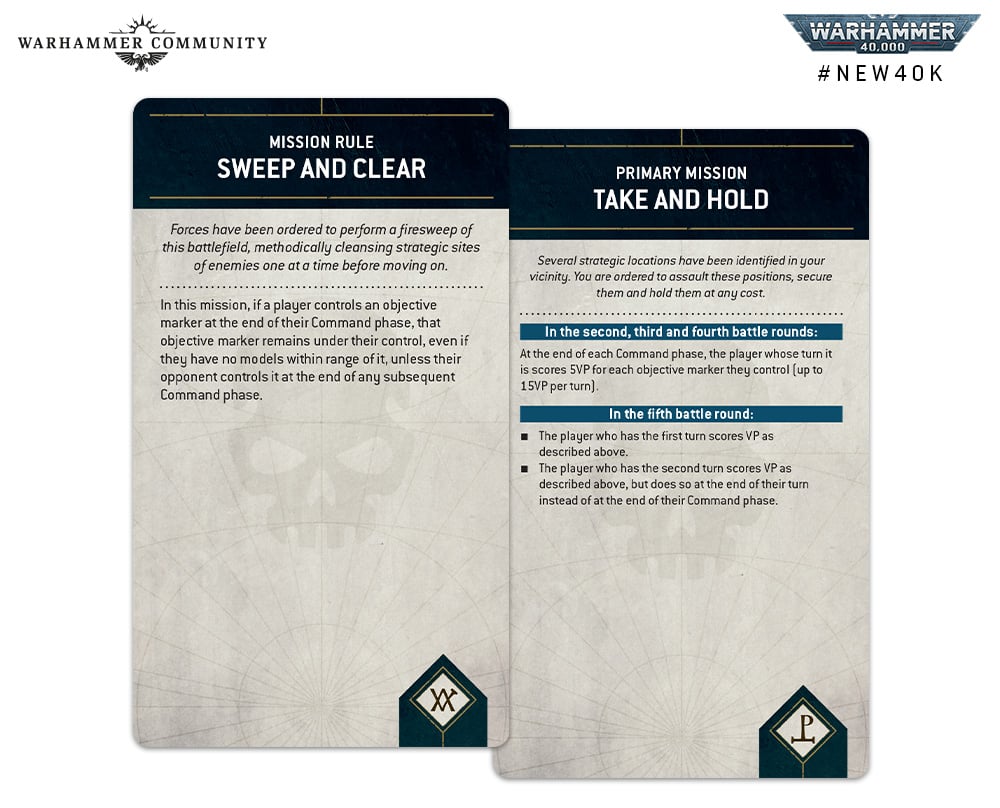
Once they’ve set up the battlefield and determined who’s the Attacker or Defender – but before actually deploying their armies – players select and reveal their Secondary Missions. These are personal goals they’re trying to achieve, like Assassination or Deploy Teleport Homer, which will allow them to score additional VP.
Each player starts with two Secondary Missions, and can either choose Fixed Missions – which remain in place the whole battle, reliable yet predictable – or take a risk with Tactical Missions, which offer greater rewards but must be replaced with a randomly-drawn card each time they’re completed. Both players can choose a different way to score, so you can play to the strengths of your army.

Finally, there are the Gambits – an innovation for the new edition.
Gambit Cards
Primary Mission not going as planned? There’s still hope – a daring Gambit may be your ace in the hole. At the end of the third battle round, either or both players may choose to play a Gambit card, chosen in secret from two identical decks.
Once a player reveals a Gambit, their original goal is thrown completely out of the window, replacing their Primary Mission with a completely fresh – and intensely challenging – new mission objective. They keep all existing VP, and their Secondary Missions, but can longer score – instead, they must pursue their Gambit to the bitter end.
A Gambit is a risky prospect, but pulling it off scores an intimidating chunk of VP, allowing a losing player to snatch an unlikely victory from the jaws of defeat. Better still, they’ll ensure battles stay valid – and violent – throughout all five battle rounds.
This set includes three different Gambits – one of which is randomly discarded before you make your choice – allowing you to keep your opponent guessing. Of course, you can also reveal the Proceed as Planned card, in which case you continue with your original Primary Mission. You might even bluff your opponent into panicking and taking on a Gambit themselves…

Gambits are hard to pull off – they represent a desperate hail-mary attempt to pull things back from the brink. However, they do ensure that any player who has fallen behind still has a meaningful longshot at winning even in the face of overwhelming odds.
Terrain provides the Benefit of Cover rule to those units that can take advantage of it. As in previous editions, this adds 1 to save rolls* against ranged attacks, but this time there’s an important caveat.
Having the Benefit of Cover will not improve saves of a 3+ or better against weapons with an Armour Penetration characteristic of 0. This means a unit will never have its save improved to 2+ by terrain.
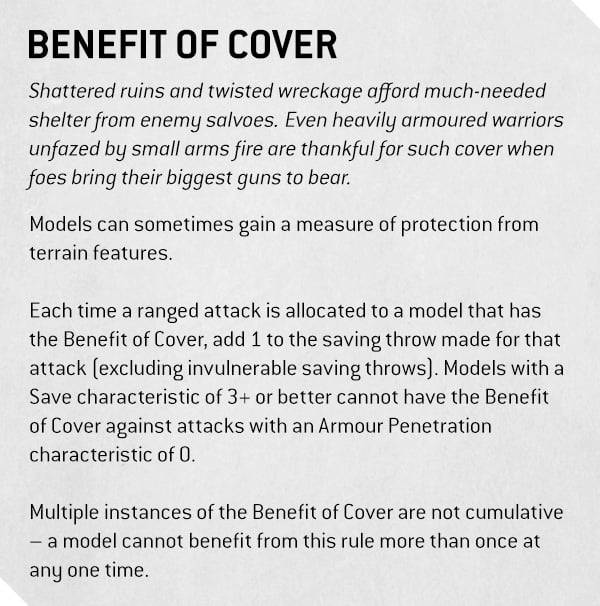
In the current edition of Warhammer 40,000, figuring out how units interact with certain pieces of terrain requires one of four Terrain Categories and a table of 12 different Terrain Traits, with typical areas having anywhere from one to six features to keep track of.** The new edition slims that down significantly, with rules entirely determined by the kind of terrain you are using.
Now, deciding whether or not a unit has the Benefit of Cover is as simple as knowing which category their cover falls into – craters, barricades, debris, hills, woods, or ruins.
Craters – This category includes other small patches of terrain such as rubble. It’s the most simple type and functions like the area terrain of previous editions, granting cover to any INFANTRY model standing wholly inside them. Even if the models are fully visible to the attacker targeting them, they get the cover.
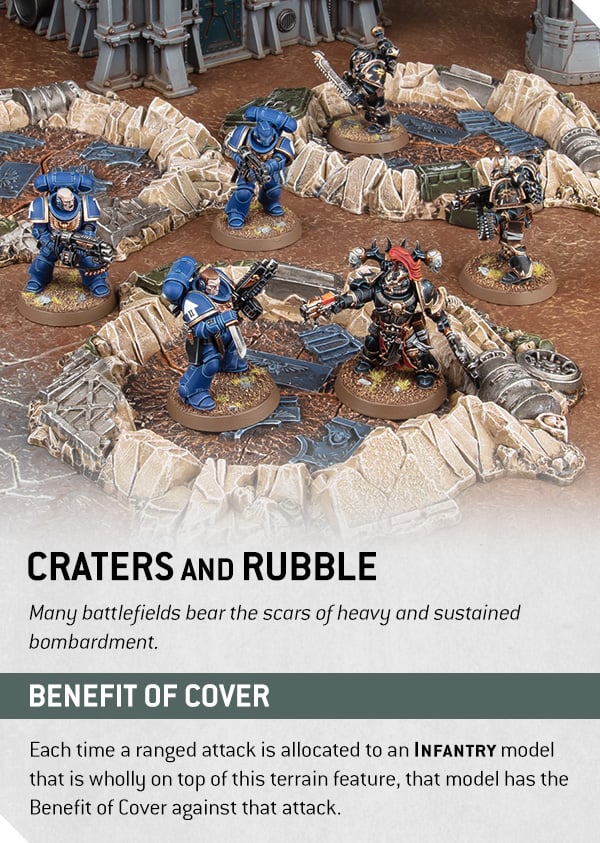
Barricades – All sorts of terrain are classed as Barricades, from promethium pipelines to ramshackle defence lines, and any model within 3” can claim cover so long as the object partially obscures them from at least one of their attackers. As the thickness of a barricade can often make it difficult to get within 1” of an enemy unit when charging from the opposite side, this terrain type also modifies the Engagement Range rules to include models within 2”, providing they’re attacking a unit on the other side of the barricade.
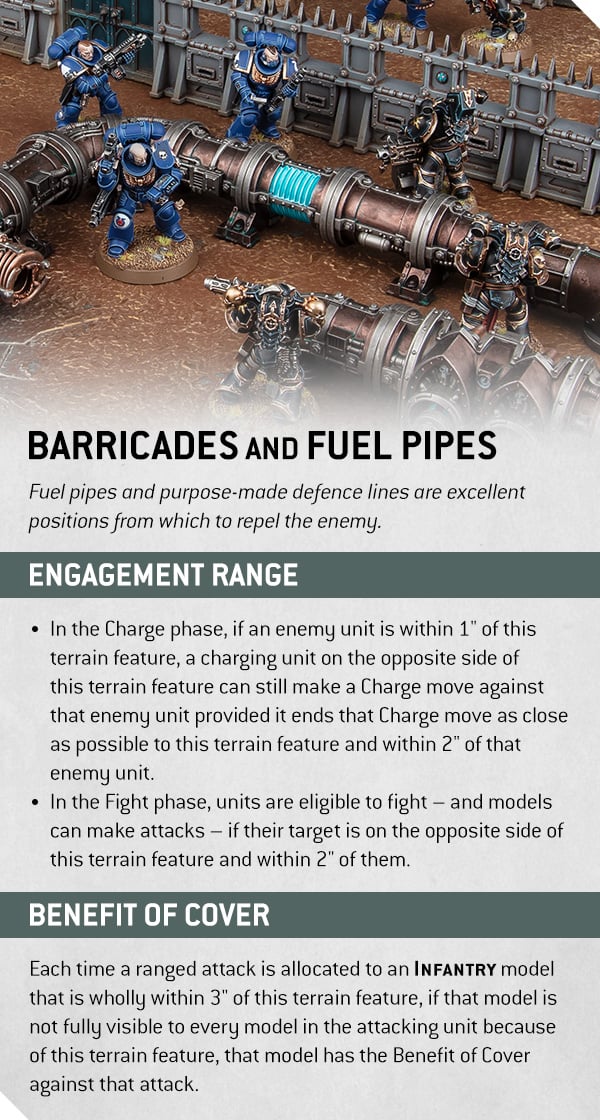
Debris – This terrain includes any bits and pieces that a unit can’t end their move on, such as barrels, statues, and piles of discarded Mek Workshop parts. These confer cover when they partially block a model from the attacking unit, regardless of range or size.

Hills – The Hills terrain type also encompasses solid buildings that units can stand on, like the Battlezone: Fronteris Landing Pad or Munitorum Armoured Containers. Both models and other terrain features can sit on top of hills provided they don’t overhang the edge and, like debris, the hill confers cover to anything it partially obscures. This often results in some dicey close-range firefights, as the edge of the hill itself gets in the way of units shooting up and down at each other.
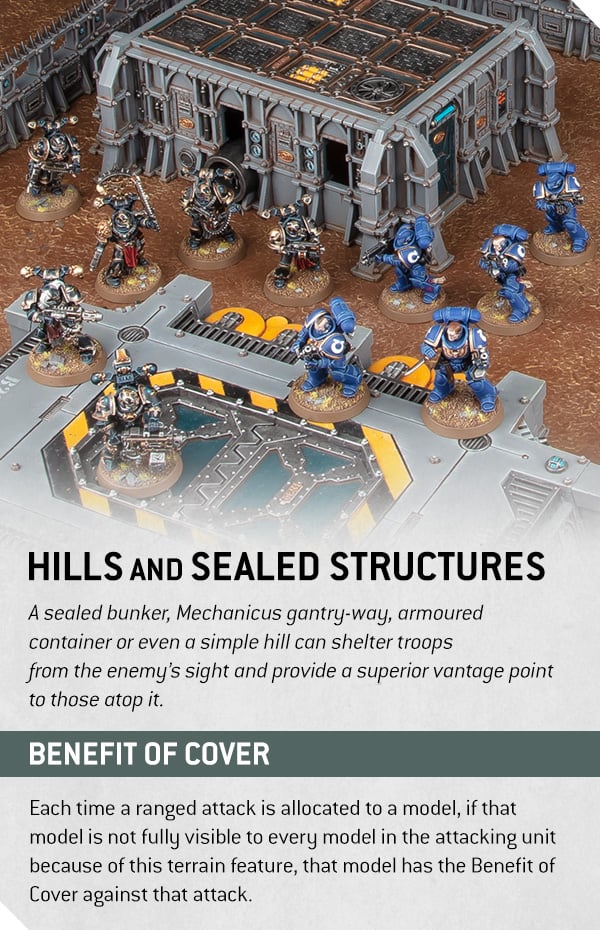
Woods – Woods and forests are a little more involved than the rest. Any model*** fully inside the wood, or viewed through an area of woodland terrain by a unit that is also not inside it, is never considered to be fully visible and receives the Benefit of Cover.
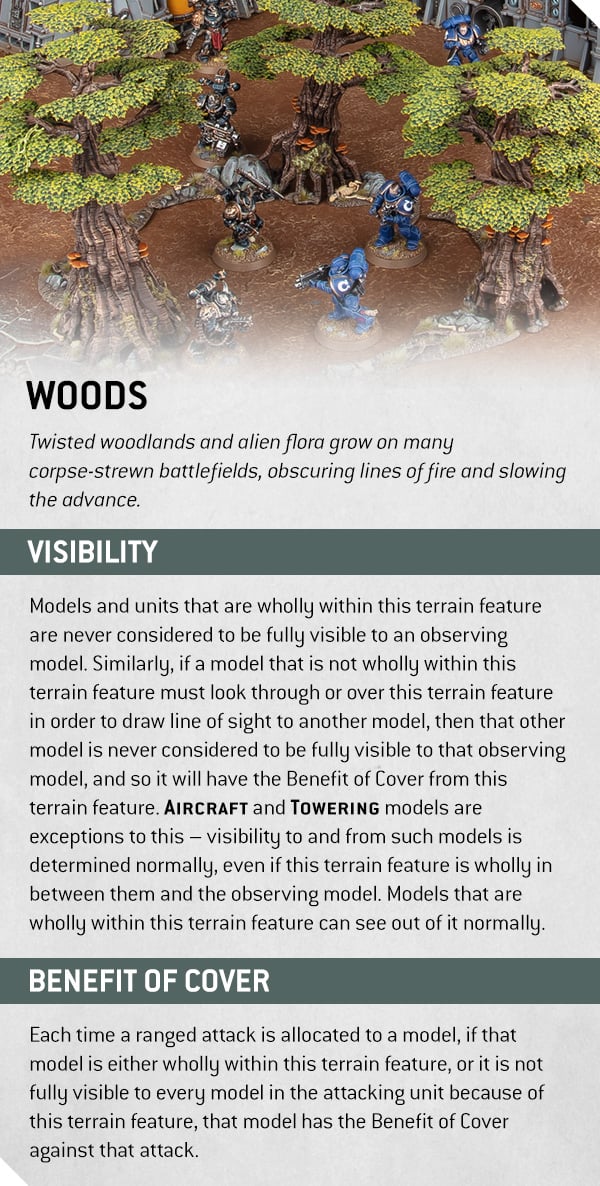
Ruins – These wrecked and damaged structures completely block visibility of all models*** through their footprint, regardless of how much you can see through their fancy gothic windows. Otherwise, models outside can shoot in, and models inside can shoot out.
Since particularly tall ruins can give attackers an advantageous position, they also come with the Plunging Fire rule, which improves the Armour Penetration characteristic of a ranged attack by 1 when the attacking model is more than 6” above ground level and shooting at a target on the ground – making it a great way to get around other units’ cover.
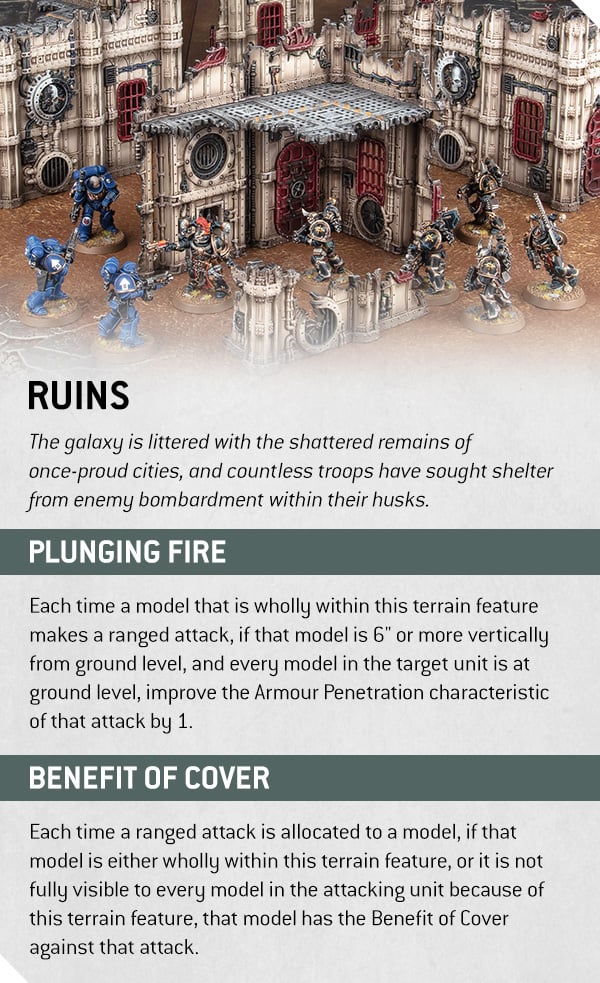
In the past, only certain units were allowed to bundle out of a transport on the same turn it had moved, presumably due to the strict health and safety regulation at this point in history. But with the galaxy tumbling into turmoil, these concerns have fallen by the wayside.
Now any embarked unit is free to hop out once a transport has moved – provided the vehicle didn’t Advance or Fall Back. They can also shoot, but can’t make a charge, unless they disembark before the vehicle moves.
This is a major improvement for mechanised armies that love to leap from their vehicles and blaze away at close range, like the T’au, Astra Militarum, Aeldari, and power armour-clad warriors of all varieties. You still can’t embark and disembark on the same turn, but you don’t need to keep your engine running for a turn before the doors open – which, coupled with their newfound durability, makes fielding transports more appealing than ever.
In the past, certain open-topped vehicles allowed the troops inside to fire out, and this has now been consolidated into a universal Firing Deck X rule. Just choose one weapon each from a given number of embarked models – such as a plasma gun and meltagun from some Cadian Shock Troops riding in a Chimera with Firing Deck 2 – and the transport will count as if it’s equipped with them for their own shooting attacks.
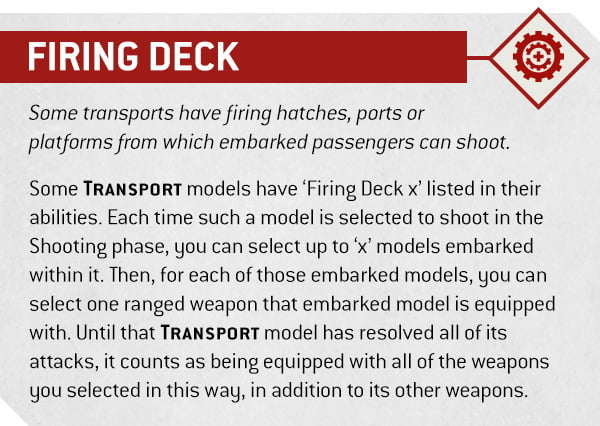
Previously, embarked troops couldn’t benefit from buffs, but now because the transport itself is making the attack, their weapons gain any boosts the vehicle does. For instance, an Ork Mek can use his Mekaniak ability to act as a powerful force multiplier for the Battlewagon’s monstrous Firing Deck 22.
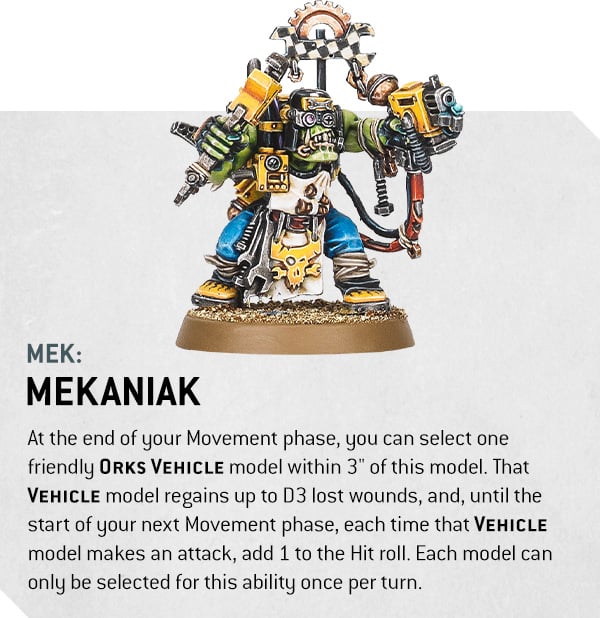
Some vehicles, however, circumvent the rules entirely with special abilities, such as fast movers like the Impulsor and the Astra Militarum Taurox who can disembark troops even after advancing.
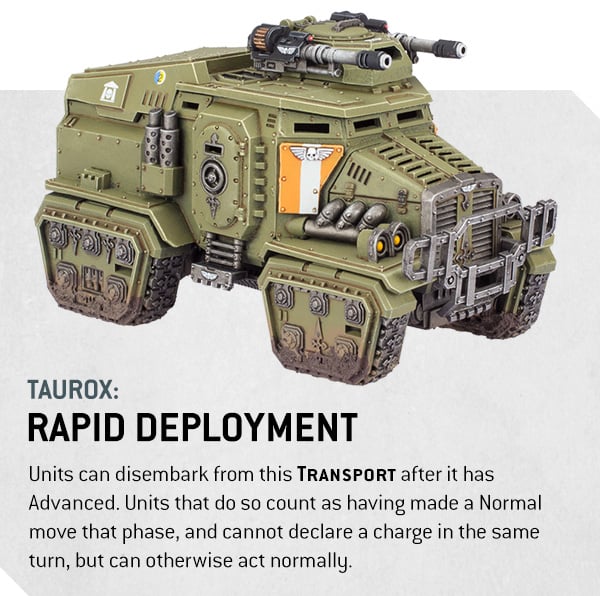
The Land Raider reclaims its Assault Ramp – meaning passengers can declare a charge on the same turn they disembark. If this sounds like a return to the glory days of delivering Terminators hot and fresh into headlong assaults, you’d be right, but it’s not the only Space Marine transport with newfound flexibility.
Minus a couple of exceptions,* Space Marine transports no longer care whether a Primaris unit is riding in the back or not.
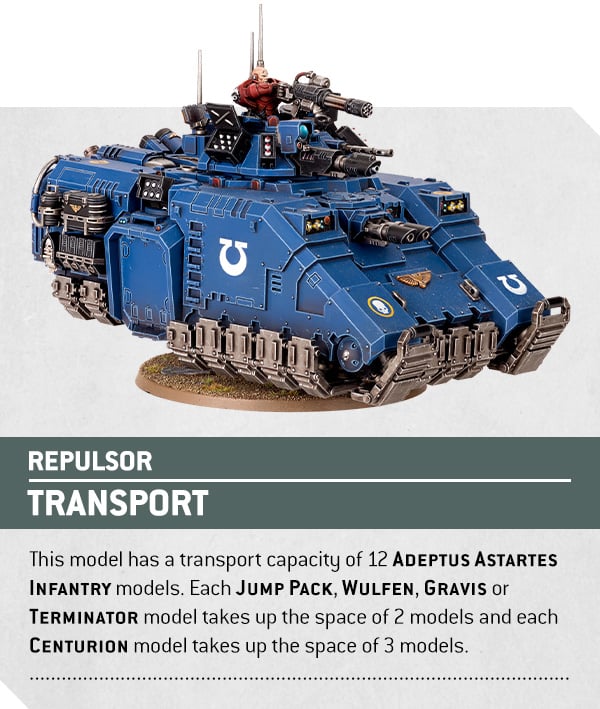
Many other transports get a new lease on life with characterful rules of their own. The Chimera is often used as a command post by Astra Militarum officers, so now they can bark orders from (relative) safety with the Mobile Command Vehicle rule.
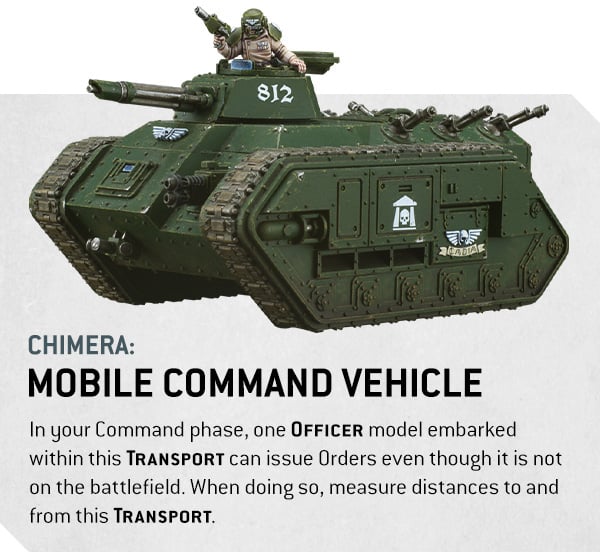
The Falcon grav tank, meanwhile, lends supporting fire to its disembarked passengers by picking out priority targets with its own guns. The freshly deployed Aeldari then get to reroll wound rolls against that same unit, giving the Craftworlds a fast one-two punch of overwhelming firepower or lethal bladework that really fits purpose as the premier aspect -warrior delivery system.
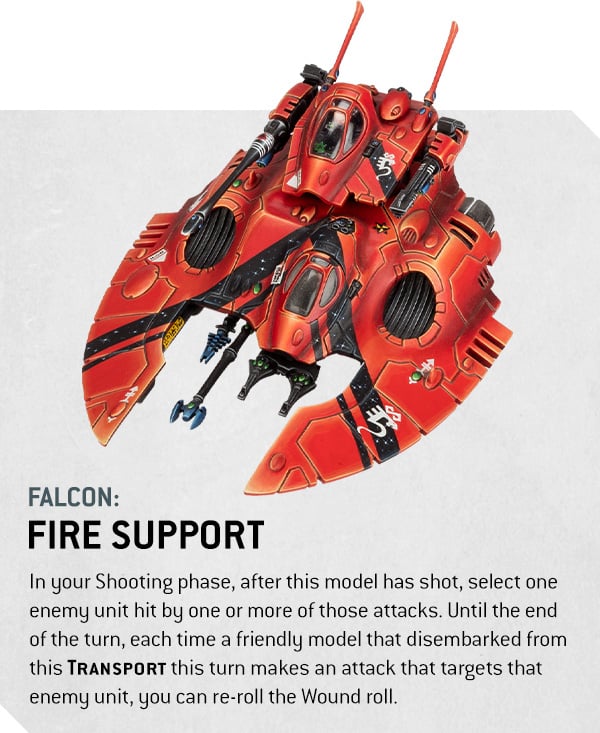
The turn structure is still the same: one player still takes the first turn, to maneuver and fight with all the forces at their disposal, and then the second player does the same. This is still called the Battle Round, but seven phases have now become five – and both players will now contest each one to the fullest.
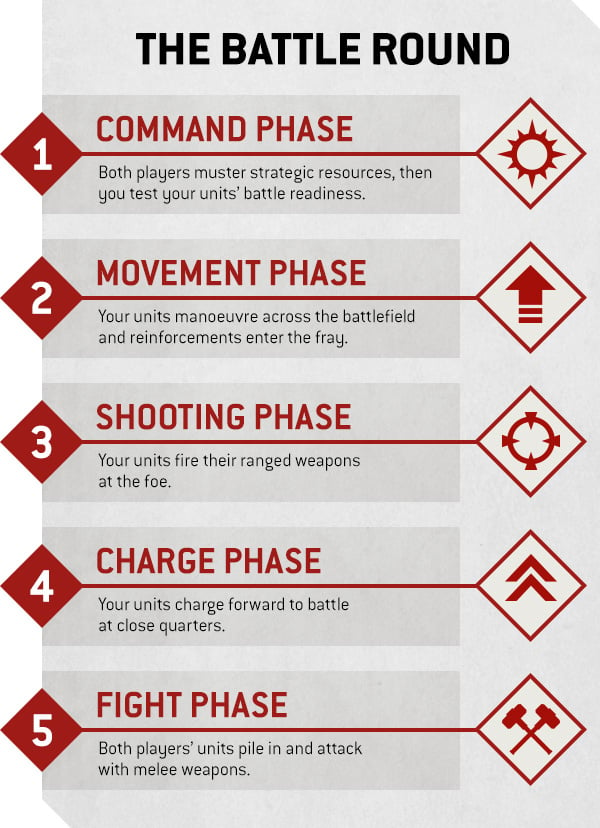
Here’s the headline: the phase structure is broadly the same. You perform admin for the turn ahead in the Command phase. Then you manoeuvre in the Movement phase, take aim in the Shooting phase, charge into melee in the Charge phase, and get biffing in the Fight phase.
So what’s changed? The Psychic phase and the Morale Phase are now no more – but this doesn’t mean that psychic powers and morale are gone. The effects are still very much present, but they’ve been smartly compressed into the other phases. Let’s break it down.
The Psychic Phase
For some players – the likes of the Thousand Sons, Grey Knights, and Aeldari – the old-style Psychic phase was a technicolour carnival of empyrean delights. For others – especially the T’au Empire and Necrons – it was often 10 minutes spent watching your opponent make a bunch of mysterious 2D6 rolls and remove models accordingly.
This was often un-fun and awkward to play around, so now psychic powers are used throughout the other phases, instead. Peering into the future for tactical insights? That’s an ability for the Command phase. Paralysing foes with hypnosis? You’ll do that in the Fight phase. Tossing around eldritch lightning? That’s a ranged attack, used in the Shooting phase alongside any regular guns you may be carrying.
The new Terminator Librarian, for instance, unleashes his Smite in the Shooting phase. Each time he does so, you can choose to manifest either a controlled mental burst, or a recklessly powerful psychic onslaught that may backfire thanks to the Hazardous weapon ability.*
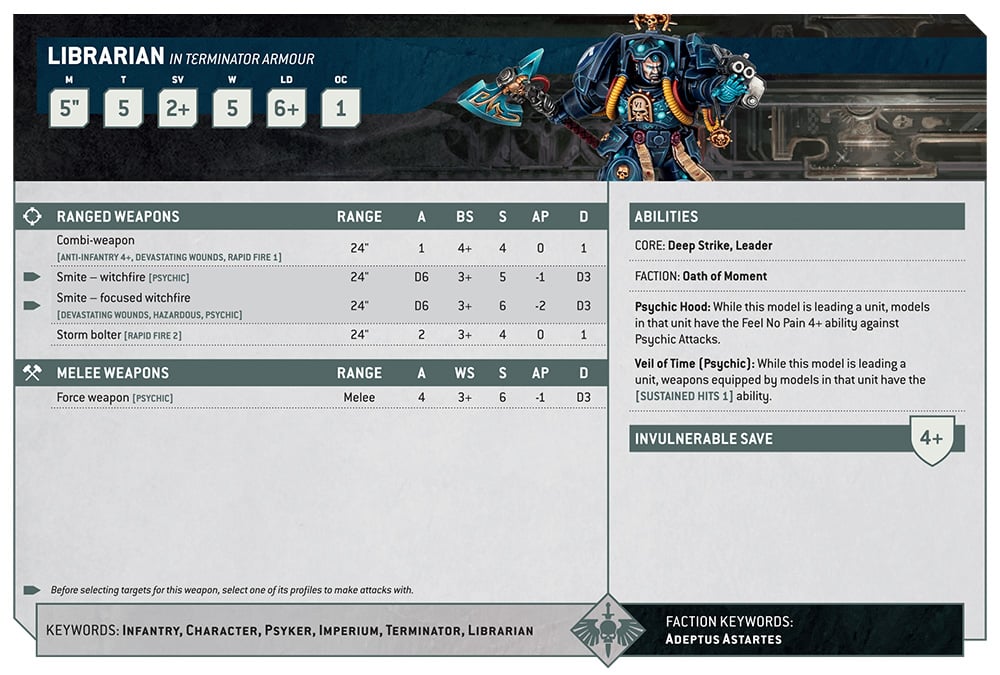
Psykers are more than just brain-based artillery, however – he also boosts any Terminator Squad he’s leading, twisting the Veil of Time to grant their attacks the Sustained Hits ability. Each Space Marine Librarian brings their own flavour of psychic chicanery to battle.
The Ork Weirdboy, on the other hand, can’t be bothered with anything so quotidian as a gun, but his ‘Eadbanger shooting attack grows in power and volatility according to how many Boyz he has in his entourage.
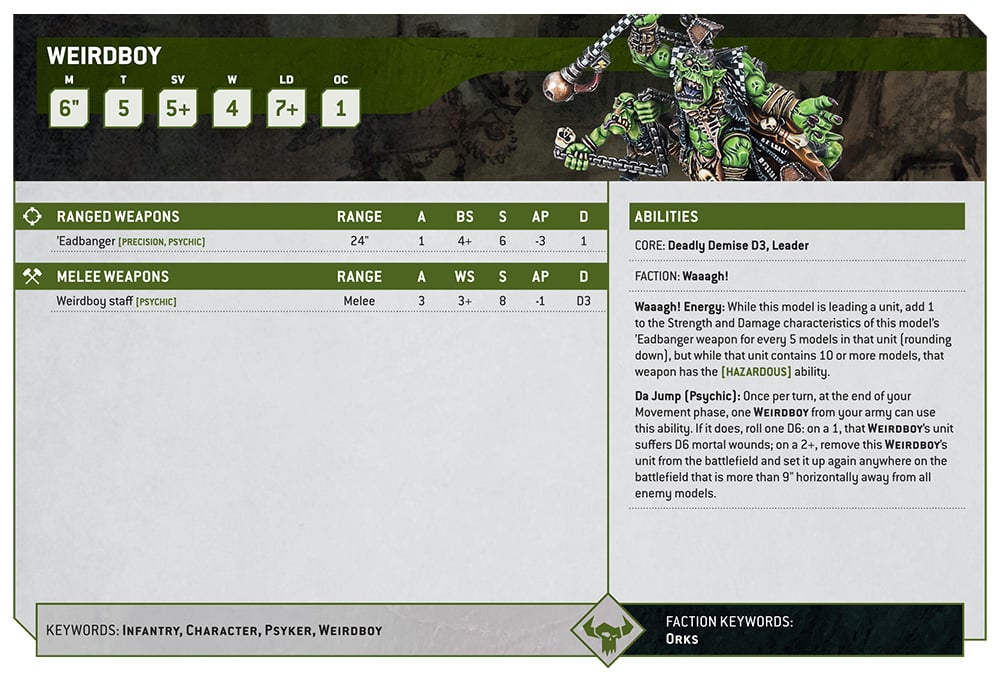
His Da Jump power fires at the end of the Movement Phase, allowing you to teleport his ladz somewhere more deadly – assuming his brain doesn’t explode from the stress…
The Morale Phase
Morale is even simpler – that all gets sorted in your Command Phase, when you take Battle-shock tests for any units that have taken enough losses.
Battle-shock tests are super simple. Roll a 2D6 for every unit that’s Below Half-strength – that means they’re a squad with less than half of their starting models, or a single model with less than half of their starting Wounds. You’ll need to roll equal to or above your new Leadership characteristic – if you fail, that unit suffers some nasty penalties until your next turn.
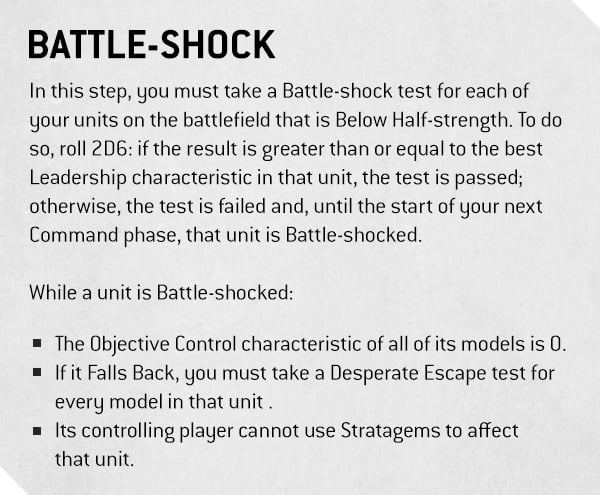
With this change, morale is no longer just a casualty multiplier. Like psychic powers, Battle-shock now impacts every other phase of the game, shaping how you use your units and rewarding players who can keep their army in fighting order.
From transports to terrain rules, there’s loads more to see in the new edition – so stay tuned to Warhammer Community across the coming weeks, and head over to our hub page to find all of the information revealed so far.
Up until now, your guns were divided into several categories: Heavy, Rapid Fire, Assault, and so on. In the new edition, these classifications become weapon abilities.
This change allows weapons to behave in more varied ways than before, without increasing the number of rules you need to learn. A bolt rifle has both the Assault and Heavy abilities, for instance – meaning it can be fired on the move or braced for extra accuracy, as needed.
This flexibility is perfect for representing auto and stalker bolt rifles, which are now streamlined into the same weapon profile. All Intercessors just have bolt rifles, which you can build with whatever scopes or magazines you please.

The core rules include a variety of other weapon abilities, which tie together similar effects found across factions. Weapons that shredded through armour on lucky rolls can now share the Devastating Wounds ability instead. This allows them to dish out mortal wounds on a Critical Wound – that’s an unmodified Wound roll of 6.
Even the new Terminator Squad’s assault cannon is getting in on the action!*

Almost all weapons have had their core statistics changed to help pull their weight in this new, more durable edition – especially those designed to tackle vehicles. You’ll generally find that most guns have not increased in strength, and have often lost a pip of AP.
What this means in practice, is that small arms and unit special weapons will still do work against enemy infantry, but you’ll really want to include some dedicated anti-tank to tackle enemy armour – the age of “plasma kills everything” is over.
The melta rifle, for example, gains a bump in Strength and the Melta rule to boost its Damage at short range, while the Hammerhead’s infamous railgun soars to Strength 20.**
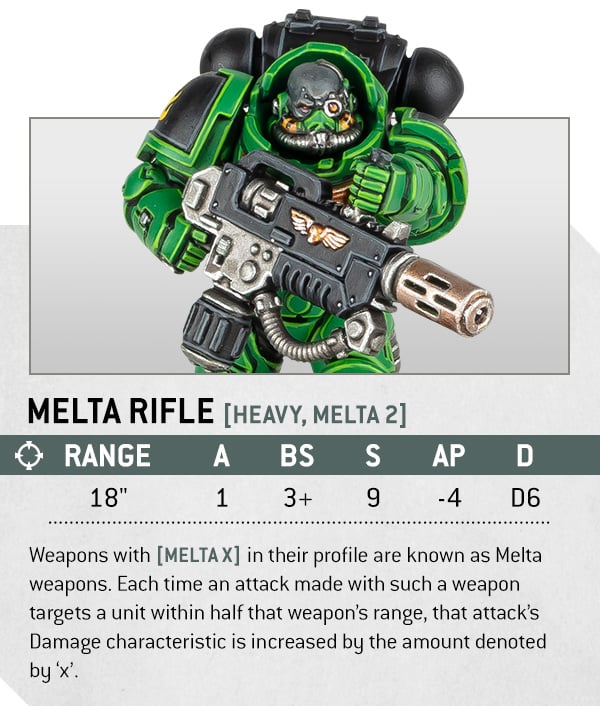
The shuriken cannon picks up Sustained Hits, common among weapons that throw massive amounts of firepower down range – and on swarming Tyranid Invasion Fleets. This one simply adds the listed number of extra hits when a Critical Hit is scored – that’s an unmodified Hit roll of 6. Easy to remember.
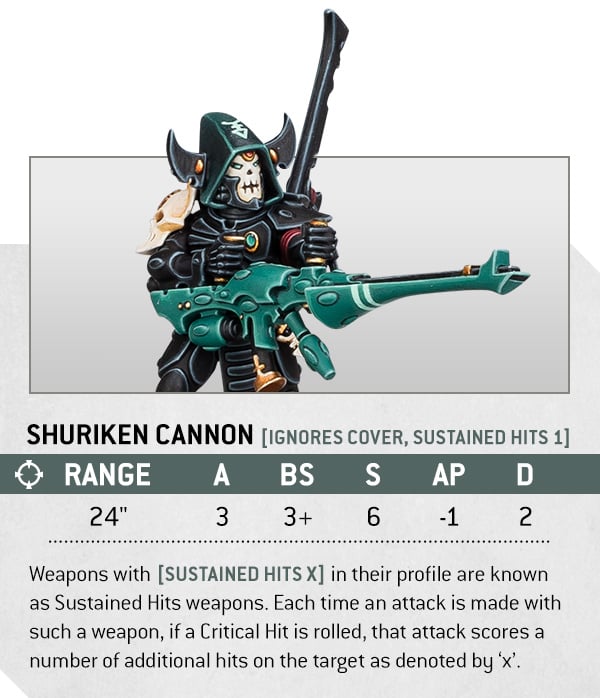
Melee weapons can also have abilities, including a blast from the past – Twin-linked is back! This classic rule is now found on ranged and melee weapons alike, and confers a re-roll to wound. In recent editions, many weapons that used to be twin-linked were instead treated like two guns taped together, which had a serious impact on balance. This change makes them more reliable, rather than twice as killy.

There’s so much more to discover, more than we can possibly fit in an article, so make sure you come back and see even more from the new edition later this month – and check out the hub to see what’s come before. Next up, we answer the age-old question – why shouldn’t Aggressors get to ride in a Land Raider?
Almost every vehicle has received a bump in Toughness. So while Toughness 9 used to be the highest you’d ever see in a game, in the new edition you can find units like the Ork Stompa with toughness as high as 14!*
All the weapons in the game have also been recalibrated to fit into this new scale, and we’ll be talking about those tomorrow.

Coming out of the gate with a Toughness score to match the Titans of old, the reinforced Rhino actually sits towards the bottom end of the pool of hardy Space Marine vehicles. Its new Toughness of 9 leaves it significantly less vulnerable to most infantry-portable weapons, even meltagun blasts.
At the same time, the Rhino receives two core abilities common across many factions – Deadly Demise and Firing Deck. The first of these dictates how many mortal wounds are suffered by nearby units when a vehicle explodes,** while the second shows how many embarked units can shoot from inside a transport. Both rules have previously existed in many different forms, and are now condensed into core abilities for clarity.
You’ll also notice that most Vehicles have an OC (Objective Control) of more than 1, meaning that ramming a depleted enemy infantry squad to muscle them off an objective, is an entirely legitimate tactic!
All of this means there’s now a lot more nuance to individual tanks, and vehicles all carve out a niche in their own factions. Rest assured though, the majority of vehicles (and monsters) are beefier than before.
We’re still not recommending staying out in the open against concentrated railgun fire, but you should find your armoured behemoths make it through more firefights and can form a solid bastion in your army. To prove the point, here are a few more examples from the Space Marine roster.
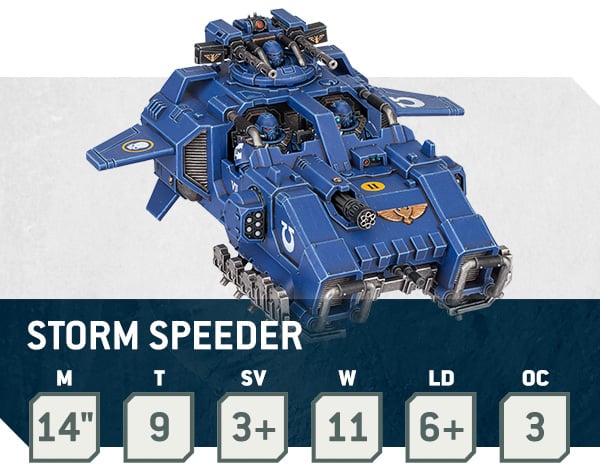

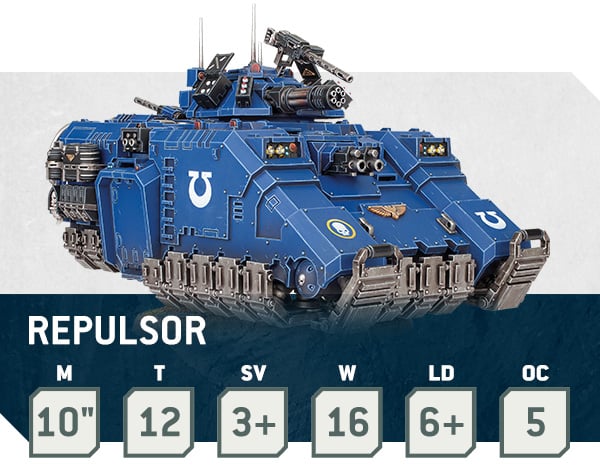
A lot of vehicles used to suffer from characteristics that degraded as they took damage. Most of those now simply suffer a penalty to their hit rolls when reduced to one-third of their starting wounds – leaving big vehicles and monsters in the fight to the last. And many vehicles don’t degrade at all, we intentionally wanted to only keep these when they felt meaningful.
The new edition of Warhammer 40,000 is bringing some pretty massive changes to the rules. One of the most eye-catching is the way that CHARACTERS now interact with their subordinates. The powerful Aura bonuses that they used to impart on all nearby troops are gone – in almost all cases. These effects were powerful, but the potential to stack them up made balancing the game tricky.
So now, rather than handing out re-rolls to anyone in earshot, your heroes now join a single squad and act as one cohesive unit. It’s an elegant system that helps keep over-buffed super-units at bay.
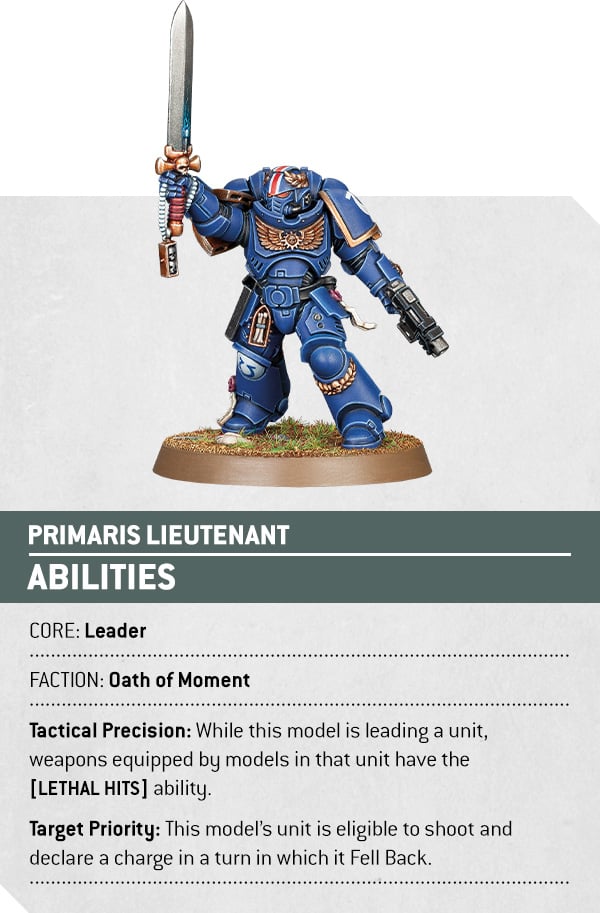
Take this Primaris Lieutenant. The first thing to notice is the Leader ability, which unlocks the ability to join a squad. This is done before deployment, at the same time as transports are allocated and units are placed in Reserve – the Leader becomes a permanent member of that unit for the whole battle.
Each Leader has a short selection of units that they can join, all of them listed on their datasheet. A Primaris Lieutenant can shack up with Intercessors or Bladeguard Veterans but leaves Gravis-armoured Aggressors and Heavy Intercessors to his more appropriately equipped colleagues.
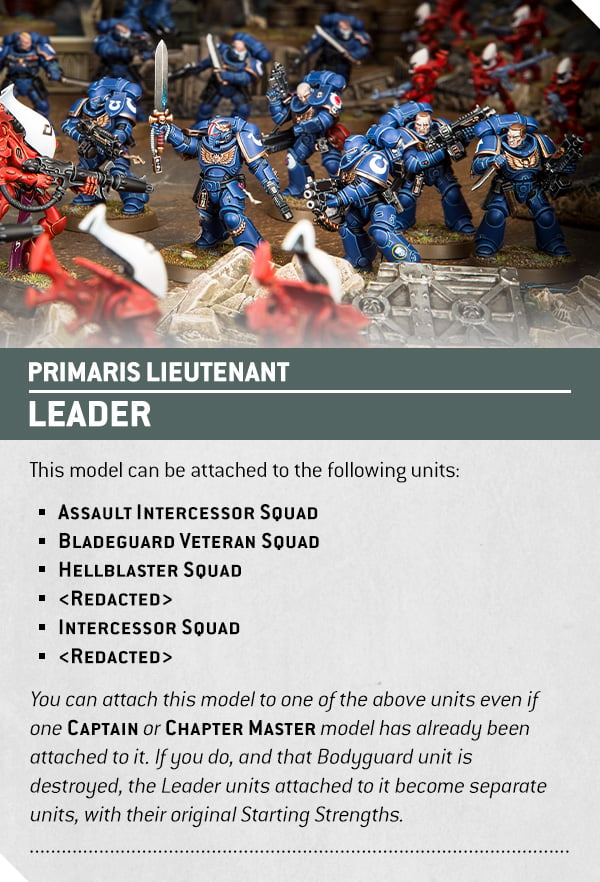
His Tactical Precision ability grants his subordinates Lethal Hits, a core ability that makes Critical Hits – the new term for an unmodified 6 on a Hit roll – automatically wound their target.
Most of the time, only one Leader can join each unit – but as you can see, the Lieutenant is an exception, and can join the same squad as a superior Captain. Plenty of factions have similar low-ranked support Leaders, from Biophagus surgeons to Warlock battle-psykers.
The old Look Out, Sir! rule has also been devolved into this new system. Your Leader is kept safe by their Bodyguards, and can usually* be targeted only when everyone else in the squad has breathed their last.
Not all characters possess the Leader ability, however. Independent sorts may instead have the Lone Operative ability, which means that they can’t be targeted by ranged attacks unless the attacker is within 12?. This potent defensive trait is common among the stealthier specialists of the 41st Millennium, such as Vindicare Assassins or Commander Shadowsun.
Some characters only gain the Lone Operative ability when taking shelter near an appropriate unit – such as when Iron Father Feirros is working on an allied VEHICLE, or Lion El’Jonson is near a unit of ADEPTUS ASTARTES INFANTRY. Such heroes tend to benefit their comrades without Leading them, perhaps through Aura abilities that boost nearby allies.
The Index Cards released at the dawn of the new edition will each come with one Detachment, representing a common fighting style for a particular faction, and more will emerge as new Codexes arrive and armies expand. There is one golden rule: every Detachment must fit onto a single double-page spread. This means you’ll never need to go leafing through an armful of rulebooks to find that key Stratagem – you’ll have your core rules, your datasheets, and two pages of unique rules, and you’re good to go!
On top of this, every faction gets an army ability regardless of which Detachment you’re using. This represents the totemic aspect of that faction in war – so the Orks get Waaagh!, Tyranids get Synapse, the Astra Militarum get Orders, and the Space Marines get Oath of Moment.
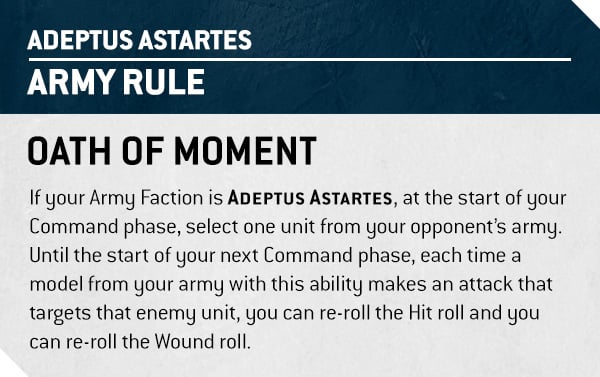
Re-rolls are significantly less common in the new edition, so the ability to single out one target per round for complete annihilation reinforces the Space Marines’ reputation for disciplined, targeted hammerstrikes.
Exploring Detachments
The Tyranids begin their adventures in the new edition as an Invasion Fleet, focused on swift evolution and overwhelming offence. The Invasion Fleet’s Detachment rule is Hyper-adaptations, which provides three different abilities you can choose from each battle, depending on what you’re fighting.
Swarming Instincts adds the Sustained Hits 1 ability to your attacks against INFANTRY and SWARMS, landing an extra blow whenever you score a Critical Hit – that’s the new term for rolling an unmodified 6 on your Hit roll. This will be your go-to adaptation to handle an enemy horde or a stoic wall of elite infantry.
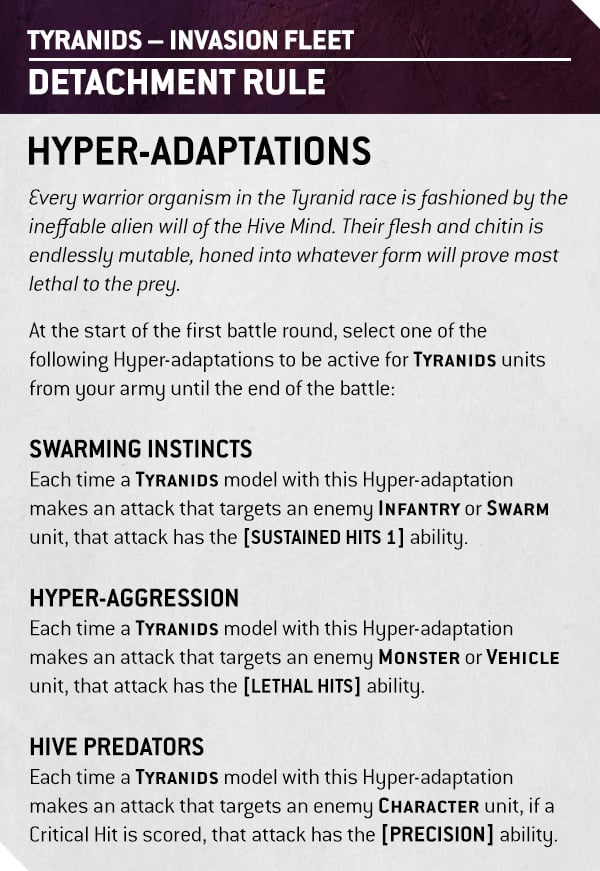
If your targets are tough VEHICLES and MONSTERS, you can instead pick Hyper-aggression and add Lethal Hits to your attacks against them – meaning you’ll automatically wound on a Critical Hit. Adapt and overcome!
For their army ability, the Tyranids can manipulate Battle-shock tests with Synapse and Shadow in the Warp – but we’ll find out what those do when we have a closer look at the Tyranid faction next month.
Stratagems and Enhancements
Stratagems and Enhancements are also now part of your Detachment. In the previous edition, many players found it difficult to juggle and remember two or three dozen Stratagems. Those days are gone – no Detachment will contain more than six Stratagems. Add that to a robust universal menu of 12 Core Stratagems, and there’s now simply less to keep track of.*
Armour of Contempt returns as a Stratagem for the Gladius Task Force, the first Space Marine Detachment.
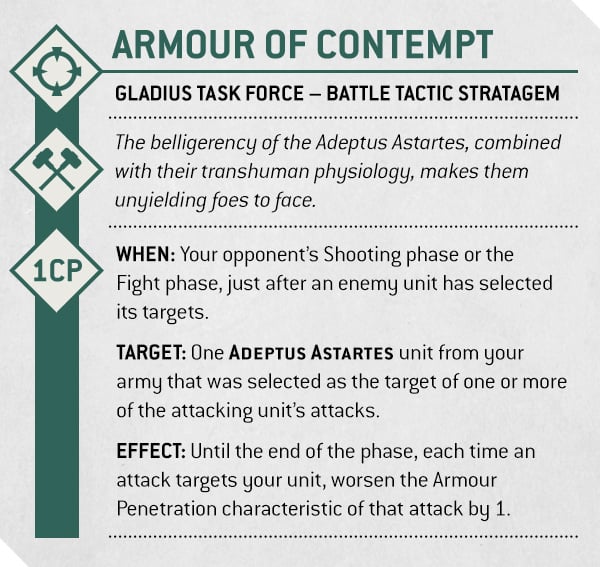
Enhancements replace the old Relics and Warlord Traits, offering a unified list of unique upgrades for each Detachment. Unlike Stratagems, there are no Core Enhancements – each one is tied to a specific Detachment for a specific faction, tailored to your roster and abilities. These include refined personal wargear like Artificer Armour, or tactical talents that allow a commander to enhance the unit they’re leading.
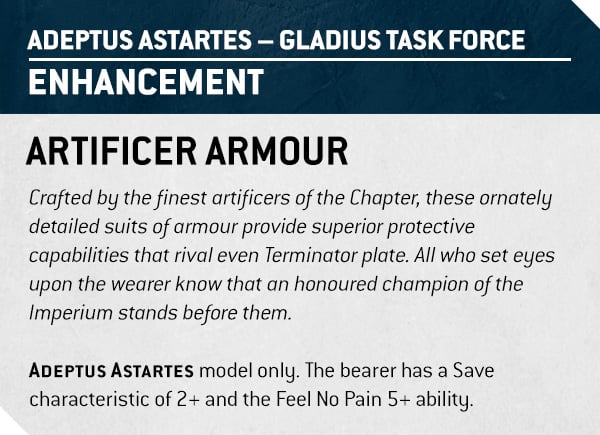
In case you missed it, unit datasheets have had a major transformation. All armies will be getting a pack of datasheet cards* to revamp their units when the new edition launches, and it’s time to look at another of these datasheets: the Terminator Squad.

Yep. There’s a lot to unpack.
Characteristics
One of the core design goals of the new edition of Warhammer 40,000 is to make notably tough units tougher, and allow them to withstand punishment befitting their reputation. Terminators, for instance, retain their iconic 2+ Save but get an increased Toughness of 5 and a 4+ Invulnerable Save right out of the gate, boosting their resistance to massed low-strength weapons and armour-piercing cannons alike.
Their Leadership score of 6+ is also excellent in the new edition – on par with most Characters – though with an Objective Control score of just 1, they’ll need some help from Intercessors to hold down the fort.
These vaunted 1st Company veterans are a tough nut to crack and, as we’re about to see, they will be dishing out the hurt to match.
Weapons
Storm bolters and power fists go together like cheese and wine. The former has a new-look Rapid Fire weapon ability that gives you extra shots within half range – so with Rapid Fire 2 on top of the weapons base Attacks value of 2, they can still fire four times within 12”.
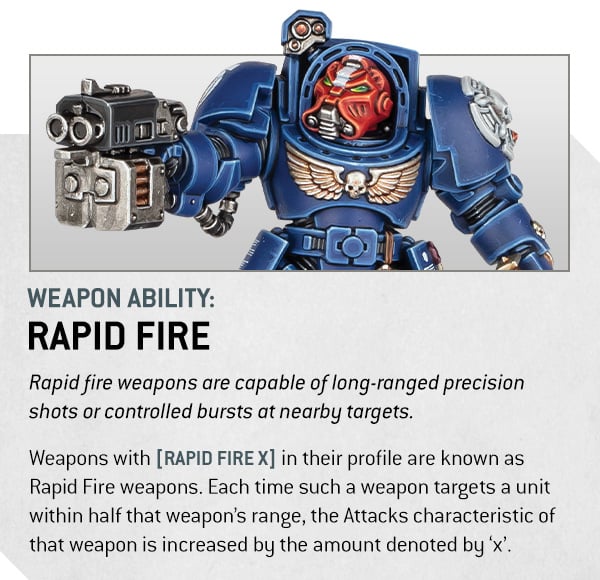
Power fists are a little more spicy. They’re less unwieldy now, hitting on 3+, while chainfists shred armour with the new Anti-Vehicle 3+ ability.
Anti abilities – covering many different keywords like Infantry, Monster, and Vehicle – produce a Critical Wound** on any wound roll that matches or beats the specified score, regardless of the target’s Toughness. This makes for specialised weapons that excel in their field, but don’t stay equally deadly against other target types.

Several other Terminator weapons have their own abilities, like Devastating Wounds on the assault cannon, and we’ll be covering these at a later date.
Abilities
Almost every datasheet in the game has its own special ability – many of which used to be Stratagems. Teleport Homer makes use of the new Rapid Ingress core stratagem to Deep Strike*** in your opponent’s turn.

Fury of the First, meanwhile, makes Terminators especially effective at destroying the target of the Oath of Moment – the Space Marine faction ability. We’ll find out what this does tomorrow, when we take our first look at faction rules.
There are sweeping rules changes afoot in the new edition of Warhammer 40,000, and one focus for change is on that cornerstone of every unit in the game – the datasheet. A lot has changed this time around, and in light of the fact that codexes are getting a complete reset in the new edition,* it’s time to look at how your units will appear.
Take a peek at the new-look Space Marine Intercessor.

You probably have questions. Where are Weapon Skill and Ballistic Skill? Do units still have Strength or make Attacks? And what in the world does OC mean?
What is OC?
Objective Control – or OC – is a measure of how well a unit can secure critical locations. It’s an elegant means of clarifying a previously complex aspect of the game. Now each model has an OC characteristic, and to determine who controls an objective, you simply count up the total OC of all models within range. This small but impactful change breathes new life into basic troops – taking and holding ground is a newfound specialty and a clear key to victory.
Warriors that were previously categorized as Troops will generally have a higher OC than elite units – whose job is not to hold ground, but to strike and move on. Vehicles and Monsters also earn a more substantial OC, so Knights and the like can muscle smaller units off objectives.
How does Leadership work?
Leadership is much more impactful in the new edition. Your units’ morale is now gauged with a Battle-shock test. Many factors can force a unit to test for Battle-shock, including being below Half-strength during the Command Phase. Fail and they struggle to capture objectives, use Stratagems, or Fall Back from combat.
You’ll also notice that Leadership now counts upwards. Our Intercessor has LD 6+ – which is equivalent to his old value of 8.
What’s happened to WS, BS, S, and A?
Offensive characteristics are still very much in the game – but they now live on weapon profiles, to help keep datasheets clear and easy to read. So in that case, how do weapons now work?
Weapon profiles explained
Everything you need to take a shot or a swing at your enemies is now contained in an individual weapon profile – everything from Attacks to Weapon Skill to Damage is all in one place. This means that weapons like power fists, which used to need text to explain that they made things harder to hit, now have their own hit roll statistic.
Moreover, weapon profiles are tied to individual units – so a chainsword in the hands of a Space Marine is deadlier and easier to hit with than one held by a sniveling cultist.


The fundamental interactions haven’t changed – equal Strength and Toughness still means you wound on a roll of 4+, and so forth. It’s just that all of a weapon’s quirks are contained in its Core Abilities.
Many different effects are covered by Core Abilities, from classic weapon types like Assault and Rapid Fire to auto-hits from flame weapons. We’ll go into weapon rules more in an upcoming article.
All that changes in the upcoming new edition, which takes the same basic ruleset you’re familiar with and just… makes it simpler without dumbing it down. But what does this mean in practice? The High Lords of the Warhammer Design Studio are here to explain.
While we can’t say too much at the moment, there are some things that we can certainly clear up right now.
Is this a totally new edition?
Let’s get this out of the way from the off – the new 10th edition of Warhammer 40,000 is a complete revision of the game you know and love.
Every single element of the game has been revised and rewritten from the ground up for an entirely new, and more cohesive, experience. Plenty of rules remain the same – but there is not a single one that has not been reassessed and, if necessary, rewritten to work perfectly in the new system.
This is genuinely a whole new world of Warhammer!
Will it be quicker and easier to play?
We’ve listened to your feedback and have taken on board all the suggestions we’ve received since the launch of 9th edition. One thing that repeatedly came up was the number of different books you currently need to reference while playing. Thankfully, the days of flicking through multiple books to find the one rule you need are now over! Datasheet Cards for your faction now contain all the information you need to play the game at your fingertips.
One core design philosophy has governed all of the changes: “simplified, not simple”. All the rules for your army are now contained exclusively on a single double-page spread, there are also far fewer Stratagems, relics, and special rules to keep track of. Universal special rules are back in the game – It doesn’t matter if you’re making a Dimensional Translocation or preparing Death From Below, it’s all a Deep Strike now!
Core Stratagems are also much more reactive in the new edition. This means there’s less waiting around during your opponent’s turn and plenty more opportunities to attack and defend, even while your opponent is making their moves.
How easy is it to get into the game?
We know that not everyone has a full evening to spare playing one game – or has a 2,000-point army ready to rock – which is why we’re introducing the Combat Patrol format.
You and your friends can each grab any one Combat Patrol box, download a set of rules that balances your chosen force against any other Combat Patrol box, and you’ll have enough to play a quick, satisfying game against each other straight away.
It’s a game mode designed to allow new players to get started right with any faction in the game, or for experienced players who want to try a new force without feeling they have to get a huge army.
How are Combat Patrols balanced?
Combat Patrol is the new mode for Warhammer 40,000. It pits the contents of one Combat Patrol box against another and it’s a fantastic way to begin playing. How have the Warhammer Design Studio managed to balance different boxes aggainst each other? With great ingenuity – this really is a silky smooth way to dip your toes into the 41st Millennium. We’ll have a lot more on this new way to play in coming articles, including a deeper explanation of how balance is achieved among such disparate forces.
Will my collection and codexes be compatible?
Your miniatures aren’t going anywhere, and we’ll have plenty more to say about what codexes will look like early next week. Rest assured you won’t be wanting for options in the new edition.
Are Universal Special Rules returning?
The short answer is yes! Ultimately the Warhammer Design Studio decided that having the same special rule under a dozen or more separate faction names had become a bit of a barrier to the smooth running of the game – not least because many players simply referred to them by a single name anyway, such as Deep Strike and Feel No Pain.
Do Vehicle and Monster profiles still degrade as they take damage?
More or less, though the mechanic has been streamlined. Instead of three separate profiles, there’s a single line on each unit card that still acts like this and explains any penalties incurred when a certain Wounds threshold is reached. More on this soon.
What is the OC stat?
OC stands for Objective Control, and it’s a measure of how good a unit is at holding a contested objective. The
Yes! A totally new edition of the world’s biggest tabletop wargame is here. That means amazing new models, awesome new rules, and big changes to the galaxy of the 41st Millennium.
Check out this incredible new cinematic trailer to see the fresh horrors that have emerged to destroy the galaxy.
The Lore
Were you foolish enough to believe that Hive Fleet Leviathan had been beaten for good at Baal? That was just the vanguard. Now the rest have arrived – and they’ve evolved.
The Imperium, reeling from multiple existential conflicts on too many fronts, is exposed – and its main forces are on the wrong side of the galaxy. Leviathan, previously thought humbled, is only just getting started.
The largest hive fleet in history has emerged, swarming across the galactic west, laying waste to hundreds of worlds unable to muster a meaningful defence in the face of this living apocalypse.
Without the full weight of the war machine to call upon, Imperial commanders dispatch elite strike teams in a desperate bid to stem this endless tide of Tyranids. Taking out the synapse leaders will buy precious time for the lumbering might of mankind’s war machine to mobilise.
And elite for a Space Marine Chapter means the First Company. Terminators are back!
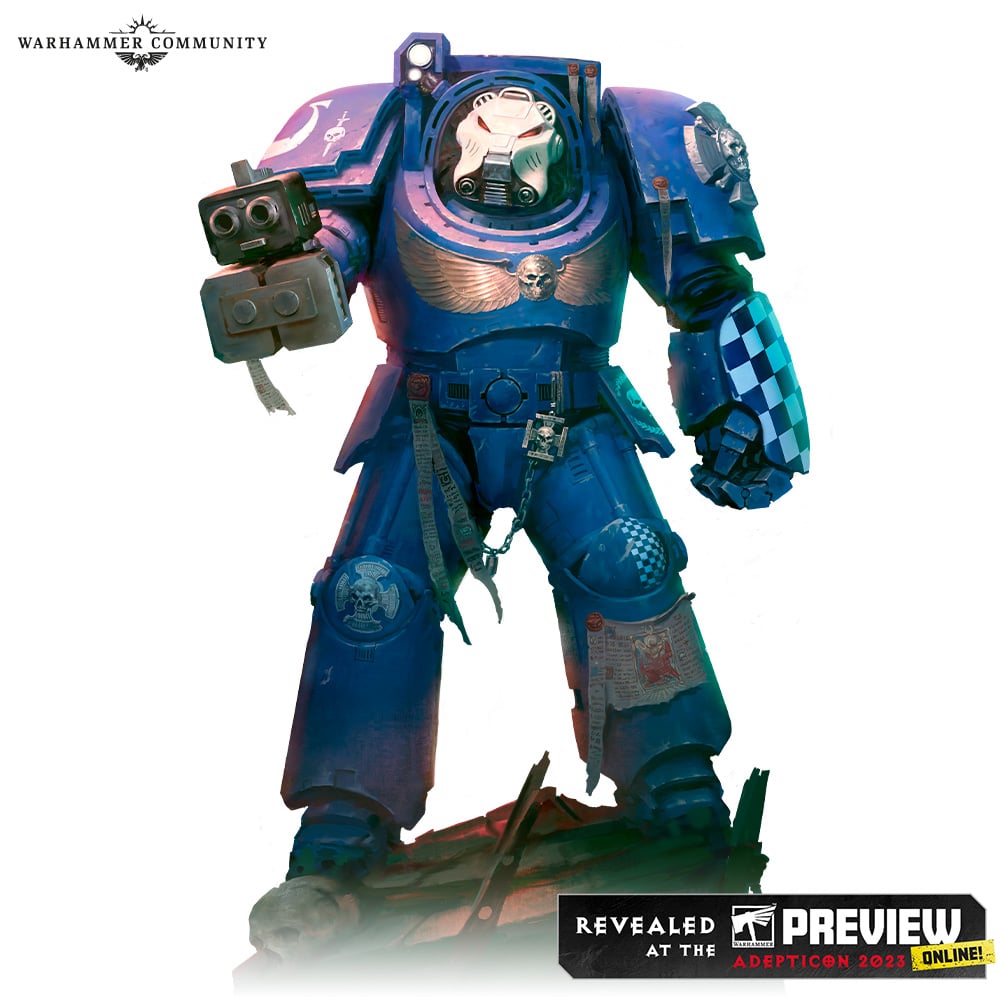
These aren’t Primaris Terminators. Not even Belisarius Cawl is able to improve upon this ancient and holy armour pattern. Any Space Marine Veteran can earn the right to don a sacred suit of Tactical Dreadnought armour, so veterans of the Tyrannic Wars and the Indomitus Crusade alike are clad in these suits of revered ceremite.
The Models
You’d better believe there’ll be new models – there’s a massive new launch set on the way – and we might be biased, but we think it’s the best Warhammer box ever.
Take this absolute unit, for instance:
Leading the assault are the much-improved new Space Marine Terminators. These juggernauts of death have been rescaled and resculpted to look as imposing as the lore demands. If Tyranids could feel fear… they would fear these guys.

This new edition also heralds the biggest refresh and update to the Tyranid army, ever! The Hive Mind has been busy, and alongside familiar monsters getting impressive new sculpts, you can also look forward to some ungodly new abominations.
What would a Tyranid army be without its swarm of lesser creatures though? Even the humble Termagant is getting quite the glow-up:
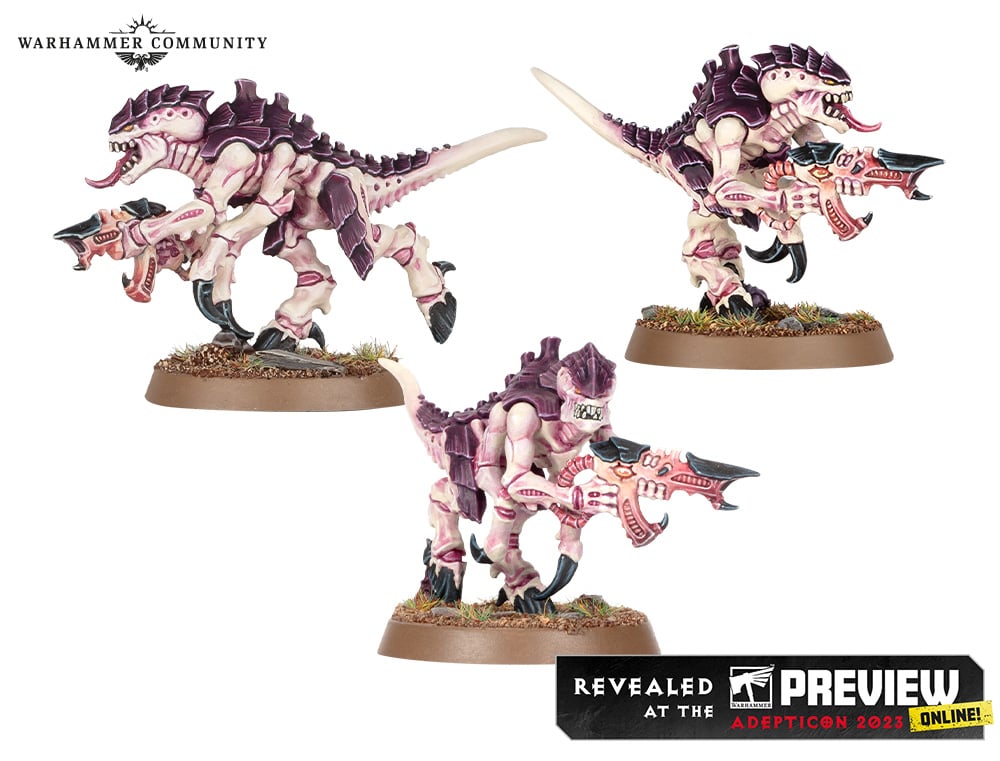
If you want to get an idea of what else might be included in the new edition’s launch set, we suggest you go back and watch that awesome cinematic again…
The Game
There are some big changes to gameplay, which has been completely overhauled for this edition. We started with what the fans were telling us about the game you play.
You told us that while Warhammer 40,000 is a fun game, there are parts that are overcomplicated, and that the learning curve for new players is pretty steep. In particular, many felt there were too many stratagems and too much complexity in army selection. We’ve listened and the new edition has been simplified – but it’s not simple.

This is still the rich, deep wargame that you know and love – we’ve just doubled down on the best bits. So instead of a huge raft of faction stratagems, you’ll have access to a handful of the best ones. There’re also a few new universal stratagems which anyone can use, that allow you to be reactive in your opponent’s turn.
There are improvements like this everywhere – in turn structure, army selection, morale, terrain, missions, the ways in which characters interact with units, and more. The list goes on, and we’ll explain more about each of these changes in the coming weeks.
What does this mean for my army and my Codex?
Maybe the biggest change in the new edition is to datasheets.
The way core information on a datasheet is presented has changed, and with it we took the opportunity to re-stat every unit in Warhammer 40,000.
Every unit has new and reevaluated rules, so every army will feel new from day one of the new edition.
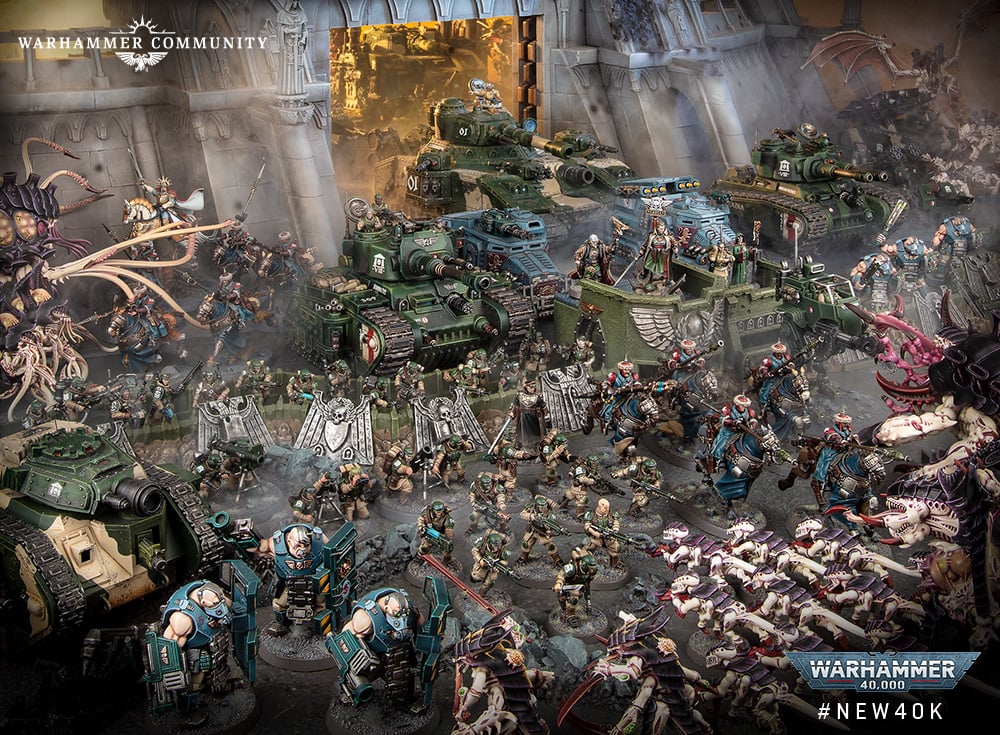
This huge update has also given us the opportunity to look again at lethality and durability across the entire game, and rebalance it at a stroke – something we could never do outside the launch of a new edition.
This example will show you what we mean:
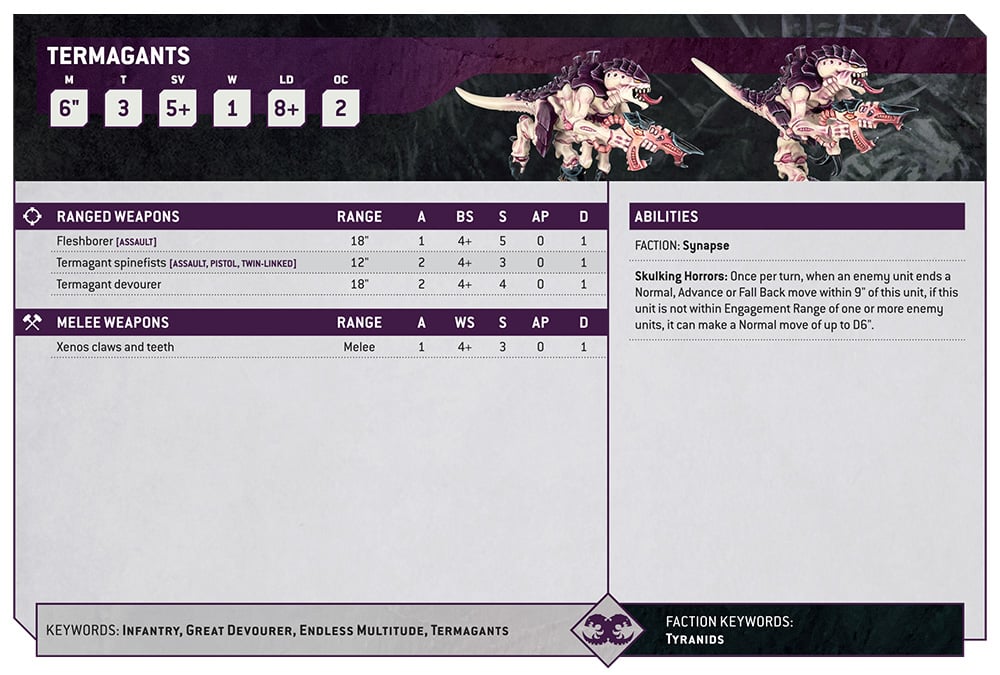
You also told us that you didn’t want to carry as many books with you to games.
On the first day of the new edition, the rules for every datasheet in 40k will be free to download, or available to buy as convenient and portable card decks. Even your faction and army rules now take up just a couple of pages.
The whole experience is more convenient, compact, and efficient than ever before, and it delivers amazing games with less desperate leafing between pages looking for that one special rule.

Army selection is equally straightforward: pick a faction, a warlord, and the units you like (just no more than three of any one type*), and stay within your points limit. That’s it!
You no longer have to fit your army into a force organisation chart, or compromise on the army you really want. It’s a simple and liberating system, and opens the door to all kinds of fun, thematic or unusual armies.
These big changes to rules and armies mean that the current range of codexes are being retired. The rules in them don’t work with the new edition, but remember that the rules for all your units will be available free online at launch.
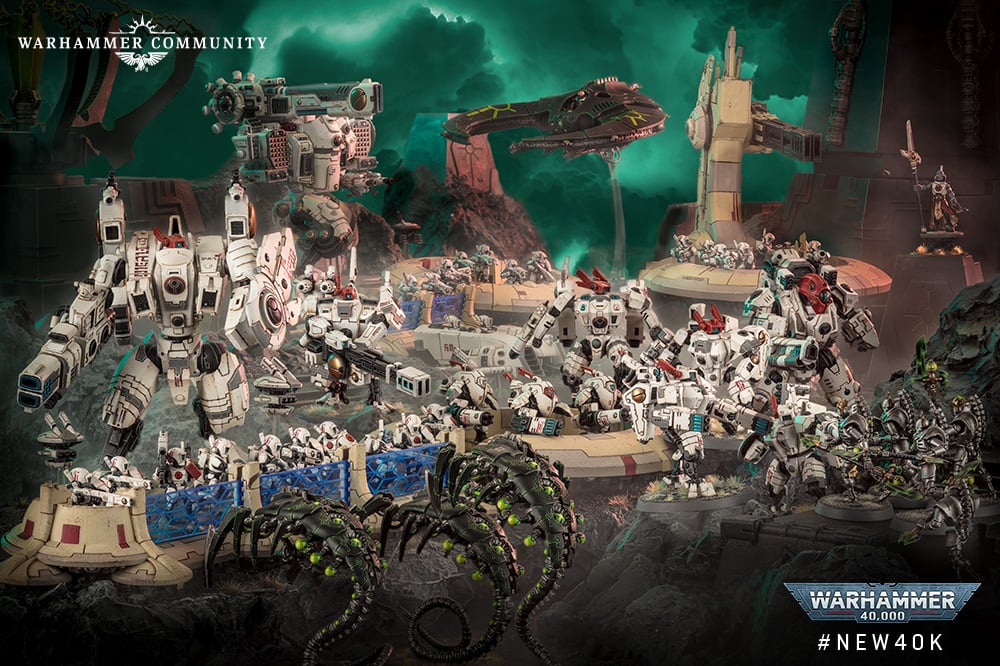
Don’t go throwing your codex in the recycling just yet. As well as months of gaming left with the current edition, your codexes remain a rich repository of lore and inspiration on your army, and one that won’t be immediately replaced.
Codexes will return in time to replace the free rules, but when they do the complexity of the game won’t increase, thanks to a one-in-one-out ethos for army and sub-faction rules. Effectively, you will only ever need your unit datasheets, the two pages of rules that govern your chosen army (available in your codex, on cards, or digitally), plus the core rules and whatever mission you’re playing.

There’s one exception to note. The Arks of Omen books and Boarding Patrols will persist, so you can keep purging those space hulks into the new edition and beyond.
Likewise, for those Eternal Crusaders out there who have built up a mighty host through their narrative games and want to bring their Crusade army with them into the new edition, there are rules to let you do this too.
Combat Patrol: A Brand New Way to Play
As well as continuing support for Crusade and matched play, the new edition will introduce a brand new way to play the game: Combat Patrol.
This version is designed to be easy to collect and easy to play. Combat Patrol pitches small preset and balanced forces against each other, with the armies made of Combat Patrol boxes!

This simplified version of Warhammer 40,000 that’s perfect for beginners, but also means that anyone starting a new force has a game they can begin to play very quickly, without having to build and paint 2,000 points of troops before a dice is even rolled. It’s also great for hobby butterflies, who hop from one project to the next and prefer to sample a little of each army’s nectar.
This Summer will be an incredibly exciting time to be a Warhammer 40,000 fan.
There’s so much more to say. From tomorrow, we will begin taking an in-depth look at all the major changes and faction rules exclusively here on Warhammer Community – as well as investigating the units in the absolutely stacked launch box.
Humanity faces its darkest hour in 10,000 years. Fully half the galaxy is cloaked in darkness, the Daemon Primarch of Khorne rampages across the stars, and fell Balefleets reave innocent worlds at the behest of the Despoiler and the Arkifane.
The Avenging Son cannot be everywhere at once. The Imperium grasps for a light in the darkness, and a light they shall receive.
The Lion has returned.
Lion El’Jonson, Primarch of the Dark Angels, has returned from the annals of history in humanity’s time of greatest need. Wielding the radiant sword Fealty and the Emperor’s Shield, he is a martial paragon – a hunter of beasts and slayer of traitors, stalking from the mist-wreathed passageways between the stars like a questing knight of Old Terra.
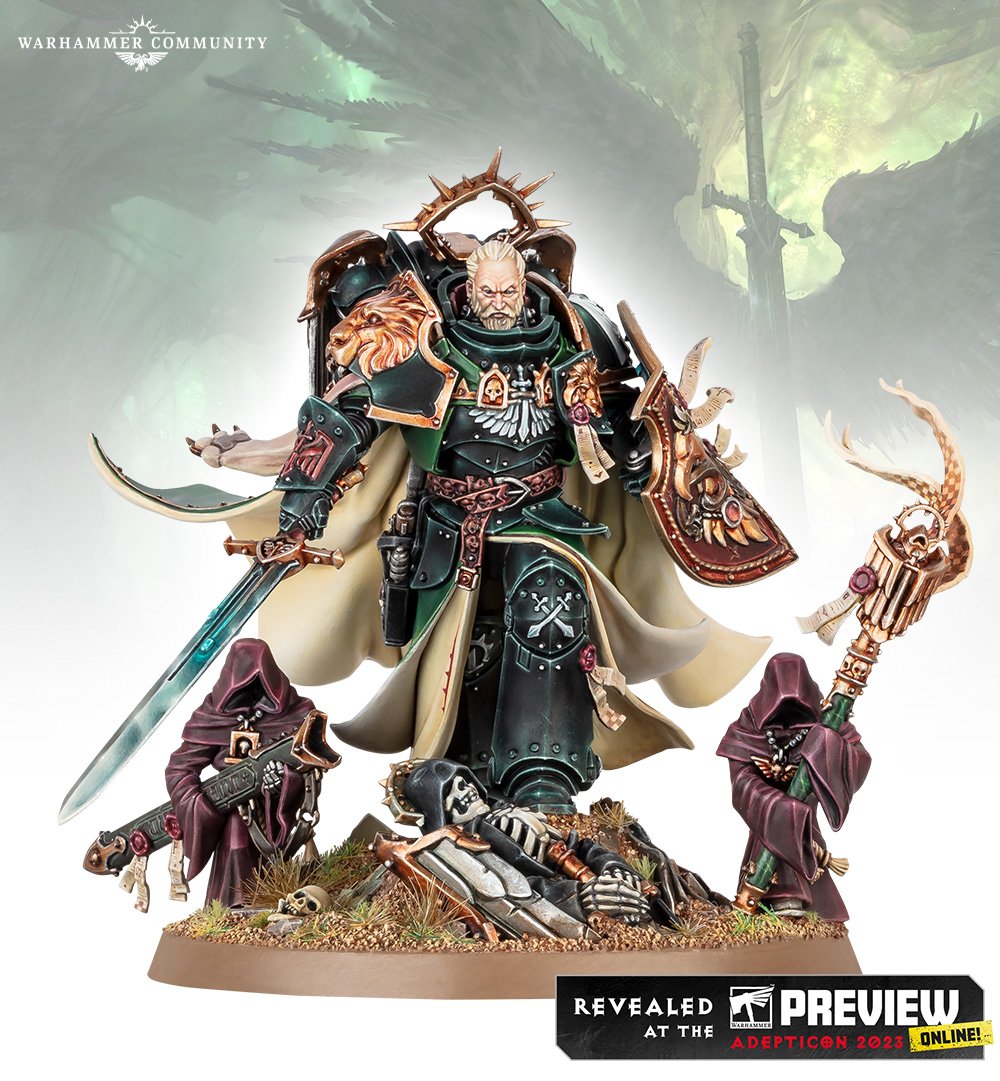
Every square inch of his jaw-dropping model marks him out as a true hero of legend. His armour is finely detailed with personal icons and the marks of his Legion, yet reserved and efficient as befits one whose duty lies in warfare first, and all other matters second. Fealty is an elegant weapon with subtle adornments, while the Emperor’s Shield glitters with regal ornamentation.
On the tabletop, the Lion is the consummate swordsman, balancing raw power and preternatural skill, scything through humanity’s foes like wheat. Those lucky few who live long enough to return a blow are met with a bone-crunching wave of force, as the fury of the Emperor Himself resounds from his shield.

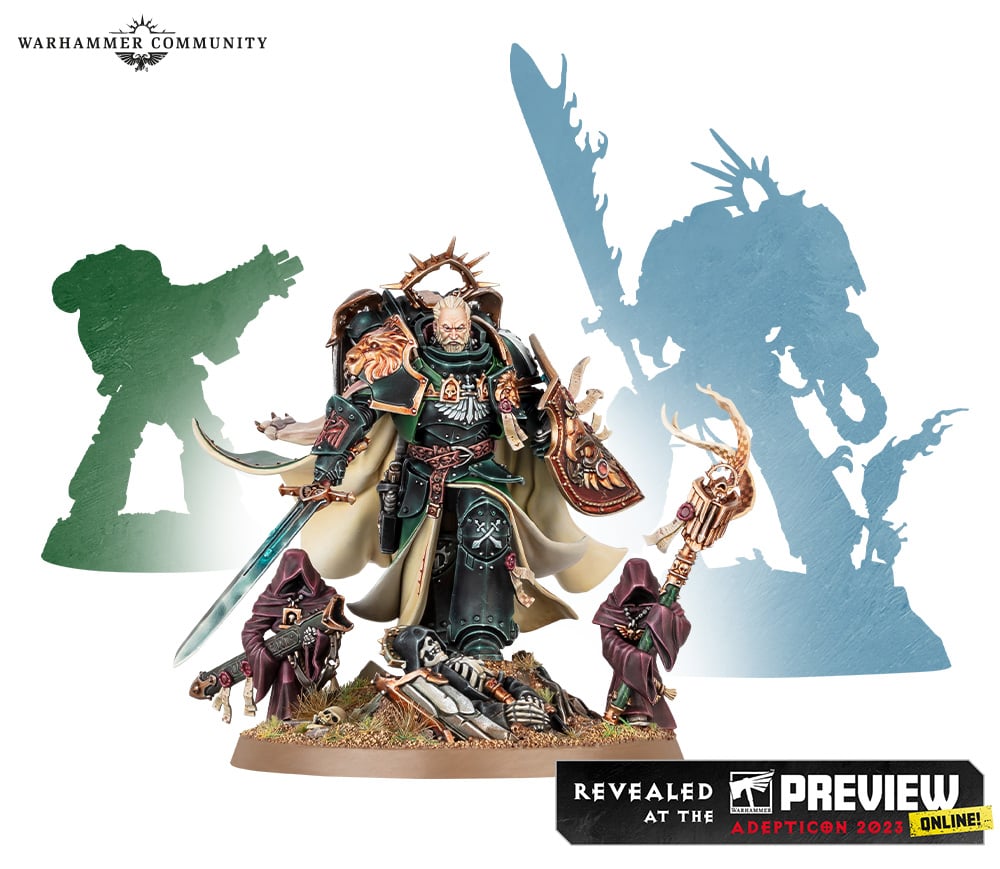
This legendary character deserves the mother of all red carpets, and that’s what Lion El’Jonson is getting in Arks of Omen: The Lion. And yes, he will throw down with Angron, the Daemon Primarch of Khorne in a truly cataclysmic brother-on-brother bout that’s been 10,000 years in the making.
No Really Ad-Mech: Warhammer 40k Tournament Results
Top 10th edition Warhammer 40k ITC army lists from the largest ITC tournaments from the past weekend. Week 3 of the Pariah Season.
Week One of the Pariah Season…sorta : Warhammer 40k Tournament Results
Top 10th edition Warhammer 40k ITC army lists from the largest ITC tournaments from the past weekend. Week 1 of the Pariah Season.
Last Week of the Leviathan Season…sorta : Warhammer 40k Tournament Results
Top 10th edition Warhammer 40k ITC army lists from the largest ITC tournaments from the past weekend. Week 52 of the Leviathan Season.












































































